Introduction to Indus Valley Civilization
Indus Valley Civilization is an important topic for UPSC Exam, Indus Valley Civilization should be well-read by the aspirants. Let’s have an in-depth look at the topic. This article will provide you with NCERT notes for UPSC on the Indus Valley Civilization.
- West Asian theory of Origin: According to this theory, Harappa culture originated in western Asia, especially from Iran. It has come to the plains of the Indus through Balochistan and Afghanistan after having given birth to a number of village cultures.
- Analogies have been traced between certain Harappan pottery motifs and objects and those of Killi Gul Mohammad, Kulli, Amri, Nal, Quetta, and Zhob. It is possible that the Harappans might have borrowed some ideas from these cultures.
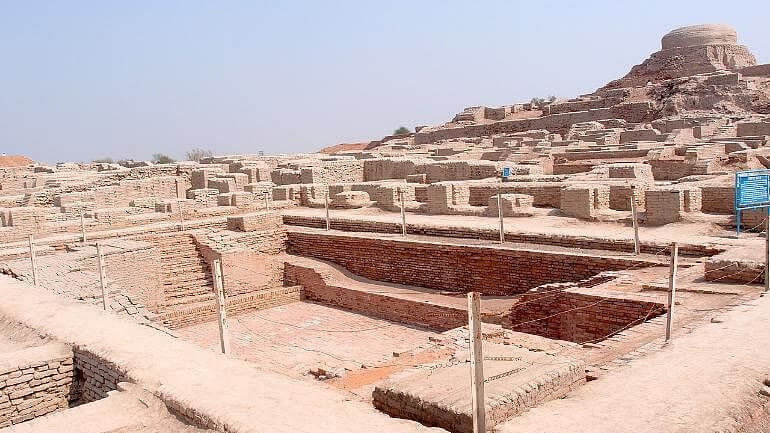 Present Condition of Indus Valley Civilisation
Present Condition of Indus Valley Civilisation - The presence of such elements on the peepal leaf, the willow leaf, the overlapping scales, hatched triangles of patterns, the antelope or ibex in panels, and the Amri-Nal Polychrome suggests a rather close relationship between the Amri Nal and the Harappan styles.
- The Harappans are believed to have borrowed the idea of cities from the contemporary Sumerians but established cities of their own with superior planning. In south Balochistan, the Kulli female figurines seem to be the earliest, and the Harappans might have learned from them.
- The Harappan population was of four types, viz. Proto-Australoid, Mediterranean, Mongolian, and the Alpine at Mohenjodaro. J. Marshall regards the population of Mohenjodaro as cosmopolitan.
- Thus the population was not homogeneous but heterogeneous. This proves that the Harappans were not local people but colonizers.
- Sir John Marshall estimated the length of Mohenjodaro's settlement between 3250 and 2750 B.C. in 1931.
- As a result, as additional sites are uncovered, the date of the Harappan civilization is revised.
- The development of the radiocarbon technique allows for the determination of nearly exact dates.
- On the basis of radiocarbon dates from his finds, Fairservis reduced the chronology of the Harappan civilization to between 2000 and 1500 B.C. by 1956.
- D.P. Agarwal concluded in 1964 that the overall period of this civilization should be between 2300 and 1750 B.C.
- However, these dates are subject to additional change.
- It is said that the Indus Valley was colonized by the Sumerians and that they introduced their language and script. But we know nothing about the facial features of the Sumerians.
- It is said that the Harappans were Dravidians and that the similarities between the pottery, beads, and necklaces, as also between the marks on the south Indian pottery and the Indus script, point to the Dravidian origin of the Indus Valley Civilisation.
- They spread afterward. Excavation in the South has hitherto revealed no traces of this culture.
- No specimen of Harappan script has been found in the South, where the bulk of the Dravidian people lives.
- We have absolutely no knowledge of the Dravidian language in such an early period. As to this racial type of the ancient Dravidians, we know next to nothing. The modern Dravidians can not be said to be ancestors of the Harappan period.
- The Brahuis, though speaking a Dravidian language, is of Turko-Iranian origin and are ethnically quite distinct from the various peoples speaking Dravidian languages in central and southern India.
- The latest findings suggest that Keezhadi excavations in Tamil Nadu might be an extension of IVC.
- Humped bulls were familiar to both the people of Harappa and Keezhadi.
- Another similarity between Keezhadi and IVC is found in pottery styles.
- The report also suggests that the excavations prove that the construction was similar to IVC's.
- Burnt bricks were used in Keezhadi with standard dimensions across the buildings discovered.
- The dimensions of bricks used in the site are 1:4:6. Similarly, in IVC, only burnt bricks were used and they too came with the standard dimension of 1:2:4.
- The materials used by the people of Keezhadi were also similar to the people of the later IVC period. Agate and carnelian beads which were used by the people of Gujarat and Maharashtra were also unearthed in Keezhadi.
- This modern revelation suggests that people of IVC might have migrated to the south and eastern part of India, which many historians have already opened.
- It is to be noted that the date of the finalization of the canon of the four Vedas is later but the Vedic hymns were composed several centuries earlier. The religions of the Harappan people represent a later phase of the Rig Vedic culture.
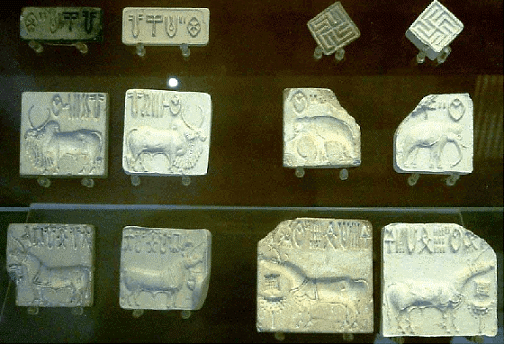 Indus Valley Seals
Indus Valley Seals
- The Rig Veda mentions fights in the Indus valley. It may have been that some foreign element wrested the Indus colony for a time from the Vedic Aryans in the post-Vedic period and hence the Grihya Sutra excluded the Sindhu Sauvira.
- Knowledge of writing displayed by the citizens of Mohenjo Daro by their seals shows a later phase than the Rig Vedic age when writing was not known.
- As to the racial type of the Aryans, it is suggested that they were probably a mixture of the Nordics, the Mediterranean, and the Alpines.
- The Vedic people were not ignorant of stone fists, walled cities, stone houses, and brick edifices. The ‘pure’ in the Rig Veda has been interpreted as the fortified cities.
- The Vedic Aryans were partly pastoral, partly agricultural people, having no knowledge of the amenities of city life and whose homes were mere structures of bamboo, while the domestic and civic architecture at Mohenjodaro tells quite a different tale.
- The metals used by the Aryans were gold, lead, copper, bronze, and iron coming later. Iron was not there in the Harappan civilization.
- The Aryans wore a helmet and defensive armor, which were unknown to the Harappan.
- The Vedic Aryans were meat-eaters having an aversion to fish, while the latter was an ordinary article of food of the Harappan people.
- The horse was not known to the Harappan. The tiger and elephant were familiar among the Harappans there is no mention of the tiger in Vedas, and the elephant was there but little known.
- The Vedic Aryans revered the cow, while the Harappan people worshipped the bull.
- Aniconism is the normal feature of the Vedic religion, while iconism was in evidence everywhere at Harappa and Mohenjodaro.
- The cult of the mother goddess and Siva have no place in the Vedic pantheon, the cults are at the forefront among the Harappans.
- The entry of the Aryans into India is held subsequent to 1500 B.C., the time when the Harappan culture disappeared.
- The Indus Valley Civilisation unquestionably ranks as one of the greatest civilizations of the world.
- The civilization was essentially urban.
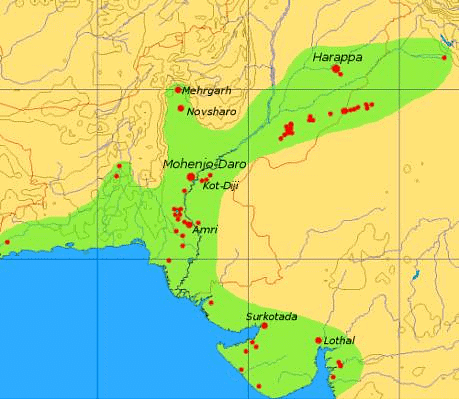 Extent and major sites of the Indus Valley Civilisation
Extent and major sites of the Indus Valley Civilisation
Whether it is Harappa or Mohenjo-Daro, Kalibangan or Lothal, the most striking character is systematic town planning; the streets oriented north-south and east-west, produced a grid pattern.
- Harappan seals were most probably used in connection with trade.
- Meluha was the ancient name given to the Indus region by the Mesopotamians.
- Mesopotamian cylindrical seals and cuneiform inscriptions have been found at Mohenjo-daro.
- Archaeological excavations at Indus Valley sites show that houses had wells in Kalibangan.
- Stone implements were largely used by the Indus people.
- The Harappans were the earliest people to produce cotton.
- Most Harappan inscriptions were recorded on seals.
- Flanking the streets and similarly oriented lanes and by-lanes were well-planned houses.
- The buildings, considerably varying in size, appear to have been plain but dignified. Stone not being easily obtainable, walls were raised of burnt brick, laid in mud or in both mud and gypsum mortar.
- Crude or sun-dried bricks were reserved for foundations and terraces, where the elements could not do much damage. Both rooms and circular brick walls were important features of most houses.
- The system of drainage, public or private was remarkable. Each city had a fortified citadel possibly used for both religious and governmental purposes.
- Dust bins and rubbish chutes indicate the extreme care taken in matters of conservancy.
- The commodious houses, knit into a system of rigid town-planning, the public-buildings, large granaries and the citadel, all combine to present the picture of prosperous people, controlled by a firm yet beneficent authority.
 Traces of Mohenjo-daro Present Today
Traces of Mohenjo-daro Present Today
- The ‘city of the dead’, is at present a heap of ruins. The most dramatic characteristic of the city is a commanding citadel. It is a massive, mud-filled brick embankment that rises 43 feet above the lower city.
- There lay in the citadel a ‘College’ a multi-pillared ‘Assembly Hall’ and the so called ‘Great Bath’.
- The pool, surrounded by a paved courtyard, is 39 feet long, 23 feet wide and 8 feet deep.
- Most Mohenjo-daro houses are built of kiln fired brick. The major streets are 33 feet wide and run north-south intersecting subordinate ones, running east-west, at right angles.
- Its drains with a corbelled roof, more than 6 ft in height, deserves particular mention.
- The evidence of Indian ships (figured on the seal) and a piece of woven cloth has been discovered from here.
- Also present are the remains of shops, and of structures so substantial as to suggest temples or religious buildings.
- There is a large granary consisting of a podium of square blocks of burnt-bricks with a wooden superstructure.
- Parallel rows of two-roomed cottages were found. These cottages were perhaps used by the workmen or poor section of the society.
- It is important to remember that Mohenjo-daro shows nine levels of occupation towering over 300 feet above the present flood plain.
- Excavation reveals that the city was flooded more than seven times.
- In 1922, R D Banerji, one of the Superintendent Archaeologists of the Archaeological Survey of India, decided to excavate the Buddhist stupa that dominated the site.
 Gateway at Harappa
Gateway at Harappa
- It is situated on the river Ravi. The ruins of Mohenjo-Daro and Harappa suggest that capital cities existed here.
- The most remarkable and the largest building at Harappa is the Great Granary measuring 169 ft x 35 ft.
- The citadel at Harappa also displays a Great Bath but of a slightly different design.
- Between the granary and the citadel, have also been found a series of circular platforms, probably for the pounding of grain.
- At a lower level below the granary platforms and the citadel, were crowded single-celled dwellings which have suggested slave habitats.
- Two sandstone statuettes found here in which human anatomy is depicted. The Cemetery H culture is also found here.
- The Harappa site was first briefly excavated by Sir Alexander Cunningham in 1872-73, two decades after brick robbers carried off the visible remains of the city. He found an Indus seal of unknown origin.
 Drainage System in Kalibangan
Drainage System in Kalibangan
- Kalibangan is situated on the ancient Sarasvati, now called Ghaggar in Rajasthan.
- Since the Harappan city overlies the earlier proto-Harappan, clear house plans of the earlier city are not available.
- But in some houses, we have evidence of ovens and a well-aligned lane.
- There is also evidence of mud-brick fortification. The Pre-Harappan phase here shows that the fields were ploughed, unlike the Harappan period.
- One of the platforms within the citadel had fire altars that contained ash.
- Another platform has a kiln-burnt brick-lined pit containing bones. These suggest the practice of the cult of sacrifice.
- The existence of wheel conveyance is proved by a cartwheel having a single hub.
- The Kalibangan pre-historic site was discovered by Luigi Pio Tessitori, an Italian Indologist (1887–1919).He was doing some research in ancient Indian texts and was surprised by the character of ruins in that area. He sought help from Sir John Marshall of the Archaeological Survey of India.
- Chanhudaro is situated eighty miles south of Mohenjo-daro.
- Chanhudaro was first excavated by N. G. Majumdar in March, 1931 and again during winter field session of 1935-36 by the American School of Indic and Iranian Studies and the Museum of Fine Arts, Boston team led by Ernest John Henry Mackay.
- The city is twice destroyed by inundation. Here more extensive but indirect evidence of superimposition of barbarian life is seen.
- There was no citadel.
- Banawali is situated in the dried-up Sarasvati. Like those of Kalibangan, Amri, Kot Diji and Harappa, Banawali also sees two cultural phases: pre-Harappan and Harappan.
- This site was excavated by R.S. Bisht of Archaeological Survey of India in 1974.
- Here we find large quantity of barley, sesame and mustard.
- Surkotada is situated 270 km north-west of Ahmedabad in Gujarat.
- It was discovered and excavated by Shri Jagat Pati Joshi of ASI in 1964-1968. "The mound has an average height of five-to-eight metres (east-to-west) at the time of its discovery.
- Here we find remains of a horse, a citadel and a lower town, both of which were fortified.
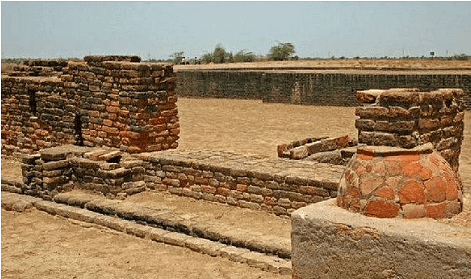 Ancient Port, Lothal
Ancient Port, Lothal
- This is situated on the bank of Bhogavar.
- Only at Lothal and Rangpur, Rice husk has been found.
- Archaeologist S.R. Rao led teams who discovered a number of Harappan sites, including the port city of Lothal in 1954-63.
- The use of weights and measures proves that they knew arithmetic as well which is shown by a scale found at Lothal. It was surrounded by a thick, mud-brick wall on three sides, southern, western and northern.
- On the eastern side is located a dockyard and wharf loading platform.
- A doubtful terracotta figurine of a horse is found here.
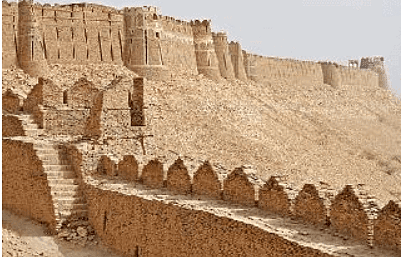 Kot Diji Fort
Kot Diji Fort
- It is situated on the left bank of Indus river about 50 km east of Mohenjo-daro.
- R Rao excavated the site in 1957 - 58.
- Wheel made of painted pottery, traces of a defensive wall and well-aligned streets, knowledge of metallurgy, artistic toys etc.
- Five figurines of the Mother Goddess were also discovered.
- It is situated south of Mohenjo-daro.
- In Pakistan, Jean-Marie Casal has directed the excavations at Amri (Sindh) in 1959-1962.
- Knowledge of metal working, use of wheel pottery with animal figures painted on it, construction of rectangular houses, etc.
- Situated near the middle of the Khurkera plain on the south-eastern side of the Las Bela Valley and Somani Bay about 98 km north-west of Karachi.
- Robert Raikes, discovered the small site of Balakot, some 55 miles north of Karachi, on the east side of Sonmiani Bay in 1959-1960.
- There is a wide east-west lane almost bisecting the area at right angles with two smaller lanes.
- Mud bricks were the standard building material although a few drains were lined with kiln-burnt bricks also.
- There is some evidence for the thin plastering of floors but it was not done as the usual practice.
- Situated near Gunthali in Nakhatrana taluka of Bhuj district (Gujarat) on the Bhadar river.
- Discovered by P. P Pandya and MA Dhakey in 1963.
- It was a fortified township built of dressed stone with mud filling inside.
- The houses were constructed just against the fortification wall. In the centre, was found a building having massive walls.
- Situated near the confluence of Sutlej, some 25 km east of Bara.
- Discovered by Y. D. Sharma in 1953.
- The excavations have yielded a five-fold sequence of cultures—Harappan, PGW, NBP, Kushana-Gupta and Medieval.
- Discovery of pottery related to the Kalibangan-I.
- The evidence of burying a dog below the human burial is very interesting.
- One example of a rectangular mud-brick chamber was noticed.
- It is a modest village in the Bhachau taluka of district Kutch in Gujarat.
- It is the latest and one of the two largest Harappan settlement in India, the other being Rakhigarhi in Haryana.
- The mounds of Dholavira was first explored by Dr. J.P. Joshi in 1966.
- The other Harappan towns were divided into two parts—‘Citadel’ and ‘the Lower Town’, but Dholavira was divided into three principal divisions, two of which were strongly protected by rectangular fortification. No other site has such an elaborate structure.
- In 1990-91 a team of archaeologists led by Dr R.S. Bisht of the ASI conducted extensive excavations.
- All of the world’s civilization developed along the riverbanks:
(i) Egyptian on River Nile
(ii) Mesopotamian on River Tigris-Euphrates
(iii) Chinese on River Yangtze - Mesopotamian texts speak of three intermediate trading stations called Dilmun (probably Bahrain on the Persian Gulf), Makan (probably the Makran coast of Oman) and Meluhha.
- Meluhha was probably the name of the Indus region in Mesopotamian text
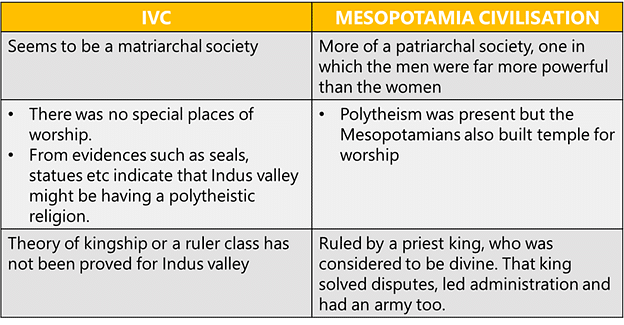 Difference between IVC and Mesopotamia Civilisation
Difference between IVC and Mesopotamia Civilisation
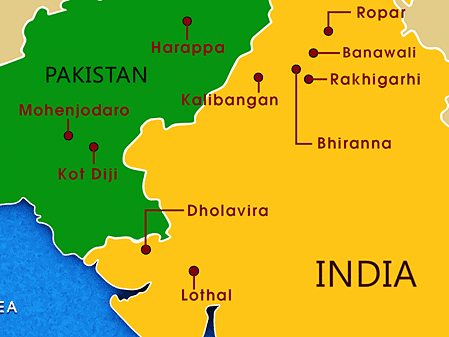

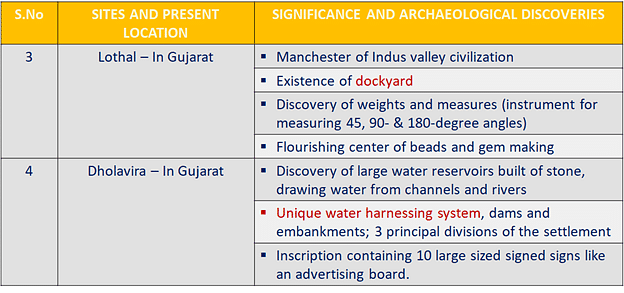
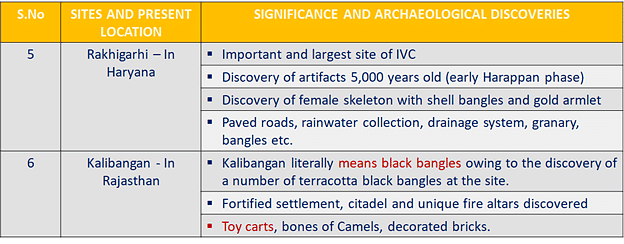
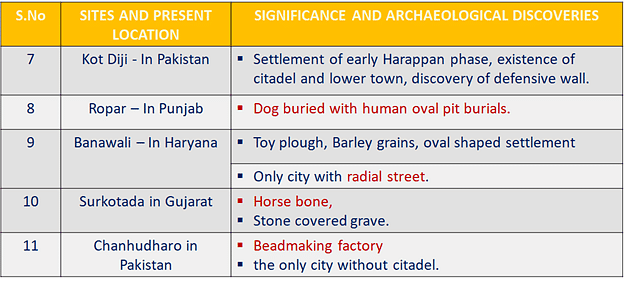
Indian Architecture, Sculpture & Pottery is a very important topic in respect to UPSC CSE. Let’s have a look at the summary of Nitin Singhania’s book to understand better.
Indian Architecture: Architecture refers to the design and construction of buildings. It generally uses a mixture of various types of materials like stone, wood, glass, metal, sand, etc. It involves the study of engineering and engineering mathematics. It requires detailed and accurate measurements.
Sculpture: Sculptures are relatively smaller 3-dimensional works of art. A single piece of the sculpture is usually made of a single type of material. Sculpture involves creativity and imagination and may not depend as heavily on accurate measurements.
Pottery: Pottery is the process and the products of forming vessels and other objects with clay and other ceramic materials, which are fired at high temperatures to give them a hard, durable form. Major types include earthenware, stoneware and porcelain.

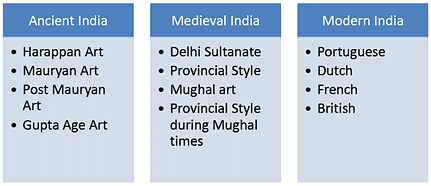
Harappan Architecture: The Indus Valley is one of the world's earliest urban civilizations, along with its contemporaries, Mesopotamia and Ancient Egypt. At its peak, the Indus Civilization may have had a population of well over five million.
➢ The Great Granary at Harappa: Extensive town planning was the characteristic of this civilization, which is evident from the gridiron pattern for the layout of cities, some with fortifications and elaborate drainage and water management systems.
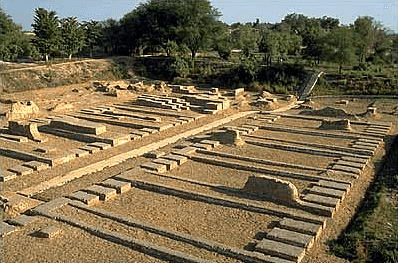 The Great Granary
The Great Granary
- The grid layout planning of the cities with roads at exact right angles is a modern system that was implemented in the cities of this particular civilization.
- The houses were built of baked bricks. Bricks of fixed sizes, as well as stone and wood, were also used for building.
- Buildings in the lower area are rather monotonous, being mainly functional rather than decorative.
- The most imposing of the buildings is the Great Bath of Mohenjo-daro. It is 54.86 metres long and 32.91 metres wide and with 2.43 metres thick outer walls. The Bath had galleries and rooms on all sides.
 Great bath at Mohenjo-Daro
Great bath at Mohenjo-Daro - Another important structure was the Granary complex comprising of blocks with an overall area of 55 x 43 metres. The granaries were intelligently constructed, with strategic air ducts and platforms divided into units.
➢ Unicorn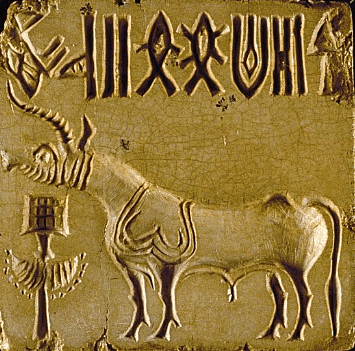 Harrappa Unicorn Seal
Harrappa Unicorn Seal
➢ Pashupati seal
- The standard seal is a square plaque with 2 x 2 square inches(river stone (steatite).
- They were mainly used as a unit of trade and commerce.
- They were also used as an amulet (to ward off the evil).
- They were also used as an educational tool (presence of pie sign).
➢ Beared man  Sculpture of Indus Valley Civilization➢ Dancing girl
Sculpture of Indus Valley Civilization➢ Dancing girl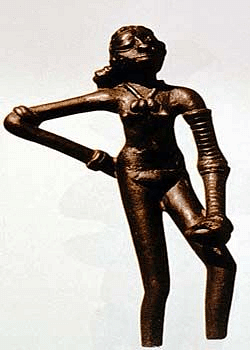 Art Dancing Girl of Mohenjo-daro
Art Dancing Girl of Mohenjo-daro
- The ‘lost wax technique” was used for making the metal-cast sculptures.
- The buffalo with its uplifted head, back and the sweeping horn was also made.
- Goats are of artistic merit.
➢ Terracotta
- Terracotta is a fire-baked clay and is handmade using the pinching method.
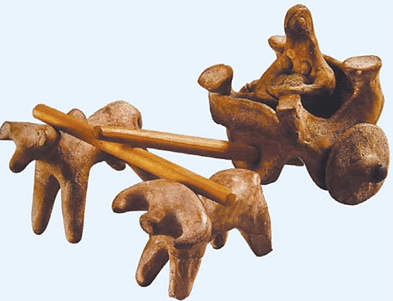 Toy carts with wheels
Toy carts with wheels
➢ Harappan Pottery
- Potteries were mainly plain, red and black painted.
- Plain pottery is more common than painted ware.
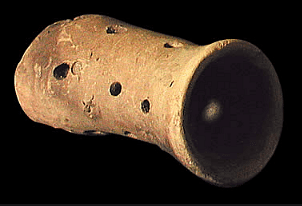 Perforated Pottery
Perforated Pottery - Plain pottery is generally of red clay, with or without a fine red or grey slip. It includes knobbed ware, ornamented with rows of knobs.
- The black painted ware has a fine coating of red slip on which geometric and animal designs are executed in glossy black paint.
- Ports were Used as perforated pottery (large hole at the bottom and small holes all over the wall, and probably was used for straining liquor).
➢ Beads and Ornaments
- Shreds of evidence of dead bodies buried along with ornaments have also been found.
- Harappans were also conscious of fashion.
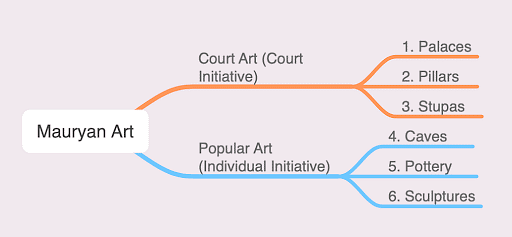
1. Mauryan court Art-Palaces
Some of the monuments and pillars belonging to this period are considered as the finest specimens of Indian art. The Mauryan architecture was embalmed in timber, for rocks and stones were not as freely in use then. The art of polishing of wood reached so much perfection during the Mauryan period that master craftsmen used to make wood glisten like a mirror.
In 300 B.C., Chandragupta Maurya constructed a wooden fort 14.48 km long and 2.41km wide, along the Ganges in Bihar. However, only a couple of teak beams have survived from this fort.
➢ Ashoka
- Ashoka was the first Mauryan Emperor who began the stone architecture. The stonework of the Ashokan Period (3rd century B.C.) was of a highly diversified order and comprised of lofty freestanding pillars, railings of the stupas, lion thrones and other colossal figures. While most of the shapes and decorative forms employed were indigenous in origin, some exotic forms show the influence of Greek, Persian and Egyptian cultures.
- The Ashokan period marked the beginning of the Buddhist School of architecture in India. It witnessed the construction of many rock-cut caves, pillars, stupas and palaces. A number of cave-shrines belonging to this period have been excavated in the Barabar and Nagarjuni hills and Sitamarhi in Bihar. The caves are simple in plan and are devoid of all interior decorative carvings. They served as the residences of the monks.

- The Ashokan rock-edict at Dhauli, near Bhubaneshwar, is considered to be the earliest rock-cut sculpture in India. It has a sculpted elephant on the top, which signifies the Emperor's conversion to Buddhism after his Kalinga victory.
2. Mauryan Court Art-Pillars
➢ Ashokan Pillars Geographical Spread of Ashokan Pillars
Geographical Spread of Ashokan Pillars
- The monolithic Ashokan pillars are marvels of architecture and sculpture. These were lofty free-standing monolithic columns erected on sacred sites. Each pillar was about 15.24 metres high and weighed about 50 tonnes and was made out of fine sandstone. They carried declarations from the king regarding Buddhism or any other topic.
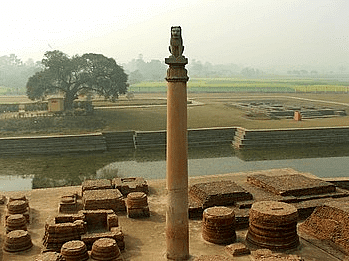 Ashoka Pillar
Ashoka Pillar
The pillars have four parts:
(i) The shafts are always plain and smooth, circular in cross-section, slightly tapering upwards and always chilled out of a single piece of stone.
(ii) The capitals have the shape and appearance of a gently arched bell formed of lotus petals.
(iii) The abaci are of two types: square and plain and circular and decorated and these are of different proportions.
(iv) The crowning animals are either seated or standing, always in the round and chiselled as a single piece with the abaci.
The Sarnath pillar is one of the finest pieces of sculpture of the Ashokan period erected in 250 BC. Here, four lions are seated back to back. The four lions symbolize power, courage, confidence and pride. This Lion Capital of Ashoka from Sarnath has been adopted as the National Emblem of India and the wheel "Ashoka Chakra" from its base was placed onto the centre of the National Flag of India. At present the Column remains in the same place where Lion Capital is at the Sarnath Museum.
3. Mauryan court Art-Stupas
- The stupa is a mound-like structure containing Buddhist relics, typically the ashes of deceased, used by Buddhists as a place of meditation.
- Ashoka was responsible for the construction of several stupas, which were large halls, capped with domes and bore symbols of the Buddha.
- The most important ones are located at Bharhut, Bodhgaya, Sanchi, Amravati and Nagarjunakonda.
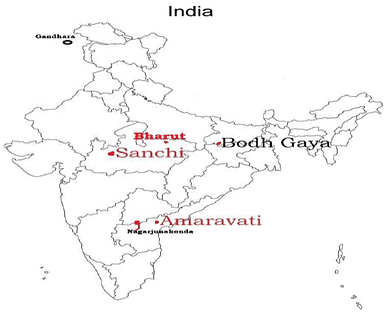 The stupas built for a variety of reasons, Buddhist stupas are classified based on form and function into five types:
The stupas built for a variety of reasons, Buddhist stupas are classified based on form and function into five types:
(i) Relic stupa - In which the relics or remains of the Buddha, his disciples and lay saints are interred.
(ii) Object stupa - In which the items interred are objects belonged to the Buddha or his disciples such as a begging bowl or robe, or important Buddhist scriptures.
(iii) Commemorative stupas - Built to commemorate events in the lives of Buddha or his disciples.
(iv) Symbolic stupa - To symbolise aspects of Buddhist theology, for example, Borobudur is considered to be the symbol of "the Three Worlds (dhatu) and the spiritual stages (bhumi) in a Mahayana bodhisattva's character."
(v) Votive stupas - Constructed to commemorate visits or to gain spiritual benefits, usually at the site of prominent stupas which are regularly visited.
The shape of the stupa represents the Buddha, crowned and sitting in meditation posture on a lion throne. His crown is the top of the spire; his head is the square at the spire's base; his body is the vase shape; his legs are the four steps of the lower terrace, and the base is his throne.
The stupa represents the five purified elements:-
(i) The square base represents earth
(ii) The hemispherical dome/vase represents water
(iii) The conical spire represents fire
(iv) The upper lotus parasol and the crescent moon represents air
(v) The sun and the dissolving point represents the element of space
➢ Sanchi Stupa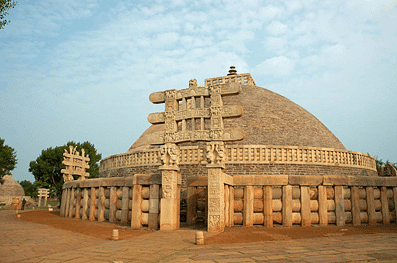
- Apart from the ruins of the stupa at Piprahwa (Nepal), the core of stupa No 1 at Sanchi can be considered as the oldest of the stupas.
- Originally built by Asoka, it was enlarged in subsequent centuries. An inscription by the ivory carvers of Vidisha on the southern gateway throws light on the transference of building material from perishable wood and ivory to the more durable stone.
➢ Amaravati Stupa
- Amaravati stupa, built-in 2nd or 1st century BC was probably like the one at Sanchi, but in later centuries it was transformed from a Hinayana shrine to a Mahayana shrine.
- Amaravati stupa is different from the Bharhut and Sanchi stupas. It had free-standing columns surmounted by lions near the gateways. The dome was covered with sculptured panels.
- The stupa had an upper circumambulatory path on the drum as at Sanchi. This path had two intricately carved railings. The stone is greenish-white limestone of the region.
➢ Bharhut Stupa Remnants of Bharhut Stupa
Remnants of Bharhut Stupa
- The Bharhut stupa may have been established by the Maurya king Asoka in the 3rd century BCE, but many works of art were added during the Sunga period, with many friezes from the 2nd century BCE.
- The stupa (now dismantled and reassembled at Kolkata Museum) contains numerous birth stories of the Buddha's previous lives or Jataka tales.
➢ Gandhara Stupa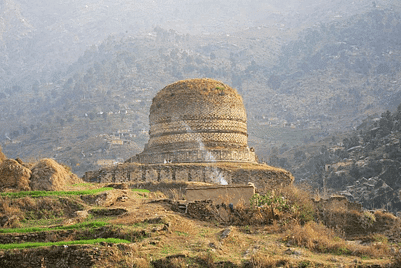
- The Gandhara stupa is a further development of stupas at Sanchi and Bharhut.
- In Gandhara stupas, the base, dome and the hemisphere dome are sculpted. The stupa tapers upward to form a tower-like structure.
- The stupas of Nagarjunakonda in the Krishna valley were very large. At the base, there were brick walls forming wheel and spokes, which were filled with earth. The Maha Chaitya of Nagarjunakonda has a base in the form of Swastika, which is a sun symbol.
4. Mauryan Popular art-Caves
- Decorated entrance to barabar caves
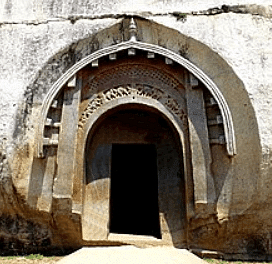 Barabar Caves
Barabar Caves - The Mauryan period also saw the firm establishment of rock-cut architecture.
- The notable rock-cut caves carved at Barabar and Nagarjuna hills near Gaya in Bihar are Sudama and Lomus Rishi cave.
- Architecturally, their main interest lies in being the earliest known examples in India of the rock-cut method.
- The facade of the Lomas Rishi cave is decorated with the semicircular chaitya arch as the entrance. The elephant frieze carved in high relief on the chaitya arch shows considerable movement.
- The interior hall of this cave is rectangular with a circular chamber at the back. The entrance is located on the sidewall of the hall.
- The cave was patronised by Ashoka for the Ajivika sect.
The two important features of the caves of this period were:
(i) Polishing inside the cave.
(ii) Development of artistic gateway.
5. Mauryan Popular art-Pottery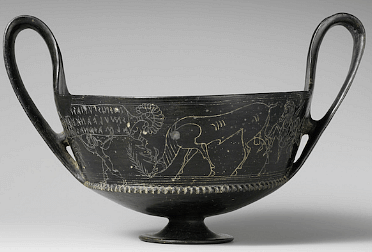 Specimen of Northern Black Polished Ware
Specimen of Northern Black Polished Ware
- The pottery associated with the Mauryan period consists of many types of wares. But the most highly developed techniques are seen in a special type of pottery known as Northern Black polished ware (NBPW), which was the hallmark of the preceding and early Mauryan Periods.
- The NBPW is made of finely levigated alluvial clay. It can be distinguished from other polished or graphite coated red wares by its peculiar luster and brilliance. It was largely used for dishes and small bowls.
6. Mauryan Popular Art-Sculpture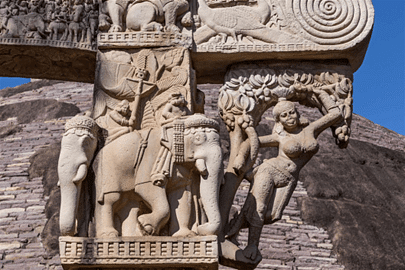 Yakshini Sculpture in a Torana at Sanchi Stupa
Yakshini Sculpture in a Torana at Sanchi Stupa
- The work of local sculptors illustrates the popular art of the Mauryan Period.
- This consisted of sculpture which probably was not commissioned by the Emperor.
- The patrons of the popular art were the local governors. Large statues of Yaksha and Yakshiniare found at many places like Patna, Vidisha and Mathura.
- These monumental images are mostly in the standing position. One of the distinguishing elements in all these images is their polished surface.
- The depiction of faces is in the full round with pronounced cheeks and physiognomic detail.
- The life-size standing image of a Yakshini holding a chauri (flywhisk) from Didargunj near modern Patna is one of the finest examples of the sculptural tradition of the Mauryan Period.
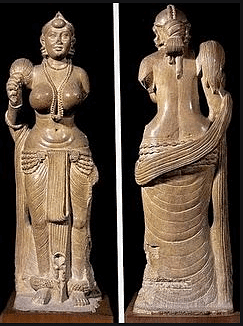 Yakshini holding a chauri (flywhisk)
Yakshini holding a chauri (flywhisk) - It is a tall, well proportioned, free-standing sculpture in the round made in sandstone with a polished surface.
- Yakshini is considered a folk goddess in all major religions.
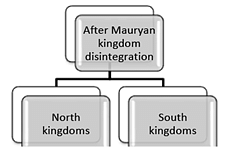
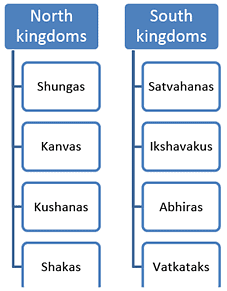
- The art of this period started reflecting the changing sociopolitical scenario as well.
- The architecture in the form of rock-cut caves and stupas continued, with each dynasty introducing some unique features of their own.
- Similarly, different schools of sculpture emerged and the art of sculpture reached its climax in the post-Mauryan period.
➢ Post Mauryan Period - Architecture
The north and south dynasties made advances in art and architecture in areas like stone construction, stone carving, symbolism and beginning of temple (or chaitya hall-prayer halls) and the monastery (or vihara-residential halls) constructions.
Karle Chaitya, Vihara at Ellora
- The period between 2nd century B.C. and 3rd century A.D. marked the beginning of the sculptural idiom in Indian sculpture where the elements of physical form were evolving into a more refined, realistic and expressive style.
- Under these dynasties, the Asokan stupas were enlarged and the earlier brick and woodworks were replaced with stone-works.
- The Sanchi Stupa was enlarged to nearly twice its size in 150 B.C. and elaborate gateways were added later.
- The Sungas reconstructed the railings around the Barhut Stupa and built the toranas or the gateways.
- The Satavahanas constructed a large number of stupas at Goli, Jaggiahpeta, Bhattiprolu, Gantasala, Nagarjunakonda and Amravati.
- During the Kushan period, the Buddha was represented in human form instead of symbols. Buddha's image in endless forms and replicas became the principal element in Buddhist sculpture during the Kushan period.
- The Kushans were the pioneers of the Gandhara School of Art and a large number of monasteries; stupas and statues were constructed during the reign of Kanishka.
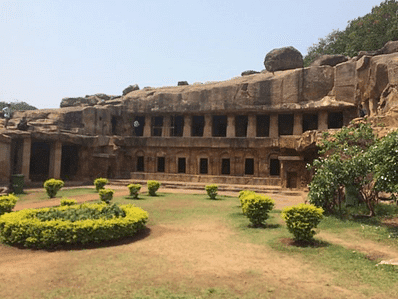 Udayagiri and Khandagiri Caves, Orissa
Udayagiri and Khandagiri Caves, Orissa - They were made under the Kalinga King Kharavela in 1st-2nd century BC near modern-day Bhubaneswar(for Jain monks).
- Udayagiri caves are famous for the Hathigumpha inscription which is carved out in Brahmi script.
- Ranigumpha cave in Udayagiri is double-storied and has some beautiful sculptures.
➢ Post Mauryan period-Sculpture
Three prominent schools of sculpture developed in this period at three different regions of India.
(i) Gandhara School of Art
(ii) Mathura School of Art
(iii) Amravati School of Art
(i) The Gandhara School of Art (50 B.C. to 500 A.D.)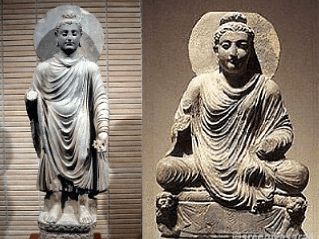
- The Gandhara region extending from Punjab to the borders of Afghanistan was an important centre of Mahayana Buddhism up to the 5th century A.D.
- Owing to its strategic location the Gandhara School imbibed all kinds of foreign influences like Persian, Greek, Roman, Saka and Kushan.
- The Gandhara School of Art is also known as the Graeco-Buddhist School of Art since Greek techniques of Art were applied to Buddhist subjects.
- The most important contribution of the Gandhara School of Art was the evolution of beautiful images of the Buddha and Bodhisattvas, which were executed in black stone and modelled on identical characters of Graeco-Roman pantheon. Hence it is said, "the Gandhara artist had the hand of a Greek but the heart of an Indian."
What are the important characteristics of Gandhara school are?
- Depiction of Lord Buddha in the standing or seated positions.
- The seated Buddha is always shown cross-legged in the traditional Indian way.
- Rich carving, elaborate ornamentation and complex symbolism.
- Use of Greystone
- The best specimens of Gandhara art are from Jaulian and Dharmarajika stupa at Taxila and Hadda near Jalalabad in modern Afghanistan. The tallest rock-cut statue of Lord Buddha is also located at Bamiyan in modern Afghanistan.
(ii) The Mathura School of Art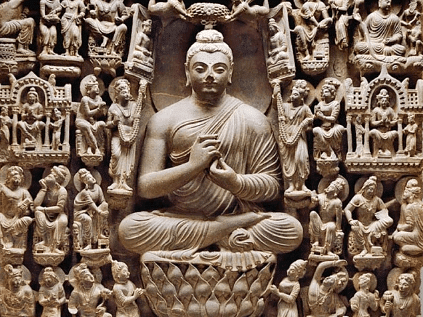
The Mathura School of art flourished at the city of Mathura between 1-3 A.D. and was promoted by the Kushans. It established the tradition of transforming Buddhist symbols into human form.
- The important characteristics of Mathura school are: The earliest sculptures of Buddha were made keeping the yaksha prototype in mind.
- They were depicted as strongly built with the right hand raised in protection and the left hand on the waist.
- The figures produced by this school of art do not have moustaches and beards as in the Gandhara Art.
- Spotted Red sandstone mainly used.
- Here along with the Buddha, the kings, the royal family were included in the architecture.
- It not only produced beautiful images of the Buddha but also of the Jain Tirthankaras and gods and goddesses of the Hindu pantheon.
- The Guptas adopted the Mathura School of Art and further improvised and perfected it.
(iii) The Amravati School of Art Amravati School of Sculpture
Amravati School of Sculpture
The Amravati school of Art evolved during Satavahna period. This school of art developed at Amravati, on the banks of the Krishna River in modern Andhra Pradesh. It is the site for the largest Buddhist stupa of South India. The stupendous stupa could not withstand the ravages of time and its ruins are preserved in the London Museum. This school of art had a great influence on art in Sri Lanka and South-East Asia as products from here were carried to those countries.
In this document you have learnt
- The grid layout planning of the cities with roads at exact right angles is a modern system that was implemented in the cities of this particular civilization. The houses were built of baked bricks. Bricks of fixed sizes, as well as stone and wood, were also used for building.
- The ‘lost wax technique” was used for making the metal-cast sculptures. The buffalo with its uplifted head, back and the sweeping horn was also made.
- The Ashokan period marked the beginning of the Buddhist School of architecture in India. It witnessed the construction of many rock-cut caves, pillars, stupas and palaces. A number of cave-shrines belonging to this period have been excavated in the Barabar and Nagarjuni hills and Sitamarhi in Bihar.
- The Sarnath pillar is one of the finest pieces of sculpture of the Ashokan period erected in 250 BC. Here, four lions are seated back to back. The four lions symbolize power, courage, confidence and pride.
- The stupas of Nagarjunakonda in the Krishna valley were very large. At the base, there were brick walls forming wheel and spokes, which were filled with earth. The Maha Chaitya of Nagarjunakonda has a base in the form of Swastika, which is a sun symbol.
- Udayagiri caves are famous for the Hathigumpha inscription which is carved out in Brahmi script. Ranigumpha cave in Udayagiri is double-storied and has some beautiful sculptures.
- Gupta period witnessed a great development in the field of architecture. It is often hailed as the “Golden period of Indian Architecture”. The earlier schools of art continued in this period as well. Besides, a new school of art was developed, called Saranath school.
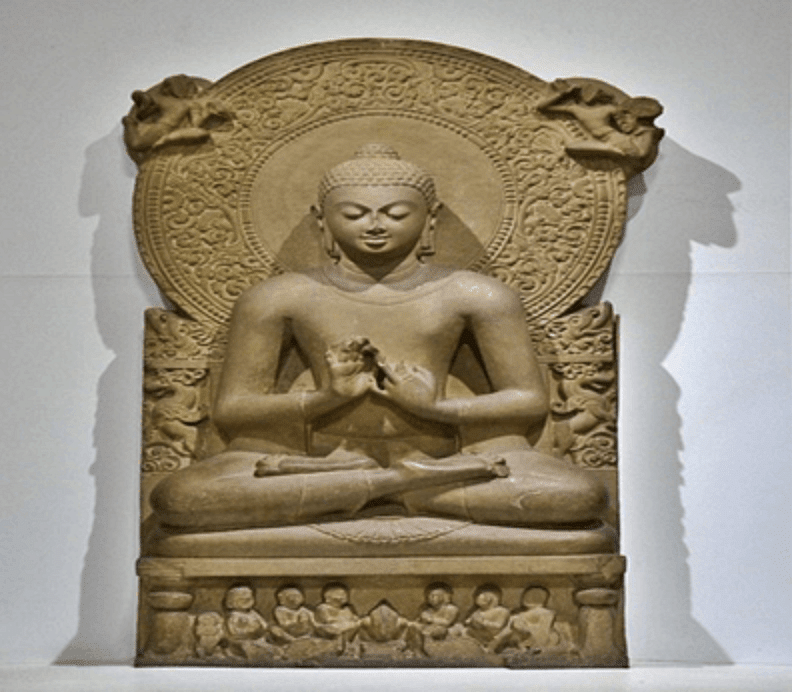 Gautama Buddha of Sarnath
Gautama Buddha of Sarnath
- Usage of cream-coloured sandstone
- Nakedness was missing, more Sobre
- More refined and decorative background
- Hallow effect
- The standing figure of abundantly ornamented Tara is one of the best specimens of sculptural art of Sarnath School.
- The building of new stupas and enlargement of old ones continued in this period. Dhamekh stupa near Sarnath is an example.
- Development of Temple architecture is one of the greatest achievements of Guptas. The temples of the Gupta period brought the new concept of installing statues of Gods in temples, a practice that did not take place earlier. There was also move towards the use of stone in construction instead of the earlier brick or wood.
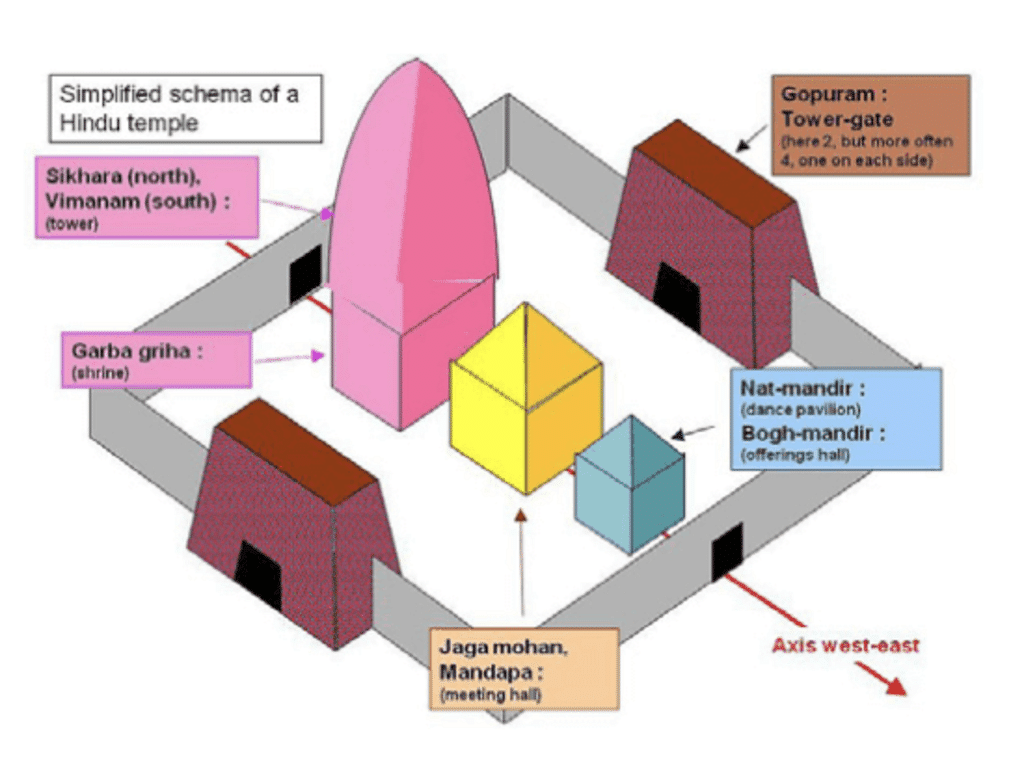 Temple Architecture
Temple Architecture
- Jagati - Raised surface, platform or terrace upon which the temple is placed.
- Mandapa/mantapa - Pillared outdoor hall or pavilion for public rituals.
- Antarala - A small anti-chamber or foyer between the garbhagriha (sanctum sanctorum) and the mandapa, more typical of north Indian temples.
- Ardha Mandapa - Intermediary space between the temple exterior and the garba griha (sanctum sanctorum) or the other mandapas of the temple
- Asthana Mandapa - Assembly hall
- Kalyana Mandapa - Dedicated to ritual marriage celebration of the Lord with Goddess
- Maha Mandapa - When there are several mandapas in the temple, it is the biggest and the tallest. It is used for conducting religious discourses.
- Garbhagriha - The part in which the idol of the deity in a Hindu temple is installed i.e.Sanctum sanctorum.The area around is referred as to the Chuttapalam, which generally includes other deities and the main boundary wall of the temple. Typically there is also a Pradikshna area inside the Grbhagriha and one outside, where devotees can take Pradakshinas.
- Sikhara or Vimana - Literally means "mountain peak", refer to the rising tower over the sanctum sanctorum where the presiding deity is enshrined is the most prominent and visible part of Hindu temples.
- Amalaka - A stone disk, usually with ridges on the rim, that sits atop a temple's main tower (Sikhara).
- Gopuram - The elaborate gateway-towers of south Indian temples, not to be confused with Shikharas.
- Urushringa - An urushringa is a subsidiary Sikhara, lower and narrower, tied against the main sikhara. They draw the eye up to the highest point, like a series of hills leading to a distant peak.
At the turn of the first millennium, CE two major types of temples existed, the northern or Nagara style and the southern or Dravida type of temple. They are distinguishable mainly by the shape and decoration of their shikhara.
- Nagara style: The Shikhar is beehive/curvilinear shaped.
- Dravida style: The Shikhar consists of progressively smaller storeys of pavilions.
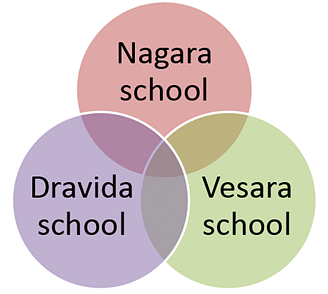 A third style termed Vesara was once common in Karnataka which combined the two styles. This may be seen in the classic Hindu temples of India and Southeast Asia, such as Angkor Wat, Brihadisvara, Khajuraho, Mukteshvara, and Prambanan.
A third style termed Vesara was once common in Karnataka which combined the two styles. This may be seen in the classic Hindu temples of India and Southeast Asia, such as Angkor Wat, Brihadisvara, Khajuraho, Mukteshvara, and Prambanan.
Nagara School
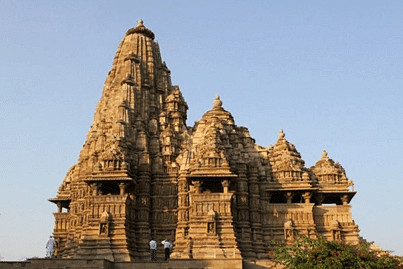 Nagara Temple
Nagara Temple
- In plan, the temple is a square with a number of graduated projections in the middle of each side giving a cruciform shape with a number of re entrant angles on each side.
- In elevation, a Shikhara, i.e., tower gradually inclined inwards in a convex curve.
The projections in the plan are also carried upwards to the top of the Sikhara and, thus, there is strong emphasis on vertical lines in elevation.
The Nagara style is widely distributed over a greater part of India, exhibiting distinct varieties and ramifications in lines of evolution and elaboration according to each locality.
Odisha school
- 8th to 13th century
- Lingaraj temple in Bhubaneshwar
- Sun temple of Kornak (the climax of Nagar style)
- Kandaria Mahadev temple, Kajuraho
- Typical nature is Erotism
- Modhera sun temple
- Rajasthan dilwara jain temple
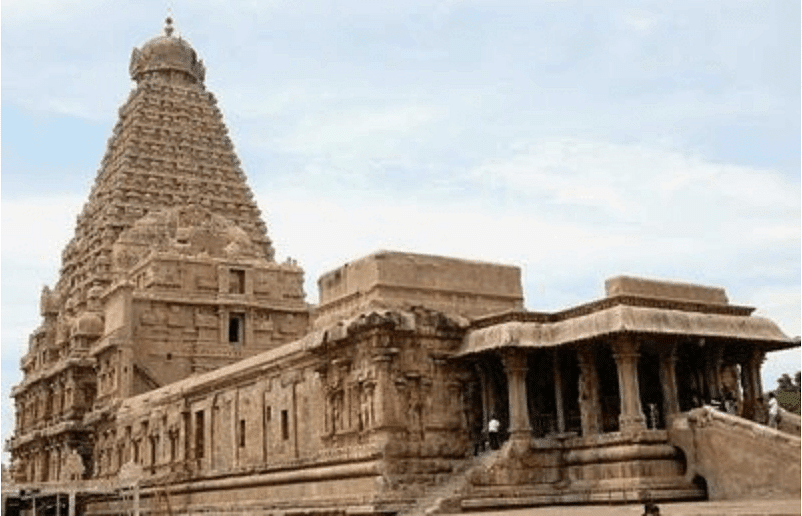 Dravida Temple
Dravida Temple
Dravidian style temples consist almost invariably of the four following parts, differing only according to the age in which they were executed:
- The principal part, the temple itself, is called the Vimana. It is always square in plan and surmounted by a pyramidal roof of one or more stories; it contains the cell where the image of the god or his emblem is placed.
- The porches or Mantapas, which always cover and precede the door leading to the cell.
- Gopurams are the principal features in the quadrangular enclosures that surround the more notable temples.
- Pillared halls or Choultries - used for various purposes, and which are the invariable accompaniments of these temples
Besides these, a temple always contains temple tanks or wells for water (used for sacred purposes or the convenience of the priests); dwellings for all grades of the priesthood are attached to it, and other buildings for state or convenience.
Examples: Brihadeshwara temple (Periya kovil) Thanjavur, Temple of gangaikonda cholapuram
Vesara school
 Vesara Temple
Vesara Temple
- The Vesara style is also called as the Badami Chalukyas style. It has the combined features of both Nagara and Dravida style. The main reason behind the combination is the location of Badami Chalukyas, which was at the buffer zone between northern Nagar style and southern Dravida style.
- The Vesara style reduces the height of the temple towers even though the numbers of tiers are retained. This is accomplished by reducing the height of individual tiers. The semi-circular structures of the Buddhist chaityas are also borrowed as in the Durga temple at Aihole.
- Virupaksha temple of Pattadakal is the finest example of Vesara style. The trend started by the Chalukyas of Badami was further refined by the Rashtrakutas of Manyakheta in Ellora, Chalukyas of Kalyani in Lakkundi, Dambal, Gadag etc. And epitomized by the Hoysala empire. The Hoysala temples at Belur, Halebid and Somnathpur are supreme examples of this style.
- The temples built in the Vesara style are found in other parts of India also. They include temples at Sirpur, Baijnath, Baroli and Ama
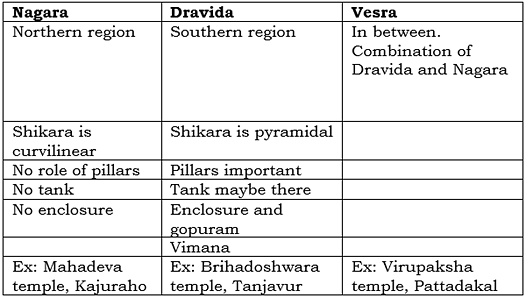
The earliest man-made caves date back to the 2nd century BC while the latest date to the 7th century AD. The earlier caves were used by Buddhist and Jain monks as places of worship and residence. Some examples of this type of cave structure are Chaityas and Viharas of Buddhists.
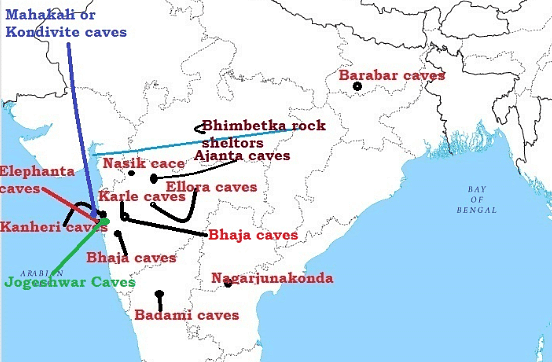
The great cave at Karle is one such example, where great Chaityas and Viharas were excavated. The Karle caves are big in size and the interior is lighted up by great windows.
Other than Buddhist caves many caves of Jains and Hindus were also excavated. Some of the famous and prominent caves are at Nashik, Kanheri, Gaya (Barabar Hills), Bhaja, Nagarjunakonda, Badami, Elephanta and Ellora.
The cave temples of Ajanta are situated north of Aurangabad, Maharashtra. These caves were discovered by the British officers in 1819 AD. The thirty temples at Ajanta are set into the rocky sides of a crescent-shaped gorge in the Sahyadri hills of the Sahyadri ranges. At the head of the gorge is a natural pool which is fed by a waterfall.
 Ajanta Caves
Ajanta Caves
- The earlier monuments include both chaitya halls and monasteries. These date from the 2nd to 1st centuries B.C. The excavations once again revived during the reign of the Vakataka ruler Harisena during the 5th century.
- The sculptures contain an impressive array of votive figures, accessory figures, narrative episodes and decorative motifs.
- The series of paintings is unparalleled in the history of Indian art, both for the wide range of subjects and the medium.
- The caves depict a large number of incidents from the life of the Buddha (Jataka Tales).
- Cave number one contains wall frescos that include two great Bodhisattvas, Padmapani and Avalokiteshvara. Other wonderful paintings in Ajanta are the flying apsara, dying princess and Buddha in preaching mode.
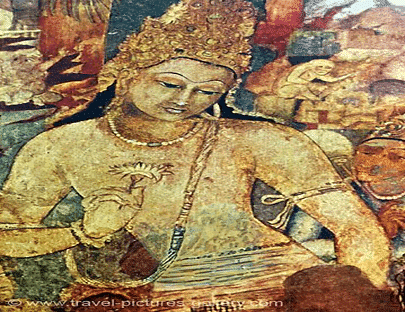 Padampani
Padampani
Fresco is a technique of mural painting executed upon freshly - laid lime plaster. Water is used as the vehicle for the pigment and with the setting of the plaster, the painting becomes an integral part of the wall.
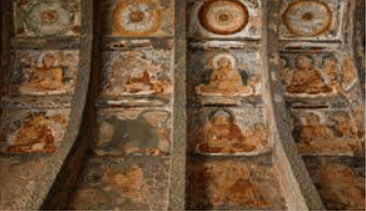 Mural Paintings of Ajanta
Mural Paintings of Ajanta
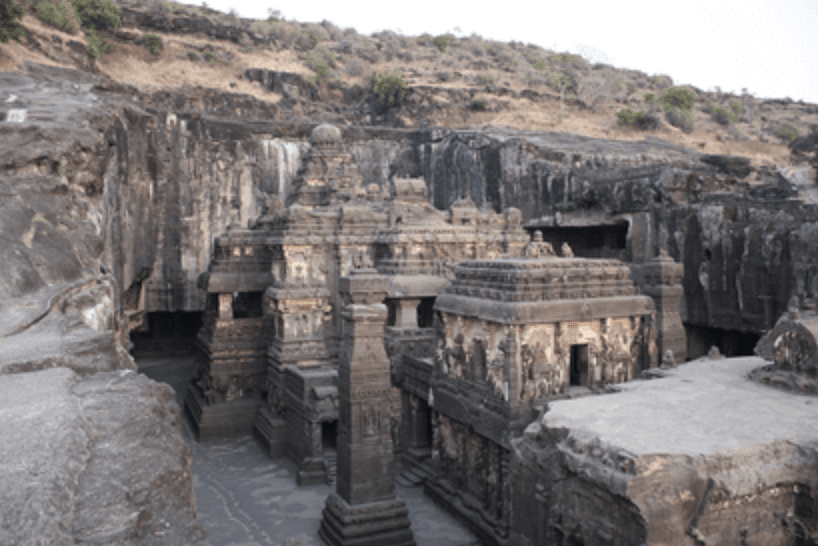 Ellora, Kailash Temple(Cave 16)
Ellora, Kailash Temple(Cave 16)
Ellora is located at 30 km from the city of Aurangabad, Maharashtra. Ellora has 34 caves that are carved into the sides of a basaltic hill. The caves at Ellora contain some of the finest specimens of cave-temple architecture and exquisitely adorned interiors, built by the Rashtrakuta rulers. Ellora represents the epitome of Indian rock-cut architecture.
- The 12 Buddhist caves, 17 Hindu caves, and 5 Jain caves, built-in proximity, demonstrate the religious harmony prevalent during this period of Indian history.
- The nobility, serenity and grace of Buddha are visible in the Buddhist caves of Ellora.
- Ellora caves also contain images of Vishwakarma, the patron saint of Indian craftsmen.
- The Kailasa temple in Cave 16 is indeed an architectural wonder, the entire structure having been carved out of a monolith.
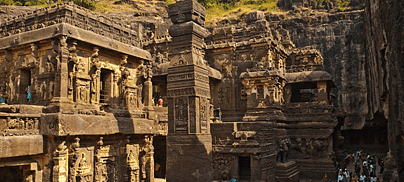 Kailash Temple
Kailash Temple
- Bhimbetka is located in the Raisen District of Madhya Pradesh about 45 km to the southeast of Bhopal. Bhimbetka, discovered in 1958 by V.S. Wakankar, is the biggest prehistoric art depository in India. Atop the hill a large number of rock-shelters have been discovered, of which more than 130 contain paintings.
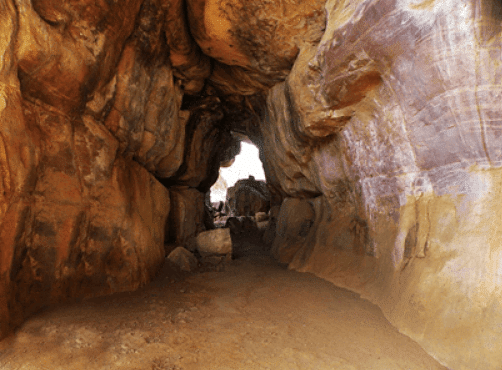 Bhimbetaka Caves
Bhimbetaka Caves
- Excavations in some of the rock-shelters revealed the history of continuous habitation from the early stone age (about 10000 years) to the end of the stone age (c. 10,000 to 2,000 years) as seen from artificially made stone tools and implements like hand-axes, cleavers, scrapers and knives.
- Neolithic tools like points, trapeze and lunate made of chert and chalcedony, besides stone querns and grinders, decorated bone objects, pieces of ochre and human burials were also found here.
Elephanta Caves  Trimurti in the Elephanta Cave
Trimurti in the Elephanta Cave
The Elephanta Caves are a network of sculpted caves located on Elephanta Island in Mumbai Harbour. The island, located on an arm of the Arabian Sea, consists of two groups of caves: the first is a large group of five Hindu caves, the second, a smaller group of two Buddhist caves.
- The Hindu caves contain rock cut stone sculptures, representing the Shiva Hindu sect, dedicated to the god Shiva. The caves are hewn from solid basalt rock.
- The 6th century Shiva temple in the Elephanta caves is one of the most exquisitely carved temples in India. The central attraction here is a twenty-foot high bust of the deity in three-headed form. His image symbolizes the fierce, feminine and meditative aspects of the great ascetic and the three heads represent Lord Shiva as Aghori, Ardhanarishvara and Mahayogi.
- Aghori is the aggressive form of Shiva where he is intent on destruction. Ardhanarishvara depicts Lord Shiva as half-man/half-woman signifying the essential unity of the sexes. The Mahayogi posture symbolises the meditative aspect.
- All the caves were also originally painted in the past, but now only traces remain.
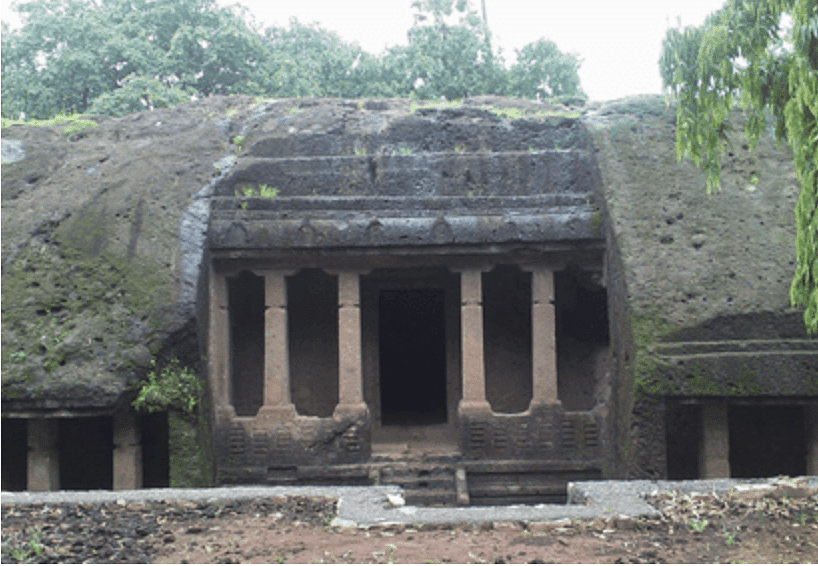 Mahakali Caves
Mahakali Caves
- These are rock-cut Buddhist caves situated in the Udayagiri hills, about 6.5 km from Mumbai. These were excavated during 200 BC to 600 AD and are now in ruins. They comprise of 4 caves on the southeastern face and 15 caves on the northwestern face. Cave 9 is the chief cave and is the oldest and consists of a stupa and figures of Lord Buddha.
Located in the western suburbs of Bombay, it is second largest known cave after the Kailasa cave in Ellora and houses a Brahmanical temple dating back to the 6th century AD. Excavated between the 1st and 2nd centuries, the Kanheri is a 109-cave complex located near Borivali National Park in Bombay. The Kanheri caves contain illustrations from Hinayana and Mahayana Buddhism and show carvings dating back to 200 BC.
The Jogeshwari Caves are some of the earliest Buddhist cave temples sculptures located in the Mumbai suburb of Jogeshwari, India. The caves date back to 520 to 550 CE. These caves belong to the last stage of the Mahayana Buddhist architecture, which was later taken over by the Hindus.
Karla and Bhaja Caves: About 50-60 kms away from Pune, these are rock-cut Buddhist caves dating back to the 1st and 2nd centuries BC. The caves consist of several viharas and chaityas.
The Indo-Islamic Architecture: Indian architecture took a new shape with the advent of Islamic rule in India towards the end of the 12th century AD. New elements were introduced into the Indian architecture are:
- Use of shapes (instead of natural forms)
- Inscriptional art using decorative lettering or calligraphy
- Inlay decoration and use of coloured marble, painted plaster and brilliantly glazed tiles
- Trabeate order was replaced by arcuate architecture i.e. an arch or dome was adopted as a method of bridging a space. Shikara was replaced by Dome.
- Concept of Minar was introduced for the first time
- Cementing agent in the form of mortar for the first time in the construction of buildings in India
- Use of certain scientific and mechanical formulae which helped not only in obtaining greater strength and stability of the construction materials but also provided greater flexibility to the architects and builders
This amalgamation of the Indian and the Islamic elements led to the emergence of a new style of architecture called the Indo-Islamic Architecture.
Mosques
The mosque or masjid is a representation of Muslim art in its simplest form. The mosque is an open courtyard surrounded by a pillared verandah, crowned off with a dome.
- A mihrab indicates the direction of the qibla for prayer
- Towards the right of the mihrab stands the mimbar or pulpit from where the Imam presides over the proceedings.
- An elevated platform, usually a minaret from where the Faithful are summoned to attend the prayers is an invariable part of a mosque.
Large mosques where the faithful assembles for the Friday prayers are called the Jama Masjid.
Tombs
The tomb or maqbara introduced an entirely new architectural concept. While the masjid was mainly known for its simplicity, a tomb could range from being a simple affair (Aurangzeb’s grave) to an awesome structure enveloped in grandeur (Taj Mahal).
- The tomb usually consists of solitary compartment or tomb chamber known as the Huzrah in whose centre is the cenotaph or zarih. This entire structure is covered with an elaborate dome
- In the underground chamber lies the mortuary or the maqbara, in which the corpse is buried in a grave or qabr
- Normally the whole tomb complex or rauza is surrounded by an enclosure
- The tomb of a Muslim saint is called a dargah.
- Almost all Islamic monuments were subjected to free use of verses from the Holy Koran and a great amount of time was spent in carving out minute details on walls, ceilings, pillars and domes
The Delhi or the Imperial Style of Indo-Islamic architecture flourished between 1191-1557 AD and covered Muslim dynasties viz., Slave (1191-1246), Khilji (1290-1320), Tughlaq (1320-1413), Sayyid (1414-1444) and Lodi (1451- 1557).
Delhi Sultanate
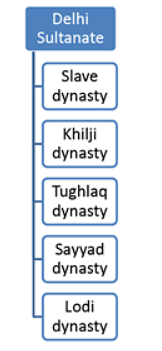 Timeline
Timeline
Slave dynasty: This period marks the period of the beginning of Indo – Islamic architecture. During this period mainly existing buildings were converted.
- The earliest construction work was begun by Qutubuddin Aibak, who started erecting monumental buildings of stone on Qila Rai Pithora, the first of the seven historical cities of Delhi.
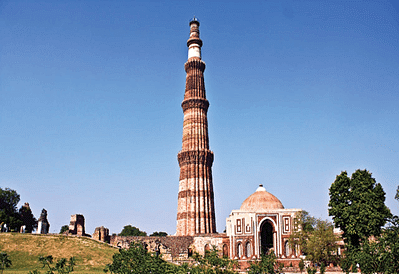 Qutub Minar
Qutub Minar - The Qutb Mosque is one such building. Named as the Quwwatul-Islam Masjid, it is considered as the earliest mosque in India.
- Qutub-ud-din Aibak also started the construction of Qutub Minar in 1192 (which was eventually completed by Iltutmish in 1230). Built to commemorate the entry of Islam it was essentially a victory tower. The diameter of the Qutub Minar is 14.32m at the base and about 2.75m at the top. It measures a height of 72.5m and contains a spiral staircase of 379 steps.
- Shamsuddin Iltutmish extended the Quwwat-ul-Islam Masjid and built the tomb of his son Nasiruddin Mohammed, which is locally known as the Sultan Ghari.
- He also started his own tomb (Iltutmish's Tomb) located in the Qutub Minar complex in 1235 AD.
- The tomb of Balban constructed in 1280 AD represents the first true arch built in India, which is produced by following the scientific system originally formulated by the Roman engineers.
The real development of Indo-Islamic architecture occurred during this period. Red sandstone was widely used and the influence of “Seljuk” tradition can be seen here.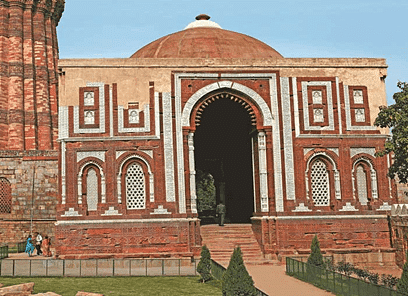 Alai Darwaza, Delhi
Alai Darwaza, Delhi
- Allauddin Khilji established the second city of Delhi at Siri and built the Siri fort.
- He also built the Alai Darwaza near the Qutub Minar. The welldecorated Alai Darwaza, which served as an entrance gateway to the mosque at the Qutub complex, marks the evolution of another innovative feature in the Indo-Islamic architecture.
- The Jamaat Khana Masjid near Nizamuddin in Delhi and the Ukha Masjid in Bharatpur in Rajasthan were also built during this period.
The rulers of the Tughlaq Dynasty also undertook considerable construction activities, including building three of the seven ancient cities of Delhi. Use of Grey sandstone can be seen during this period. The architecture was focussed on strength, not on the beauty. Hence minimum decoration is seen here. The sloping wall is another characteristic feature of Tughlaq architecture.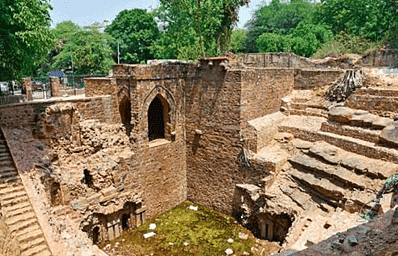 Tughlaq Architecture
Tughlaq Architecture
- Ghiyasuddin Tughlaq built Tughlaqabad, the third city of Delhi, in 1321-23 AD.
- The Tomb of Ghiyasuddin Tughlaq is an irregular pentagon in its exterior plan and its design is of the pointed or "Tartar" shape and is crowned by a finial resembling the kalasa and amla of a Hindu temple.
- Delhi's fourth city Jahanpanah was built by Mohammad-bin-Tughlaq in mid-14th century.
- Feroz Shah Tughlaq was undoubtedly the greatest builder among all the rulers of the Tughlaq dynasty. He built Firozabad, Delhi's fifth city, in 1354 AD. The famous Feroz Shah Kotla ground is the only remnant of its past glory. He is also credited with founding the fortified cities of Jaunpur, Fatehabad and Hisar.
- His construction works were of a uniquely simple style characterised by the use of inexpensive materials.
- It was only Feroze Shah Tughlaq who took up large-scale restoration works and repaired hundreds of monuments, including the Qutub Minar which was damaged by lightning in 1369 AD.
In the 14th century under the Timurid rulers, Islamic architecture underwent a change. The narrow horseshoe arch was replaced by the true arch, an idea imported directly from Persia. They used wooden beams as supports, and eventually, the four-centred arch minus the beam support came into vogue.
During the Sayyid and the Lodi Dynasties, mainly the constructions of tombs were continued. More than fifty tombs of different sizes were constructed.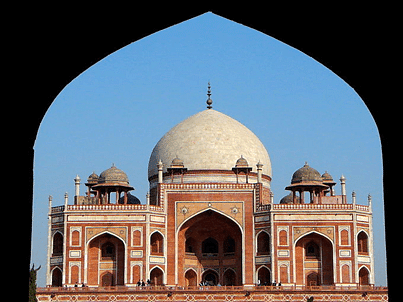 Double dome architecture
Double dome architecture
- The Lodis introduced the concept of double dome built one upon the other, leaving some space in between.
- Two different types of tombs with octagonal and square plans respectively began to be constructed.
- The Tombs of Mubarak Sayyid, Muhammad Sayyid and Sikander Lodi are all of the octagonal type.
- The square tombs are represented by such monuments as the Bara Khan Ka Gumbad, Chota Khan Ka Gumbad, Bara Gumbad.
- The Tomb of Isa Khan, the Tomb of Adham Khan, Moth ki Masjid, Jama Masjid and the Qila-i-Kuhna Masjid belongs to the final phase of the Delhi style of architecture.
PROVINCIAL STYLE - ARCHITECTURE
1) Bengal School of Architecture
- At Gaur the earliest building representing the constructional and ornamental methods of this style is the Dakhil Darwaja built by Barbak Shah (around 1425) as a ceremonial gateway in front of the citadel. It is an imposing structure with a tall arched entrance between vertical pylons on either side and tapering towers on the corners.
- Brick was the chief building material in the alluvial plains of Bengal from early times and remains so even now, the use of stone being limited largely to pillars which were mainly obtained from demolished temples.
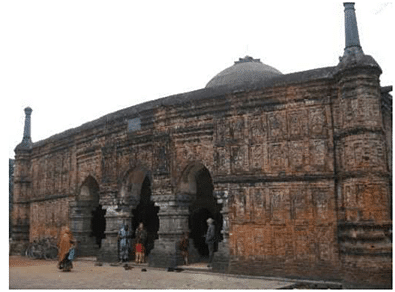
Adhuna Masjid
2) Malwa School of Architecture
- It is essentially Arcuate. Some of its original features were the skillful and elegant use of arch with pillar and beam, lofty terraces approached by well-proportioned stairways, impressive and dignified buildings, various colored stones and marbles, and partly by bright colored glazed tiles.
- The minaret is absent in this style.
- Notable Examples are Rani Rupmati pavilion, Ashrafi Mahal, Jahaz Mahal, and Mandu fort.
Jahaz Mahal
Rani Rupmati Pavilion
3) Jaunpur School of Architecture
It was influenced by the buildings of the Tughlaq period, but its typical feature was its bold and forceful character expressed in the huge imposing pro-pylon screens filling the central and side bays of the prayer hall. Sharqi Dynasty developed it hence also called a charqui style. Notable Example is Atala Masjid.
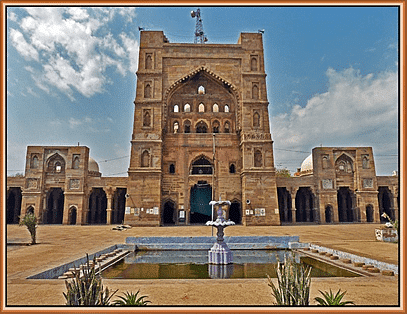
Atala Masjid
4) Bijapur School
- It developed during the reign of Adilshahi. And the most important example is the Gol Gumbaz. The Gol Gumbaz of Bijapur is the mausoleum of Muhammad Adil Shah (1627- 57). It is the largest dome cubicle globally covering a total interior surface of over 1600 sq. metres.
- Architecturally it is a simple construction, its underground vaults consisting of a square grave chamber and a large single square chamber above ground. The large hemispherical dome surmounting it and then seven storeyed octagonal towers on its corners lend it a unique appearance.
- Each of its walls on the outside is divided into three recessed arches, the central one paneled, with running brackets - supported Chajja at the cornice. A 3.4 m. wide gallery rests on its interior at the level of the drum. It is known as the whispering gallery, as even a whisper here reverberates like an echo under the dome. The large dome is hemispherical but is covered with a row of petals at the base.
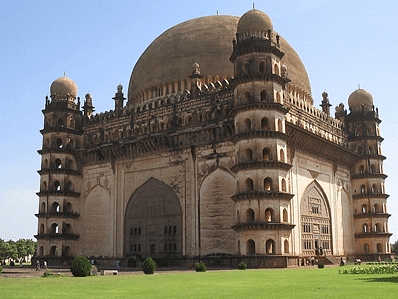
Gol Gumbaz
MUGHAL ARCHITECTURE
The Mughal rulers were visionaries and their personalities reflected in the all-round development of various arts, crafts, music, building, and architecture. The Mughal dynasty was established with the crushing victory of Babar at Panipat in 1526 AD.
Babar
- During his short five-year reign, Babar took considerable interest in erecting buildings, though few have survived.
- The mosque at Kabuli Bagh at Panipat and the Jami Masjid at Sambhal near Delhi, both constructed in 1526, are the surviving monuments of Babar.
Humayun
- Babur’s son Humayun laid the foundation of a city called Dinpanah ("refuge of the faithful") at the Purana Qila in Delhi, but the city could not be completed.
- Humayun’s tomb, designed in 1564 by his widow Haji Begum, was the real beginning of Mughal architecture in India.
The important characteristics of Humayun’s tomb are:
- Charbagh style.
- Use of red sandstone.
- Use of a round – bulb-like dome.
- Design of the Taj Mahal was modeled on this tomb.
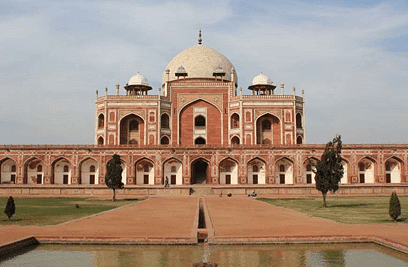
Humayun's Tomb
Sher Shah
- During his brief reign, Sher Shah built a few monuments. He built the Qila-e-Quhunah (Mosque of the Old Fort) mosque in Delhi. He built the famous Rohtas Fort in Pakistan. He constructed the Sher Shah Suri Masjid in Patna in Afghan style to mark his reign.
- His period is a transition from Lodhi style to the Mughal style of architecture. He also undertook the re-construction and extension of an old Mauryan route and renamed it as Sadak-e-Azam (Great Road), later called Grand Trunk Road. He ensured the adequate presence of sarais and trees for travellers.
- Sher Shah Suri’s tomb was built at his birthplace Sasaram. It is made up of red sandstone and is situated inside a lake. The constructions under Sher Shah continued the traditions of the Delhi Sultanate period. After Akbar ascended the throne of Delhi in 1556, the golden period of Mughal art and architecture started.
Akbar
- Architecture flourished during the reign of Akbar. The chief feature of the architecture of Akbar's time was the use of red sandstone.
- The domes were of the "Lodi" type, while the pillar shafts were many-sided with the capitals being in the form of bracket supports.
- One of the first major building projects was the construction of a huge fort at Agra.
- Creation of an entirely new capital city at Fatehpur Sikri. The buildings at Fatehpur Sikri blended both Islamic and Hindu elements in their architectural style.
- The Buland Darwaza, the Panch Mahal and the Dargah of Salim Chisti are the most imposing of Fatehpur Sikri's buildings.
- Akbar also built a temple of Govind Dev in Vrindavan.
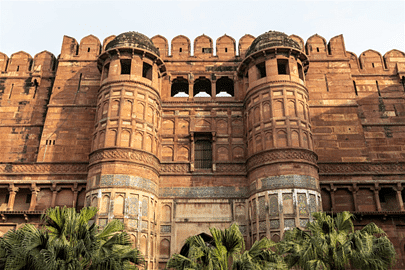
Amar Singh Gate, Agra Fort
Jahangir
- Jahangir concentrated more on painting and other forms of art than on building and architecture. However, some noteworthy monuments of his time include Akbar's Tomb at Sikandra near Agra.
Some of the important features of Jahangir’s architecture are:
(i) Persian style, covered with enamelled tiles.
(ii) Usage of marbles and precious gems.
(iii) Usage of white marble and covered in pietra dura mosaic.
- Jahangir is the central figure in the development of the Mughal gardens. The most famous of his gardens is the Shalimar Bagh on the banks of Lake Dal in Kashmir.
- Itimad-ud-Daulah's Tomb is another important monument built during this period. It was commissioned by Nur Jahan, Jahangir's wife, for her father Mirza Ghiyas Beg, who had been given the title of Itimad-ud-Daulah (pillar of the state). Mirza Ghiyas Beg was also the grandfather of Mumtaz Mahal. The monument also called a “Jewel box”, was built in White marble.
- The Jahangir's Tomb at Shahdara near Lahore, built by his wife Nur Mahal, is another outstanding architectural production of this time.
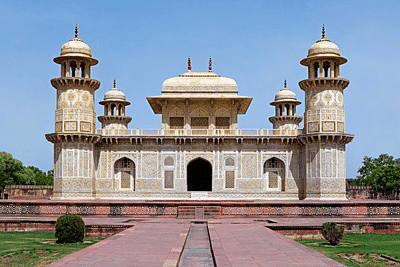
Itmad-ud-daulah’s tomb, Agra
Shah Jahan
The Mughal architecture reached its climax during the reign of Shah Jahan. The single most important architectural change was the substitution of marble for the red sandstone.
- He demolished the austere sandstone structures of Akbar in the Red Fort and replaced them with marble buildings such as the Diwan-i-Am and the Diwan-i-Khas.
- In 1638 he began to lay the city of Shahjahanabad beside the river Jamuna.
- The Red Fort at Delhi represents the pinnacle of centuries of experience in the construction of palace forts.
- Outside the fort, he built the Jama Masjid, the largest mosque in India.
- He built the Jami Masjid at Agra in 1648 in honour of his daughter Jahanara Begum.
- More than all these fine architecture, it is for building the Taj Mahal at Agra, he was remembered often. It was built as a memorial to his beloved wife, Mumtaz Mahal. It is considered the finest example of Mughal architecture, which combines elements from Islamic, Persian, Ottoman Turkish and Indian architectural styles.
Some of the important features of Taj Mahal are:
▪ Use of white marble.
▪ More decoration.
▪ Massive size.
▪ Use of char bagh style.
▪ Use of pietra dura technique.
▪ Tomb building at its climax.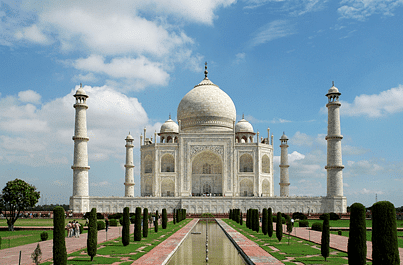 Taj Mahal
Taj Mahal
Other Shah Jahan constructions
- Red Fort in Delhi.
- Jama Masjid in Delhi.
- Shalimar Bagh in Lahore.
- City of Shahjahanabad.
- Peacock Throne(metalwork).
Aurangazeb
- The architectural projects of Aurangzeb's reign are represented by the Bibi-ki-Maqbara, the tomb of Aurangzeb's wife Begum Rabia Durani, a poor replica of the famous Taj Mahal and is also called as Taj Mahal of South India.
- After the death of Aurangzeb, the Mughal architecture started declining. Aurangzeb's daughters contributed in a small way in carrying forward the Mughal trend of architecture. Zeenat-unnisa Begum built the Zinat-ul-Masjid at Daryaganj in Old Delhi.
- The only significant monument built in the post-Aurangazeb time in Delhi was the Safdar Jung's Tomb built in 1753 by Mirza Mansoor Khan.
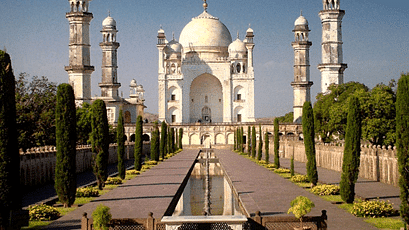 Bibi-ki-Maqbara
Bibi-ki-Maqbara
Safdar Jung's Tomb
Sikh style of architecture developed in the region of modern-day Punjab. The Mughal style of architecture heavily influenced ite. Some of the Sikh school features are the Sikh style of architecture developed in the region of modern-day Punjab. The Mughal style of architecture heavily influenced ite.
Some of the features of the Sikh school are:
- The use of multiple Chhatris or kiosks on the top of the construction.
- Use of shallow cornices.
- The building has fluted domes, which were generally covered by brass and copper guilds for decoration and support. The use of numerous foliations decorated the arches.
- Example: Shri Harmandir Sahib or Golden temple. It was initiated in 1585 and completed by Arjan Dev in 1604.
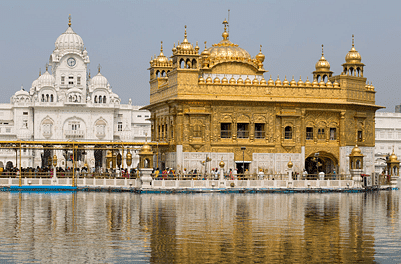
Harmandir Sahib Golden Temple, Amritsar
2) Rajput Style
The Rajput constructions of the period were also influenced by the Mughal style, but were unique in their constructions' size and scope. They generally undertook the building of imposing palaces and forts.
Some of the unique features of the Rajput architecture are as follows:
- They introduced the concept of the hanging balcony, which were constructed in all shapes and sizes.
- The chronicles were built in the shape of an arch such that the shadow took the shape of a bow.
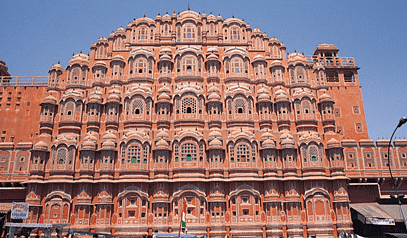
Hawa Mahal, Jaipur with hanging balconies
3) Architecture in Kashmir
- Development of Kashmiri architecture can be broadly divided into two important phases: its political rule, early medieval Hindu phase and 14th century onwards Muslim rule.
- No major monuments made before 600 AD exist, except few Buddhist monuments like monastery and stupas, now in ruins, were discovered at Harwan and Ushkar.
Temples in Kashmir
The Kashmiri temple architecture has its unique features suited to local geography and is renowned for its exquisite stone carvings. Due to its location on the important trade routes, the architectural style is inspired by many foreign sources. Temple making reached a great height under the rulers of Karakota dynasty and Utpala dynasty.
The main features of the Kashmir style of architecture are:
- Trefoil arches (Gandhara influence)
- Cellular layout and Enclosed courtyard
- Straight-edged Pyramidal roof
- Column walls (Greek influence)
- Triangular pediment (Greek influence)
- Relatively more number of steps
➢ Martand Sun Temple
- It is located in Anantnag, Kashmir and was built in 8th century AD under Karkota Dynasty ruler Lalitaditya Muktapida.
- It is considered to be a synthesis of various schools of architecture. There are Gandhara, Chinese and Gupta influence on the monuments. The complex is in the shape of the courtyard, surrounded by columns. The main temple has a pyramidal top and gods like Vishnu, river goddess Ganga and Yamuna, and Sun God.
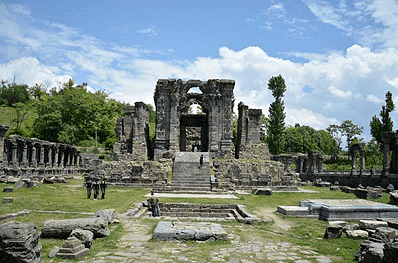 Martand Sun Temple (Left) and Artistic recreation of Martand Temple (right)
Martand Sun Temple (Left) and Artistic recreation of Martand Temple (right)
➢ Temples at Awantipora
There are two temples namely Avantiswami for Lord Vishnu and Avantiswara dedicated to Lord Shiva. It was built by the king Awantivarman, the first king of Utpala dynasty, in 9th century AD. The temple is inside a paved courtyard and has four shrines in its four corners. The gateway has two chambers and is carved out eloquently. Roman and Gandharan influence is seen.
➢ Pandrethan Temple
It is also called Meru Vardha Swami and is dedicated to Vishnu, but Shiva images are also there. It was carved out of a single block of stone and has exquisite carvings on its walls. It was made in early 10th century AD and is located near Srinagar. It has a domed roof and arches.
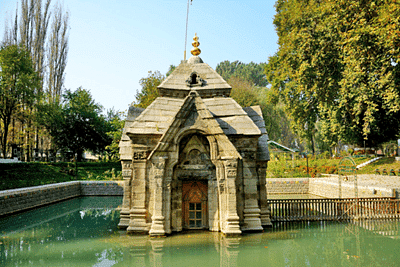
Pandrethan Temple, Kashmir
4) Temples of the Parsi community in India
There are three major types of fire temples of the Parsi faith. The first is Atash Behram, (“Fire of Victory”), second is Adarian, and the third is Atash Dadgah or Dar-e-Mehr. There are eight Atash Behram in India and more than 100 Dadgah, mostly located in Maharashtra and Gujarat.
The exterior is generally kept simple because idea is to hold a sacred fire and Yasna ceremony (prayers) rather than glorification of the faith. It has an inner sanctum where fire is kept. The structures have vents for the smoke to escape. The performance of ceremony is considered to be of the highest order and involves elaborate arrangements. They are performed by the high priests called Dasturs.
Eight Atash Behrams (Fire Temples) in India are:
- Iranshah Atash Behram, Udvada (Gujarat), built-in 8th century.
- Desai Atash Behram in Navsari (Gujarat), built-in 18th century.
- Dadiseth, Wadia, Banaji and Anjuman Atash Behram in Mumbai.
- Modi and Vakil Atash Behram in Surat.
Sun Temples in India:-
Sun has been revered since Vedic age with many hymns written for the celestial body. It is worshipped as Aditya or Surya. There are many rituals in practice for worshipping the deity. Many temples have also been constructed with Sun as the chief deity. Sun temples are even found in Japan, Egypt, China, etc. Some of the Rajput clans, namely “Suryavanshi”, worship Sun and claim themselves to be the deity's descendants.
Some of the major temples in India are:
- Modhera Sun Temple, Gujarat. It was built in the 11th century.
- Konark Sun temple, Odisha. Narasimhadeva made it I, the Eastern Ganga king in the 13th century. It is in the shape of “Rath”(Chariot) with a mandala on a raised platform.
- Brahmanya Dev Temple, Unao (Madhya Pradesh).
- Suryanar Kovil, Kumbakonam (Tamil Nadu) was built in 11th century in Dravidian style. It also has shrines of eight celestial bodies, together called ‘Navagraha’. It has a beautiful five-layered Gopuram.
- Suryanarayana Swamy temple, Arasavalli (Andhra Pradesh). It is said to be made by a Kalinga king in the 7th century. The idol is made of granite and holds a lotus.
- Dakshinaarka Temple, Gaya (Bihar) is said to be built by King Prataparudra of Warangal in the 13th century AD. The deity is made in granite and the idol wears Persian attire like waist girdle, boots and a jacket. It has a Surya Kund (water reservoir) nearby.
- Navalakha Temple, Ghumli (Gujarat) was made in the 11th century. It is built in Solanki and Maru-Gurjara style. It faces east and is built on a large platform.
- Surya Pahar Temple, Goalpara (Assam).
- Martand Sun temple, Kashmir.
MODERN INDIA
Colonial Architecture
European colonists brought India concepts of their "world view" and whole baggage of the history of European architecture: Neo-Classical, Romanesque, Gothic and Renaissance. The initial structures were utilitarian warehouses and walled trading posts, giving way to fortified towns along the coastline.
➢ Portuguese
- The Portuguese adapted to India the climatically appropriate Iberian galleried patio house and the Baroque churches of Goa.
- Cathedral and Arch of Conception of Goa were built in the typical Portuguese-Gothic style.
- The St. Francis Church at Cochin, built by the Portuguese in 1510, is believed to be the first church built by the Europeans in India.
- The Portuguese also built the fort of Castella de Aguada near Mumbai and added fortifications to the Bassein fort.
➢ Dutch
- The Danish influence is evident in Nagapattinam, which was laid out in squares and canals and in Tranquebar and Serampore.
➢ French
- The French gave a distinct urban design to its settlement in Pondicherry by applying the Cartesian grid plans and classical architectural patterns.
- The Church of Sacred Heart of Jesus (Eglise De Sacre Coeur De Jesus), the Eglise de Notre Dame de Anges and the Eglise de Notre Dame de Lourdes at Pondicherry have a distinct French influence.
➢ British
- It was the British who left a lasting impact on India architecture. They saw themselves as the successors to the Mughals and used architecture as a symbol of power. British started a new hybrid style of architecture called Indo – Saracenic style or Indo – Gothic style. It was a combination of Indian, Islamic and European architectures.
- The first buildings were factories but later courts, schools, municipal halls and dak bungalows came up, which were ordinary structures, built by garrison engineers.
- A deeper concern with architecture was exhibited in churches and other public buildings. The Church of St. John at Calcutta built in 1787, St. Mary's Church in Fort St. George in Chennai are some of the examples.
- Most of the buildings were adaptations of the buildings designed by leading British architects in London and other places. The Indo-Gothic architecture flourished in different parts of India under the British.
- Some of the important architecture are:Gateway of India – Mumbai, Chepak palace – Chennai, Lakshmi vilas palace – Baroda, Victoria memorial – Kolkata.
Gateway of India, Mumbai
The British built New Delhi as a systematically planned city after it was made the capital in 1911. Sir Edward Lutyens was made responsible for the overall plan of Delhi. He was specifically directed to "harmonise externally with the traditions of Indian art".
- The Western architecture with Oriental motif was released with chajjas, jalis and chhatris, as stylistic devices in the Viceroy's House (Rashtrapati Bhawan).
- Herbert Baker added the South Block's imposing buildings and the North Block, which flank the Rashtrapati Bhawan.
- Another Englishman called Robert Tor Russell built the Connaught Place and the Eastern and Western Courts.
- St Martin’s Garrison Church marks the culmination of the British architectural ventures in India. The Church is a huge monolith with a high square tower and deeply sunken window ledges reminiscent of Dutch and German architecture.
- The earliest known evidence of man in our country was in Bori in Maharashtra and dates back to 1.4 million years ago
- Prehistory is the period that has records of human activities, civilization, using of stone tools. This period doesn’t witness any writings from the civilians, therefore, this period is the prehistoric period in Ancient history.
- Prehistory also refers to the hunter-gather lifestyle of people in that era/ period. Pre-history is the fact of origin of human activities and civilization thousands of years ago. In general, prehistory is divided into 3 ages and hence the name was given "A 3 Age System".
- The 3 ages are: Stone Age, Bronze Age, and Iron Age.
These 3 ages give pieces of evidence of human activity in ancient times. These ages are evolutionary ages in humankind.
- The stone age is the prehistoric period, i.e., the period before the development of the script, therefore the main source of information for this period is the archaeological excavations. Robert Bruce Foote is the archaeologist who discovered the first paleolithic tool in India, the Pallavaram handaxe.
- On the basis of geological age, the type and technology of stone tools, and subsistence base, the stone age is classified primarily into three types:
- Paleolithic
- Mesolithic
- Neolithic
- The term ‘Palaeolithic’ is derived from the Greek word ‘paleo' which means old and ‘lithic’ meaning stone. Therefore, the term Palaeolithic age refers to the old stone age.
- The old stone age or paleolithic culture of India developed in the Pleistocene period or the Ice Age, which is a geological period of the age when the earth was covered with ice and weather was so cold that human or plant life could not survive. But in the tropical region, where ice melted, the earliest species of men could exist.
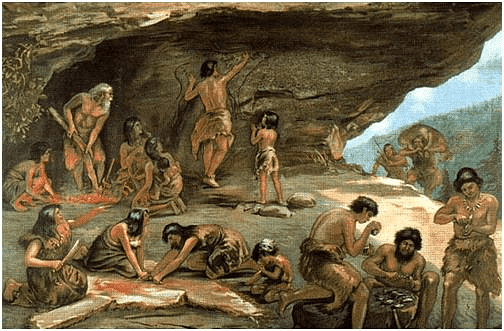 Living in Paleolithic age
Living in Paleolithic age
Main characteristics of the Palaeolithic age:
- The Indian people are believed to have belonged to the ‘Negrito’ race, and lived in the open air, river valleys, caves and rock shelters.
- They were food gatherers, ate wild fruits and vegetables, and lived on hunting.
- There was no knowledge of houses, pottery, agriculture. It was only in later stages they discovered fire.
- In the upper paleolithic age, there is evidence of art in the form of paintings.
- Humans used unpolished, rough stones like hand axes, choppers, blades, burins and scrapers.
The old stone age or paleolithic age in India is divided into three phases according to the nature of the stone tools used by the people and also according to the nature of the change of climate.
(a) Lower Palaeolithic Age: up to 100,000 BC
- It covers the greater part of the Ice Age.
- Hunters and food gatherers; tools used were hand axes, choppers and cleavers. Tools were rough and heavy.
- One of the earliest lower Palaeolithic sites is Bori in Maharashtra.
- Limestone was also used to make tools.
- Major sites of lower Palaeolithic age: Soan valley (in present Pakistan), Sites in the Thar Desert, Kashmir, Mewar plains, Saurashtra, Gujarat,Central India,Deccan Plateau, Chotanagpur plateau, North of the Cauvery River, Belan valley in UP
- There are habitation sites including caves and rock shelters.
- An important place is Bhimbetka in Madhya Pradesh.
(b) Middle Palaeolithic Age: 100,000 BC – 40,000 BC
- Tools used were flakes, blades, pointers, scrapers and borers.
- The tools were smaller, lighter and thinner.
- There was a decrease in the use of hand axes with respect to other tools.
- Important middle Palaeolithic age sites: Belan valley in UP, Luni valley (Rajasthan), Son and Narmada rivers, Bhimbetka, Tungabhadra river valleys, Potwar Plateau (between Indus & Jhelum), Sanghao cave (near Peshawar, Pakistan)
(c) Upper Palaeolithic Age: 40,000 BC – 10,000 BC
- The upper palaeolithic age coincided with the last phase of the ice age when the climate became comparatively warmer and less humid.
- The emergence of Homo sapiens.
- The period is marked by innovation in tools and technology. A lot of bone tools, including needles, harpoons, parallel-sided blades, fishing tools and burin tools.
- One of the major sites were Bhimbhetka (South of Bhopal), where hand axes and cleavers, blades, scrapers and a few burins have been found.
- Major sites of Upper Palaeolithic age: Belan, Son, Chota Nagpur plateau (Bihar), Maharashtra, Orissa and The Eastern Ghats in Andhra Pradesh
- Bone tools have been found only at cave sites of Kurnool and Muchchatla Chintamani Gavi in Andhra Pradesh.
- The term Mesolithic is derived from two Greek words – ‘meso’ and ‘lithic’. In Greek ‘meso’ means middle and ‘lithic’ means stone. Hence, the Mesolithic stage of prehistory is also known as the ‘Middle Stone Age’.
- Both Mesolithic and Neolithic phases belong to the Holocene era. In this era, there was a rise in temperature, the climate became warm which resulted in melting of ice and also brought changes in flora and fauna.
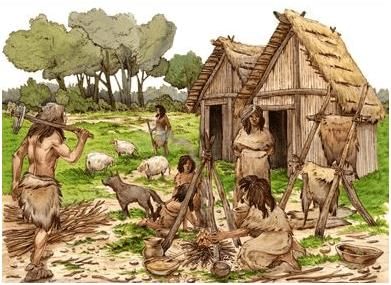 Mesolithic age group people
Mesolithic age group people
Characteristic Features of the Mesolithic Era
- It intervened as a transitional phase between the Palaeolithic Age and the Neolithic or New Stone Age.
- The Mesolithic people lived on hunting, fishing, and food gathering: at a later stage they also domesticated animals. The first three occupations continued the paleolithic practice, while the last was interrelated with the neolithic culture.
- The characteristic tools of the Mesolithic Age are microliths. The miniature stone tools usually made of crypto-crystalline silica, chalcedony or chert, both of geometrical and non-geometrical shapes. They were not only used as tools but were also used to make composite tools, spearheads, arrowheads, and sickles after hafting them on wooden or bone handles. These microliths enabled the Mesolithic man to hunt smaller animals and birds.
- The Mesolithic men started to wear clothes made of animal skin. The Mesolithic men started to wear clothes made of animal skin.
- The first human colonization of the Ganga Plains happened during this period.
- The people of this era believed in life after death and hence they buried the dead with food items and other goods.
- The mesolithic sites are found in good numbers in Rajasthan, southern Uttar Pradesh, central and eastern India and also south of the river Krishna Of them Bagor in Rajasthan is very well excavated.
- It had a distinctive microlithic industry, and its inhabitants subsisted on hunting and pastoralism. The cultivation of plants around 7000-6000 B.C. is suggested in Rajasthan from a study of the deposits of the former Salt Lake, Sāmbhar.
- The people of the paleolithic and Mesolithic ages practiced painting. Prehistoric art appears in several places, but Bhimbetka in Madhya Pradesh is a striking sight. Situated in the Vindhya range, 45 km south of Bhopal, it has more than 500 painted rock shelters, distributed in an area of 10 sq km.
- Perching birds, which live upon grain, are absent in the earliest group of paintings, which evidently belong to the hunting/gathering economy.
Important Mesolithic Sites
- Bagor in Rajasthan is one of the biggest and best-documented Mesolithic sites in India. Bagor is on river Kothari where microliths along with animal bones and shells have been excavated.
- Adamgarh in Madhya Pradesh provides the earliest evidence for the domestication of animals.
- There are about 150 Mesolithic rock art sites across India, with a rich concentration in Central India such as Bhimbetka caves (Madhya Pradesh), Kharwar, Jaora and Kathotia (M.P), Sundargarh and Sambalpur (Odisha), Ezhuthu Guha (Kerala).
- Microliths have also been found in some valleys of river Tapi, Sabarmati, Narmada, and Mahi.
- Langhnaj in Gujarat and Biharanpur in West Bengal are also important Mesolithic sites. Bones of wild animals (rhinoceros, blackbuck, etc.) have been excavated from Langhnaj. Several human skeletons and a large number of microliths have been recovered from these places.
- Though pottery is absent at most Mesolithic sites, it has been found in Langhnaj (Gujarat) and in the Kaimur region of Mirzapur (U.P).
- In the world context the New Stone Age began in 9000 B.C.
- The term Neolithic is derived from the Greek word ‘neo’ which means new and ‘lithic’ meaning stone. Thus, the term Neolithic Age refers to the ‘New Stone Age’.
- It is also termed as ‘Neolithic revolution’ since it introduced a lot of important changes in man’s social and economic life. The Neolithic age saw man turning into a food producer from food gatherer.
- The neolithic phase in south India seems to have covered the period from about 2000 B.C. to 1000 B.C. The Neolithic settlers were the earliest farming communities. They broke the ground with stone hoes and digging sticks at the end of which ring stones weighing one to half a kilogram were fixed. They produced ragi and horse gram (kulathi). The neolithic people of Mehrgarh were more advanced. They produced wheat, cotton, and lived in mud-brick houses.
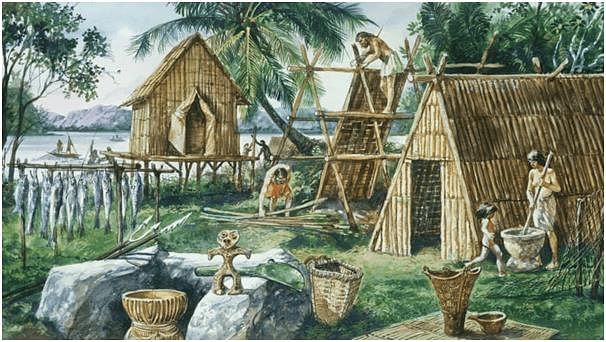
Characteristic Features of the Neolithic Age
- Tools and Weapons: The people used microlithic blades in addition to tools made of polished stones. The use of celts was especially important for ground and polished hand axes. They also used tools and weapons made of bones – such as needles, scrapers, borers, arrowheads, etc. The use of new polished tools made it easier for humans to cultivate, hunt and perform other activities in a better manner.
- Agriculture: The people of the Neolithic age cultivated land and grew fruits and corn like ragi and horse gram (kulati). They also domesticated cattle, sheep and goats.
- Pottery: With the advent of agriculture, people were required to store their food grains as well as to cook, eat the product, etc. That’s why it is said that pottery appeared in this phase on a large scale. The pottery of this period was classified under greyware, black-burnished ware, and mat impressed ware. In the initial stages of the Neolithic age, handmade pottery was made but later on, foot wheels were used to make pots.
- Housing and Settled Life: The people of Neolithic age lived in rectangular or circular houses which were made of mud and reeds. Neolithic men also knew how to make boats and could spin cotton, wool and weave cloth. The people of the Neolithic age led a more settled life and paved the way for the beginning of civilization.
- The neolithic people did not live far away from the hilly areas. They inhabited mainly the hilly river valleys, rock shelters and the slopes of the hills, since they were entirely dependent on weapons and tools made of stone.
- The period between 9000 B.C. and 3000 B.C. saw remarkable progress of technology in western Asia because the people developed the arts of cultivation, weaving, pot making, house building, domestication of animals, etc. But the Neolithic Age in the Indian subcontinent began around the sixth millennium B.C.
Based on the types of axes used by Neolithic settlers, we notice three important areas of Neolithic settlements:
(a) The north-western group of neolithic tools represents rectangular axes with curved cutting edge.
(b) The north-eastern group shows polished stone axes with rectangular butt and has occasional shouldered hoes.
(c) The southern group is distinguished by axes with oval sides and pointed butt.
Important Neolithic Sites
- Koldihwa and Mahagara (lying south of Allahabad) – This site provides evidence of circular huts along with crude hand made pottery. There is also evidence of rice, which is the oldest evidence of rice, not only in India but anywhere in the world.
- Mehrgarh (Balochistan, Pakistan) – The earliest Neolithic site, where people lived in houses built of sun-dried bricks and cultivated crops like cotton and wheat.
- Burzahom (Kashmir) – It means ‘the place of birth’ and is situated 16 km northwest of Srinagar. The domestic dogs were buried along with their masters in their graves; people lived in pits and used tools made of polished stones as well as bones.
- Gufkral (Kashmir) – This neolithic site is famous for pit dwelling, stone tools and graveyards in houses.
- Chirand (Bihar) – The neolithic men used tools and weapons made of bones.
- Piklihal, Brahmagiri, Maski, Takkalakota, Hallur (Karnataka) – The people were cattle herders. They domesticated sheep and goats. Ash mounds have been found.
- Belan Valley (which is located on the northern spurs of the Vindhyas and middle part of Narmada valley) – All three phases i.e., paleolithic, mesolithic, and neolithic ages are found in the sequence.
- Neolithic tools are also found in the Garo hills in Meghalaya on the northeastern frontiers of India.
- Neolithic celts, axes, adzes, chisels, etc., have also been found in the Orissa and Chotanagpur hill areas.
The metal age marks the end of the stone age. Metal age is broadly categorized into two ages and they are as follows
Bronze itself is harder and more durable than other metals available at the time, allowing bronze age civilizations to gain a technological advantage. This age was the first witness in Egypt. Most commonly metals in this period were copper and bronze.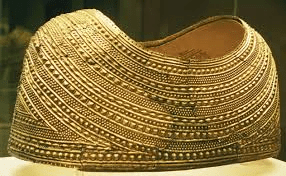
In the 19th century, the use of iron increased and hence rise of Iron Age. This age is the last age of the ” 3 Age System”. This age brought an end to the bronze age. Weapons were also made of iron in this era.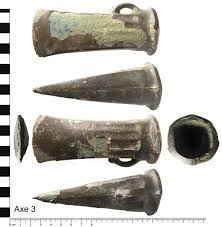
The ancient Indian literature was mostly religious in nature and contains no definite date for events and kings.
Example: The Puranas and the epics. Vedic literature has no trace of political history but has reliable glimpses of the culture and civilisation of the age. The epics like Ramayana, Mahabharata and the Jaina and Buddhist religious texts supply us with some important historical material with doses of religious messages. Ramayana
Ramayana
- Upanishads: Main source of Indian philosophy; also called "Vedanta". Jaina Parisistaparvan, Buddhist Dipavamsa and Mahavamsa contain traditions which supply us with some historical materials.
- Gargi Samhita, a book on astronomy, the grammar of Panini and Patanjali also contain materials that help us in the reconstruction of the history of the ancient period of India.
- From the second half of the ancient period of Indian history, there are not only panegyrics of kings and emperors but also political treatise dealing with the principles of administration.
- Kautilya's Arthashastra and Manusmriti may be mentioned in this connection. It was a work of the Maurya period. Vishakhadatta's Mudrarakshasa gives a glimpse of Maurya society and culture.
- Similarly, events of the Pushyamitra Sunga's reign are mentioned by Kalidasa in Malavikagnimitram.
- Among the personal accounts of the ancient period, Banabhatta's Harshacharita, dealing with the character and achievements of Harshavardhana as also the history of his times.
- Bharathiraja's Gaudavaho describes how Yasovarman conquered Gauda deserve special mention. Poet Bilhana described the history of the reign of Chalukya king Vikramaditya VI in his Vikramanka Charita.
- Sandhyakar Nandi'S Ramacharita is a description of the reign of Rampal, a king of the Pala dynasty of Bengal.
- Kalhana's Rajatarangini is a valuable book on the history of the kings of Kashmir.
- Likewise, Padmagupta Navasahasanka Charita, Hem Chandra Dwasraya Kavya, Nyaya Chandra's Hammir Kavya, Ballal's Bhoja Prabandha contain important historical materials.
The archaeological evidence is obtained by the systematic and skilled examination of building monuments, and work of art. The credit for excavating the pre-Aryan past goes to Sir William Jones of the Asiatic Society of Bengal (established on 1st January 1784).
- General Sir Alexander Cunningham, one of its Royal Engineers, dug out the ruins of an ancient site of pre-Aryan culture. From his arrival in India in 1831, Cunningham, the Father of Indian Archaeology devoted every minute he could spare from his military duties to the study of material remains of ancient India, until in 1862, the Indian government established the post of Archaeological Surveyor, to which he was appointed.
- Until his retirement in 1885, he devoted himself to the unravelling of India's past with complete single-heartedness.
- In 1901, Lord Curzon revised and enlarged the Archaeological Survey and appointed John Marshall its Director-General.
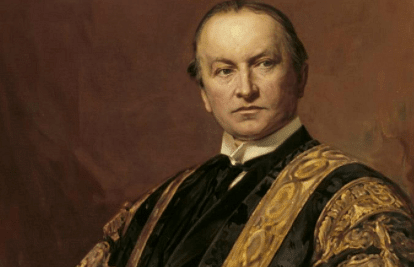 Lord Curzon
Lord Curzon- The discovery of India's oldest cities dating back to the second Inter-Glacial period between 400,000 and 200,000 BC in 1921 by Daya Ram Sahni was the biggest achievement of the Archaeological Survey of India under Marshall, the first relics of which were noticed by Cunningham.
- The cities discovered were named Harappa and Mohenjodaro and the civilisation as the Indus Valley Civilisation. In 1922, an Indian officer of the Archaeological Survey, R.D.Banerjee, founded further seals at Mohenjodaro in Sindh and recognized that they were remains of a pre-Aryan civilisation of great antiquity. Under Sir John Marshall's direction, the sites were systematically excavated from 1924 until his retirement in 1931.
Inscriptions are the most reliable evidence and their study is called epigraphy. These are mostly carved on gold, silver, iron, copper, bronze plates or stone pillars, rocks, temple walls and bricks and are free from interpolations.
- Inscriptions again are mainly of three types:- royal eulogy, official documents like royal rescripts, boundary marks, deeds, gift, etc. and private records of the votive, donating or dedicated type.
- Inscriptions in Prakrit, Pali, Sanskrit, Telugu, Tamil and other languages have been discovered. But most of the inscriptions are in Brahmi and Kharosthi scripts.
- James Prinsep, the Secretary of the Asiatic Society of Bengal succeeded for the first time in deciphering the Brahmi script.
- Among the inscriptions of the ancient past, those of emperor Ashoka are by far the best historical evidence about his reign. Inscriptions of Kharvel, king of Kalinga, Saka ruler Rudradaman, Allahabad Prashasti by Harisena, the court poet of Samudragupta, are important evidence for the reconstruction of the history of India.
The study of coins is known as numismatics. Thousands of ancient Indian coins have been discovered from which ideas about the contemporary economic condition, currency system, development of the metallurgical art have been obtained. The image of Samudragupta playing on a lyre gives us an idea of his love of music. From the dates on the coins, it has been possible to understand contemporary political history. Samudragupta Ashwamedha coins and Lion-slayer coins give us an idea of his ambition and love of hunting.
 Samudragupta's Aswamedha coins
Samudragupta's Aswamedha coins
A great deal of our knowledge of ancient Indian History is supplemented by the writing of foreigners. The below table gives a brief survey of important literary works of foreign scholars, mentioning the subjects their works deal with.
Literary Works of Foreign Authors
G-Greek, C-Chinese
- Palaeolithic Period: 2 million BC - 10,000 BC
- Mesolithic period: 10,000 BC - 8000 BC
- Neolithic Period: 8000 BC - 4000 BC
- Chalcolithic Period: 4000 BC - 1500 BC
- Iron Age: 1500 BC - 200 BC
- Lower Palaeolithic Age: up to 100,000 BC
- Middle Palaeolithic Age: 100,000 BC - 40,000 BC
- Upper Palaeolithic Age: 40,000 BC - 10,000 BC
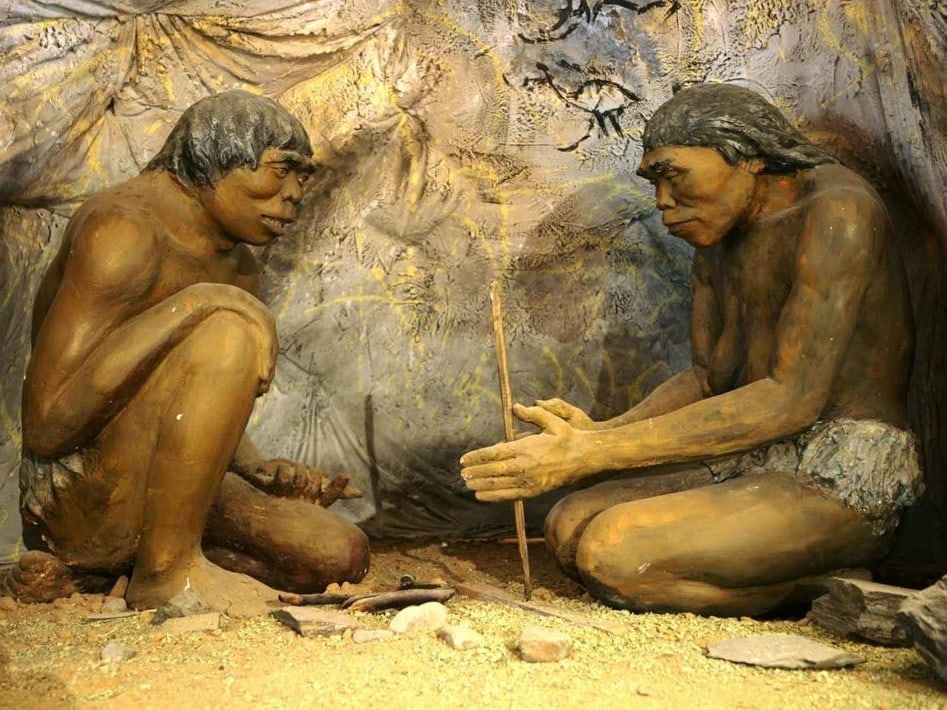 Old Stone Age
Old Stone Age
- Hunters and food gatherers; tools used were axes, choppers and cleavers.
- Earliest lower Palaeolithic site is Bori in Maharashtra.
- Limestone was also used to make tools
- Soan valley (in present Pakistan)
- Sites in the Thar Desert
- Kashmir
- Mewar plains
- Saurashtra
- Gujarat
- Central India
- Deccan Plateau
- Chotanagpur plateau
- North of the Cauvery River
- Belan valley in UP
There are habitation sites including caves and rock shelters.
It was declared a World Heritage Site in 2003
An important place is Bhimbetka in Madhya Pradesh
Middle Palaeolithic age
- Tools used were blades, pointers, scrapers and borers.
- The tools were smaller, lighter and thinner
- Important middle Palaeolithic age sites
- Belan valley in UP
- Luni valley (Rajasthan)
- Son and Narmada rivers
- Bhimbetka
Upper Palaeolithic age
- Emergence of Homo sapiens
- Lot of bone tools, including needles, harpoons, blades, fishing tools and burin tools.
Major sites of Upper Palaeolithic age
- Belan
- Son
- Chota Nagpur plateau (Bihar)
- Maharashtra
- Orissa and
- Eastern Ghats in Andhra Pradesh
- Paintings at Bhimbetka site belong to this age.
Mesolithic Period (Middle Stone Age)
- Major climate change happened
- Climate became warmer and more humid.
- Rainfall increased and so more availability of flora and fauna.
- Domestication of animals and plants were seen for the first time.
- Started 12000 years ago.
- First animal to be domesticated was the wild ancestor of the dog.
- Sheep and goats were the most common domesticated animals.
- Hunting and food gathering continued.
- First human colonization of the Ganga plains.
- Microliths have been excavated.
- They are small stone tools that were probably stuck to stones to be used as saws and sickles.
Major sites:
- Brahmagiri (Mysore)
- Narmada
- Vindhya
- Gujarat
- UP
- Sojat (Rajasthan)
- Bhimbetka
- Godavari Basin
- Sarai Nahar Rai
- Tools used were blades, crescents, triangles, trapezes, spearheads, knives, arrowheads, sickles, harpoons and daggers.
In the world context, the New Stone age or the Neolithic age began in 9000 BC which is when agriculture was developed in South west Asia.
- The Neolithic settlers were the earliest farming communities.
- They domesticated cattle, sheep and goats in the initial stage.
- Subsequently, agriculture and other activities were started with the help of both stone and bone tools.
- People lived in circular or rectangular houses made of mud and reed.
- It is held that the primitive people living in circular houses owned property in common.
- The Neolithic pottery included black-furnished ware, grey ware and mat-impressed ware.
- The Neolithic people led a settled life and produced ragi and kulathi and even rice.
- Mehrgarh is a famous Neolithic settlement in the subcontinent which is attributed to 7000 BC. It is situated in Baluchistan province, - Pakistan.
- It is one of the largest Neolithic settlements between the Indus River and the Mediterranean Sea.
- It is located on the bank of the Bolan River in the Kacchi plain which is called the bread basket of Baluchistan.
- The Neolithic people of Mehrgarh were more advanced. They produced wheat and barley and lived in mud-brick houses.
≫ Prehistoric Periods in India – According to Tools
Ancient history can be divided into different periods according to the tools used by people then.
- Paleolithic Period: 2 million BC – 10,000 BC
- Mesolithic Period: 10,000 BC – 8000 BC
- Neolithic Period: 8000 BC – 4000 BC
- Chalcolithic Period: 4000 BC – 1500 BC
- Iron Age: 1500 BC – 200 BC
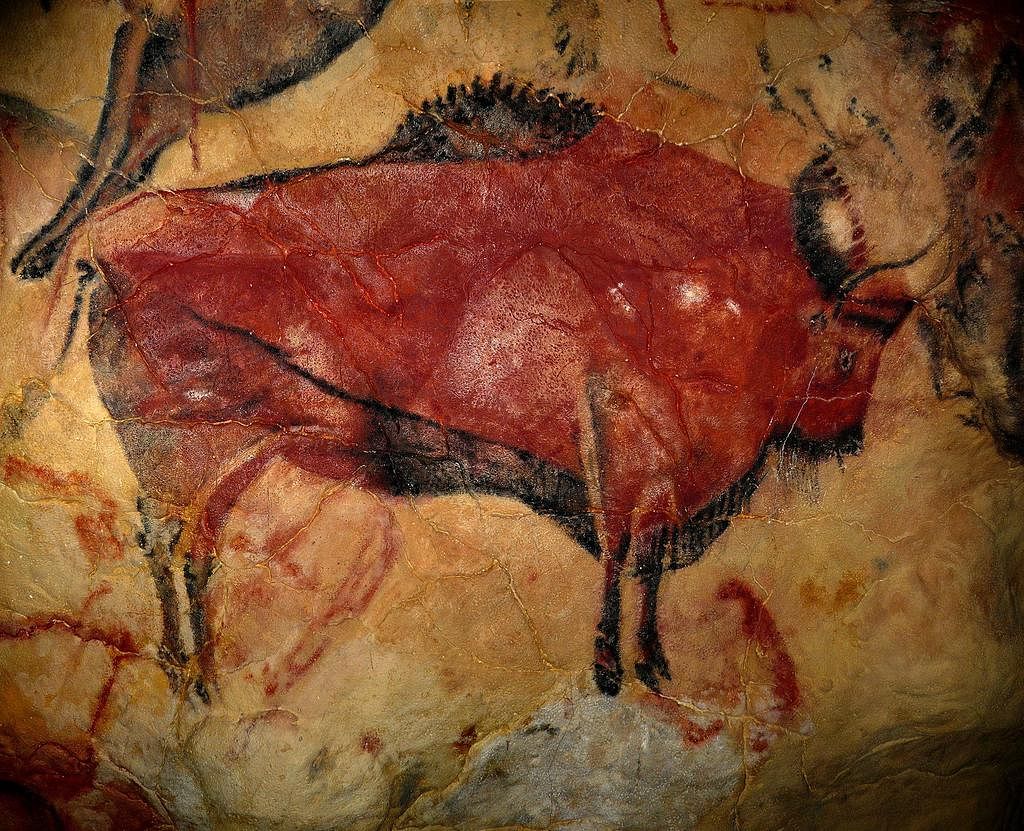 Paleolithic Art
Paleolithic Art
≫ Prehistoric Period – Palaeolithic Period (Old Stone Age)
(i) This is further divided into three:
- Lower Palaeolithic Age: up to 100,000 BC
- Middle Palaeolithic Age: 100,000 BC – 40,000 BC
- Upper Palaeolithic Age: 40,000 BC – 10,000 BC
(ii) Lower Palaeolithic age
- Hunters and food gatherers; tools used were axes, choppers and cleavers.
- One of the earliest lower Palaeolithic sites is Bori in Maharashtra.
- Limestone was also used to make tools.
- Major sites of lower Palaeolithic age
(1) Soan valley (in present Pakistan)
(2) sites in the Thar Desert
(3) Kashmir
(4) Mewar plains
(5) Saurashtra
(6) Gujarat
(7) Central India
(8) Deccan Plateau
(9) Chotanagpur plateau
(10) North of the Cauvery River
(11) Belan valley in UP - There are habitation sites including caves and rock shelters.
- An important place is Bhimbetka in Madhya Pradesh.
(iii) Middle Palaeolithic age
- Tools used were blades, pointers, scrapers and borers.
- The tools were smaller, lighter and thinner
- Important middle Palaeolithic age sites
(i) Belan valley in UP
(ii) Luni valley (Rajasthan)
(iii) Son and Narmada rivers
(iv) Bhimbetka
(iv) Upper Palaeolithic age
- Emergence of Homo sapiens
- A lot of bone tools, including needles, harpoons, blades, fishing tools and burin tools.
- Major sites of Upper Palaeolithic age
(1) Belan
(2) Son
(3) Chota Nagpur plateau (Bihar)
(4) Maharashtra
(5) Orissa and
(6) The Eastern Ghats in Andhra Pradesh - Paintings at Bhimbetka site belong to this age.

≫ Prehistoric Period – Mesolithic Period (Middle Stone Age)
- Major climate change happened.
- Climate became warmer and more humid.
- Rainfall increased and so more availability of flora and fauna.
- Domestication of animals and plants were seen for the first time.
- Started 12000 years ago.
- First animal to be domesticated was the wild ancestor of the dog.
- Sheep and goats were the most common domesticated animals.
- Hunting and food gathering continued.
- First human colonization of the Ganga plains.
- Microliths have been excavated.
- They are small stone tools that were probably stuck to stones to be used as saws and sickles.
- Major sites:
(1) Brahmagiri (Mysore)
(2) Narmada
(3) Vindhya
(4) Gujarat
(5) UP
(6) Sojat (Rajasthan)
(7) Bhimbetka
(8) Godavari Basin
(9) Sarai Nahar Rai - Tools used were blades, crescents, triangles, trapezes, spearheads, knives, arrowheads, sickles, harpoons and daggers.[/su_box]
≫ Prehistoric Period – Neolithic Period (New Stone Age)
- Starting of agriculture
- Moving from nomadic to settled life
- Wheel discovered. Ragi, wheat and horse gram were cultivated
- They knew to make fire
- Knew pottery
- Also, shows first intentional disposal of the dead
- Important sites:
(1) Inamgaon
(2) Burzahom (Kashmir)
(3) Mehrgarh (Pakistan)
(4) Daojali Hading (Tripura/Assam)
(5) Hallur (AP)
(6) Paiyampalli (AP)
(7) Chirand (Bihar)
(8) Evidence of houses
≫ Prehistoric Period – Chalcolithic Period (Copper Age/Bronze Age)
Indus Valley Civilization (2700 BC – 1900 BC)
- Other settlements at
- Brahmagiri Navada Toli (Narmada region)
- Chirand (Ganga region) and
- Mahishadal (West Bengal)
≫ Prehistoric Period – Iron Age
- Arrival of the Aryans: Vedic Period
- Jainism, Buddhism
- Mahajanapadas: the first major civilisation on the banks of the river Ganga after the Indus Valley.
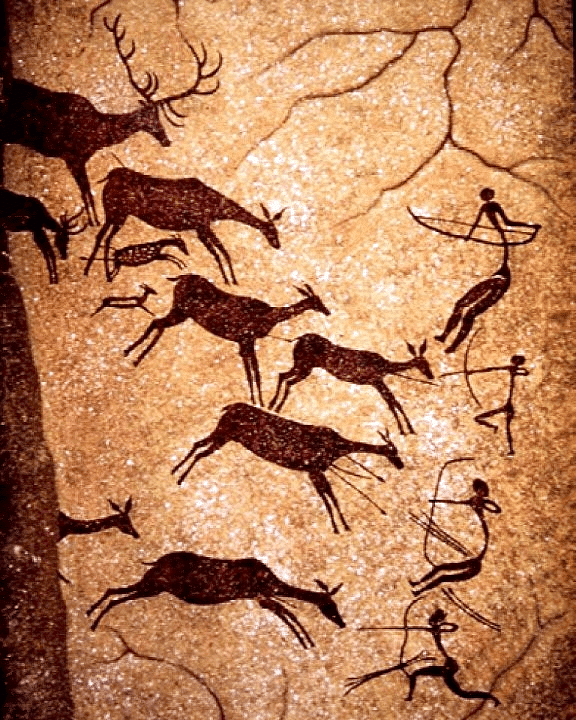
- The distant past when there was no paper or language or the written word, and hence no books or written document, is called as the Prehistoric period.
- It was difficult to understand how Prehistoric people lived until scholars began excavations in Prehistoric sites.
- Piecing together of information deduced from old tools, habitat, bones of both animals and human beings and drawings on the cave walls scholars have constructed fairly accurate knowledge about what happened and how people lived in prehistoric times.
- Paintings and drawings were the oldest art forms practiced by human beings to express themselves using the cave wall as their canvas.
The drawings and paintings can be catagorised into seven historical periods. Period I, Upper Palaeolithic; Period II, Mesolithic; and Period III, Chalcolithic. After Period III there are four successive periods. But we will confine ourselves here only to the first three phases. Prehistoric Era art denotes the art (mainly rock paintings) during Paleolithic Age, Mesolithic Age and Chalcolithic Age.
(i) Paleolithic Age Art
- The prehistoric period in the early development of human beings is commonly known as the ‘Old Stone Age’ or ‘Palaeolithic Age’.
- The Paleolithic period can be divided into three phases:
(1) Lower Palaeolithic (2,50,000 BC-1,00,000 BC)
(2) Middle Palaeolithic (1,00,000 BC – 40,000 BC)
(3) Upper Palaeolithic (40,000 BC- 10,000BC) - We did not get any evidence of paintings from the lower or middle Paleolithic age yet.
- In the Upper Palaeolithic period, we see a proliferation of artistic activities.
- Subjects of early works confined to simple human figures, human activities, geometric designs, and symbols.
- First discovery of rock paintings in the world was made in India (1867-68) by an Archaeologist, Archibold Carlleyle, twelve years before the discovery of Altamira in Spain (site of oldest rock paintings in the world).
- In India, remnants of rock paintings have been found on the walls of caves situated in several districts of Madhya Pradesh, Uttar Pradesh, Andhra Pradesh, Telangana, Karnataka, Bihar, and Uttarakhand.
- Some of the examples of sites early rock paintings are Lakhudiyar in Uttarakhand, Kupgallu in Telangana, Piklihal and Tekkalkotta in Karnataka, Bhimbetka and Jogimara in Madhya Pradesh etc.
- Paintings found here can be divided into three categories: Man, Animal, and Geometric symbols.
- Some of the characteristics of these early paintings are:
(1) Human beings are represented in a stick-like form.
(2) A long-snouted animal, a fox, a multi-legged lizard are main animal motifs in the early paintings (later many animals were drawn).
(3) Wavy lines, rectangular filled geometric designs and a group of dots also can be seen.
(4) Superimposition of paintings – earliest is Black, then red and later White. - In the late historic, early historic and Neolithic period the subjects of paintings developed and figures like Bulls, Elephants, Sambhars, Gazelles, Sheep, Horses, styled human beings, tridents and rarely vegetal motifs began to see.
- The richest paintings are reported from Vindhya range of Madhya Pradesh and their Kaimurean extension into U.P.
- These hills are fully Palaeolithic and Mesolithic remains.
- There are two major sites of excellent prehistoric paintings in India:
(1) Bhimbetka Caves, Foothills of Vindhya, Madhya Pradesh.
(2) Jogimara caves, Amarnath, Madhya Pradesh.
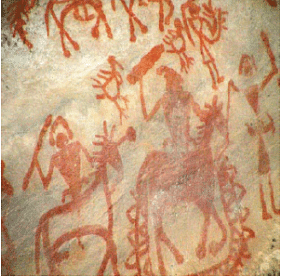
- Continuous occupation of the caves from 100,000 B.C– 1000 A.D
- Thus, it is considered as an evidence of long cultural continuity.
- It was discovered in 1957-58.
- Consists of nearly 400 painted rock shelters in five clusters.
- One of the oldest paintings in India and the world (Upper paleolithic).
- The features of paintings of three different phases are as follows (even though Bhimbetka contains many paintings of periods later, different from what is explained below, as we are dealing with the prehistoric period only, we are concluding by these three):
(i)Upper Paleolithic Age:
- Paintings are linear representations, in green and dark red, of huge animal figures, such as Bisons, Tigers, Elephants, Rhinos and Boars beside stick-like human figures.
- Mostly they are filled with geometric patterns.
- Green paintings are of dances and red ones of hunters.
(ii) Mesolithic period Art:
- The largest number of paintings belongs to this period.
- Themes multiply but the paintings are small in size.
- Hunting scenes predominate
- Hunters in groups armed with barbed spears pointed sticks, arrows, and bows.
- Trap and snares used to catch animals can be seen in some paintings.
- Mesolithic people loved to point animals.
- In some pictures, animals are chasing men and in others, they are being chased by hunter men.
- Animals painted in a naturalistic style and humans were depicted in a stylistic manner.
- Women are painted both in nude and clothed.
- Young and old equally find places in paintings.
- Community dances provide a common theme.
- Sort of family life can be seen in some paintings (woman, man, and children).
(iii) Chalcolithic period Art:
- Copper age art.
- The paintings of this period reveal the association, contact and mutual exchange of requirements of the cave dwellers of this area with settled agricultural communities of the Malwa Plateau.
- Pottery and metal tools can be seen in paintings.
- Similarities with rock paintings: Common motifs (designs/patterns like cross-hatched squares, lattices etc)
- The difference with rock paintings: Vividness and vitality of older periods disappear from these paintings.
- Used colors, including various shades of white, yellow, orange, red ochre, purple, brown, green and black.
- But white and red were their favorite.
- The paints used by these people were made by grinding various colored rocks.
- They got red from haematite (Geru in India).
- Green prepared from a green-colored rock called Chalcedony.
- White was probably from Limestone.
- Some sticky substances such as animal fat or gum or resin from trees may be used while mixing rock powder with water.
- Brushes were made of plant fiber.
- It is believed that these colors remained for thousands of years because of the chemical reaction of the oxide present on the surface of rocks.
- Paintings were found both in occupied and unoccupied caves.
- It means that these paintings were sometimes used also as some sort of signals, warnings, etc.
- Many rock art sites of the new painting are painted on top of an older painting.
- In Bhimbetka, we can see nearly 20 layers of paintings, one on top of another.
- It shows the gradual development of the human being from period to period.
- The symbolism is inspiration from nature along with slight spirituality.
- Expression of ideas through very few drawings (representation of men by the stick like drawings).
- Use of many geometrical patterns.
- Scenes were mainly hunting and economic and social life of people.
- The figure of flora, fauna, human, mythical creatures, carts, chariots etc can be seen.
- More importance for red and white colours.
- It is difficult to say that all the earliest Aryans belonged to one race, but their culture was more or less of the same type. They were distinguished by their common language.
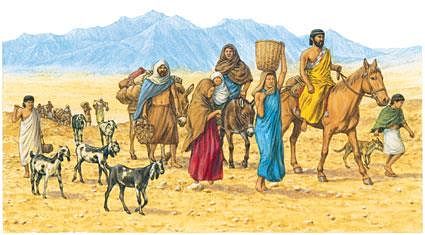 People in Rigveda Period: Aryans
People in Rigveda Period: Aryans - They spoke the Indo-European languages, which are currently in changed forms all over Europe, Iran, and the greater part of the Indian subcontinent. Originally the Aryans seem to have lived somewhere in the steppes stretching from southern Russia to Central Asia.
- Their earliest life seems to have been mainly postoral, agriculture being a secondary occupation. Although the Aryans used several animals, the horse played the most significant role in their life. Its swiftness enabled them and some allied people to make successful inroads into the West. Asia from about 2000 B.C. onwards.
- On their way to India, Aryans first appeared in Central Asia and Iran, where the Indo-Iranians lived for a long time. We know about the Aryans in India from the Rig Veda. The term Arya occurs 36 times in this text and generally indicates a cultural community.
- The Rig Veda is the earliest text of the Indo-European languages. It is a collection of prayers offered to Agni, Indra, Mitra, Varun, and other gods by various families of poets or sages. It consists of ten mandalas or books, of which Books II to VII forms its earliest portions. Books I and X seem to have been the latest additions.
- The Rig Veda has many things in common with the Avesta, which is the oldest text in the Iranian language. The two texts use the same names for several gods and even for social classes. But the earliest specimen of the Indo-European language is found in an inscription of about 2200 B.C. from Iraq. Later, such specimens occur in Hittite inscriptions in Anatolia (Turkey) from the nineteenth to the seventeenth century B.C.
- Aryan names appear in Kassite inscriptions of about 1600 B.C. from Iraq, and in Mitanni, inscriptions of the fourteenth century B.C. from the Aryans appeared in India.
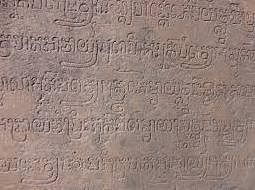 Mitanni Inscription
Mitanni Inscription
- The earliest Aryans lived in the geographical area covered by eastern Afghanistan, North-West Frontier Province, Punjab, and fringes of western Uttar Pradesh. Some rivers of Afghanistan, such as the river Kubha and the river Indus and its five branches, are mentioned in the Rig Veda. The Sindhu, identical to the Indus, is the river par excellence of the Aryans, and it is repeatedly mentioned.
- Another river, the Saraswati, is called Naditama or the best of the rivers in the Rig Veda. The whole region where the Aryans first settled in the Indian subcontinent is called the Land of the Seven Rivers.
- We hear of many defeats inflicted by Indra on the enemies of the Aryans. In the Rig Veda Indra is called Purandara, which means that he was the breaker of forts.
- The Aryans succeeded everywhere because they possessed chariots driven by horses and introduced them for the first time into West Asia and India. The Aryan soldiers were probably equipped also with coats of mail (vaiman) and better arms.
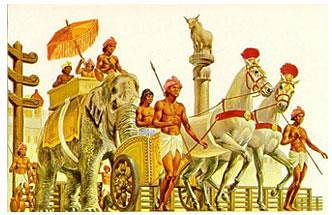 Aryans with Chariot
Aryans with Chariot
- According to tradition, the Aryans were divided into five tribes panchajana but there might have been other tribes also. The Bharatas and the Tritsu were the ruling Aryan clans, and they were supported by priest Vasisththa.
- The country Bharatavarsha was eventually named after the tribe Bharata, which appears first in the Rig Veda. The Bharata ruling clan was opposed by a host of ten chiefs, five of whom were heads of Aryan tribes and the remaining five of non-Aryan people. The battle that was fought between the Bharatas on the one hand and the host of ten chiefs on the other is known as the Battle of Ten Kings.
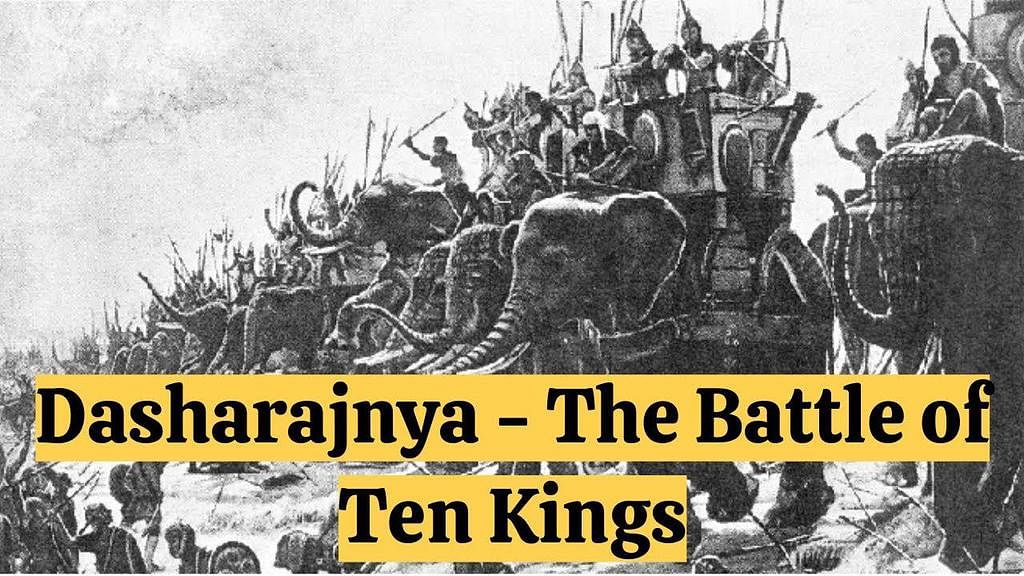
- This battle was fought on the river Parushni, identical to the river Ravi and it gave victory to Sudas and established the supremacy of the Bharatas. Of the defeated tribes, the most important was that of the Purus. Subsequently, the Bharatas joined hands with the Purus and formed a new ruling tribe called the Kurus. The Kurus combined with the Panchalas, and they together established their rule in the upper Gangetic basin, where they played an important part in later Vedic times.
- The Rig Vedic people possessed better knowledge of agriculture. Ploughshare is mentioned in the earliest part of the Rig Veda though some consider it an interpolation. Possibly this ploughshare was made of wood. They were acquainted with sowing, harvesting, and threshing and knew about the different seasons.
- In spite of all this, there are so many references to the cow and the bull in the Rig Veda that the Rig Vedic Aryans can be called predominantly pastoral people. Most of their wars were fought for the sake of cows. The term for war in the Rig Veda is gavishthi or search for cows. The cow seems to have been the most important form of wealth. The Rig Veda mentions such artisans as the carpenter, the chariot-maker, the weaver, the leather worker, the potter, etc.
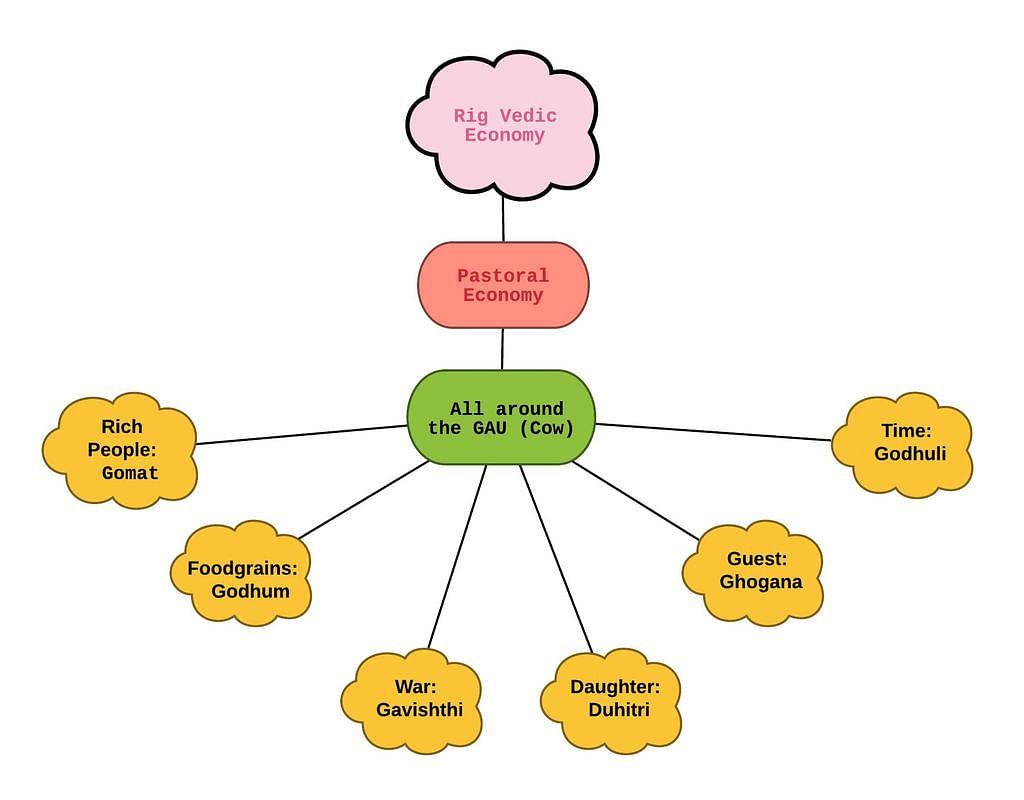 Terms used by Rigvedic Aryans
Terms used by Rigvedic Aryans
- This indicates that they practiced all these crafts. The term ayas, used for copper or bronze, show that metalworking was known. But we have no clear evidence of the existence of regular trade. The Aryans or the Vedic people were acquainted more with land routes because the word Samudra mentioned in the Rig Veda mainly denotes a collection of water. We may, therefore, have this of a pre-iron phase of the PGW, which coincided with the Rig Vedic phase.
- The administrative machinery of the Aryans in the Rig period worked with the tribal chief in the center because of his successful leadership in war. He was called Rajan.
- It seems that in the Rig Vedic period, the king’s post had become hereditary. We have traces of the election of the king by the tribal assembly called the Samiti. The king was called the protector of his tribe.
- Several tribal or clan-based assemblies, such as the sabha, samiti, vidatha, gana is mentioned in the Rig Veda. They exercised deliberative, military, and religious functions. Even women attended the sabha and vidatha in Rig Vedic times. But the two most important assemblies were the Sabha and the Samiti. These two were so important that the chiefs or the kings showed eagerness to win their support.
- In the day-to-day administration, the king was assisted by a few functionaries. The most important function seems to have been the purohita.
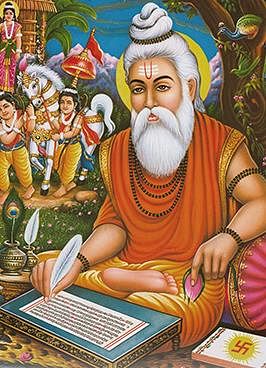 Sage Vasishtha
Sage Vasishtha
- The two priests who played a major part in the time of Rig Veda were Vashishta and Vishwamitra. Vishwamitra composed the Gayatri mantra to widen the Aryan world. The next important functionary seems to be the senani, who used spears, axes, swords, etc. We do not come across any officer concerned with the collection of taxes.
- Probably the chiefs received from the people voluntary offerings called Bali. Presents and spoils of war were perhaps distributed in some Vedic assemblies. The Rig Veda does not mention any officer for administering justice. Spies were employed to keep an eye on such unsocial activities.
- The officer who enjoyed authority over a large land or pasture ground is called Vrajapati. He led heads of the families called kulapas, or the heads of the fighting hordes called graminis to battle.
- In the beginning, the gramani was just the head of a small tribal fighting unit. But when the unit settled, the gramani became the head of the village, and in the course of time, he became identical to the Vrajapati. The king did not maintain any regular or standing army, but in times of war, he mustered a militia whose military functions were performed by different tribal groups called vrata, gana, grama, sardha. By and large, it was a tribal system of government in which the military element was strong.
- Kinship was the basis of social structure, and a man was identified by the clan to which he belonged. People gave their primary loyalty to the tribe, which was called jana. The term jana occurs at about 275 places in the Rig Veda, and the term janapada or territory is not used even once. The people were attached to the tribe since the territory or the kingdom was not yet established.
- Another important term that stands for the tribe in the Rig Veda is vis, it is mentioned 170 times in that text. Probably the vis was divided into grama or smaller tribal units meant for fighting. When the gramas clashed with one another, it caused samgrama. The most numerous varna of vaishya arose out of the vis or the mass of the tribal people.
- The term for family (kula) is mentioned rarely in the Rig Veda. It comprised not only mothers, fathers, sons, slaves, etc., but many more people. It seems that family in the early Vedic phase was indicated by the term griha, which frequently occurs in this text. In the earliest Indo-European languages, one word is used for nephew, grandson, cousin, etc. It seems that several generations of the family lived under the same roof. Because it was a patriarchal society, the birth of a son was desired again and again, and people especially prayed to the gods for brave sons to fight the wars.
- In the Rig Veda, no desire is expressed for daughters, though the desire for children and cattle is a recurrent theme in the hymns. Women could attend assemblies. They could offer sacrifices along with their husbands. We have an instance of five women who composed hymns, although the later texts mention 20 such women.
- We also notice the practice of levirate and widow remarriage in the Rig Veda. There are no examples of child marriage, and the marriageable age in Rig Veda seems to have been 16 to 17.
- The Rig Veda mentions Arya varna and Dasa varna. The tribal chiefs and the priests acquired a larger share of the booty, and they naturally grew at the cost of their kinsmen, which created social inequalities in the tribe. Gradually the tribal society was divided into three groups - warriors, priests, and the people - on the same pattern as in Iran. The fourth division, called the Shudras, appeared towards the end of the Rig Vedic period because it is mentioned for the first time in the tenth Book of the Rig Veda, which is the latest addition.
- In the age of the Rig Veda, differentiation based on occupations had started. But this division was not very sharp. We hear of a family where a member says: “I am a poet, my father is a physician, and my mother is a grinder. Earning livelihood through different means, we live together”. We hear of gifts of cattle, chariots, horses, slaves, etc.
- Unequal distribution of the spoils of war created social inequalities, which helped the rise of princes and priests at the cost of the common tribal people. But since the economy was mainly pastoral and not food-producing, the scope for collecting regular tributes from the people was very limited. We do not find gifts of land, and even those of cereals are rare. We find domestic slaves but not wage-earners.
- Tribal elements in society were stronger and social divisions based on the collection of taxes or accumulation of landed property were absent. The society was still tribal and largely egalitarian.
- The most important divinity in the Rig Veda is Indra, which is called Purandara or the breaker of forts. Indra played the role of a warlord, leading the Aryan soldiers to victory against the demons. Two hundred and fifty hymns are devoted to him. He is considered to be the rain god and thought to be responsible for causing rainfall.

- The second position is held by Agni (fire god) to whom 200 hymns are devoted. Fire played a significant part in the life of primitive people because of its use in burning forests, cooking, etc. The cult of fire occupied a central place not only in India but also in Iran, In Vedic times, Agni acted as a king of intermediary between the gods on the one hand and the people on the other.
- The third important position is occupied by Varuna, who personified water. Varuna was supposed to uphold the natural order, and whatever happened in the world was thought to be the reflection of his desires.
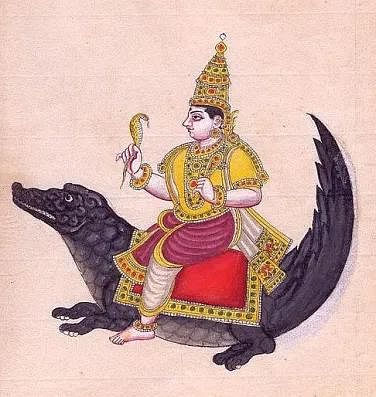 Varuna
Varuna - Soma was considered to be the god of plants and an intoxicating drink is named after him. The Maruts personify the storm. We have a large number of gods., who represent the different forces of nature in one form or another but are also assigned human activities. We also find some female divinities, such as Aditi and Ushas, who represent the appearance of the dawn. But they were not prominent in the time of the Rig Veda in the set-up of the period the male gods were far more important than the female.
- The dominant mode of worshipping the dos was through the recitation of prayers and offering of sacrifices. Prayers played an important part in Rig Vedic times. Both collective and individual prayers were made.
- Originally every tribe or clan was the votary of a special god. It seems that prayers were offered to gods in chorus by the members of a whole tribe. This also happened in the case of sacrifices. Agni and Indra were invited to partake in sacrifices made by the whole tribe (Jana). Offerings of vegetables, grain, etc., were made to gods.
- But in Rig Vedic times, the process was not accompanied by any ritual or sacrificial formulae. They asked mainly for Praja (children), Pashu (cattle), food, wealth, health, etc.
Aryans were people who were said to speak an archaic Indo-European language and who were thought to have settled in prehistoric times in ancient Iran and the northern Indian subcontinent.
- Aryan is a designation originally meaning “civilized”, “noble”, or “free” without reference to any ethnicity.
- It was first applied as a self-identifying term by a migratory group of people from Central Asia later known as Indo-Iranians (who settled on the Iranian Plateau) and, later, applied to Indo-Aryans (who travelled south to settle northern India).
- They spoke Indo Iranian, Indo European or Sanskrit. It is said that Aryans lived in East of Alps (Eurasia), Central Asia, Arctic region, Germany, and Southern Russia.
- There are multiple theories that talk about the original location of Aryans and where they come from and the time period of their migration into India.
- The migration happened over a period of time starting around 2000BCE and peaked after the decline of IVC. Later they migrated westwards, southwards and eastwards.
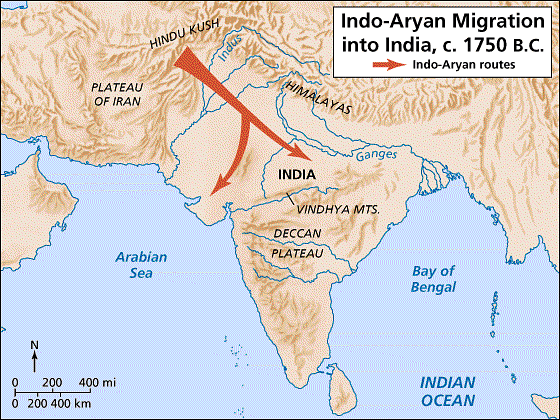 Map showing how Aryans migrated to India
Map showing how Aryans migrated to India
- Some say they came from the area around the Caspian Sea in Central Asia (Max Muller), while others think they originated from the Russian Steppes.
- Bal Gangadhar Tilak was of the opinion that the Aryans came from the Arctic region.
The Vedic Age was between 1500 BC and 600 BC. In this time period the Vedas were composed in the northern Indian subcontinent.
The Vedas, are the oldest texts of Hinduism. They are derived from the ancient Indo-Aryan culture of the Indian Subcontinent and began as an oral tradition that was passed down through generations before finally being written in vedic Sanskrit.
The Four Vedas, on which the periods were named after are:
- The Rigveda: The oldest Veda is the Rigveda. It has 1028 hymns called ‘Suktas’ and is a collection of 10 books called ‘Mandalas.’
- Samaveda: Known as the Veda of melodies and chants, Samaveda dates back to 1200-800 BCE. This Veda is related to public worship.
- Yajur Veda: Yajurveda dates back to 1100-800 BCE; corresponding with Samaveda. It compiles ritual-offering mantras/chants. These chants were offered by the priest alongside a person who used to perform a ritual.
- Atharva Veda: This Veda contains hymns many of which were charms and magic spells that are meant to be pronounced by the person who seeks some benefit, or more often by a sorcerer who would say it on his or her behalf.
- The Vedic period or Vedic age is the next major civilization that occurred in ancient India after the decline of the Indus Valley Civilization by 1400 BC.
The Vedic period can further be divided into 2 parts: - Early Vedic Period (1500-1000 BC)
- The Later Vedic Period (1000-600 BC)
Since the Rigveda is considered the oldest of all the vedas, the Early vedic period i,e. 1800–1500 BCE is also called the Rigvedic period.
- The political units during the Rig Vedic or the early Vedic period comprised of Grama (village), Vis (clan), and Jana (people).
- Aryans were organized into tribes rather than kingdoms. The chief of a tribe was called a Rajan.
- The autonomy of the Rajan was restricted by the tribal councils called Sabha and Samiti.
- The two bodies were, in part, responsible for the governance of the tribe. The Rajan could not accede to the throne without their approval.

- Monarchy was the normal form of Government.
- Kingship was hereditary. But there was a sort of hierarchy in some states, several members of the royal family exercising the power in common.
- There were references to a democratic form of government and their chiefs were elected by the assembled people.
- The kingdom was small in extent. The king enjoyed a position of pre-eminence in the tribe. Kingship was hereditary.
- He was appointed by the priest as king in the ‘Abhisheka’ Ceremony. He wore gorgeous robes and lived in a splendid palace, gaily decorated than a common building.
- The king had the duty to protect the life and property of his people.
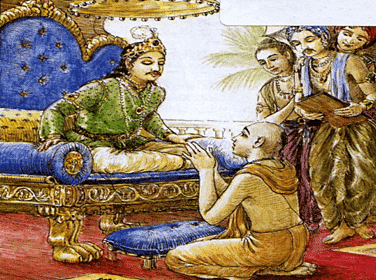
- The sacred duty of the king was the protection of the tribes and the territory and the maintenance of priests for the performance of sacrifices.
- Maintenance of law and order was his principal duty. He maintained justice with the help of Purohit's. He collected tributes known as “Bali” in kind from his subjects.
- In the work of administration, the king was assisted by a number of functionaries like the purohita (priest), the Senani (general) the Gramani (village headman).
- Purohit was the most important officer of the state.
 Purohit performing rituals
Purohit performing rituals
- The army was mainly consisting of Patti (infantry) and Rathi's (chariots). The weapons used by the soldiers were bows, arrows, swords, axes and spears.
- These weapons were made up of irons. The soldiers were organized into units known as Sardha, Vrata and gala.
 Ancient Indian warfare
Ancient Indian warfare
- The Rig Veda mentions the names of two popular assemblies known as Sabha and Samiti.
- Though the king enjoyed substantial power yet he was not an autocrat. In the work of administration, he consulted these two bodies and act according to their decision. Sabha was a select body of elders.
- The head of the sabha was known as ‘Sabhapati’.
- The concept of Varna, along with the rules of marriage, was made quite stiff. Social stratification took place, with the Brahmins and the Kshatriyas being considered higher than the Shudras and the Vaisyas.
- Cows and bulls were accorded religious significance. Aryans followed a mixed economy i.e. pastoral and agricultural in which cattle played a predominant part.
- The standard unit of exchange was Cow. The world's oldest currency coins were issued in ancient India during the Vedic period and were called Nishka and Mana. Nishka coins were small gold units of definite weight.
 Coins of Vedic Period
Coins of Vedic Period
- Apart from agriculture and animal husbandry Aryans had also other occupations. Weaving was the most important occupation.
- We learned about the weavers of wool and cotton together with the workers in the subsidiary industries of dying and embroidery.
- The carpenters built houses, chariots, wagons and supplied household utensils and furniture.
- There were trade and maritime activity. Sometimes traders made the journey to distant lands for larger profits in trade.
- There was probably commercial intercourse with Babylon and other countries in Western Asia. The principal media of trade was barter.
- The cow was used as a unit of value. Gradually pieces of gold called “nishka” were used as means of exchange.
- Trade and commerce were regulated and managed by a group of people called “Pani”.
- The family was regarded as the social and political unit. It was the nucleus of the social life of the early Aryans.
- The father was the head of the family and he was known as “grihapati”. The Aryans had joint families. The father had great authority over the children.

- In the early Vedic age women enjoyed an honoured place in society.
- The wife was the mistress of the household and authority over the slaves. In all religious ceremonies, she participated with her husband.
- The Prada system was not prevalent in society. Sati system was also not prevalent during this period
- The Rig-Veda mentions the names of some learned ladies like Viswavara, Apala and Ghosa who composed mantras and attained the rank of Rishis. The girls were married after attaining puberty.
- The practice of ‘Swayamvara’ was also prevalent in society. Monogamy was the general practice. Remarriage of widows was permitted.
- In the Rig-Vedic age great importance was given to education.
- There were Gurukuls which imparted education to the disciples after their sacred-thread ceremony.
- Entire instruction was given orally. The Vedic education aimed at proper development of mind and body.
- The disciples were taught about ethics, the art of warfare, the art of metal and the concept of Brahma and philosophy, and basic sciences like agriculture, animal husbandry, and handicrafts.
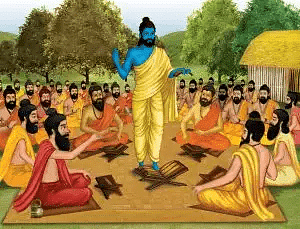 Gurukul
Gurukul
- In the early Vedic age there was no caste system. Members of the same family took to different arts, crafts, and trades.
- People could change their occupation according to their needs or talents. There was hardly any restriction in intermarriage, change of occupation.
- There was no restriction on taking food cooked by the Sudras.
- Reference in Rig-Veda shows that agriculture was the principal occupation of the people.
- They ploughed the field by means of a pair of oxen. Rig-Veda even mentions that 24 oxen were attached to a ploughshare at the same time to plough the land.
- The ploughed land was known as Urvara or Kshetra. Water was supplied into the fields by means of an irrigation canal.
- The use of manure was known to them.
 Farming
Farming - Barley and wheat were mainly cultivated. Cotton and oilseeds were also grown. Rice was perhaps not extensively cultivated. Agriculture was their main source of income.
- Besides agriculture, cattle breeding was another means of living. There are prayers in the Vedas for Gosu (cattle).
- Cows were held in great respect. Cows were symbols of the wealth and prosperity of the Aryans. Sometimes cows were the medium of exchange.
- The Aryans had also domesticated animals like horse, ox, dog, goat, sheep, buffalo and donkey.
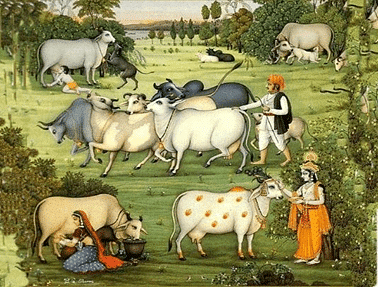 Cattle Rearing
Cattle Rearing
- The chief means of transport by land were rath (Chariots) and wagons drawn by horses and oxen.
- Riding on horseback was also in vogue.
- Rishis, composers of the hymns of the Rig Veda, were considered to be divine. The main deities were Indra, Agni (the sacrificial fire), and Soma.
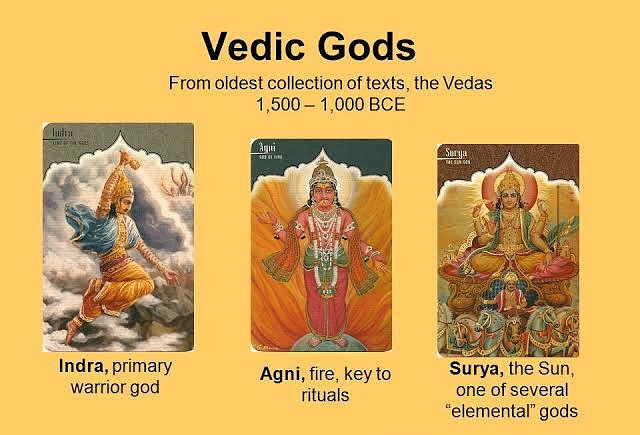 Gods mentioned in Rig Veda
Gods mentioned in Rig Veda - People also worshipped Mitra-Varuna, Surya (Sun), Vayu (wind), Usha (dawn), Prithvi (Earth) and Aditi (the mother of gods). Yoga and Vedanta became the basic elements of religion.
- In the later Vedic period, the tribal organisations changed their identity and gradually shifted to the territorial identity, and the area of settlement was now regarded as janapadas or states.
- In the transition from tribal to monarchy, they lost the essential democratic pattern of the tribe but retained the idea of government through an assembly representing the tribes.
 Mahajanapadas
Mahajanapadas
- These states consisted of either a single tribe such as Shakyas, Kolias, Malas etc.
- The people in the lower Ganges Valley and Delta, which were outside the Aryan pale, were not incorporated.
- There was, therefore, a strong consciousness of the pure land of the Aryans called Aryavarta.
- Each janapada tried to dominate and subjugate other janapadas to become Mahajanapadas.
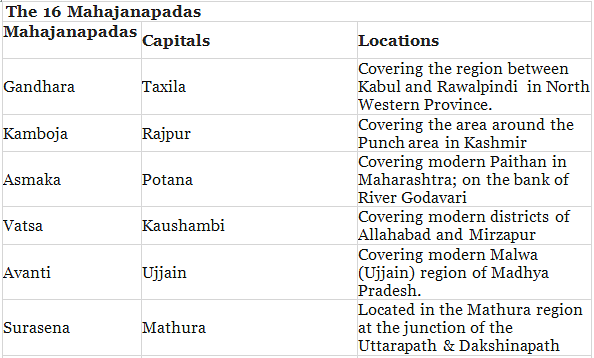
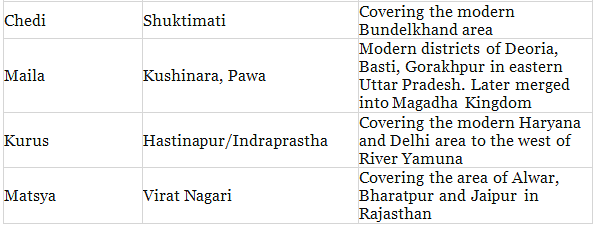

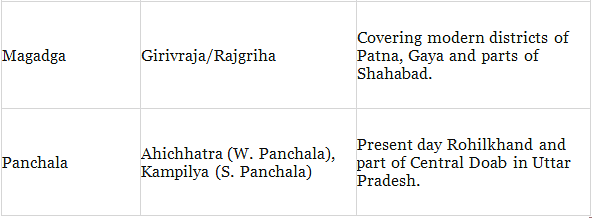
- The kings in these states had supreme authority.
- The Mahajanpadas of Vriji, Malla, Kuru, Panchal and Kamboj were republican states and so were other smaller states like Lichhavi, Shakya, Koliya, Bhagga, and Moriya.
- These republican states had a Gana-parishad or an Assembly of senior and responsible citizens.
- This Gana-Parishad had the supreme authority in the state. All the administrative decisions were taken by this Parishad.
Again, the republics were basically of two types:
- The republics comprising a single tribe like those of the Sakyas, the Kolias and the Mallas, and
- The republics comprising a number of tribes or the republics of confederacy like the Vrijjis.
- In republics, every tribal oligarch claimed share in revenues from peasants. In the monarchies, the king claimed to be the sole recipient of such revenues.
- In the tribal oligarchy or republic, each raja (tribal oligarch) was free to maintain his own little army under his Senapati. In a monarchy, the king maintained his regular standing army. He did not permit any other armed forces within his boundaries.
- Republics functioned under the leadership of the oligarchic assemblies, while a monarchy functioned under the individual leadership of the king.
- The Brahmanas had a considerable influence on the monarchial administration, while they were relegated to the background in the republics.
The period that followed Rig Vedic Age is known as Later Vedic Age. This age witnessed the composition of three later Veda Samhitas namely, the Samaveda Samhita, the Yajurveda Samhita, the Atharvaveda Samhita as well as Brahmanas and the Upanishads of all the four Vedas and later on the two great epics—the Ramayana and the Mahabharata.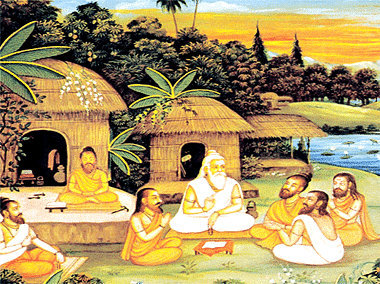 A pathshala in Vedic AgeThe spread of Aryans over the whole of India completed before 400 B.C. Of the new kingdoms in the east, the most important were Kuru, Panchala, magadha, and Koshala.
A pathshala in Vedic AgeThe spread of Aryans over the whole of India completed before 400 B.C. Of the new kingdoms in the east, the most important were Kuru, Panchala, magadha, and Koshala.
Gradually the Aryans moved towards South India. It is believed that their southern movement began during the period of Brahmana literature, about 1000 B.C. and went on steadily till they reached the southernmost extremity of the Peninsula in or sometime before fourth century B.C.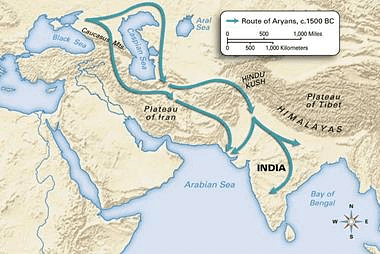 Route of Aryans before 4th century B.C
Route of Aryans before 4th century B.C
(i) Rise of Big States: With the progress of Aryan settlements in the eastern and southern part of India, the small tribal states of Rig Vedic period replaced by powerful states. Many famous tribes of Rig Vedic period like Bharatas, Purus, Trismus and Durvasa passed into oblivion and new tribes like the Kurus and Panchalas rose into prominence. The land of the Yamuna and Ganga in the east which became the new home of the Aryans rose into prominence.
(ii) Growth of Imperialism: With the emergence of big kingdoms in the Later Vedic Age the struggle for supremacy among different states was of frequent occurrence. The ideal of Sarbabhauma or universal empire loomed large in the political horizon of ancient India. The sacrifices like Rajasuya and Ashvamedha were performed to signify the imperial sway of monarchs over the rivals.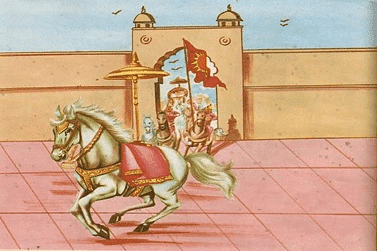 Ashvamedha RitualThese rituals impressed the people with the increasing power and prestige of the king. The Rig Vedic title of “Rajan” was replaced by the impressive titles like Samrat, Ekrat, Virat, Bhoja etc. These titles marked the growth of imperialism and feudal ideas.
Ashvamedha RitualThese rituals impressed the people with the increasing power and prestige of the king. The Rig Vedic title of “Rajan” was replaced by the impressive titles like Samrat, Ekrat, Virat, Bhoja etc. These titles marked the growth of imperialism and feudal ideas.
Origin of Kingship: There were two theories regarding the origin of kingship. The Aitareya Brahmana explained the rational theory of election by common consent of origin of kingship. Side by side the taittiriya Brahman explained the divine origin of kingship. It explained how Indra, “though occupying a low rank among the gods, was created their king by Prajapati.”
Growth of Royal Power: The king had absolute power. He became the master of all subjects. He realized taxes like “bali”, “sulka” and “bhaga”. The Satapatha Brahmana described the king to be infallible and immune from all punishment. The sabha of the Rig Vedic Period died. The king sought the aid and support of the Samiti on matters like war, peace and fiscal policies. There are references to the Samiti sometimes electing or re-electing a king.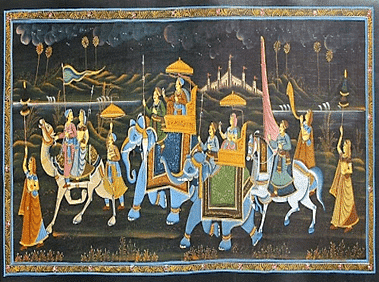
(i) Caste Society: Most important change was the evolution of caste system. Various sub castes evolved in addition to the traditional four-castes.
The Brahmana and Kshatriyas emerged as the two leading castes out of the general mass of population, known as Vaishyas. The Vaishyas were superior to the sudra but their position was steadily deteriorating.
The Aitareya Brahmana clearly indicates the absolute dependence of Vaishyas on the two higher classes. The Sudras were held in great contempt.
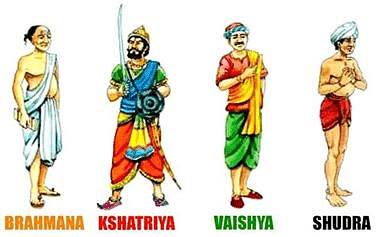
(ii) Education: A vast mass of vedic literature as well as a highly developed intellectual life speaks abundantly about a well-planned system of education in the later Vedic Period. The students had to learn Vedas, Upanishad, grammar, law, arithmetic and language.
(iii) Position of women: The women lost their high position which they had in the Rig Vedic Age. They were deprived of their right to the Upanayana ceremony and all their sacraments, excluding marriage, were performed without recitation of Vedic mantras. Polygamy prevailed in the society. Many of the religious ceremonies, formerly practiced by the wife, were now performed by the priests.
She was not allowed to attend the political assemblies. Birth of a daughter became undesirable—for she was regarded as a source of misery. The custom of child marriage and dowry crept in. The women lost their honored position in the society.
Like political and social conditions, the economic condition of the Aryans of the later Vedic period also underwent significant changes. Due to the emergence of caste system various occupations also appeared.
(i) Agriculture: The Aryans of the later Vedic period lived in the villages. In the villages small peasant owners of land were replaced by big landlords who secured possession of entire villages. Agriculture was the principal occupation of the people. Improved method of tilling the land by deep ploughing, manuring and sowing with better seeds were known to the Aryans. More lands were brought under cultivation.
(ii) Trade and Commerce: With the growth of civilization, the volume of trade and commerce had increased by leaps and bounds. Both inland and overseas trades were developed. Inland trade was carried on with the Kiratas inhabiting the mountains. They exchanged the herbs for clothes, mattresses and skins. The people became familiar with the navigation of the seas. Regular coinage was not started.
(iii) Occupation: The emergence of caste system brought varieties of means of livelihood. There are references about money lenders, chariot makers, dyers, weavers, barbers, goldsmiths, iron smiths, washer men, bow makers, carpenters, musicians etc. The art of writing probably developed in this period. The use of silver was increased and ornaments were made out of it.
During the later Vedic period the religious spirit underwent a great change. Religion was overshadowed with rites and rituals. New gods and goddesses emerged during this period.
(i) New Gods: The Rig Vedic gods, Varun, Indra, Agni, Surya, Usha etc. lost their charm. The people worshipped them with less zeal. New gods like Siva, Rupa, Vishnu, Brahma etc. appeared in the religious firmament of the Later Vedic Period. The grandeur of the Rigvedic gods passed into oblivion, though we find in Atharvaveda the omniscience of Varuna or the beneficence of the Earth goddess.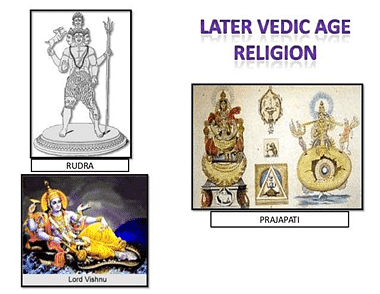 (ii) Rituals and Sacrifices: During this period the rites and ceremonies of Vedic religion were elaborated and become complex. In the Rig Vedic age Yajnas were a simple affair which every householder could do. But in the later Vedic age sacrifice became an important thing in worship. Now the priestly class devoted their energy to find out the hidden and mystic meaning of the rites and ceremonies.
(ii) Rituals and Sacrifices: During this period the rites and ceremonies of Vedic religion were elaborated and become complex. In the Rig Vedic age Yajnas were a simple affair which every householder could do. But in the later Vedic age sacrifice became an important thing in worship. Now the priestly class devoted their energy to find out the hidden and mystic meaning of the rites and ceremonies.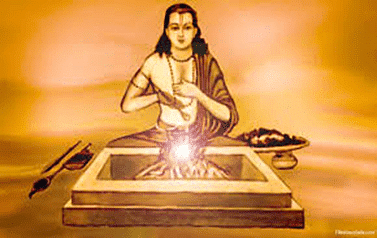 Later Vedic period is marked by lineages of clans, and small kingdoms developed in many parts of the Ganga valley, leading to the development of the state after 600 BCE. The idea of janapada and rashtra as territorial units had developed. The raja wielded much power and the social divisions began to strike deep roots. The varna system had developed well and Sudra identity became more marked during this period.
Later Vedic period is marked by lineages of clans, and small kingdoms developed in many parts of the Ganga valley, leading to the development of the state after 600 BCE. The idea of janapada and rashtra as territorial units had developed. The raja wielded much power and the social divisions began to strike deep roots. The varna system had developed well and Sudra identity became more marked during this period.
Political and social Condition during Vedic Period:
Political Condition
Rig Vedic Period
- The earliest Aryan kingdoms were founded by four kings, Iksaku, Pramsu, Sudyunma and Saryata, all stated to be the sons of Manu Vaivasvata.
- The word rajan or raja in the Rigveda denoted a tribal chief and not a monarchical king.
- Kingship was generally hereditary but elected monarchies were not unknown.
- The chiefs received from the people voluntary offerings called bali.
- The king did not maintain any regular or standing army. But during the period of war different tribal groups called vrata, gana, grama, sardha formed a militia.
- In the Atharvaveda both the Sabha and Samiti are noted as two daughters of Prajapati.
- Sabha is mentioned in the Rig Veda and Atharva Veda as a hall of gambling.
- The term ‘Vidatha’ is found in the Rig Veda and also in the Athavaveda but its meaning is not clear.
- The term 'Parisad' literally means ‘sitting round’ is available in the earlier Vedic literature.
- The ‘jana’ was the highest political or social unit among the Vedic Aryans. ‘Jana’ was used in the Rigveda and in later literature in a collected sense i.e., to denote a people or a tribe.
Later Vedic Period
 Later Vedic Period
Later Vedic Period
- There was a greater demand for military leadership.
- Laid the foundation for the state powers and kingship.
- On the evidence of Nirukta, it is known that these were elected kings even in the later Vedic age.
- It is stated in the Gautama Dharmasastra that the king was the Lord of all, but not of Brahmanas.
- The Bharatas of the Rigveda now had lost its political strength and their place was taken by the Kurus and Panchalas
- Divine theory of kingship was widely accepted by the subjects.
- The king performed sacrifices like the vajapeya, the rajasuya, and the ashwamedha, to symbolise the degree of success achieved in realising their ambitions.
- Raja was used for an ordinary ruler, and adhiraja, samrat, virat, ekarat and sarvabhauma denoted various gradations of suzerains.
- Considerable decrease in the importance and function of the popular assemblies. i.e., sabha, samiti, etc.,
- The Samiti, which gradually began to disappear from the time of the Samhitas, completely faded out in the later Vedic age.
- Parisad evolved itself into a selected body of scholars dominated by priests.
Few More Information
- Aitareya Brahmana, one of the later Vedic texts, tells us how the gods and demons decided to have a raja (king) to lead them against their enemies. The gods appointed Soma (Indra) as their king. Thus the kingship came into existence in India as a military necessity.In the Atharva Veda the king Parikshit was described as a god among men.
- The Satapatha Brahmana describes the king as the invisible symbol of god Prajapati himself.
- In the Tandya Brahmana a sacrifice is mentioned whereby the officiating Brahmana would help the subjects to destroy the king.
The term ‘Vidatha’ is found in the Rig Veda and also in the Atharvaveda.
- On the evidence of Nirukta, it is known that there were elected kings even in the later Vedic period.
- It is stated in the Gautama Dharmasutra that the king was the lord of all, but not of the Brahmanas.
- Suta and Gramani were also known as Raja Kartri or kingmaker.
- According to the Prasna Upanishad, one of the lowest rung of the ladder stood the village officials (adhikari) appointed by the king.
- ‘Gana’ the technical word for the republic, is found at forty-six places in the Rig Veda.
- There is at least one reference in the Rig Veda in which the leader of the gana is given the title of ‘Rajan’.
- The term Ibhas and Ibbyas apply to the class of king’s retainers.
- The terms upastis and stis apply to the group of king’s clients or dependents.
Social Condition
Rig Vedic Period
- There is nowhere in the Rig-veda any indication of the castes.
- The foundation of the Hindu social system based on the classes has to be traced from the Purusasukta of the Rigveda which divides society into four major classes. i.e. brahmana, rajanya, vaisya and sudra.
"I am a poet, my father is a doctor, and my mother is a grinder of corn" —RigVeda. - Food & Dress
- Besides wheat and barley, milk was the chief article of food.
- Meat of sheep and goats were rarely eaten by the people.
- The cow was deemed ‘aghnya’ (not to be slaughtered) because of her usefulness.
- Soma and Sura were the two intoxicating drinks.
- They generally used garments consisted of three parts, namely nivi or undergarment, vasa or a garment, and an adhivasa or an overgerment.
Eighteen Puranas
- Vishnu, Bhagavata, Naradiya, Garuda, Padma, and Varaha (all are Sauvika Puranas)
- Brahmanda, Brahmavaivanta, Markandya, Bhavishya and Vamana (all are Rajas Puranas)
- Siva, Linga, Skanda, Agni, Matsya and Kurma (all are Tamasa Puranas)
Position of Women
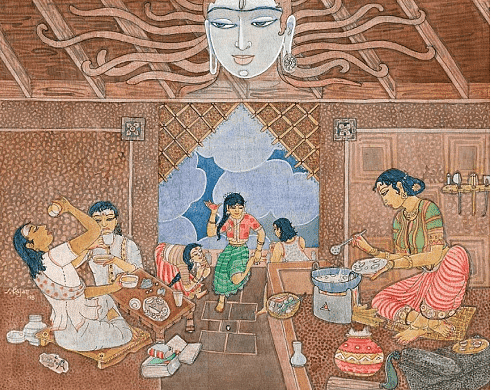 The journey of Indian Women
The journey of Indian Women
- In the Vedic period, women enjoyed a very respectable position in the society.
- The women took part in Vedic discussions, and mixed with men in popular festives.
- Non-Aryan women appear to have joined the army in large numbers.
- From the use of the words ‘Parividana’ and ‘Parivitta’ we may surmise that the brothers and sisters were married according to seniority.
- Widows were allowed to remarry, probably in such cases where the dead had left no son.
- The customs of child marriage, sati and slavery were unknown.
Later Vedic Period - The later Vedic Society was divided into four varnas called the brahmanas, rajanya or kshatriyas, vaishyas and shudras
- All the three higher varnas were entitled to upanayana.
- The Nishadas were non-Aryan lived in their villages.
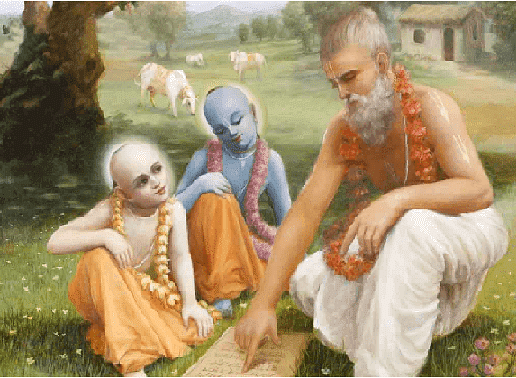 Rig vedic society
Rig vedic society
- The Vratyas were the members of the Aryan race but led nomadic life.
- Varna ashrama dharma was not well established in Vedic times. In the post Vedic texts we hear of four stages of life.
- The institution of gotra appeared in the later Vedic times.
- Gotra, Vis, and Jana may be corresponding to the viz., Zantu and Dagun of the Iranian world.
- In the Taittriya Aranyaka and the Aitareya Upanishads, ladies are directed to leave the hall of learning where some principles of gynaecology were explained, which are indelicate for the female ear.
- Women were excluded from inheriting the property.
- The Vedic chaturvarna (four castes) concept of social order came from the basic human tendencies and practices which were categorised under four major divisions for constitution of effective social bodies and proper distribution of social work among them.
- The said four categories are based on the following tendency.
- (a) Brahmanic tendency: thinking and practices of knowledge and understanding;
(b) Kshatriya tendency: aggression, establishment of power structure and order;
(c) Vaishya tendency: trade, production, technological pursuits and wealth; and
(d) Shudra tendency: service orientation, willingness to continue and fulfil the necessary functions. - Purusasukta states that Brahmanas, Kshatriyas, Vaishyas and Shudras originated respectively from the mouth, arms, thighs and feet of the creator.
- In the Aitareya Brahmana the Vaisya is described as a cultivator or merchant who lived on his source of profit in trade.
- In the Aitareya Brahmana it has been said that the Shudra was not so much fortunate. He was servant of another, who could be expelled or punished at will.
- Varnashrama: The life of an individual Aryan was divided into four stages:
(a) Brahmacharya (b) Grirhasta
(c) Vanaprastha (d) Sanyasa
 Coins used for tradingThe series of these four stages of an ideal span of life cover the study, the family life, the asceticism and the renunciation in a single life-time. The entire life passed through karma to take a perfect shape.
Coins used for tradingThe series of these four stages of an ideal span of life cover the study, the family life, the asceticism and the renunciation in a single life-time. The entire life passed through karma to take a perfect shape.
- The Family
- The ancient Hindu family included parents, children, grandchildren, uncles and their decendents, the adopted children, a number of servants and clients.
- The Child
- The jatakarma took place immediately after the birth by cutting the umbilical cord, by whispering sacred mantras and by placing a mixture of honey and ghee into his mouth.
- When the child became six months, the annaprasana ceremony (first feeding of solid food) was held.
- At the age of three, the kshura karma (tonsure) took place in case of the male child where the scalp of the child head being shaved.
- At the age of five, the child is taught the alphabets by a Brahmana priest or teacher.
- With his upanayana (sacred thread ceremony) at the age of nine, the boy attained the status of dvija or Brahmacharin. The Yajnopavita or Yajna Sutra (sacred thread) consisted of nine twisted strands made of cotton.
- The ceremony included the whispering of the sacred gayatri mantra into the ears of the dwija. The gayatri mantra runs thus:
“Let us meditate on the beautiful splendour of the god savitri (sun) that he may purify our souls.”
Education
The education of the boy or girl started with upanayana or the ceremonial initiation in Vedic studies. It was similar to the Indo-Iranian ceremony of navjot.
The first lessons of the Brahmana student was the performance of trisandhya (devotion for three times a day).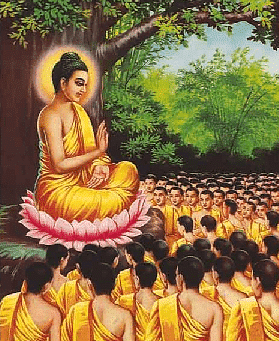 Ceremony was performed after the completion of 12 years of educationThe main subject of study was actually the Vedas. The other fields of study:
Ceremony was performed after the completion of 12 years of educationThe main subject of study was actually the Vedas. The other fields of study:
(a) Vedangas (commentaries on the Vedas)
(b) Kalpa (injunction)
(c) Shiksha (education)
(d) Chhandas (metrical composition)
(e) Nirukta (etymology)
(f) Jyotisa (astrology)
(g) Vyakarana (grammar)
(h) Jyotirvidya (astronomy)
(i) Aastrovidya (archery)
(j) Ganitshasra (mathematics)
(k) Sahitya (literature)
Costumes and Jewellery
- The lower paridhana or vasana was usually a piece of cloth fastened round the waist with a string. It is known as mekhala.
- The upper garment was called uttariya or chadar, a thin cotton shawl dropped over the shoulders. Later on dhoti and sari became popular.
- Vadhuya was a special garment worn by the bride at the marriage ceremony.
- Kuriya was a kind of head-ornament worn by females, specially brides.
- Nyochani was another type of bride’s ornament.
- Khadi was a kind of ring, worn as an armlet or an anklet.
- Mani was a kind of jewel worn round the neck.
- Rukma was an ornament worn on the breast.
Literature: The Vedic
Literature
- Veda means knowledge, comes from the root vid (to know). They are given the titles of Apaurusheja (not made by man) and Nitya (eternal).
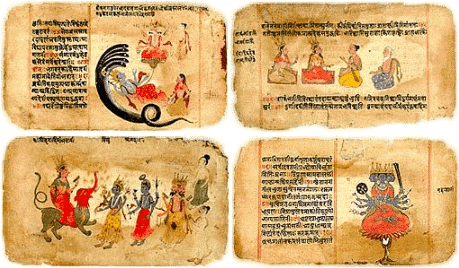 Literature - Vedic Period
Literature - Vedic Period - The Veda consists of four different classes of literary composition, namely Mantras, Brahmanas, Aranyakas and Upnishads.
- Mantras: (saying, song, formula) consists of the oldest division of Vedic literature and is distributed in four samhitas (or collection); Rig Veda Samhita, Sam Veda Samhita Yajur Veda, Samhita and Athrva Veda Samhita. The first three are known as Trayi (three fold knowledge).
- Samhita of Rig Veda is a collection of lyrics in praise of different gods. These were recited by the priest styled Hotri. It contains 1028 hymns, divided into 10 mandalas and some times into 8 astakas. But the former division is more popular. II-VII mandalas are the earliest and are also called family books. They are attributed to Gritsamada, Visvamitra, Vasudev, Attri, Bhardwaj and Vashistha. Mandala VIII is attributed to Kanva and Angiras. Mandala IX is attributed to Soma.
- It gives us an insight into the political, social, economic and religious life of the people of Rig Vedic India.
- Samhita of Sam Veda - (books of chants) - All of its verses except 75 being taken directly from Rig-veda. These verses are given tune for the purpose of singing. Its songs were meant to be sung at some sacrifice by a special class of priests called Udgatri. It shows that Aryans loved music and were not marely puritans.
- Samhita of Yajur Veda (book of sacrificial prayers) - It deals with the procedure for the performance of sacrifices. It contains rituals as well as hymns. Recited by Advaryu.
- It can be divided into two parts:
- (a) Shyama Yajur Veda (Black Yajur Veda) - It is older and contains commentary in prose in addition to the text.
- (b) Sukla Yajur Veda (White Yajur Veda). It contains instructions only.
- Samhita of Athrva Veda (book of magical formula) also known as non-Aryan work some of its hymns are as old as the earliest hymns of Rig-veda. From the historical and scientific point of view resembles the Rig Veda, however its spirit is different. It is divided into 20 books.
Upanishads
It is a collection of songs, spells and incantations for the cure of disease, the restoration of harmony and the exorcism of evil spirit etc.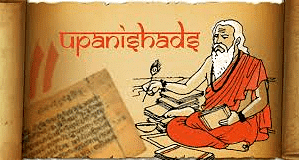
- The Aitareya and Kaushitaki Upanishads belong to Rig Veda.
- Chandogya and Kena Upanishad belong to Sama Veda
- Taittiriya, Katha and Svetasvata belong to the Krishna Yajur Veda.
- Brihadaanyaka and Isa belong to the skla Yajur Veda
- Prasna, Mundaka and Mundukya belong to the Atharva Veda.
(2) Brahmanas—They marked the transition from the Vedic to later Brahmanical social order.
- They explain meaning of sacrifices and also the methods of performing them.
- They are commentries on various hymns of the Vedas to which they are appended.
- Each Brahmana is connected with one of the Samhitas.
- The three Brahmanas contain a lot of information about the non-Aryans and also tell us the methods by which the non-Aryans were to be admitted into the Aryan fold.
- To Rig Veda - Aitareya Brahmana and Kaushtaki Brahmana.
- To Sama Veda - Tandya-maha Brahmana, Sadvinsa Brahmana, Jaiminiya Brahmana.
- To Yajur Veda - Satapatha Brahmana; most exhaustive and most impotant of all the Brahmanas; points out the progress of culture from Panchala to Videha.
- To Atharva Veda - Gopatha Brahmana
- The difference between the Brahmanas connected with the various Vedas lies in the fact that the Brahmanas of the respective Vedas deals with the work of different priests.
- As regards their fundamentals all the Brahmanas agree with one another to a very great extent.
- Aranyakas (forest book) -These are the books of instructions to be given in the forest meant for wood dwelling hermits.
- They are found as appendices to the Brahmanas.
- It marks the transition from ritualistic to philosophical thought.
- Upanishads (secret or esoteric doctrine) - Its name is derived from UPANISAD i.e “to sit near some one”. - There are 108 Upnishads altogether. - They contain deep speculations of a philosophical character which revolve around the two concepts of Brahma and Atma.
Comparison between Dravidian and Aryan Culture
- The Dravidians did not initiate and practise a social theory like Aryan theory of varnashrama—Brahmanas, Kshtriyas, Vaishyas and Shudras.
- The caste-system, the very framework of the Aryan society, was conspicuous by its absence in the Dravidian society.
- The Dravidian laws of matrimonial alliances differed fundamentally from those of the Aryans. The Dravidians could marry within the fold of their blood relations, while the Aryans were denied this privilege.
- The social system of Dravidians, being matriarchal, was quite in contradiction to the patriarchal system of the Aryans.
- Their mode of life, customs, manners, religion and languages differed from those of the Aryans.
Differences between the Indus Valley Civilization and the Vedic Culture
- Harappan civilization was superior to that of the Vedic culture.
- Indus Valley Civilization was an urban civilization whereas the Aryan culture was pastoral.
- The Indus valley people made use of only copper and bronze and iron was not known to them.
- There was brisk trade (inland and foreign) during the Harappan period.
- Humped-bull was probably a sacred animal to the Indus valley people whereas cow occupied a sacred place among the Aryans.
- The Indus valley people worshipped mother gooddesses.
- The Indus valley society was theocratic in nature. But the Aryan society was secular.
- The Indus valley people, although they are not artistic, made considerable progress in the field of art. Whereas the Aryans though possessed an artistic temperament failed to leave any signs of such craftsmanship.
- The Harappan people buried their dead bodies while the Aryans burnt them.
- The Indus people practised the cult of Sakti and Pasupati and worship of animal, tree, stone, phallus and yoni.
- Aryan religion is mainly concerned with sky.
- The Indus people traded with foreign countries but did not adopt their positive things. They believed in isolation The plasticity of the Aryan mind is shown in the quick adoptation of agriculture and settled life as well as the use of language which in the Rig Veda rises to musical levels. This capacity of change and adapt has given continuity to Indian civilization.
Important Rituals
Rajasuya: The king’s influence was strengthened by rituals. He performed this sacrifice, which was supposed to confer supreme power on him.
Asvamedha: A king performed the Asvamedha, which meant unquestioned control over an area in which the royal horse ran uninterrupted.
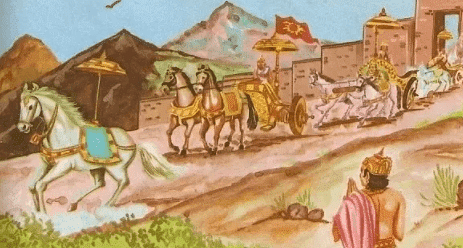
Asvamedha ritual
Vajapeya: A king performed the Vajapeya or the chariot race, in which the royal chariot was made to win the race against his kinsmen.
Chief Priests
The four chief priests who were engaged in performing the Shrauta sacrifiices were called Hotri, the invoker, Adhvaryu, the executor of the sacrifice, Udgatri, the singer, and Brahman, the high priest.
- Hotri: They recited Rig Samhita.
- Udgatri: They chanted the songs of Sama Samhita at the Soma sacrifice.
- Adhvaryu: Formulae of Yajur Samhita were to be uttered by the Adhvaryu priests who performed the manual work involved in a sacrifice.
Types of Marriage
(i) Brahma: Marriage of a duly dowered girl to a man of the same class.
(ii) Daiva: In this type of marriage, the father gives a daughter to a sacrificial priest as part of his fee.
(iii) Arsa: In this type of marriage, a token bride-price of a cow and a bull is given in place of the dowry.
(iv) Prajapatya: The father gives the girl without dowry and without demanding the bride-price.
(v) Gandharva: Marriage by the consent of the two parties, which might be solemnized merely by plighting troth.
(vi) Asrua: Asura marriage, in which the bride was bought from her father, was looked upon with disfavour by all the sacred texts, though the Arishashastra allows it without criticism.
(vii) Rakshasa: Rakshasamarriage, or marriage by capture, was practised especially by warriors.
(viii) Paishacha: It was the seduction of girl while asleep, mentally deranged or drunk Of these eight forms the first four were generally approved and were permissible to brahmans. The other forms were looked on with varying degrees of disfavours by the pious. Gandharva marriage, which often might amount to no more than a liaison, was surprisingly respected. A special form of the gandharva marriage was the Swaymvar or “self-choice”.
Philosophical Systems
A large number of school of thought was prevalent in ancient times, but we know nine of them as the most important and influential. 
They are the Charvaka, Jaina, Buddha, Vaisheshika, Nyaya, Sankhya, Yoga, Mimansa and Vedanta. They fall into two groups, Astika and Nastika, the former believing in the authority of the Vedas and the latter discarding it. The first three systems are Nastika and all others are Astika. Jaina and Buddha schools of philosophy will be dealt with separately.
Charvaka System: The Charvaka system, also called Lokayata Darshna (the philosophy of the masses) propounds gross materialism.
Among the orthodox systems of philosophy (Astika) there is some similarity and affinity between Nyaya and Vaisheshika, between Sankhya and Yoga, and between Mimansa and Vedanta. In the first two systems there is an affinity of philosophical doctrines, in the last two affinity is limited to the foundations and procedures, both systems having Vedic texts (one earliers and the other later) as their source, and the method of interpretation of the texts as the process of thinking. The Mimansakas recognize the Vedas as the final authority in determining the duties of man, and the Vedantists in gaining true knowledge about man and the universe. One is concerned with Karma-Kanda and the other with the Jnana-kanda of the Vedas, that is, the Samhitas and the Brahmanas, and the Upanishads respectively. This “Six systems of Hindu Philosophy” is also know as Shad-darshana.
(i) Vaisheshika (Particular Characteristics) : Propounded by Uluka Kanada. It is a realistic, analytic, and objective philosophy of the world.
(ii) Nyaya (Analysis): Propounded by Akshapad Gautama. It accepts all the categories recognized by the Vaisheshika system and adds one Abhava (negation).
(iii) Sankhya (Enumeration): Its legendary founder was Kapila. It is perhaps the oldest of the six systems, being mentioned in the Bhagavad Gita and occurring in a primitive form in the Upanishada. It is dualistic in its ontology. It believes in two ultimate realities Prakriti and Purusha.
(iv) Yoga (Application): Propounded by Patanjali. It is more or less applied Sankhya. It was based on the control of the body physically and implied that a perfect control over the body and the senses led to knowledge of the ultimate reality.
(v) Mimmnsa or Purva Mimamsa (Inquiry): Propounded by Jaimini. It is a philosophy of interpretation, application and use of texts of the Samhita and Brahamana portions of the Vedas.
(vi) Vedanta (End of the Vedas): It is also called Uttara Mimansa. The basic text of the system is the Brahma Sutras of Badarayana. Vedanta was decisive in refuting the theories of non-brahmanical schools.
Religion and economic conditions in V
RELIGION
Rig Vedic Period
- Naturalism and Anthropomorphism—personification.
- Polytheism and Henotheism or Kathenotheism—many gods were worshipped and headed towards Monotheism.

- No idolatrous
- The monotheistic conception appears more prominently in the hymns addressed to Hiranyagarbha (the germ of gold) and to Vishvakarman (the all creating).
- The idea of metempsychosis (transmigration of soul) is not developed during the Rigvedic period.
Later Vedic Period
- Indra and Agni lost their importance.
- Prajapati (the creator) became the supreme.
- The religion in the later Vedic period is distinguishable from the earlier Rig Vedic civilization in the sense that new Gods and Goddesses came to be worshipped.
- The great gods of the Rig Vedic period like Indra, Varuna, Surya etc., receded in the background and many gods like Vishnu, Rudra etc. come into prominence.
- ‘Pushan’ was regarded as the God of Sudras.
- The people also worshipped the snake.
- They had faith in witch-craft, charms, spells and spirits.
- People had faith in doctrine of self, karma, maya, mukti and transmigration of soul.
- Asceticism challenged the supremacy of vedic sacrifices.
ECONOMIC CONDITION
Rig Vedic Period
- Pastoral economy
- Plough agriculture made the food supply more regular.
- They had certain technological knowledge about seasons connected with agriculture.
- The chief industries referred to in the Rig Veda are those of the carpenters, the chariot makers, the weavers, the leather-workers, the potter, etc.
Know the Important Facts
- On their way to India the Aryans first appeared in Iran.
- The term for war in the Rig Veda is Gavisthi.
- Family in the Rig Vedic Age was indicated by the term Griha.
- Social divisions based on occupations are first mentioned in Rig Veda.
- During the Rig Vedic period Agni acted as a kind of intermediary between the gods and the people.
- Atharva Veda’s contents speak of the beliefs and practices of the non-Aryans.
- Hastinapur, Noh and Atranjikhera are PGW sites.
- Pushan was the later Vedic god of the Shudras.
- Besides Indra, Agni also lost its importance in the later vedic times.
- Upanishad laid stress on the value of right belief and knowledge.
- About 200 hymns in the Rigveda are addressed to the fire god.
- In the Atharaveda, Sabha and Samiti are described as uterine sisters, the two daughters of Prajapati.
- In the Rig Vedic period “Purandara” was another name for Indra.
- Sanyasa Ashrama did not develop fully during the Later Vedic Period.
- Sudra is mentioned for the first time in the Tenth Mandala of the Rig Veda.
- In the Rig Veda, there is no reference to the ceremony of Upanayan or Initiation which is regarded as of such great importance in later ages.
- The Ashvins, were the great healers of diseases and expert in surgical art.
- The archaeological evidence suggests that the Vedic Aryans introduced the Painted Grey Ware (PGW) in north India.
- Five seasons are mentioned in the Rig Veda.
- Two pieces of cloth were normally worn—the upper garment was called uttariya and the lower one known as antariya.
- According to the Rig Veda Apaya river flowed between the Drasdvati and the Sarasvati. It is a small tributary flowing past Thaneswar in Haryana.
- Altogether ninety-nine rivers are referred to in the Rig veda.
- The Sama Veda is a collection of 1603 verses but except 99 all the rest of the hymns have been borrowed from the Rig Veda.
- The Athara Veda is divided into 20 Kandas and has 711 hymns.
- The Griha Sutra prescribes a code of conduct which gives a fairly good idea of the manners and etiquette of that age.
- There were a few non-monarchical states as well which are described as gana in the Rig Veda whose head was ganapati or Jyestha.
- The concept of Rita was perhaps the highest flight of the Rig Vedic thought. Varuna was considered to be the guardian or upholder of Rita.
- The Rig Veda mentions lions not the tigers.
- The ayas used for copper or bronze shows that metal working was known.
- The exchange of articles on the system of barter was in vogue and generally the cow was regarded as the standard of value.
- According to some scholars a sort of coinage known as ‘Nishka’ was also prevalent in those days.
Later Vedic Period
- Iron was used by these people for making implements.
- In addition to irrigation, which was known in Rig Veda, the use of manure is referred to several times.
- In place of yava (possibly barley) in the Rig Veda, many kinds of grains are mentioned.
- For the first time the Vedic people came to be acquainted with rice in the doab. It is called vrihi in the Vedic texts, and its remains recovered from Hastinapur belong to eight century B.C.
- The seasons of the different grains are briefly summed up in the Taittiriya Samhita.
Upa-Vedas
- Ayurveda - dealing with medicine.
- Dhanurveda - dealing with the art of the warfare.
- Gandharveda - dealing with the art of music.
- Shilpaveda - dealing with the art and literature.
- The Atharva Veda provides us with a considerable number of spells to avoid blight and secure a good harvest.
- We find the great development of industrial life and the subdivision of occupations in this period.
- There is a trace of police officials in the Ugras who occur in one passage of the Brihadaranyaka Upanished.
- The sresthin may be the wealthy merchant of the head of a merchant guild.
- Krishnala was used as a unit of weight.
- We find reference in the Brahmanas of the Satamana, a piece of gold in weight equivalent to a hundred Krishnalas.
- The nishka, originally a gold ornament was also at this time a suit of value.
- Aryan settlers who used the painted grey ware were the first to use iron.
- The supreme being of the pastoral religion is generally identified with the sky-God.
- The central feature of Aryan religious life was sacrifice.
- Aryans did not build any temple nor made any idol to worship their Gods.
- Though the Rig Vedic Aryans worshipped many Gods yet they believed that God is one.
The Sangam Age
- From available evidence it can be said that there is a body of literature in Tamil which has had unbroken development over twenty centuries.
- The earliest known phase of this literature is usually designated the Sangam literature for the reason that the anthologies of odes, lyrics and idylls which form bulk of that literature, were composed at a time when the Pandyan kings of Madurai maintained in their court a body of eminent poets who in a sort of unofficial way functioned as a board of literary censors.
- Later poets and scholars like saint Navukharasar and the commentator on the Iraiyanar Ahapporul used the expression sangam to denote this association of scholars.
 Sangam Period
Sangam Period - Though it is difficult to accept all the interesting but obviously legendary details about this Sangam given by later writer as authentic history, yet it would equally difficult to reject the fact of the existence of an institution like the Sangam.
- The preface to the Tolkappiyam speaks of the practice of learned treatise being critically examined by court poets.
- A good part of the literature that was produced during the Sangam period has perished.
- Legendary and traditional accounts mention the loss of many texts on the occasion of ‘deluge’ which compelled the Pandyan kings to shift their capital first from Ten-Madurai to Kapatapuram and then from there to Madurai.
- The currently extend body of sangam literature is but a fraction of vast literature.
Extent
- The Pandya country occupied the extreme south and included the modern districts of Madurai, Ramnad and Tirunelveli. Its capital was Madurai (earlier Ten-Madurai and then Kapatapuram served as their capitals). Korkai was its main seaport. Saliyur was another seaport.
- The Chola country comprised the lower Kaveri Valley. It roughly corresponded to modern Tanjore and Tiruchirapalli districts; its inland capital was Uraiyur later Puhar.
- The Chera or Kerala kingdom was the western coastal strip above the northern limit of the Pandyan kingdom. Tondi and Muziris were the best known port. Vanji or Karur was its capital.
Political History
- The three major kingdoms Cheras, Cholas and Pandyas ruled over Tamiliham. (The extreme south of India from the Tirupati hill to Cape Comorin (Kanya Kumari) bounded by the sea on the east and west, was known as Tamiliham.
- The second Rock Edict of Ashoka mentions the names of the Cholas, Pandyas, Satiyaputra and Keralaputra. These countries lay outside the empire of Ashoka.
- The Chera kingdom was the oldest of the three.
- The king was the very centre and embodiment of administration.
- The most common form of government in the Sangam age was hereditary monarchy.
- The king was called Ko, Mannam, Vendan, Korravan, etc.
- The king’s power was restricted by five councils. These five consisted of:
1. Amaichchar (ministers)
2. Purohitar (priests)
3. Senapatiyar (army chiefs)
4. Dutar (ambassadors)
5. Orrar (spies).
- The ministers advised the kings on matters on which they were consulted.
- The village was the smallest unit of administration. The small village assembly met there to transact local business.
- The entire kingdom was called Mandalam.
- Below the Mandalam a major division was Nadu.
- The Ur was a town which was sometimes described as a big village (Perur), a small village (Sirur) or an old village (Mudur).
- Pattinam was the name for a coastal town and Puhar was the harbour area.
- Salai was the trunk road and Teru the street in a town.
- Uraiyar was the Chola inland capital; Korkai was the Pandyan coastal capital and Madurai was the Pandyan inland capital. Musiri was the Chera port.
The Cheras
- Udiyanjeral was the first important Chera king. The title vanavaramban and perunjoran udiyan are applied to him by the poet Mudinagarayar in Puram.
Know the Important Facts
- The extreme south of India from the Tirupati hill (Vengadam) to Cape Camorin (Kanya Kumari), bounded by the sea on the east and west, was known as Tamilagan or Tamilham.
- The second and thirteenth Rock Edicts of Ashoka mention the southern kingdoms and Sri Lanka.
- The list in the second Edict, which comprises by name the Cholas, Pandyas, Satiyaputra and Keralaputra, besides Tambraparni.
- Tamil is the oldest among the spoken literary languages of South India.
- Virtually no Roman coins of the third century have been found in India.
- The first and second centuries A.D. formed the period when Roman trade with India was brisk.
- Muziri and Tondi on the west coast of South India, Korkai and Kaveripattinam on the east were among the chief ports of the Tamil land.
- There is a reference in Silappadikaram to king Gajabahu I of Sri Lanka being present on the occasion of the installation of a temple to Kannagi, by the Chera king Senguttuvan.
- Gajabahu I of Sri Lanka is known to have ruled in the second half of the second century A.D., and so Senguttuvan is assigned to that century.
- Senguttuvan, also known as the Red Chera was the son of Nedenjeral. He was the greatest of the Cheras and built a temple to Kannaji, the heroine of Silappadikaram.
- Senguthuvan was the contemporary of the poet Pannar.
- According to Silappadikaram Senguthuvan was the founder of the Pattini cult related to the worship of the goddess of chastity.
- The cheras were known by many equivalent titles Vannar, Villavar, Khudavar, Kuttuvar, Malaiyar and Poraiyar etc.
The Cholas
- Karikala was the greatest king of the Cholas. He was a contemporary of the Chera King Perunjeral Adan. He founded the new capital at Puhar.
- According to tradition recorded in Manimekalai, a good part of the port town of Puhar was engulfed by the sea during the reign of Chola King Killivalavan.
- The Cholas were known as Sennis, Sembiyas, Valavan and Killi.
The Pandyas
- Sangam literature refers primarily to Pandyan kingdom but also contains informations about Cholas and Cheras.
- Pandyas were the first south Indian kindgom to be mentioned by Megasthenes and it was the first literary evidence of south Indian kingdoms.
- Nedunjeliyan was the most important king of the Pandyas mentioned in Silappadikaram.
- The earliest known Pandyan ruler was Palyagasalai Mudukudumi.
- According to Silappadikaram, Nedunjelliyan, in a fit of passion, ordered, without judicial enquiry, the execution of Kovalan, the hero of Silappakigaram. Kovalan was accused of theft but later Kovalan’s wife Kannagi proved her husband’s innocence. The king was struck with remorse and died of shock on the throne.
- The Pandyas were known as Manivar, Kavuriyar, Panchavar, Seliyar, Marar, Valudi and Tennar etc.
The Ancient Tamil Siddhar Agastyar is traditionally believed to have chaired the first Tamil Sangam in Madurai.
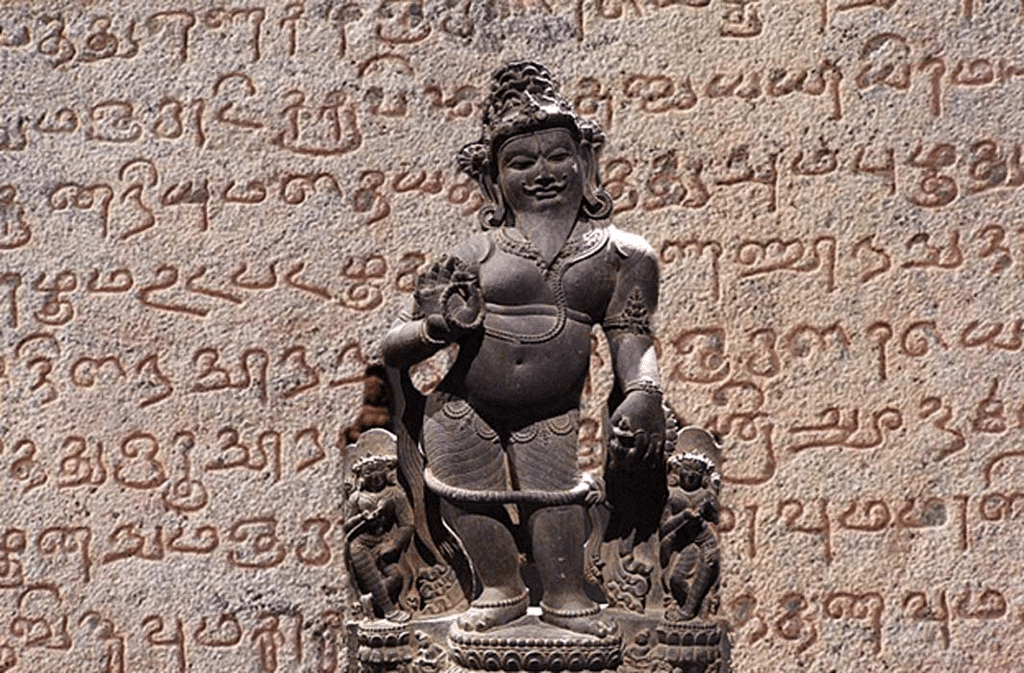 The Sangam Literature
The Sangam Literature
- The period roughly between the 3rd century B.C. and 3rd century A.D. in South India (the area lying to the south of river Krishna and Tungabhadra) is known as Sangam Period.
- It has been named after the Sangam academies held during that period that flourished under the royal patronage of the Pandya kings of Madurai.
- At the sangams eminent scholars assembled and functioned as the board of censors and the choicest literature was rendered in the nature of anthologies.
- These literary works were the earliest specimens of Dravidian literature.
- According to the Tamil legends, there were three Sangams (Academy of Tamil poets) held in the ancient South India popularly called Muchchangam.
1. The First Sangam, is believed to be held at Madurai, attended by gods and legendary sages.
2. The Second Sangam was held at Kapadapuram, only Tolkappiyam survives from this.
3. The Third Sangam was also held at Madurai. A few of these Tamil literary works have survived and are a useful sources to reconstruct the history of the Sangam period
- The Agattiyam was written by saint Agattiyar, is now extent in small shreds of sutras here and there, quoted by medieval commentators.
- The Tolkappiyam was written by Tolkappiyar, supposed to be a disciple of Agastya and a contemporary of eleven other scholars who were all disciple of the same Rishi.
- It is a work on Tamil grammar, literary tradition and sociology.
- Purapporul Venba Malai, a medieval work on the grammar of the Puram literature, says that the twelve scholars jointly produced Pannirupadalam, a grammatical work on Puram literature.
- The Kakkaipadiniyam, an extinct work on prosody, is also ascribed by tradition to that period.
- Traditionally, Tolkappiyam is supposed to lay down the grammatical rules which governed the literary compositions of the Sangam age.
- The sutras of the Tolkappiyam are elaborate and extensive in range.
- Orthography, construction, prosody, figures of speech, social practices, literary conventions, human psychology in so far as it relates to epic and dramatic literature, the grammar of the Aham (love) and Puram (war) and the allied conventions are set forth in detail in this work.
- It is schematic and divided into three sections, each consisting of nine sub-chapters.
- The word ‘Sangam’ for the early Tamil literature was mentioned for the first time by the Shaiva Saint Tirunavukkarasu Naynar who belonged to the early seventh century.
- The titles of the Cheras were: Vanavar, Villavar, Kudavar, Kuttuvar, Poraiyar, Malaiyar etc.
- The titles of the Cholas: Sennis, Sembiyas, Valavan and Killi.
- The titles of the Pandyas: Minavar, Kavuriyar, Panchavar, Tennar, Seliyar, Marar, Valudi etc.
- The Chera king Udiyanjeral was called Vanavaramban and Perujoran Udiyan by the poet Mudinagarayar in Puram.
- According to Silappad-karam, Pirakotitiya Senaguttuvan was the founder of the famous Pattini cult.
- According to a tradition recorded in Manimekalai, a good part of the port town of Puhar was engulfed by the sea in terrific tidal waves, during the reign of the later Chola king Killivalavan.
- According to Silappadi-karam, Nedunjelian, in a fit of passion, ordered without judicial enquiry the execution of Kovalan, the hero of Silappadikaram.
- The king was called Ko, Mannam, Vendan, Korravan or Iraivan.
- Soldiers were rewarded by the grant of maraya (military honour or fief) and the enadi title for particular act of heroism.
- Kadimaram or a Kavalmaram is a tutelary tree. It was believed that the tree had the power to protect the town.
- Viralis were the professional dancing girls.
- Yal and Padalai were the musical instruments.
- Tunaigai and alliyam were the dance forms.
- Pulaiyars were the craftmen who handled their needles with deftness.
- Panik-Kalari was an important industrial ‘factory’ where weapons
of war were forged and repaired.
Economic Condition
- The common people were mostly agriculturists or cowherds, hunters and fishermen. Industry flourished in the age.
 Sangam Temple
Sangam Temple - The textile industry, house building, jewellery makers, chariotmakers, provided the necessaries, comforts and luxuries of life.
- Ship-building, harbour-building etc. were developed. Next to agriculture, shipping and weaving were the most important and widely practised crafts.
- Most of the trade was carried on by barter. Paddy constituted the most commonly accepted medium of exchange.
- There were established angadi (markets) in the big towns. The market place was known as avanam.
- Agriculture was carried on in almost every part of the land, somewhat more in the delta area than elsewhere.
- The chief product i.e. paddy was largely supplemented by millets and other varieties of corn.
- They carried on extensive trade with foreign countries from very early times. Pepper, ginger, rice, sandal wood, cardamum, cinnamon, ivory and pearls and always been in great demand in foreign markets.
- Large hoards of Roman gold coins in many parts of South India provide evidence of the brisk trade between Tamilham and Rome.
- There were also manufacturers or traders. The major towns like Puhar, Uraiyur, Vanji, Tondi, Muziris, Madurai and Kanchi etc. absorbed most of the manufactured goods.
- A song in the Purananuru speaks of the sale of fish for paddy, of bales of pepper, and of the transport of a variety of merchandise in small boats from the large ships to the shore.
- Bandar was noted for its pearls and Kodumanam for rare jewels. Mention is made of the abundance of quartzite precious stones in the hills of the Chera country.
- Nirpeyarru was a seaport of which were brought horses from the west and other products from the north.
- Panik Kalari was an important industrial factory where weapons of war were forged and repaired.
- The merchandise brought to the port of Puhar included war-horses that came by sea, bags of black pepper brought overland by carts, gems and gold from the northern mountain, sandal and agil woods from the western mountain, pearls of the southern and coral of the eastern sea, food stuffs from Sri Lanka and luxuries from Kadaram.
- External trade was carried on between south India and Hellinistic kindgom of Egypt and Arabia as well as Malaya. Later Roman trade became very important. Roman settlements and gold coins have been discovered at Muziris in Kerala, Puhar or Kaveripattinam and Arikamedu near Pondichery in Tamilnadu.
- Cotton goods, pepper, ginger, cinnamon, turmeric, ivory, rice, cardamum, pearls, precious stones were the items of export and main imports were horses and gold etc.
Social Life
- The people were organised for the most part in occupational groups living part from one another but in fairly close proximity within each village or town, and their life was regulated by a pervasive sense of social solidarity.
- Except the agriculturists, who were the most important part of the society, there were many other communities such as fishermen, blacksmiths, carpenters, weavers, cobblers etc.
- A distinguishing features of the Sangam social life was that it was not priest dominated although Brahmanas had been an integral part of Vedic society.
- The name Chetti denoting a commercial community in South India seems to have been known in the Sangam age. Tolkappiyar calls them vaisigas.
- The status of women were not high. The widows had to cut off their hair, discard all ornaments and eat only the plainest food.
- Sati was fairly common but by no means universal. There were much faith in omens and astrology.
- The banyan tree was considered to be the abode of gods. Poetry, music and dancing were the most cultured amusement open to the upper classes.
- Yal was a famous instrument which was stringed instrument like the lute.
- For the disposal of the dead both cremation with or without urns are freely mentioned.
- The caste division and the tribal arrangement co-existed. Appearance of the Brahmanas as a regular varna.
- The merchant community was mostly in evidence in the towns. Tolkappiar calls them the Vaisigas. Absence of Kshatriya and Vaishya as regular varnas.
- The agriculturists (Velalas) were the very important part of the society.
- The ruling class was called the ‘Arasar’. There were some minor classes such as the “Kadaisiyar” (agricultural labourers) and ‘Pulaiyans’ (rope-makers).
- There is a vivid description of a padini, a singing woman of the panar caste, in the Perunanutruppadai in which Karikalan himself is described as the master of seven notes.
- Different kinds of lutes like Periyal, Palai-yal, and Sengottiyal are described in detail.
- The dances of Viralis (professional dancing girls) took place at right.
- Tolkappiyam and the Kalaviyal say that the Aryans introduced the ritual and ceremony of marriage (Karanam). These works also mentions the spontaneous coming together of sexes (Kamak-Kuttam); they distinguish secret marriage (Kalavu) from the open alliance contracted with the consent of parents (Karpu).
- Tolkappiyam and Kalaviyal refer to the eight forms of marriage known to the Sanskrit Dharmasastras. Though the gandharva form of marriage is easily equated to kalavu, the other Aryan forms do not fall in line so easily.
Religion
- Religion was associated with rituals and certain amount of metaphysical thoughts. Their rituals were related to animism and other forms of anthropomorphic deity worship.
- The hunters of the hill tracts worshipped Murugan as the God of the hillock. Indra, God of Marudam, was worshipped by the agriculturists.
- The fishermen and the people of the coastal regions worshipped Varuna. Korravai was the God of victory.
- The name for temple nagar, kottam, purai, koli was mentioned in Tamil literature.
- The vedic religion had struck root in the South. This is established by references to the costly sacrifices performed by monarchs of the age.
- The popularity and prevalance of the Brahmanical velvi (yajna), the sraddha and pinda to the dead, fasting etc. are well attested to by the Sangam literature.
- Rice mixed with flesh was offered to crows daily on the thresholds of houses.
- Vishnu sleeping on the coils of Ananta in Kanchipuram is mentioned in the Perumbanarruppadai.
- Siva as ardhanarisvara, his bull Nandi, his ganas are found together in the invocatory verse of the Purananuru.
- Gods on the basis of caste are mentioned in the Silappadikaram. Brahmana, the thirty-three devas, and the eleven ganas are mentioned in Tirumururruopadai.
- The temple of Indra is mentioned in Silappadikaram and in Manimekalai. Vilakalol was the festival of Indra.
- In the age of the Buddha we find 16 large states called Mahajanapadas, they were mostly situated north of the Vindhyas and extended from the north-west frontier to Bihar. Of these Magadha, Koshala, Vatsa and Avanti seem to have been considerably powerful. Beginning from the east we hear of the kingdom of Anga which covered the modern districts of Monghyr and Bhagalpur. It had its capital at Champa, Eventually the kingdom, of Anga was swallowed by its powerful neighbour Magadha.

- Magadha embraced the former districts of patna, Gaya and parts of Shahbad, and grew to be the leading state of the time. North of the Ganga in the division of Tirhut was the state of the Vajjis which included eight clans. But the most powerful were the Lichchhavis with their capital at Vaishali which is identical with the village of Basarh in the district of Vaishali. The Purnas push the antiquity of Vaishali to a much earlier period, but archaeologically Basarh was not settled until the sixth century B.C.
- Further west we find the kingdom of Kashi with its capital at Varanasi. In the beginning Kashi appears to be the most powerful of the states, but eventually it had to submit to the power of Koshala.
- Koshala embraced the area occupied by eastern Uttar Pradesh and had its capital at Shravasti, which is identical with Sahet-Mahet on the borders of Gonda and Bahraich districts in Uttar Pradesh. But we see the beginnings of a mud fort. Koshala contained an important city called Ayodhya, which is associated with the story in the Ramayana. Koshala also included the tribal republican territory of the Shaky as of Kapilvastu. The capital of Kapilavastu has been identified with Piprahwa in Basti district. Lumbini, which lies at a distance of 15 km from Piprahwa in Nepal served as another capital of the Shakyas. In an Ashokan inscription it is called the birthplace of Gautama Buddha and it was here that he was brought up.
- In the neighbourhood of Koshala lay the republican clan of the Mallas, One of the capitals of the Mallas lay at Kushinara where Gautama Buddha passed away. Kushinara is identical with Kasia in Deoria district. Further west lay the kingdom of the Vatsas, along the bank of the Yamuna, with its capital at Kaushambi near Allahabad. The Vatsas were a Kuru clan who had shifted from Hastinapur and settled down at Kaushambi. Kaushambi was chosen because of its location near, the confluence of the Ganga and the Yamuna. We also hear of the older states of the Kurus and the Panchalas which were situated in western Uttar Pradesh, but they no longer enjoyed the political importance which they had attained in the later Vedic period.
- In central Malwa and the adjoining parts of Madhya Pradesh lay the state of the Avantis. It was divided into two parts. The northern part had its capital at Uggain, and the southern part at Mahishamati.
- Magadha came into prominence under the leadership of Bimbisara, who belonged to the Haryanka dynasty.
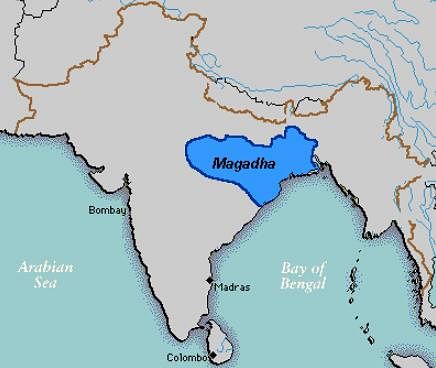 He was a contemporary of the Buddha. He started the policy of conquest and aggression which ended with the Kalinga war of Ashoka. Bimbisara acquired Anga and placed it under the viceroyaity of his son Ajatas hatru at Champa. He also strengthened his position by marriage alliances. He took three wives. His first wife was the daughter of the king of Koshala and the sister of Parsenajit. His second wife Chellana was a Lichchh avi princess from Vaishali who gave birth to Ajatashatru and his third wife was the daughter of the chief of the Madra clan of Punjab.
He was a contemporary of the Buddha. He started the policy of conquest and aggression which ended with the Kalinga war of Ashoka. Bimbisara acquired Anga and placed it under the viceroyaity of his son Ajatas hatru at Champa. He also strengthened his position by marriage alliances. He took three wives. His first wife was the daughter of the king of Koshala and the sister of Parsenajit. His second wife Chellana was a Lichchh avi princess from Vaishali who gave birth to Ajatashatru and his third wife was the daughter of the chief of the Madra clan of Punjab. - Magadha’s most serious rival was Avanti with its capital at Ujjain. Its king Chanda Pradyota Mahasena fought Bimbisara, but ultimately the two thought it wise to become friends. Later when Pradyota was attacked by jaundice, at the Avanti king’s request Bimbisara sent the royal physician Jivaka to Ujjain.
- The earliest capital of Magadha was at Rajgir, which was called Girivraja at that time. If was surrounded by five hills, the openings in which were closed by stone-walls on all sides. This made Rajgir impregnable. According to the Buddhist chronicles, Bimbisara ruled for 52 years. roughly from 544 B.C. to 492 B.C. He was succeeded by his son Ajatashatru (492-460 B.C.). Ajatashatru killed his father and seized the throne for himself. Throughout his reign he pursued an aggressive policy of expansion. This provoked against him a combination of Kashi and Koshala. There began a prolonged conflict between Magadha and Koshala. Ultimately Ajatashatru got the best of the war, and the Koshalan king was compelled to purchase peace by giving his daughter in marriage to Ajatashatru and leaving him in sole possession of Kashi.
- Although his mother was a Lichchhavi princess, this did not prevent him from making war against Vaishli. He created dissensions in the ranks of the Lichchhavis and finally destroyed their independence by invading their territory and by defeating them in battle. It took him full 16 years to destroy Vaishali. Eventually he succeeded in doing so because of a war engine which was used to throw stones like catapults. He also possessed a chariot to which a mace was attached, and it facilitated mass killings. The Magadhan empire was thus enlarged with the addition of Kashi and Vaishali.
- Ajatashatru faced a stronger rival in the ruler of Avanti. Avanti had defeated the Vatsas of Kaushambi and now threatened an invasion of Magadha. To meet this danger Ajatashatru began the fortification of Rajgir. The remains of the walls can be still seen. However, trie invasion did not materialize in his lifetime.
- Ajatashatru was succeeded by Uday in (460-444 B.C.) His reign is important because he built the fort upon the confluence of the Ganga and Son at Patna. This was done because Patna lay in the centre of the Magadhan kingdom, which now extended from the Himalayas in the north to the hills of Chotanagpur in the south.
- Udayin was succeeded by the dynasty of Shishunagas, who temporarily shifted the capital to Vaishali. Their greatest achievement was the destruction of the power of Avanti with its capital at Ujjain. This brought to an end the 100 year old rivalry between Magadha and Avanti. From now onwards Avanti became a part of the Magadhan empire and continued to be so till the end of the Maurya rule.
- The Shishunagas were succeeded by the Nandas, who proved to be the most powerful rulers of Magadha. So great was their power that Alexander, who invaded Punjab at that time, did not dare to move towards the east.
The nandas added to the Magadhan power by conquering Kalinga from where they brought an image of the Jina as a victory trophy. All this took place in the reign of Mahapadma Nanda. He claimed to be ekarat, the soles overeign who destroyed all the other ruling princes. It seems that he acquired not only Kalinga but also Koshala which had probably rebelled against him.
The later Nandas turned out to be weak and unpopular. Their rule in Magadha was supplanted by that of the Maurya dynasty under which the Magadhan empire reached the apex of glory.
➢ Chandragupta Maurya
- THE MAURYA dynasty was founded by Chandragupta Maurya, who seems to have belonged to some ordinary family.

According to the brahmanical tradition he was born of Mura, a shudra woman in the court of the Nandas. But an earlier Buddhist tradition speaks of the existence of a kshatriya clan called Mauryas living in the region of Gorakhpur adjoining the Nepalese terai. In all likelihood, Chandragupta was a member of this clan. He took advantage of the growing weakness and unpopularity of the Nandas in the last days of their rule. With the help of Chanakya, who is known as Kautilya, he overthrew the Nandas and established the rule of the Maurya dynasty. The machinations of Chanakya against Chandragupta’s enemies are described in detail in the Mudrarakshasa, a drama written by Vishakhadatta in the ninth century. Several plays have been based on it in modern times. - Justin, a Greek writer, says that Chandragupta overran the whole of India with an army of 600,000. But Chandragupta liberated north-western India from the thraldom of Selucus, Chandragupta thus built up a vast empire which included not only Bihar and good portions of Orissa and Bengal but also western and northwestern India, and the Deccan. Leaving Kerala, Tamilnadu and parts of north-eastern India the Mauryas ruled over the whole of the subcontinent. In the north-west they held sway over certain areas which were not included even in the British empire.
➢ Imperial Organization
- The Mauryas organized a very elaborate system of administration. We know about it from the account of Megasthenes and the Arthashastra of Kautilya. Megasthenes was a Greek ambassador sent by Seleucus to the court of Chandragupta Maurya. He lived in the Maurya capital of Pataliputra and wrote an account not only of the administration of the city of Pataliputra but also of the Maurya empire as a whole. The account of Megasthenes have been published in the form of a book called Indika, which throws valuable light on the administration, society and economy of Maurya times. The account of Megasthenes can be supplemented by the Arthashastra of Kautilya. Arthashastra gives authentic information about the Maurya administration and economy. On the basis of these two sources we can draw a picture of the administrative system of Chandra-gupta Maurya. If we believe in a statement of the Arthashastra, the king had set a high ideal the happiness of his subjects lay his happiness and in their troubles lay his troubles. According to Megasthenes the king was assisted by a council.
- The empire was divided into a number of provinces, and each province was placed under a prince who was a scion of the royal dynasty. The provinces were divided into still smaller units, and arrangements were made for both rural and urban administration. Excavations The administration Pataliputra, which was the capital of the Mauryas, was carried on by six committees, each committee consisting of five members. These committees were entrusted with sanitation, care of foreigners, registration of birth and death, regulation of weights and measures and similar other functions.
- The most striking feature of Chandragupta’s administration is the maintenance of a Huge army. According to the account of a Roman writer called Poiny, Chandragupta maintained 600,000 foot-soldiers, 30,000 cavalry and 9000 elephants the Mauryas also maintained a navy. The administration of the armed forces, according to Megasthenes, was carried on by a board of 30 officers divided into six committees, consisting of five members.
➢ Ashoka (273-232 B.C.)
- Chandragupta Maurya was succeeded by Bindusara, whose reign is important for continued links with the Greek princes. His son, Ashoka, is the greatest of the Maurya rulers. According to Buddhist tradition he was so cruel in his early life that he killed his 99 brothers to get the throne. But since the statement is based on a legend, it may well be wrong. His biography, prepared by Buddhist writerters, is so full of finction that it cannot be taken seriously.
➢ Ashokan Inscriptions
- The history of Ashoka is reconstructed on the basis of his inscriptions. These inscriptions, numbering 39, are classified into Major Rock Edicts, Minor Rock Edicts, Separate Rock Edicts, Major Pillar Edicts and Minor Pillar Edicts. The name of Ashoka occurs only in copies of Minor Rock Edict found at three places in Karnataka and at one in Madhya Pradesh.
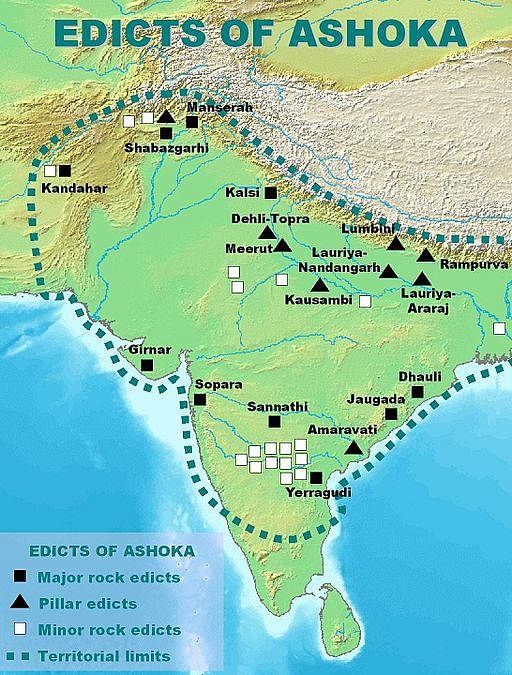
- All the other inscriptions mention only devanamptya piyadasi, dear to gods, and leave out the word Ashoka. The Ashokan inscriptions are found in India, Nepal, Pakistan and Afghanistan. Altogether they appear at 47 places, and their total versions number 182. They were generally placed on ancient highways. Composed in Prakrit, they were written in Brahmi script in the greater part of the subcontinent. But in its northwestern part they appeared in Aramaic language and Kharoshthi script, and in the Afghanistan they were written in both Aramaic and Greek scripts and languages. He is the first Indian king to speak directly to the people through his inscriptions which carry royal orders. The inscriptions throw light on the career of Ashoka, his external and domestic polices, and the extent of his empire.
➢ Impact of the Kalinga War
- The ideology of Buddhism guided Ashoka’s state policy at home and abroad. After his accession to the throne, Ashoka fought only one major war called the Kalinga War. According to him, 100,000 people were killed in this war, several lakhs perished, and 150,000 were taken prisoners. At any rate it seems that the king war moved by the massacre in this war. So he abandoned the policy of physical occupation in favour of policy of cultural conquest. In other words, bherighosha was replaced with dhammaghosha. We quote below the worlds of Ashoka from his Thirteenth Major Rock Edict:
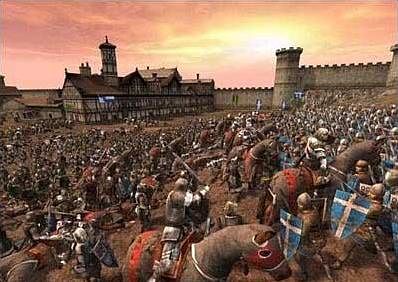 Kalinga War
Kalinga War - Ashoka no longer treated foreign dominions as legitimate areas for military conquest. He tried to conquer them ideologically. He took steps for the welfare of men and animals in foreign lands, which was a new thing considering the condition of those days. He sent ambassadors of peace to the Greek kingdoms in West Asia and Greece. He sent mission-aries for the propagation of Buddhism to Sri Lanka and Central Asia. As an enlightened ruler Ashoka tiled to enlarge his area of political influence through propaganda.
- It would be wrong to think that the Kalinga war made Ashoka an extreme pacifist. On the other hand he adopted a practical policy of consolidating his empire. He retained Kalinga after its conquest and incorporated it into his empire. There is also nothing to show that he disbanded the huge army maintained from the time of Chandragupta Maurya. Within the empire he appointed a class of officers known as the rajukas, who were vested with the authority of not only rewarding people but also punishing them, wherever necessary.
➢ Internal Policy and Buddhism
- Ashoka was converted to Buddhism as a result of the Kalinga war. According to tradition he became a monk, made huge gifts to the Buddhists and undertook pilgrimages to the Buddhist shrines. The fact of his visiting the Buddhist shrines is also suggested by the dhamma yatras mentioned in his inscriptions. According to tradition the Buddhist council (Sangiti) was held by Ashoka and missionaries were sent not only to south India but also to Sri Lanka, Burma and other countries to covert the people there. Brahmi inscriptions of the second and first centuries B.C. have been found Sri Lanka.
- Ashoka set a very high ideal for himself, and this was the ideal of paternal kingship. He repeatedly asked his officials to tell the subjects that the king looked upon them as his children. As agents of the king, the official were also asked to take care of the people. Ashoka appointed Dhammama-hamatras for propagating dharma among various social groups including women. He also appointed rajukas for the administration of justice in his empire.
- He disapproved of rituals, especially those observed by women. He forbade killing certain birds and animals, and completely prohibited this laughter of animals in the capital. He interdicted gay social functions in which people indulged in revelries.
➢ Ashoka’s Place in History
- It is said that the pacific policy of Ashoka rained the Maury a empire, but this is not true. On the country Ashoka has a number of achievements to his credit. He was certainly a great missionary ruler in the history of the ancient world. He worked with great zeal and devotion to his mission and achieved a lot, both at home and abroad.
- Ashoka brought about the political unification of the country. He bound it further by one dharma, one language and practically one script called Brahmi which was used in most of his inscriptions. In unifying the country he respected such scripts as Brashmi, Kharoshthi, Aramaci and Greek. Evidently he also accommodated such languages as Greek, Prakrit and Sanskrit and various religious sects. Ashoka followed a tolerant religious policy. He did not try to foist his buddhist faith on his subjects.
- On the other hand he made gifts to non-Buddhist and even anti-Buddhist sects. Ashoka was fired with zeal for missionary activities. He deputed officials in the far-flung parts of the empire. This helped the cause of ad-ministration and also promoted cultural contacts between the developed Gangetic basin and the backward distant provinces. The material culture, typical of the heart of the empire, spread to Kalinga and the lower Deccan and norther Bengal. Above all ashoka is important in history for his policy of peace, nonaggression and cultural conquest.
- He had no model in early Indian history for pursuing such a policy; nor did such an example exist in any country except Egypt where Akhnaton had pursued a pacific policy in the fourteenth century B.C. But it is obvious that Ashoka was not aware for his Egyptian predecessor.
- However, Ashoka’s policy did not make any lasting impression on his viceroys and vassals, who declared themselves independent in their respective areas after the retirement of the king in 232 B.C. Similarly, the policy could not convert his neighbours, who swooped on the northwestern frontier of his empire within 30 years of Ashoka’s exit from power in 232 B.C.
- After The break-up of the Maurya empire, the Satavahanas and the Kushans emerged as two large political powers. The Satavahanas acted as a stabilizing factor in the Deccan and south to which they gave political unity and economic prosperity on the strength of their trade with the Roman empire. The Kushans performed the same role in the north. Both these empires came to an end in the middle of the third, century A.D.
- On the ruins of the Kushan empire arose a new empire, which established its way over a good part of the former dominions of both the Kushans and Satavahanas. This was the empire of the Guptas, who may have been of vaishya origin. Although the Gupta empire was not as large as the Maurya empire, it kept north India politically united for more than a century from A.D. 335 to 455.

- The original kingdom of the Guptas comprised Uttar Pradesh and Bihar at the end of the third century A.D. Uttar Pradesh seems to have been a more important province for the Guptas than Bihar because early Gupta coins and inscriptions have been mainly found in that state.
- If we leave out some feudatories and private individuals, whose inscriptions have been mostly found in Madhya Pradesh, Uttar Pradesh will stand out as the most important area in respect of the finds of the Gupta antiquities. Hence, Uttar Pradesh seems to have been the place from where the Guptas operated and fanned out in different directions. Probably with their center of power at Prayag they spread in the neighboring regions.
- The Guptas were possibly the feudatories of the Kushans in Uttar Pradesh and seems to have succeeded them without any wide time lag. At many places in Uttar Pradesh and Bihar, the Kushan antiquities were immediately followed by the Gupta antiquities.

- It is likely that the Guptas learned the use of a saddle, reins, buttoned coats, trousers, and boots from the Kushans. All these gave them mobility and made them excellent horsemen. In the Kushan scheme of things, horse-chariots and elephants had ceased to be important.
- Horsemen played the main part. This also seems to have been the case with the Gupta on whose coins horsemen are represented. Although some Gupta kings are described as excellent and unrivaled chariot warriors, their basic strength lay in the use of horses.
- The Guptas enjoyed certain material advantages. The center of their operations lay in the fertile land of Madhyadesha covering Bihar and Uttar Pradesh. They could exploit the iron ores of central India and south Bihar. Further, they took advantage of their proximity to the areas in north India which carried on silk trade with the Eastern Roman Empire, also known as the Byzantine empire.
- On account of these favorable factors, the Guptas set up their rule over Anuganga (the middle Gangetic basin), Prayag (modern Allahabad), Saketa (modern Ayodhya), and Magadha. In course of time, this kingdom became an all-India empire.
- The Kushan power in north India came to an end around A.D. 230 and then a good part of central India fell under the rule of the Murundas, who were possibly the kinsmen of the Kushans. The Murundas continued to rule till A.D. 250. Twenty-five years later, in about A.D. 275, the dynasty of the Gupta came to power.
- The first important king of the Gupta dynasty was Chandragupta I. He married a Lichchhavi princess most probably from Nepal, which strengthened his position. The Guptas were possibly vaishyas, and hence marriage in a Kshatriya family gave them prestige.
- Chandragupta I seems to have been a ruler of considerable importance because he started the Gupta era in A.D. 319-20, which marked the date of his accession. Later many inscriptions came to be dated in the Gupta era.
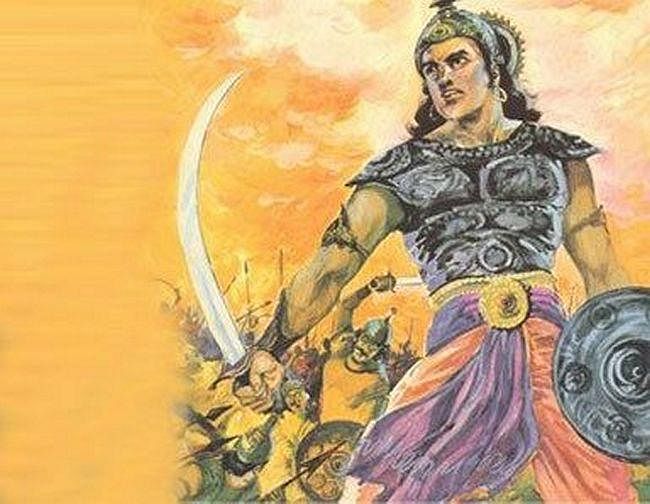
- The Gupta kingdom was enlarged enormously by Chandragupta I’s son and successor Samudragupta (A.D. 335-380). He was the opposite of Ashoka. Ashoka believed in a policy of peace and son-aggression, but Samu Dasgupta delighted in violence and conquest. His court poet Harishena wrote a glowing account of the military exploits of his patron.
- Along with the inscription, the poet enumerates the peoples and countries that were conquered by Samudragu PTA. The inscription is engraved at Allahabad on the same pillar which carries the inscriptions of the peace-loving Ashoka.
- The places and the countries conquered by Samudragupta can be divided into five groups:
- Group one includes princes of the Ganga-Yamuna doab who were defeated and whose kingdoms were incorporated into the Gupta empire.
- Group two includes the rulers of the eastern Himalayan states and some frontier states such as princes of Nepal, Assam, Bengal, etc., who were made to feel states and some frontier states such princes of Nepal, Assam, Bengal, etc., who were made to feel the weight of Samudraguptas arms. It also covers some republics of Punjab, The republic, which flickered on the ruins of the Maurya empire, were finally destroyed by Samudragupta.
- Group three includes the forest kingdoms situated in the Vindhya region and known as Atavika rays, they were brought under the control of Samudragupta.
- Group four includes twelve rulers of the eastern. Deccan and south India, who were conquered and liberated. Samudragupta’s arms reached as far as Kanchi in Tamil Nadu, where the Pallavas were compelled to recognize his suzerainty.
- Group five includes the names of the Sanka's and Kushans, some of them ruling in Afghanistan.
- It is said that Samudragupta swept them out of power and received the submission of the rulers of distant lands. The prestige and influence of Samudragupta spread even outside India. According to a Chinese source, Meghavarman, the ruler of Sri Lanka, sent a missionary to Samudragupta for permission to build a Buddhist temple at Gaya. This was granted, and the temple was developed into a huge monastic establishment.
- If we believe the eulogistic inscription from Allahabad, it would appear that Samudragupta never knew any defeat, and because of his bravery and generalship, he is called the Napoleon of India. There is no doubt that Samudragupta forcibly unified the greater part of India under him, and his power was felt in a much larger area.
- The reign of Chandragupta II saw the high watermark of the Gupta empire. He extended the limits of the empire by marriage alliances and conquests. Chandragupta married his daughter Prabhavati to a Vakata ka prince who belonged to the brahmana caste and ruled in central India.
- The prince died and was succeeded by his young son. So Prabhavati became the virtual paler. As shown by some of her land charters, which betray the influence of the eastern Gupta writing, she promoted the interests of her father Chandragupta.
- Thus, Chandragupta exercised indirect control over the Vakataka kingdom in central India. This afforded a-great advantage to him. With this great influence in this area, Chandragupta II conquered western Malwa and Gujarat, which had been under the rule of the Shaka Kshtraps for about four centuries by that time.
- The conquest gave Chandragupta the western sea coast, famous for trade and commerce. This contributed to the prosperity of Malwa, and its chief city Ujjain. Ujjain seems to have been made the second capital by Chandragupta II.
- Chandragupta II adopted the title of Vikramaditya, which had been first used by a Ujjain ruler in 57 B.C. as a mark of victory over the Shaka Kshatrapas of western. India The court of Chandragupta II at Ujjain was adorned by numerous scholars including Kalid as a and Anairasimlia. It was in Chandragupta’s time that the Chinese pilgrim Fahsien (399-414) visited India and wrote an elaborate account of the life of its people.
- The successors of Chandragupta II had to face an invasion by the Hunas from Central Asia in the second half of the fifth century A.D. Although in the beginning the Gupta king Skandragupta tried effectively to stem the march of the Hunas into India, his successors proved to be weak and could not cope with the Huna invaders, who excelled in horsemanship and possibly used stirrups made of metal. They could move quickly and being excellent archers they seem to have attained considerable successors not only in Iran but also in India.
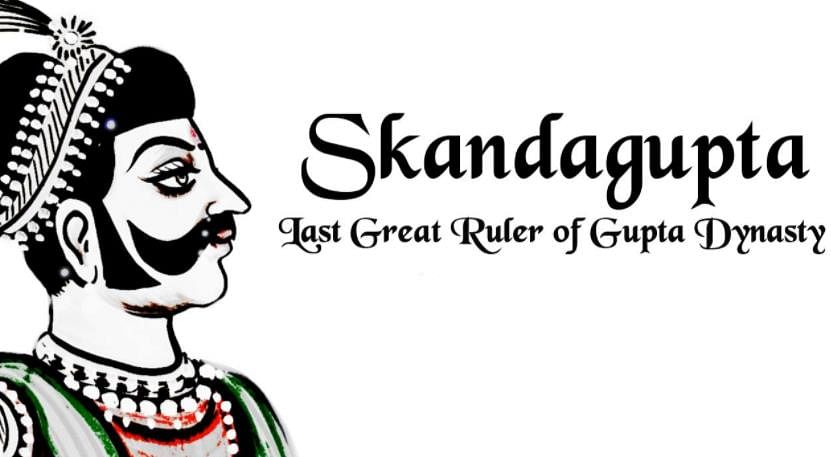
- By 485 the Hunas occupied eastern Malwa and a good portion of central India where their inscriptions have been found. The intermediate regions such as Punjab and Rajasthan also passed under their possession.This must-have drastically reduced the extent of the Gupta Empire at the beginning of the sixth century.
- Although the Huna power was soon overthrown by Yashodharam an of Malwa who belonged to the Aulikaraf laudatory family, the Malwa prince successfully challenged the authority of the Gupta and set up in 532, pillars of victory commemorating his conquest of almost the whole of northern India, Yashodharman’s rule was shortlived, but it meant a severe blow to the Gupta empire.
- The Gupta empire was further undermined by the rise of the feudatories. The governors were appointed by the Gupta kings in the north. Bengal and their feudatories in Samatata or south-east Bengal tended to become independent. The late Guptas of Magadha established their power in Bihar.
- Alongside them, the Maukharis rose to power in Bihar and Uttar Pradesh and had their capital at Kanauj. It seems that by 550 Bihar and Uttar Pradesh had passed out of Gupta's hands.
- By the beginning of the sixth century, we find independent princes issuing land grants in their own rights in northern Madhya Pradesh, although they use the Gupta era in dating their characters. The rulers of Valabhi established their authority in Gujarat and western Malwa. After the reign of Skandagupta, i.e. A.D. 467, hardly any Gupta coin or inscription has been found in western Malwa and Saurashtra.
- The Gupta state may have found it difficult to maintain a large professional army on account of the growing practice of land grants for religious and other purposes, which was bound to reduce their revenues. Their income may have further been affected by the decline of foreign trade. The migration of a guild of silk-weavers from Gujarat to Malwain A.D. 473 and their adoption of nonproductive professions show that there was not much demand for cloth produced by them.
- The advantages of Gujarat trade gradually disappeared. After the middle of the fifth century, the Gupta kings made desperate attempts to maintain their gold currency by reducing the content of pure gold in it. But this proved of no avail. Although the rule of the Imperial Guptas lingered till the middle of the sixth century A.D., the imperial glory had vanished a century earlier.
Rise and Growth of Magadhan Empire
Bimbisar
- Its first important ruler was Bimbisara or Srenika of Haryanka Dynasty.
- He ascended the throne in second half of 6th century B.C. and ruled for 52 years.
- He was contemporary of Buddha and patronised Buddhism.
- Bimbisar founded the city of Rajgriha, north of Girivarj.
- Both Mahavira and Buddha preached their doctrines during his reign.
- He followed the policy of marriage alliance. He took three wives. First wife was Prashenjit’s sister (king of Kosala). Second wife, Chellana, daughter of Lichchavi prince Chetaka (from Vaishali). Third wife was daugther of chief of Madra clan of Punjab.
- Magadha’s most serious rival was Avanti. Its king Chanda Pradyote Mahasen fought Bimbisara, but ultimately became friendly to Ujjain. Once Bimbisara sent the royal physician Jivaka to Ujjain.
Ajatshatru (492-460 B.C.):
- Killed his father and seized the throne.
- Both Mahavira and Buddha died in his reign.
- Conflict between Kosala and Magadha started in the time of Ajatshatru.
- Throughout his reign he pursued aggressive policy of expansion.
- It took full 16 years to destroy and annex Vaishali. He also annexed Kasi.
- To repel the Vrijjis, he fortified the village of Pataligram which stood near the confluence of Ganga and Sone. Thus founded the famous city of Pataliputra.
Udayan (460-444 B.C.):
- Succeeded Ajatshatru.
- He shifted his capital to Pataliputra.
Shishunagas
- Udayan was succeeded by Shishunaga who temporarily shifted his capital at Vaishali.
- Shishunaga was a viceroy of Banaras and was invited by the people to takeover the throne.
- The greatest achievement of Shishunagas was a destruction of Avanti. From now onwards Avanti became a part of Magadhan empire.
Nandas
- Shishunagas were succeeded by the Nandas.
- Its greatest king was Mahapadmananda. He conquered Kalinga and brought an image of Jina as a victory trophy. He claimed to be Ekarath (the sole sovereign).
- The first imperial and centralised structure was established by the Nandas. That’s why, sometimes they are called “the first empire builder of India”.
- Nandas were the first of a number of non-Kshatriya ruling dynasties. Mahapadma Nanda himself is described in the later Puranic texts as the “destroyer of all Kshatriyas”.
- The first phase of expansion and consolidation of the Magadh empire was over by the reign of Mahapadma Nanda.
- Bhadrasala was the last Nanda king who was defeated by Chandragupta Maurya.
Invasion of Alexander
- Alexander crossed Hindu-kush and occupied the district of Kabul, then crossed Sulaiman range through Khyber pass. He crossed the Indus in 326 B.C.
- Ambhi the king of Taxila surrendered and offered no resistance.
- Beyond the Jhelum lay the territory of the most war like king Porus of Punjab, who was defeated by Alexander in the Battle of Hydaspes. Impressed by the courage of Porus, Alexander restored his kingdom and made him his ally.
- After this victory Alexander continued advance, but at the Beas he was forced to turn back, for his generals feared mutiny if his troops were made to advance further into the unknown country.
- Alexander died in 323 B.C. at Babylon.
- He remained in India for 19 months (326-25 B.C.).
- Most important outcome of this invasion was the establishment of direct contact between India and Greece in different fields. His campaign opened up four distinct routes by land and sea. Alexander sent from India 200,000 oxen to Macedonia for use in Greece.
- Alexander’s historian gave important accounts to build Indian history. Also by destroying the power of petty states in north-west India he paved the way for the expansion of the Mauryan Empire.
- Alexander saw the ocean for the first time at the mouth of the Indus.
- One of the earliest recorded incidents of Jauhar took place as long ago as the invasion of Alexander the Great, when the 20,000 inhabitants of one town in Northern India so despaired upon hearing about the approaching Macedonians, that they set their entire town alight and threw themselves into the flames along with their families rather than risk enslavement.
- Alexander received a dangerous wound while storming one of the powerful tribe of the Malawas.
Buddhism started in India over 2,600 years ago as a way life that had the potential of transforming a person.
- It is one of the important religions of South and South-Eastern Asian countries.
- The religion is based upon the teachings, life experiences of its founder Siddhartha Gautam, born circa 563 BCE.
- He was born into the royal family of Sakya clan who ruled from Kapilvastu, in Lumbini which is situated near the Indo-Nepal Border.
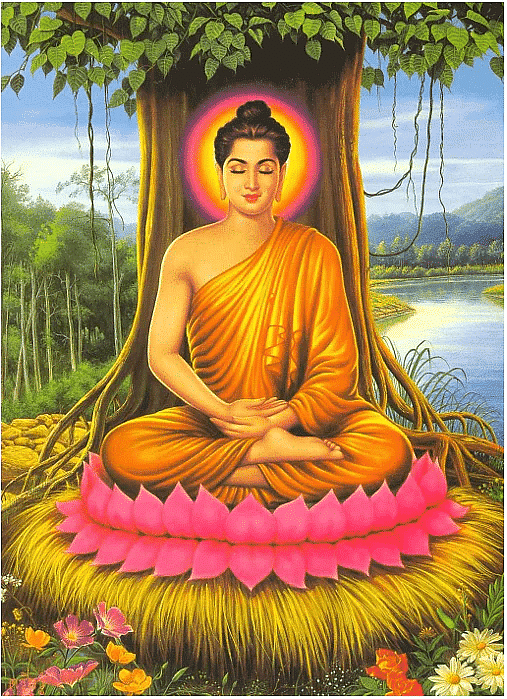 At the age of 29, Gautama left home and rejected his life of riches and embraced a lifestyle of asceticism or extreme self-discipline.
At the age of 29, Gautama left home and rejected his life of riches and embraced a lifestyle of asceticism or extreme self-discipline.- After 49 consecutive days of meditation, Gautama attained Bodhi (enlightenment) under a pipal tree at Bodhgaya a village in Bihar.
- Buddha gave his first sermon in the village of Sarnath, near the city of Benares in UP. This event is known as Dharma-Chakra-Pravartana (turning of the wheel of law).
- He died at the age of 80 in 483 BCE at a place called Kushinagara a town in UP. The event is known as Mahaparinibban.
The various causes that led to the origin of Buddhism are:
Kshatriya class’ resentment towards the domination of the priestly class (Brahmanas)
- The order of hierarchy in the Varna system was Brahmanas, Kshatriyas, Vaishyas, and Shudras.
- The Kshatriyas who were ranked second strongly objected to the ritualistic domination of the Brahmanas and the various privileges enjoyed by them.
- It should also be noted that both Buddha belonged to the Kshatriya varna.
- It is important to mention that the Buddhist Pali texts at many places reject the Brahmanical claim to superiority and places itself (Kshatriyas) higher than the Brahmanas.
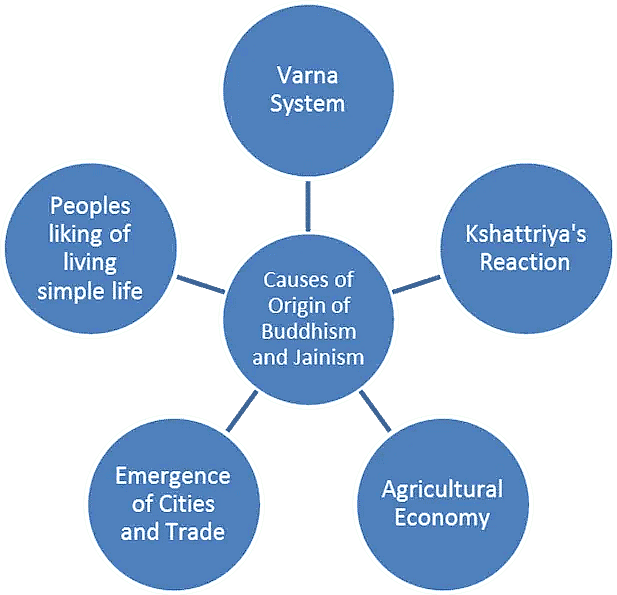
Rise of the new agricultural economy that needed animal husbandry instead of killing animals
- In the sixth century BCE, there was a shift of the center of economic and political activity from Haryana and western U.P to eastern U.P and Bihar where the land was more fertile due to abundant rainfall.
- It became easier to utilize the iron reservoir of Bihar and its adjoining areas. People started using more and more iron tools like plowshare for agricultural purposes.
- The use of iron plowshare required the use of bullocks, which meant that the age-old custom in the Vedic age of killing animals as sacrifices would have to be abandoned for this agricultural economy to stabilize.
- Furthermore, the flourishing of animal husbandry became imminent to raise a potential animal population to take up the work that was required to uphold the agricultural sector development.
- Buddhism was against any kind of sacrifice, so the peasant class welcomed it.
- The discovery of thousands of silver and copper Punch-Marked Coins (PMC) by the numismatists reflects the development of trade in this era.
- This period is known as the era of second urbanization. As many as sixty towns and cities like Rajagriha, Shravasti, Varanasi, Vaishali, and Champa developed between 600 and 300 BCE.
- The Vaishyas and other mercantile groups rose to a better economic position and preferred to patronize non-Vedic religions like Buddhism through substantial donations.
- As Buddhism promoted peace and non-violence, this could put an end to wars between different kingdoms and consequently promote further trade and commerce, which was beneficial for this economic class.
The Vaishyas and other mercantile groups favored Buddhism as they yearned for a better social and peaceful life:
s imple and peace-centered principles of Buddhism were accepted by people- The common masses welcomed the new religions as they preached peace and social equality, simple and ascetic living.
- People wanted relief from the growing social problems and yearned to live a peaceful and uncorrupt life.
- Gautama Buddha, founder of Buddhism was born, was born in 563 BC at Lumbinivana in Kapilvastu in the Sakya Kshatriya clan.
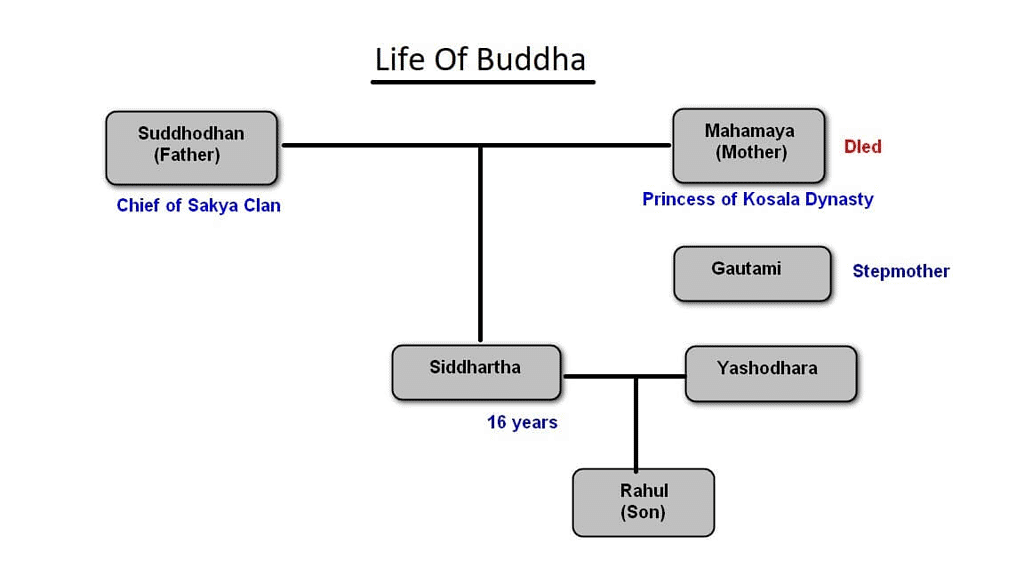
- His father Suddodhana was the king of Kapilvastu and his mother Mahamaya was a princess of the Koliya dynasty.
- Mahaprajapati Gautami was the step mother of Gautama.
- He was married to Yasodhara (Princess of Kolli dynasty) from whom he had a son Rahul.
- At the age of 29, he renounced home this was his Mahabhinishkramana (great going forth) and became a wandering ascetic.
- His first teacher was Alara Kalama. Another teacher was Udraka Ramputra.
- At the age of 35 under a peepal tree at Uruvella (Bodh Gaya) on the bank of river Niranjana (modern name Falgu) attained Nirvana (enlightenment)after 49 days of continuous meditation

- Buddha delivered his first sermon at Sarnath (Dear park) to his five disciples, this is known as Dharmachakra Pravartana (Turning of the wheel of law).
- Ananda and Upali were his famous disciples.
- Sujata was the farmer’s daughter who gave him rice milk at Bodha Gaya
- He died at the age of 80 in 483 BC at Kushinagar. This is known as Mahaparinirvana
- Eight great places associated with Buddhism are Lumbini, Sarnath, Sravasti, Rajgriha, Bodh Gaya, Kushinagar, Sankisa, and Vaishali. Patliputra is not associated with Buddha
- Ashoka, the greatest patron of Buddhism, called the 3rd Buddhist council & sent a mission comprised of his son Mahendra & his daughter Sanghamitra to Sri Lanka.
- Palas of Bengal & Bihar was the last great patrons of Buddhism
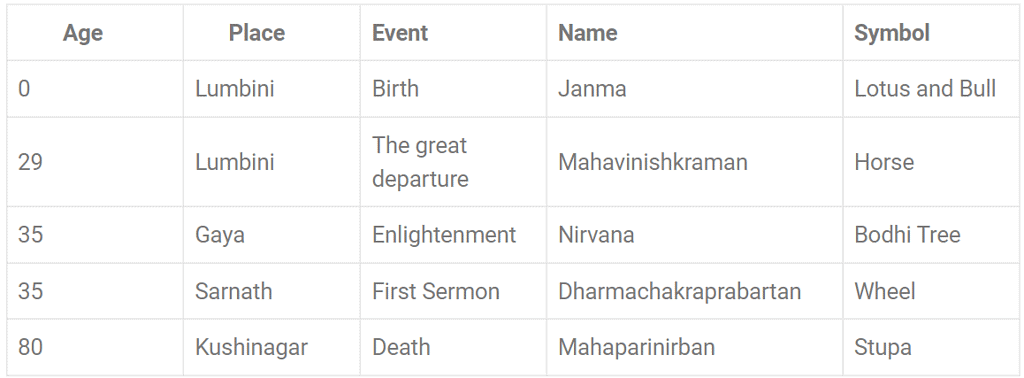
The core idea of Doctrines of Buddhism is obtained from
1) Four Noble Truth: Ariya-Sachchani and
2) Eight-Fold Path: Astangika-Marga
Gautam Buddha’s teachings contain three important pillars:
- Buddha – Founder/ Teacher
- Dhamma – Teachings
- Sangha– Order of Buddhist monks/nuns (who act as torchbearers of Dhamma worshippers or Upasakas and are a major factor in the dissemination of the Buddha’s doctrine)
- While struggling for Enlightenment, Buddha had discovered Dhamma/Four Noble Truths
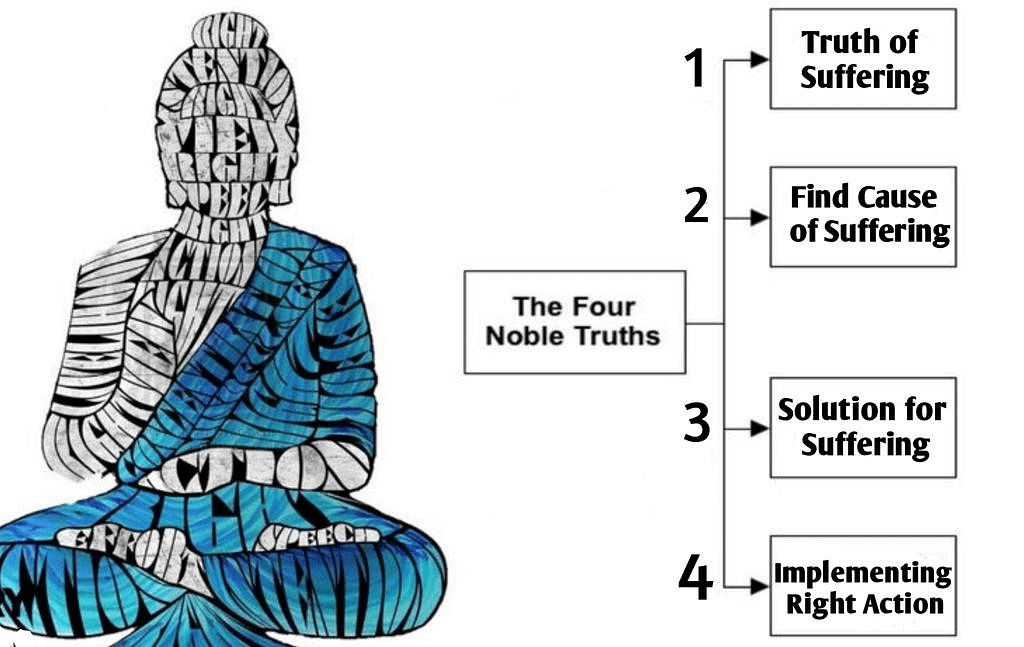
- Desire is the root cause of suffering
- The cessation of suffering is attainable
- The cessation of suffering can be attained by following the “Eight Fold Path”
(i) According to Buddhist philosophy, the ultimate aim of life is to attain nirvana, the eternal state of peace and bliss, which means liberation from the cycle of birth and death
(ii) According to Buddhist philosophy, the world is momentary
(iii) The interesting fact about Buddhist philosophy is that while it believes in the cycle of birth and death it does not believe in the concept of the soul
(iv) “The Middle Path” of Buddhism states that man should avoid both extremes - Triratna i.e. Three Jewels of Buddhism are
(i) Buddha
(ii) Dharma
(iii) Sangha
The Eight-Fold Path is more about unlearning rather than learning, i.e., to learn in order to unlearn and uncover. The path consists of eight interconnected activities and is a process that helps one to move beyond the conditioned responses that obscure one’s nature. The Ashtangika-Marga consists of the following:

- Right Vision (Samma-Ditthi) – it is about understanding the nature of reality and the path of transformation.
- Right Thought or Attitude (Samma-Sankappa) – it signifies having emotional intelligence and acting from love and compassion.
- Right or Whole Speech (Samma-Vacca) – it signifies truthful, clear, uplifting and unharmful communications.
- Right or Integral Action (Samma-Kammanta) – it signifies an ethical foundation of life, on the principles of non-exploitation of oneself and others. It consists of five rules, which form the ethical code of conduct for the members of the monastic order and the laity. These are:
- Do not commit violence.
- Do not covet the property of others.
- Do not indulge in corrupt practices or sensual behaviour.
- Do not speak a lie.
- Do not use intoxicants.
In addition to these, monks and nuns were strictly instructed to observe the following three additional precepts-
- To avoid eating after mid-day.
- To refrain from any sort of entertainment and use of ornaments to adorn oneself.
- To refrain from using high or luxurious beds, and from handling gold and silver (including money).
- Right or Proper Livelihood (Samma-Ajiva) – it lays emphasis on livelihood based on correct action and on the ethical principles of non-exploitation. It is believed that this forms the basis of an ideal society.
- Right Effort or Energy (Samma-Vayama) – it signifies consciously directing our life energy to the transformative path of creative and healing action that fosters wholeness thus moving towards conscious evolution.
- Right Mindfulness or Thorough Awareness ( Samma-Sati) – it means knowing one’s own self and watching self behaviour. There is a saying by the Buddha, “If you hold yourself dear, watch yourself well”.
- Right Concentration or Meditation (Samma-Samadhi) – samadhi literally means to be fixed, absorbed in. It means getting one’s whole being absorbed in various levels or modes of consciousness and awareness.
The early Buddhist literature is divided into canonical and non-canonical texts:
The earliest compilation of Buddhist teachings which were written on long, narrow leaves is “The Tipitakas” (in Pali) and “Tripitaka” (in Sanskrit).
- All the branches of Buddhism have the Tripitakas (also called three baskets/collections) as part of their core scriptures, which comprise three books which are:

- The Sutta (conventional teaching)
- The Vinaya (disciplinary code)
- The Abhidhamma (moral psychology)
1. Sutta Pitaka – consists of the main teaching or Dhamma of Buddha. It is divided into five Nikayas or collections:
(i) Dighgha Nikaya
(ii) Majhim Nikaya
(iii) Sanyukta Nikaya
(iv) Anguttar Nikaya
(v) Kshudraka Nikaya
2. Vinay Pitaka- This contains rules for monks and nuns of the monastic order (Sangha). It includes the Patimokkha – a list of transgressions against monastic discipline and atonements for these. The Vinaya text also includes doctrinal expositions, ritual texts, biographical stories and some elements of Jatakas or “birth stories”.
3. Abhidhamma Pitaka –The Abhidamma Pitaka is a philosophical analysis and systematization of the teaching and the scholarly activity of the monks. It consists of the religious and metaphysical discourses of Buddha
Some important ones are:
- Mahavastu (written in Sanskrit-Prakrit mixed) - it is about the sacred biography, i.e hagiography of the Buddha.
- Nidanakatha - the first connected life story of Buddha.
- The Dipavamsa & the Mahavamsa (both in Pali)- both give historical and mythical accounts of the Buddha's life, Buddhist Councils, Asoka and the arrival of Buddhism to Sri Lanka.
- Visuddhimagga (the path to purification written by Buddhaghosa) - deals with the development from the purity of discipline to enlightenment (Nibbana).
- Milindapanho (in Pali) - consists of a dialogue between the Indo-Greek king Milinda/Menander and the monk Nagasena on various philosophical issues. It is the only text in Sanskrit
- Nettipakarana (The book of guidance) - which gives a connected account of the Buddha's teachings.
- The first Buddhist council was held at Rajgriha in 483 B.C. under the patronage of Ajatshatru. It took place just after the death of Lord Buddha. The compilation of Sutta Pitak and Vinay Pitak took place during this council.
- It took place after 100 years of the death of Lord Buddha i.e. 383 in B.C. It took place in Vaishali under the patronage of king Kalashoka, it was presided by Sabakami. The schism took place in this council on the issue of rules and discipline. As a result, two groups, Mahasanghika and Therivadi (Sthavirvadin) were formed.
- It took place in Patliputra under the patronage of Ashoka. It was presided by Mogliputta Tisa. It is also known as the council of Therivadins. “Katthavattu” was added to the Abhidhamma Patika during this council.
- However, none of the Ashokan inscriptions gives us information about the council.
- It was held in Kundalgrama in Kashmir. The president of the council was Vasumitra and the vice president was Ashvagosha. Mahavibhasha, the doctrine of Sravastivadin was written in Sanskrit on a copper plate and enclosed in the stone boxes.
- During this council, the two sects of Buddhism i.e. Hinayana and Mahayana were formed officially.
The three sects of Buddhism are Hinayana, Mahayana, and Vajrayana
- Its followers believed in the original teaching of Buddha.
- They sought individual salvation through self-discipline and meditation.
- Followers of this do not believe in idol worship and the historicity of Buddha.
- This sect treat Lord Buddha as a teacher and not as God
- The literature of this sect is mainly in Pali.
- It is known as the ‘Southern Buddhist Religion’ because it prevailed in the South of India, e.g. Sri Lanka, Burma (Myanmar), Syam (Thailand), Java, etc.
- There were two sub sects of Hinayana i.e. Vaibhasika and Sautantrika.
- Its followers believed in the historicity of Buddha.
- They sought the salvation of all through the grace and help of Buddha & Bodhisattva
- This sect believes in idol worship.
- This sect treat Buddha as God
- The literature of this sect is compiled in the Sanskrit language.
- It is known as ‘Northern Buddhist Religion’, because it prevailed in the North of India, e.g. China, Korea, Japan, etc.
- There were two sub-sects of Mahayana
- Madhyamika or Shunyavada: Founded by Nagarjuna
- Yogacharya or Vijananavada: Founded by Maitreyanath and his disciple Asanga.
- Its followers believed that salvation could be best attained by acquiring the magical power i.e. Vajra.
- The sect developed in Tibet
- The sect believes in the worship of female deities
- The chief divinities of this new sect were the Taras.
- It became popular in Eastern India, particularly Bengal and Bihar.
- Buddha had two kinds of disciples – monks (bhikshus) and lay worshippers (upasikas).
- The monks were organized into the Sangha for the purpose of spreading his teachings.
- The Sangha was governed on democratic lines and was empowered to enforce discipline among its members.
- Owing to the organised efforts made by the Sangha, Buddhism made rapid progress in North India even during Buddha’s life time.
- After the death of Buddha, his followers traversed on his path of meditation and roamed throughout the countryside.
- For 200 years Buddhism remained overshadowed by their Hindu counterparts until the advent of Great Mauryan King – Ashoka.
- After the bloodbath in his Kalinga conquest, emperor Ashoka decided to give up the policy of worldly conquest and adopted Dhamma conquest.
- Ashoka during the third Buddhist council dispatched various Buddhist missions to different areas such as Gandhara, Kashmir, Greece, Sri Lanka, Burma (Myanmar), Egypt, and Thailand.
- Through his missionary effort Ashoka spread Buddhism into West Asia and Ceylon. Thus a local religious sect was transformed into a world religion.
From the early 12th century, Buddhism began to disappear from the land of its birth. Various causes that led to the decline of Buddhism are:
- Corruption in Buddhist Sangha– In the course of time, the Buddhist Sangha became corrupt. Receiving valuable gifts drew them towards luxury and enjoyment. The principles prescribed by Buddha were conveniently forgotten and thus started the degradation of the Buddhist monks and their preachings.
- Division among Buddhists– Buddhism faced divisions from time to time. The division into various splinter groups like Hinayana, Mahayana, Vajrayana, Tantrayana and Sahajayana led Buddhism to lose its originality. The simplicity of Buddhism was lost and it was becoming complex.
- Use of Sanskrit language– Pali, the spoken language of most people of India, was the medium for the spread of the message of Buddhism. But Sanskrit replaced these at the Fourth Buddhist Council during the reign of Kanishka. Sanskrit was the language of a few intellectuals, hardly understood by masses and therefore became one of the many reasons for the fall of Buddhism.
- Buddha worship– Image worship was started in Buddhism by the Mahayana Buddhists. They started worshipping the image of the Buddha. This mode of worship was a violation of the Buddhist principles of opposing complex rites and rituals of Brahmanical worship. This paradox led people to believe that Buddhism was tending towards the fold of Hinduism.
- Persecution of Buddhists– In course of time there was the rise of the Brahmanical faith again. Some Brahmana rulers, such as Pushiyamitra Shunga, the Huna king, Mihirakula (worshiper of Shiva) and Shaivite Shashank of Gauda persecuted the Buddhists on a large scale. The liberal donations to the monasteries gradually declined. Also, some rich monasteries were specifically targeted by the Turkish and other invaders.
- Muslim invasion– The Muslim invasion of India almost wiped out Buddhism. Their invasions of India became regular, and repeated such invasions forced the Buddhist monks to seek asylum and shelter in Nepal and Tibet. In the end, Buddhism died away in India, the land of its birth.
Buddhism has made remarkable contribution to the development of Indian culture:
- The concept of ahimsa was its chief contribution. Later, it became one of the cherished values of our nation.
- Its contribution to the art and architecture of India was notable. The stupas at Sanchi, Bharhut and Gaya are wonderful pieces of architecture.
- It promoted education through residential universities like those at Taxila, Nalanda and Vikramasila.
- The language of Pali and other local languages developed through the teachings of Buddhism.
- It had also promoted the spread of Indian culture to other parts of Asia.
- Buddhism in India as a Soft Power is different from the conventional sense of the term. India talks about shared cultural development instead of export of culture.
- The values of peace, accommodation, inclusiveness, and compassion that are part of our societies can be attributed to the influence of the teachings of Lord Buddha and Buddhism.
- The ideals of Buddhism continue to intersect with the political and economic contexts of many Asian nations with 22% of the world’s population.
- Buddhism can act as an intensifying factor for Asian emotional bonding and connectivity as it is embedded into their “nationalistic” thinking and actions.
- Buddhism is not restricted to Asia and has been able to generate a spiritual awakening elsewhere in the world and influenced a stream of philosophical traditions world over.
- India has in its favour at the moment abundance of resources by way of pilgrimage sites, the presence of the Dalai Lama, and international goodwill, as well as the right intentions.
- Effective revitalisation of the Nalanda University project and encouragement of Buddhist studies in well-established universities will bring International community at a common platform.
- The promotion of Buddhist tourism reminiscent of the ‘Incredible India’ campaign is required to popularise India’s association with the faith internationally.
- The government faces the crucial challenge of effective execution. Buddhist diplomacy would go a long way in countering the rise of China, strengthening its relations with Asian countries, and helping it further down the path of its regional and global power ambitions.
(i) Origin- from the story of Siddhartha (Buddha) in the Indian subcontinent
(ii) Has now spread to large parts of Southeast Asia.
(iii) World’s fourth-largest religion after Christianity, Islam & Hinduism.
(iv) 7% of the world’s population embraces it.
(v) Buddhists- 0.7% of India’s population, or 8.4 million individuals, with the majority being in Maharashtra.
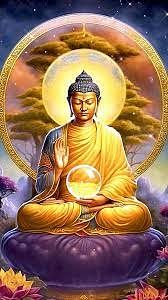 Buddha
Buddha
(i) Born at Lumbini (in present Nepal) in 563 BC as Siddhartha Gautam
(ii) Mother- Maya & father King Suddhodana of Sakyan kingdom under Kshatriya clan.
(iii) Was born on Vaishakhi Purnima.
(iv) Was married to Princess Yashodhara & had a son named Rahul.
(v) At 29, left home with horse Kanthaka & charioteer Channa-> wandered as an ascetic for 6 years-^ went to Gaya (Bihar) & sat under a pipal tree, where he freed himself from all attachments & discovered the truth, the secret of happiness.
(vi) At 35- on his birthday, he attained enlightenment (Nirvana) under that pipal tree & became Buddha, the Enlightened One.
(vii) After attaining Nirvana in Bodh Gaya, his first sermon to his five companions was at Deer Park in Sarnath near Varanasi.
(viii) This event was called Dharma-chakra-pravartana (Turning the Wheel of Law).
(ix) The Three Jewels (Triratna) embraced under Buddhism are:
- Buddha- The enlightened one
- Dhamma- Teachings of Buddha (doctrine)
- Sangha- The monastic order
(x) Sangha (the Order) was initiated by Buddha at the time of giving the first sermon.
(xi) These 5 companions along with Buddha became Sangha (a group).
(xii) Buddha attained Mahaparinirvana at Kushinagar (Malla Mahajanapada) in UP at 80 in 483 BC.
(xiii) Said to be contemporary of King Bimbisara, for a major part of his life & for last few years to Ajatashatru of Haryanka Dynasty
(xiv) He is known for Buddhist texts- Tathagata & Sakyamuni.
(xv) Predecessor of Buddha under Buddhism- Kassapa Buddha & his successor will be Maitreya.
(i) Original Sangha split into two early schools in between 383 BC & 250 BC:
- Sthavira nikaya (sub-sects included Mahisasaka, Sarvastivada, Sankrantika, Sautrantika, Dharmaguptaka, Vatsiputriya, Dharmottariya, Bhadrayaniya, Sannagarika and Sammitiya)
- Mahasamghika (sub-sects included Gokulika, Prajnaptivada, Bahusrutiya, Ekavyaharikas, Caitika)
(ii) Other sub-sects not in the above two schools- Hemavatika, Rajagiriya, Siddhatthaka, Pubbaseliya, Aparaseliya, and Apararajagirika.
(iii) Buddhist schools later included Theravada, Mahayana, Vajrayana, etc.
(i) Four major Noble truths:
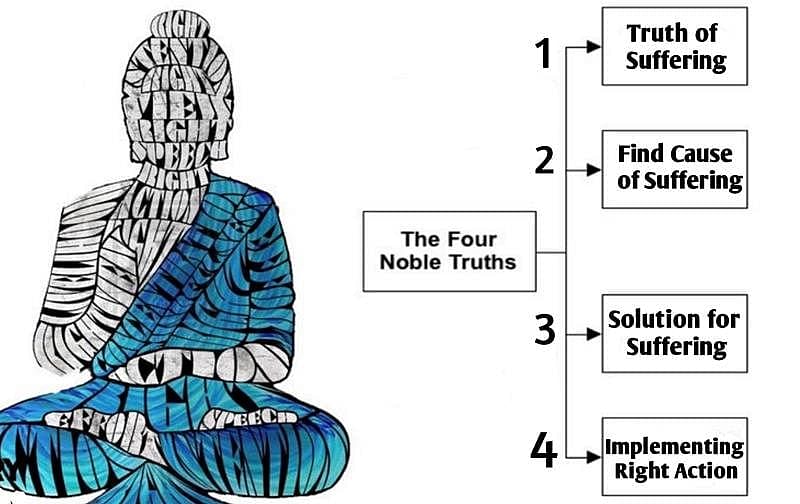
- Truth of suffering (Dukkha)
- Truth of the origin of suffering (Samudaya)
- Truth of the cessation of suffering (Nirodha)
- Truth of path to the cessation of suffering (Magga) i.e., Life is full of suffering (dukkha).
(ii) Desires cause sorrows, which keeps us caught in samsara, the endless cycle of repeated rebirth, dukkha, and dying again.
(iii) ‘Noble Eightfold Path’ includes:
- Kind, truthful & Right Speech
- Honest, peaceful & Right action
- Right livelihood which does not harm any being
- Right effort & cultivating self-control
- Right mindfulness
- Right meditation & concentrating on the meaning of life Right thoughts
- Avoid superstition & cultivate the right understanding.
(iv) Middle Path (Madhyam Marg) or Middle Way- describes the character of the Noble Eightfold Path that leads to liberation.
(v) Buddhism rejects the authenticity of the Vedas and the concept of the existence of Soul (atman) unlike Jainism.
(vi) After Buddha attained Mahaparinirvana at Kushinagar in 483 BC, his teachings were compiled by four Buddhist Councils in the next 500 years to collate this material into Pitakas.
(vii) Three major pitakas- Vinaya, Sutta & Abhidhamma (all combined-Tripitaka)- are written in Pali.
(viii) In the Fourth council of King Kanishka’s reign- Buddhism split into two sects: Hinayana & Mahayana Buddhism Hinayana school declined & two new schools were born.
(ix) Four major schools so far:
- Hinayana Buddhism
- Mahayana Buddhism
- Theravada Buddhism
- Vajrayana Buddhism
(x) Practices of Buddhism- taking refuge in Buddha, Dharma & Sangha, the study of scriptures, observance of moral precepts, renunciation of craving and attachment, the practice of meditation, cultivation of wisdom, loving-kindness & compassion, Mahayana practice of bodhicitta & Vajrayana practices of generation stage and completion stage.
(xi) In Theravada the ultimate goal is the cessation of kleshas & attainment of Nirvana, by practicing Noble Eightfold Path.
(xii) Mahayana- aspires for Buddhahood via the bodhisattva path, a state wherein one remains in a cycle of rebirth.
(i) It means the lesser vehicle.
(ii) Includes followers of the original preaching of Buddha.
(iii) Orthodox school.
(iv) Did not believe in idol or image worship of Buddha but believed in individual salvation through self-discipline & meditation.
(v) Ultimate aim- nirvana.
(vi) Sub-sects: Sthaviravada or Theravada.
(vii) Its scholars used Pali language.
(viii) Emperor Ashoka patronized this school.
(ix) Is almost non-existent in the present age.
 Hinayana and Mahayana Buddhism
Hinayana and Mahayana Buddhism
(i) It means the greater vehicle.
(ii) More liberal & believes in the heavenliness of Buddha and Bodhisattvas embodying Buddha Nature.
(iii) Ultimate goal- “spiritual upliftment.
(iv) Believe in idol or image worship
(v) Bodhisattva- result of Mahayana Buddhism.
(vi) Also called “Bodhisattvayana”, or “Bodhisattva Vehicle.
(vii) Followers believe in Bodhisattva's concept of salvation or in universal liberation from the suffering of all beings.
(viii) Bodhisattva seeks complete enlightenment & one who accomplishes it is called Samyaksambuddha.
(ix) Prominent Mahayana texts- Lotus Sutra, Mahavamsa, etc.
(x) As per Lotus Sutra, Mahayana school believes in six perfections (or paramitas) to be followed by an individual: Dana (generosity), Sila (virtue, morality, discipline, and proper conduct), Ksanti (patience, tolerance, acceptance), Virya (energy, diligence, vigor, effort), Dhyana (one-pointed concentration), Prajna (wisdom and insight)
(xi) Sub-sects: Vajrayana.
(xii) Its scholars predominantly used Sanskrit.
(xiii) Emperor Kanishka (Kushana dynasty) - founder of Mahayana sect in the 1st century AD.
(xiv) Majority of Buddhist followers in the world belong to this sect, (around 53.2% as per the 2010 report).
(xv) Also followed in Nepal, Bangladesh, Japan, Vietnam, Indonesia, Malaysia, Singapore, Mongolia, China, Bhutan, Tibet, etc.
(i) Bodhisattva- generated Bodhicitta (a spontaneous wish & a compassionate mind) to attain Buddhahood.
(ii) Believes in Universal liberation & is a concept under Mahayana Buddhism.
(iii) Jataka tales contemplate that Buddha was Bodhisattva, in his previous births.
(iv) Theravada Buddhism- a person whose aim is to become fully enlightened is still subject to birth, illness, death, sorrow, defilement, and delusion.
(v) On the path to becoming Buddha, a bodhisattva proceeds through ten grounds or bhumis- Great Joy, Stainless, luminous, radiant, very difficult to train, obviously transcendent, gone afar, immovable, good discriminating wisdom & Cloud of Dharma.
(vi) Prominent Boddhisattvas under Buddhism:
(a) Avalokitesvara:
- One of three protective deities around Buddha; holds Lotus & also known as Padmapani and depicted in Ajanta Caves.
- Most acknowledged among all Bodhisattvas.
- Appears unofficially in Theravada Buddhism in Cambodia under the name Lokesvara.
- Depicted as a female & said to incarnate as Dalai Lama.
(b) Vairapani:
- One of three protective deities around Buddha & depicted in Ajanta Caves.
- Manifests all the powers of Buddha & five tathagatas namely Vairocana, Akshobhya, Amitabha, Ratnasambhava & Amoghasiddhi.
(c) Manjusri:
- One of three protective deities around Buddha & depicted in Ajanta Caves.
- Wisdom of Buddha & a male Bodhisattva with a wielding sword.
- Avalokitesvara: Buddha’s compassion, Vajrapani: Buddha’s Power & Manjusri: Buddha’s wisdom.
(d) Samantabhadra: associated with meditation; with Buddha & Manjusri, forms Shakyamuni trinity,
(e) Ksitigarbha: Buddhist monk & vowed not to Buddhahood till the hell is emptied,
(f) Maitreva: A future Buddha; achieve complete enlightenment, & teach the pure dharma. Laughing Buddha- an incarnation
(g) Akasagarbha: element of space.
(h) Tara: associated only with Vajrayana Buddhism & represents virtues of success in work & achievements.
(i) Vasudhara: associated with wealth, prosperity & abundance. Popular in Nepal,
(j) Skanda: Guardian of viharas & Buddhist teachings.
(k) Sitatapatra: A protector against supernatural danger & worshipped in both Mahayana and Vajrayana.
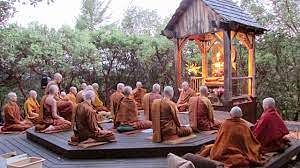
(ii) Uses Buddha’s teaching preserved in Pali.
(iii) Canon (only existing complete Buddhist canon) as its doctrinal core.
(iv) Ultimate goal- cessation of kleshas & attainment of Nirvana,
(v) Kleshas include- states of mind such as anxiety, fear, anger, jealousy, desire, depression, etc.
(vi) Samatha (calming of mind) & Vipassana (insight into three marks of existence: impermanence, suffering, & realization of non-self.)- an integral part of Noble Eightfold Path.
(vii) Believes in the concept of vibhajjavada i.e., “teaching of analysis”.
(viii) Visuddhimagga (Path of Purification)- a treatise on Theravada Buddhist school (by Buddhaghosa in 5th Century AD in Sri Lanka).
(ix) Seven stages of purification (satta-vishuddhi) to be followed under it.
(x) Pali- sacred language of Theravada.
(xi) Successor of Hinayana.
(xii) 35.8% of Buddhists in the world belong to it.
(xiii) Followed in Sri Lanka, Cambodia, Laos, Thailand, Myanmar, etc.
(i) Developed as a result of royal courts sponsoring Buddhism & Shaivism., i.e. influenced by Hinduism.
(ii) Main deity- Tara (a lady)
(iii) Combines Brahmanical (Veda-based) rituals with Buddhist philosophies.
(iv) Based on Mahayana Buddhist philosophy.
(v) Believes in Tantra’s, Mantras & Yantras.
(vi) According to this school, the mantra is an easy path to achieving Buddhahood as compared to Mahayana.
(vii) 5.7 % of the world's Buddhist population follows it.
(viii) Followed in Tibet, Bhutan, Mongolia, Kalmykia, etc.
(i) Kingdoms: Kosala & Magadha Kingdom.
(ii) Places: Kapilavastu, Rajgriha, Vaishali, Gaya, Bodh Gaya, Samath, Kosambi, Shravasti (capital of Kosala Kingdom), Kushinagar, Nalanda, Mathura, Varanasi, Saket, Champapuri, etc.
(iii) Prominent disciples of Buddha: Sariputta - chief disciple; Mahamoggallana - chief disciple; Ananda - listened to Buddha teachings; Mahakasyapa; Purna Maitrayani-putra; Anuruddha: Rahul; Katyayana; Upali; Ananthapindaka; Subhuti; Jivaka.
(iv) Other Prominent personalities:
- Nagasena: Answered questions on Buddhism posed by Menander I (or Milinda), the Indo-Greek king- recorded in the book Milinda Panho around 150 BC.
- Nagarjuna: (150 AD-250 AD) & founder of Madhyamaka school of Mahayana.
- Vasubandhu: Mahayana Buddhism in 4th-5th century AD from Gandhara & wrote from perspectives of Sarvastivada & Sautrantika schools.
- Bodhidharma: 5th or 6th century AD & transmitted Buddhism to China.
- Buddhaghosa: 5th-century; Indian Theravada Buddhist commentator & wrote Visuddhimagga (Path of Purification)
- Padmasambhava: 8th-century monk; called ‘second Buddha’ across Tibet, Nepal, Bhutan, & Himalayan States of India.
- Atisa: Buddhist Bengali religious leader; major figures in 11th-century Mahayana & Vajrayana Buddhism in Asia. Inspired Buddhist thought from Tibet to Sumatra.
- Dalai Lama: Modem spiritual leaders of Yellow Hat school of Tibetan Buddhism.
(i) New branch of Buddhism was propounded by Dr. B.R. Ambedkar.
(ii) Rejects Theravada, Mahayana & Vajrayana school.
(iii) Discards monk & monasticism, karma, rebirth in the afterlife, samsara, meditation, enlightenment & Four Noble Truths
(iv) Radically re-interprets Buddhism by revising the original teachings of Buddha to be about class struggle & social equality.
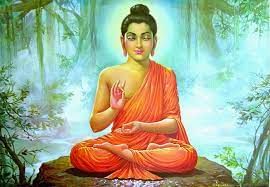
(i) ‘Jain’- derived from jina or Jaina meaning ‘Conqueror’.
(ii) Believe that their religion is comprised of people who have managed to control & conquer their desires.
(iii) Has no founder, instead believes in the teacher who shows the way or a Tirthankara.
(iv) 23 Tirthankaras or great-learned men in Jain religion before Mahavira.
(v) Mahavira- last & 24th tirthankara.
(vi) Like Buddhism, rejects the authority of Vedas.
(vii) Unlike Buddhism, it believes in the existence of the soul (atman) as the core & fundamental focus of Jain philosophy.
(viii) Major Jain pilgrimages- Dilwara temple, Mount Abu (Rajasthan), Palitana temples (Gujarat), Girnar (Gujarat), Shikharji (Jharkhand), and Shravanabelagola (Karnataka).
(ix) The 24 Tirthankaras under Jainism are Rishabhanatha or Adinatha, Ajita, Sambhava, Abhinandana, Sumati, Padmaprabha, Suparshva, Chandraprabha, Suvidhi, Shital, Shreyansa, Vasupujya, Vimala, Ananta, Dharma, Shanti, Kunthu, Ara, Malli, Muni Suvrata, Nami, Nemi, Parshvanatha & Mahavira.
(i) Around 540 BC, Prince Vardhamana was born at Kundalgram in Vaishali to King Siddhartha & Queen Trishala, who ruled the Jnatrika clan.
(ii) At 30 → touching journey → to live the like an ascetic → 10th day of Vaishakha, reached Pava near Patna where he found the truth of life (Kevalya)
(iii) Title ‘Mahavira’ or the great hero was given.
(iv) Other titles- jaina or jitendriya (one who conquers all his senses) & nirgrantha (one who is free from all bonds).
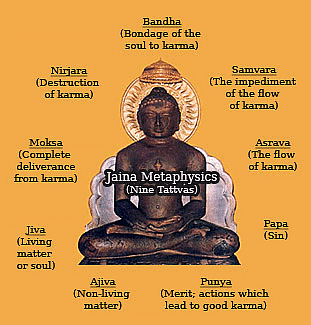
(i) Mahavira taught- the right path or Dharma & stressed renunciation of the world, strict asceticism & moral cultivation.
(ii) Jains- live in such a way so as to not harm any being.
(iii) Anekantavada- the fundamental doctrine of Jainism emphasizes that ultimate truth & reality is complex, and has multiple aspects.
(iv) Hence, non-absolutism, which means no single, specific statement can describe the nature of existence and absolute truth.
(v) Believe in a three-jewel (fold) path of right belief (samyak darshan), right knowledge (samyak jnana), and right conduct (samyak charita).
(vi) Jains follow these five constraints:
- Ahimsa (non-violence); Satya (truthfulness); Asteya (not stealing); Aparigraha (non-acquisition) and Brahmacharya (chaste living).
- The fifth tenet was propounded by Mahavira.
Auspicious symbols under Jainism:
Two Major Schools or Sects under Jainism
Jainism- two major ancient sub-traditions:
- Digambaras [Sub-sects: Mula Sangh (original community) & Terapanthi, Taranpathi and Bispanthi (these three are modem communities)]
- Svetambaras (Sub-sects include Sthanakavasi & Murtipujaka) Several smaller sub-traditions emerged in the 2nd millennium CE.
Digambara School:
(i) Monks do not wear clothes as this sect believes in complete nudity.
(ii) Female monks wear unstitched plain white sarees & are_called Aryikas.
(iii) Follow all the five constraints (Ahirnsa, Satya, Asteya, Aparigraha, and Brahmacharya) as per the teachings of Mahavira, unlike Svetambaras.
(iv) Bhadrabahu (exponent of Digambara)- moved to Karnataka along with his disciples after predicting a long famine.
(v) Earliest record of Digambara beliefs- Prakrit Suttapahuda of Kundakunda.
(vi) Believe that women can’t be Tirthankaras & that Malli was a man.
(vii) Monasticism rules are more rigid under it.
Svetambara School:
(i) Follow preachings of Prasvanatha, i.e. believe in only four restraints (except Brahmacharya) to be followed to attain Kevalya.
(ii) Svetambara believes that the 23rd and 24th Tirthankara did marry, unlike thought by Digambara.
(iii) Sthulabhadra- great exponent of this school & stayed in Magadha, unlike Bhadrabahu who went to Karnataka.
(iv) Monks- simple white clothing, a begging bowl, a brush to remove insects from their path, books & writing materials.
(v) Believe Tirthankaras can be men or women, and say that Malli began her life as a princess.
(vi) Indicates five eternal substances in existence: Soul (jiva), Matter (pudgala), Space (akasha), motion (Dharma), and rest (Adharma), unlike Digambaras which add the sixth eternal substance as time (Kala).
Sub-sects under Digambara and Svetambara Schools
Digambara School: two major sub-sects:
(a) Mula Sangh: original community
(b) Bispanthi, Terapanthi, and Taranpanthi: modem community
Terapanthis vs Bispanthis
Terapanthis
- Worship the idols with ashta-dravya but replace flowers & fruits with dry substitutes.
- Sect opposes Bhattarakas and worships only Tirthankaras.
Bispanthis
- Worship the idols with ashta-dravya.
- Worship Tirthankaras as well as Yaksha & Yakshini like Bhairava and Kshetrapala.
- Religious practices- aarti & offerings of flowers, fruits, and prasad.
- Bhattarakas are their dharma-gurus and they are concentrated in Rajasthan & Gujarat.
Svetambara School: Three sub-sects:
(a) Sthanakavasi: pray to Saints rather than to idol; Saints wear muhapatti near their mouth to cover it, unlike Murtipujaka.
(b) Murtipujaka (Dcravasi): keep idols of Tirthankaras in temples; saints do not wear a muhapatti.
(c) Terapanthi: Pray to saints rather than to an idol like Sthanakavasi. Saints wear a Muhapatti.
Popular Practices under Jainism
- Sallekhana: Practice voluntarily fasting to death by gradually reducing your intake of food & liquids. Not considered suicide by Jain scholars because it is not an act of passion, nor does it deploy poisons or weapons. Can be performed by both Jain ascetics and householders. In 2015, Rajasthan High Court banned it, considering it suicide. Later that year, the Supreme Court of India stayed the decision of the Rajasthan High Court and lifted the ban on Sallekhana.
- Pratikraman: Jains repent for their sins during their daily life, and remind themselves not to repeat them. Five types of Pratikaman- Devasi, Rayi, Pakhi, Chaumasi & Samvatsari.
Buddhism, one of the major world religions, began in India around the sixth century, B.C.E. The teachings of Buddhism spread throughout Central and Southeast Asia, through China, Korea, and Japan. Today, there are Buddhists all over the world.
- Buddhism started in India over 2,600 years ago as a way life that had a potential of transforming a person.
- It is one of the important religions of South and South-Eastern Asian countries.
- The religion is based upon the teachings, life experiences of its founder Siddhartha Gautam, born in circa 563 BCE.
- He was born into royal family of Sakya clan who ruled from Kapilvastu, in Lumbini which is situated near the Indo-Nepal Border.
- At the age of 29, Gautama left home and rejected his life of riches and embraced a lifestyle of asceticism, or extreme self-discipline.
- After 49 consecutive days of meditation, Gautama attained Bodhi (enlightenment) under a pipal tree at Bodhgaya a village in Bihar.
- Buddha gave his first sermon in the village of Sarnath, near the city of Benares in UP. This event is known as Dharma-Chakra-Pravartana (turning of the wheel of law).
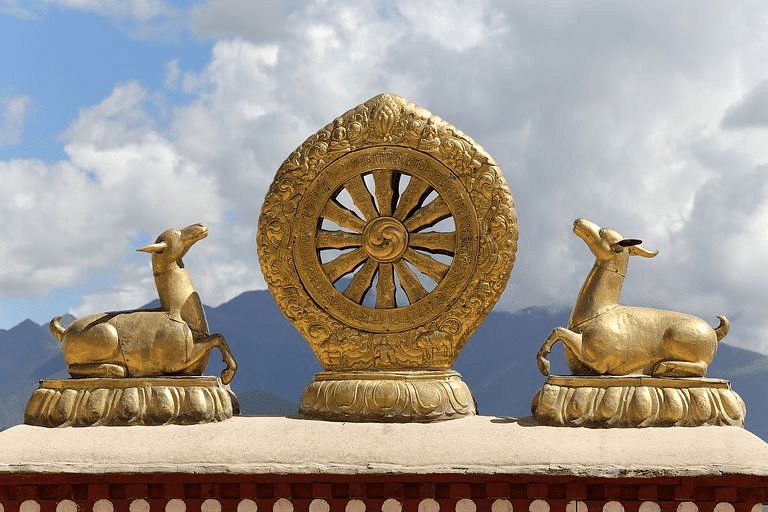 The Dharma Wheel
The Dharma Wheel - He died at the age of 80 in 483 BCE at a place called Kushinagara a town in UP. The event is known as Mahaparinibban.
- Buddha asked his followers to avoid the two extremes of indulgence in worldly pleasure and the practice of strict abstinence and asceticism.
- He ascribed instead the 'Madhyam Marg' or the middle path which was to be followed.
- According to him everyone was responsible for their own happiness in life, stressing upon the individualistic component of Buddhism.
- The main teachings of Buddhism are encapsulated in the basic concept of four noble truths or ariya-sachchani and eightfold path or astangika marg.
- Four noble truths:
1. Suffering (dukkha) is the essence of the world.
2. Every suffering has a cause – Samudya.
3. Suffering could be extinguished – Nirodha.
4. It can be achieved by following the Atthanga Magga (Eight Fold Path).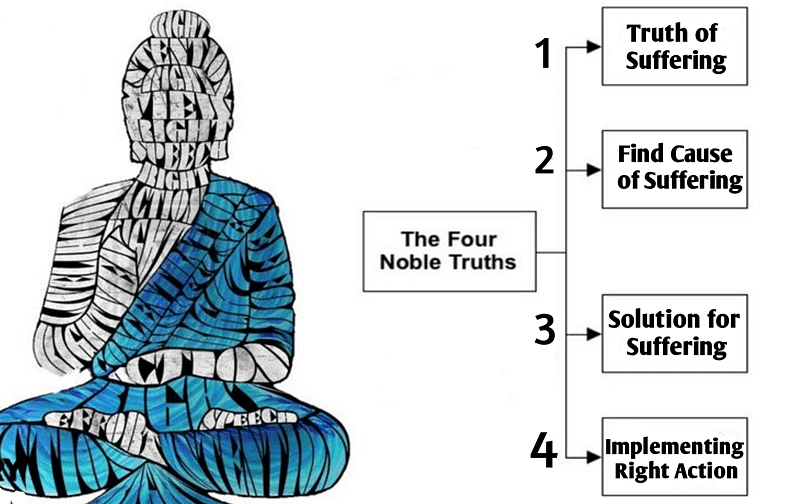
- Eight Fold Paths: the path consists of various interconnected activities related to knowledge, conduct, and meditative practices.
1. Right view
2. Right intention
3. Right speech
4. Right action
5. Right livelihood
6. Right mindfulness
7. Right effort
8. Right concentration - Dukkha and its extinction are central to the Buddha’s doctrine. Suffering is not limited to the actual pain but also to the potential to experience these things.
- The essence of Buddhism is the attainment of enlightenment. It points to a way of life that avoids self-indulgence and self-denial. There is no supreme god or deity in Buddhism.
- The ultimate goal of Buddha’s teaching was the attainment of nibbana which was not a place but an experience, and could be attained in this life.
- Buddha also established code of conduct both for the monastic order and the laymen to follow which are also known as the Five Precepts or Pancasil and refrain from them.
1. Violence
2. stealing
3. sexual misconduct
4. lying or gossip
5. taking intoxicating substances e.g. drugs or drink
- The Buddha's teaching was oral. He taught for 45 years, adapting the teaching to suit the group he was addressing.
- The Sangha memorized the teachings, and there were group recitations at festivals and special occasions.
- The teachings were rehearsed and authenticated at the First Council and were divided in Three Pitakas in 483 BC.
- His teachings were written down around 25 B.C.E. in Pali.
- The Vinaya Pitaka consists of rules of conduct and discipline applicable to the monastic life of the monks and nuns.
- The Sutta Pitaka consists of the main teaching or Dhamma of Buddha. It is divided into five Nikayas or collections:
1. Digha Nikaya
2. Majjhima Nikaya
3. Samyutta Nikaya
4. Anguttara Nikaya
5. Khuddaka Nikaya - The Abhidamma Pitaka is a philosophical analysis and systematization of the teaching and the scholarly activity of the monks.
- Other important Buddhist texts include Divyavadana, Dipavamsa, Mahavamsa, Milind Panha etc.
- Buddhist Councils marked important turning points in the early Buddhism.
- These councils resulted in sectarian clashes and the eventual Great Schism that resulted in the two major schools, Theravada and Mahayana.
- In total, 4 major Buddhist councils were convened:
- It was held soon after the Mahaparinirvan of the Buddha, around 483 BC under the patronage of King Ajatshatru and was presided by Mahakasyapa, a monk.
- The council was held in the Sattapani cave at Rajgriha.
- The council was held with the purpose of preserving Buddha’s teachings (Sutta) and rules for disciples. During this council, the teachings of Buddha were divided into three Pitakas.
- It was held in Vaishali, a village in Bihar under the patronage of the king Kalasoka in 383 BC. It was presided by Sabakami.
- It was held in 250 BC in Patliputra under the patronage of Ashoka and was presided by Moggaliputta Tissa.
- It was held in 72 AD at Kundalvana, Kashmir. It was presided by Vasumitra, while Asvaghosa was his deputy under the patronage of King Kanishka of Kushan Empire.
- Buddhism was divided into two sects namely Mahayan and Hinayan.
- It is one of the two main schools of Buddhism.
- The term Mahayana is a Sanskrit word which literally means "Great Vehicle".
- It believes in the heavenliness of Buddha and Idol worship of Buddha and Bodhisattvas embodying Buddha Nature.
- It originated in northern India and Kashmir and then spread east into Central Asia, East Asia and some areas of Southeast Asia.
- Buddhist schools embedded in China, Korea, Tibet and Japan belong to the Mahayana tradition.
- Literally Lesser vehicle, also known as Abandoned Vehicle or Defective vehicle. It believes in the original teaching of Buddha or Doctrine of elders.
- It does not believe in Idol worship and tries to attain individual salvation through self discipline and meditation.
- Theravada is a Hinayana sect.
- It is the most ancient branch of extant Buddhism today.
- It remains closest to the original teachings of the Buddha.
- Theravada Buddhism developed in Sri Lanka and subsequently spread to the rest of Southeast Asia. It is the dominant form of religion in Cambodia, Laos, Myanmar, Sri Lanka, and Thailand.
- Vajrayana means “The Vehicle of the Thunderbolt”, also known as tantric Buddhism.
- This Buddhist school developed in India around 900 CE.
- It is grounded on esoteric elements and very complex set of rituals compared with the rest of the Buddhist schools.
- It is a school of Mahayana Buddhism that originated in China during the Tang dynasty as the Chan school of Chinese Buddhism in and later developed into various schools.
- It spread to Japan in 7th century C.E.
- Meditation is the most distinctive feature of this Buddhist tradition.
- Buddha had two kinds of disciples – monks (bhikshus) and lay worshippers (upasikas).
- The monks were organized into the Sangha for the purpose of spreading his teachings.
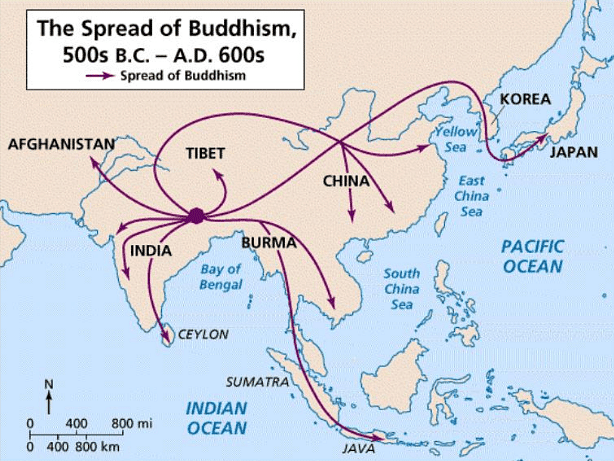
- The Sangha was governed on democratic lines and was empowered to enforce discipline among its members.
- Owing to the organised efforts made by the Sangha, Buddhism made rapid progress in North India even during Buddha’s life time.
- After the death of Buddha, his followers traversed on his path of meditation and roamed throughout the countryside.
- For 200 years Buddhism remained overshadowed by their Hindu counterparts until the advent of Great Mauryan King – Ashoka.
- After the bloodbath in his Kalinga conquest, emperor Ashoka decided to give up the policy of worldly conquest and adopted Dhamma conquest.
- Ashoka during the third Buddhist council dispatched various Buddhist missions to different areas such as Gandhara, Kashmir, Greece, Sri Lanka, Burma (Myanmar), Egypt, and Thailand.
- Through his missionary effort Ashoka spread Buddhism into West Asia and Ceylon. Thus a local religious sect was transformed into a world religion.
Buddhism has made remarkable contribution to the development of Indian culture:
- The concept of ahimsa was its chief contribution. Later, it became one of the cherished values of our nation.
- Its contribution to the art and architecture of India was notable. The stupas at Sanchi, Bharhut and Gaya are wonderful pieces of architecture.
- It promoted education through residential universities like those at Taxila, Nalanda and Vikramasila.
- The language of Pali and other local languages developed through the teachings of Buddhism.
- It had also promoted the spread of Indian culture to other parts of Asia.
- Buddhism in India as a Soft Power is different from the conventional sense of the term. India talks about shared cultural development instead of export of culture.
- The values of peace, accommodation, inclusiveness, and compassion that are part of our societies can be attributed to the influence of the teachings of Lord Buddha and Buddhism.
- The ideals of Buddhism continue to intersect with the political and economic contexts of many Asian nations with 22% of the world’s population.
- Buddhism can act as an intensifying factor for Asian emotional bonding and connectivity as it is embedded into their “nationalistic” thinking and actions.
- Buddhism is not restricted to Asia and has been able to generate a spiritual awakening elsewhere in the world and influenced a stream of philosophical traditions world over.
- India has in its favour at the moment abundance of resources by way of pilgrimage sites, the presence of the Dalai Lama, and international goodwill, as well as the right intentions.
- Effective revitalisation of the Nalanda University project and encouragement of Buddhist studies in well-established universities will bring International community at a common platform.
- The promotion of Buddhist tourism reminiscent of the ‘Incredible India’ campaign is required to popularise India’s association with the faith internationally.
- The government faces the crucial challenge of effective execution. Buddhist diplomacy would go a long way in countering the rise of China, strengthening its relations with Asian countries, and helping it further down the path of its regional and global power ambitions.
- Buddhism and Jainism are two Indian religions that developed in Magadha (Bihar) and continue to thrive in the modern age. This comparative study of Mahavira and Gautama Buddha are generally accepted as contemporaries.

- Buddhism and Jainism are ancient religions that developed during the days of Ancient India. Buddhism is based on the teachings of Gautama Buddha, while Jainism is based on the teachings of Mahavira.
- Apart from this, there are many similarities between Buddhism and Jainism on grounds of terminology and ethical principles, but the way they are applied is different.
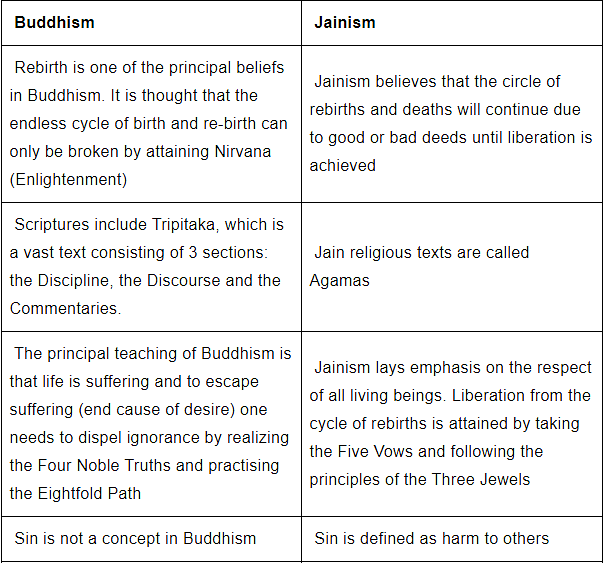
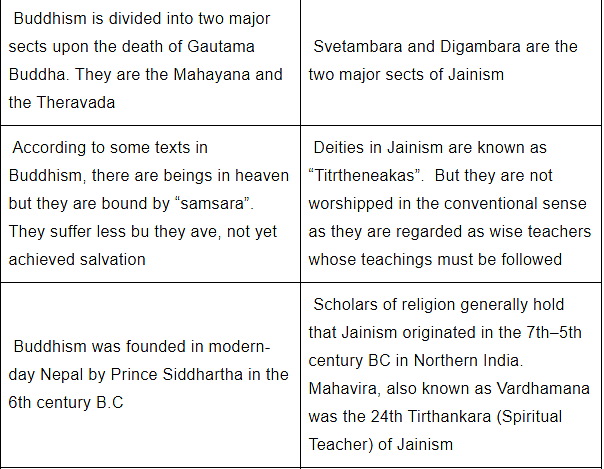

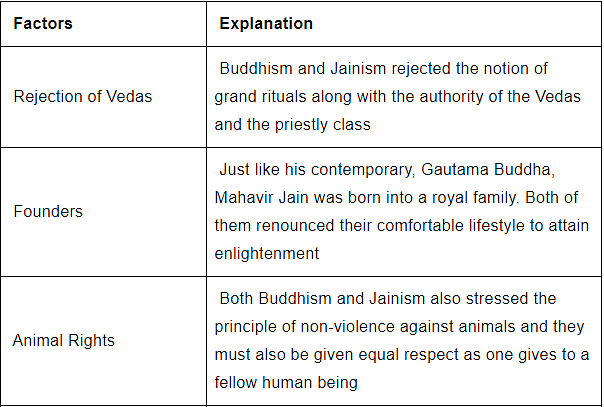

The Mauryan Empire:
The Maurya Empire was a geographically extensive Iron Age historical power based in Magadha and founded by Chandragupta Maurya, which dominated the Indian subcontinent between 322 and 185 BCE. Comprising the majority of South Asia, the Maurya Empire was centralized by the conquest of the Indo-Gangetic Plain, and its capital city was located at Pataliputra (modern Patna). The empire was the largest political entity that has existed in the Indian subcontinent, extending over 5 million square kilometers (1.9 million square miles) at its zenith under Ashoka
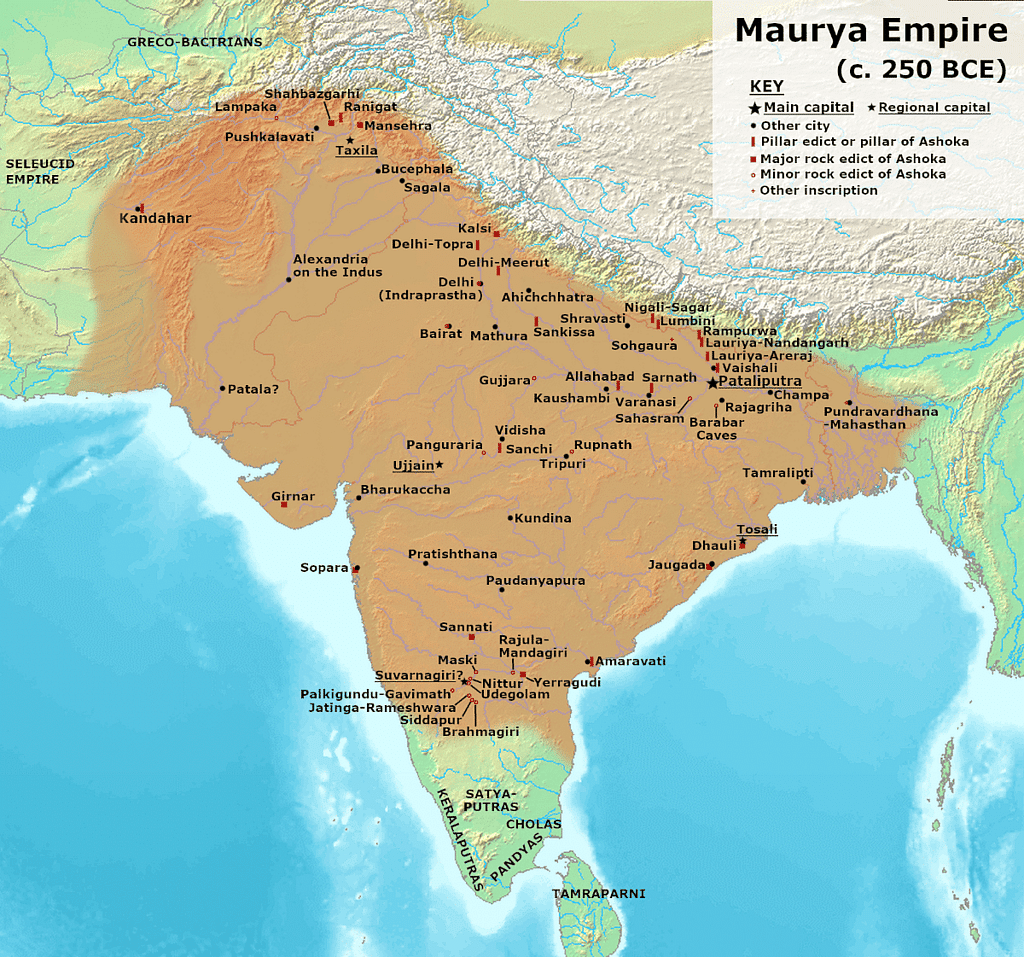 Mauryan Empire
Mauryan Empire
- Prior to the Maurya Empire, the Nanda Empire ruled over most of the Indian Subcontinent. The Nanda Empire was a large, militaristic, and economically powerful empire due to conquering the Mahajanapadas.
- According to several legends, Chanakya travelled to Pataliputra, Magadha, the capital of the Nanda Empire where Chanakya worked for the Nandas as a minister.
- However, Chanakya was insulted by the Emperor Dhana Nanda, of the Nanda dynasty and Chanakya swore revenge and vowed to destroy the Nanda Empire.
- He had to flee in order to save his life and went to Taxila, a notable center of learning, to work as a teacher.
- On one of his travels, Chanakya witnessed some young men playing a rural game practicing a pitched battle. He was impressed by the young Chandragupta and saw royal qualities in him as someone fit to rule.
- The last of the Nanda rulers, Dhana Nanda was highly unpopular due to his oppressive tax regime.
- Also, post-Alexander’s invasion of North-Western India, that region faced a lot of unrest from foreign powers. They were ruled by Indo-Greek rulers.
- Chandragupta, with the help of an intelligent and politically astute Brahmin, Kautilya usurped the throne by defeating Dhana Nanda in 321 BC.
Though the Mauryan Dynasty had several rulers only 3 among them are famous and important in exam point of view. They are;
- Chandragupta Maurya (322-298 BCE)
- Bindusara (298-272 BCE)
- Ashoka (268-232 BCE)

- The beginnings of Chandragupta are shrouded in mystery.
- The Greek texts (the earliest) identify him as being of non-warrior ancestry.
- According to Hindu texts, he was a Kautilya disciple of lowly origin (probably born to a Shudra woman). According to most Buddhist texts, he was a Kshatriya.
- It is often assumed that he was an orphaned youngster from a poor home who was tutored by Kautilya.
- Sandrokottos is the name given to him in Greek records.
- Alexander abandoned his invasion of India in 324 BC, and within a year, Chandragupta had beaten several of the Greek-ruled towns in the country's northwestern region.
- Kautilya devised the approach, which Chandragupta carried out. They had formed their own mercenary army.
- They then proceeded eastward towards Magadha.
- In around 321 BC, he destroyed Dhana Nanda in a series of conflicts, laying the groundwork for the Maurya Empire.
- In 305 BC, he signed a deal with Seleucus Nicator in which he obtained Balochistan, eastern Afghanistan, and the land west of the Indus. He also married the daughter of Seleucus Nicator.
- With the exception of a few locations like Kalinga and the far south, Chandragupta spearheaded an expansionist programme that brought practically the whole present-day India under his rule.
- From 321 BC until 297 BC, he ruled.
- He abdicated in favour of his son, Bindusara, and travelled to Karnataka with the Jain monk Bhadrabahu.
- He had converted to Jainism and is claimed to have starved himself to death in Shravanabelagola according to Jain legend.
 Chandragupta Maurya
Chandragupta Maurya
- Bindusara was the son of Chandragupta, the Mauryan Empire's founder. Several texts, including the Puranas and the Mahavamsa, attest to this.
- Throughout his term, Chanakya served as Prime Minister.
- Bindusara maintains cordial diplomatic relations with Greece. Deimachus was the Seleucid emperor Antiochus I's envoy to Bindusara's court.
- Bindusara, unlike his father Chandragupta (who eventually converted to Jainism), belonged to the Ajivika sect. Bindusara's master, Pingalavatsa (Janasana), was an Ajivika Brahmin.
- Bindusara died around the 270s BCE, according to historical sources.
- Bindusara is credited for extending the Mauryan Empire to Mysore.
- He united sixteen nations into the Mauryan Empire, conquering nearly the whole Indian peninsula.
 Kautilya
Kautilya
- Chandragupta Maurya's teacher and Chief Minister.
- He was a Taxila teacher and scholar. Vishnugupta and Chanakya are two more names.
- He was also a minister in Bindusara's palace.
- He is recognised as being the main planner behind the Nanda throne usurpation and the development of the Mauryan Empire via his disciple, Chandragupta.
- Arthashastra is a book on statecraft, economics, and military strategy that he composed.
- The work is divided into 15 volumes and 180 chapters. The major concept is divided into three sections:
- King, Ministerial Council, and Government Departments.
- Criminal and civil law.
- War diplomacy
- It also includes information on commerce and markets, a mechanism for screening ministers and spies, royal responsibilities, ethics, social welfare, agriculture, mining, metallurgy, medicine, and forests, among other things.
- Chanakya is often known as the "Indian Machiavelli."

- Son of Mauryan Emperor Bindusara and Subhadrangi. Chandragupta Maurya's grandson.
- His other names were Devanampiya (Sanskrit Devanampriya, which means Beloved of the Gods) and Piyadasi.
- One of India's greatest monarchs.
- He was born in 304 BC.
- His rule lasted from 268 BC until 232 BC, when he died.
- As a young prince, Ashoka was a superb commander who suppressed revolts in Ujjain and Takshashila.
- As emperor, he was ambitious and aggressive, re-establishing the Empire's supremacy in southern and western India. But it was his conquest of Kalinga (262–261 BCE) that proved to be the defining event of his life.
- He became a Buddhist. A Buddhist monk named Moggaliputta Tissa became his guru.
- In 247 BC, Ashoka presided over the third Buddhist Council in Pataliputra, which was presided over by Moggaliputta Tissa.
- Ashoka was not the eldest son of Bindusara and so was not the heir presumptive.
- Bindusara wanted his elder son Susima to be crowned the next king.
- But Ashoka was trained in military and weapons and showed great skills as an administrator when he was made the governor of Ujjain.
- In the war of succession that followed Bindusara’s death in 272 BC, Ashoka emerged victorious aided by his father’s ministers.
- When he became the king, he was said to be bad-tempered, ruthless and very cruel.
- He even built a torture chamber to torture his prisoners to death. This earned him the moniker Chandashoka (cruel Ashoka).
- Once he became the king, he started expanding his empire by conquest. In the ninth year of his reign, he waged a war with Kalinga (in present-day Odisha).
- The battle with Kalinga fought in 265 BC was personally led by Ashoka and he was able to vanquish the Kalingas.
- Whole cities were destroyed and more than a hundred thousand people were killed in the war.
- The horrors of war disturbed him so much that he decided to shun violence for the rest of his life and turned to Buddhism.
- Ashoka’s 13th Rock Edict describes the Kalinga war vividly.
- He now became Dharmashoka (the pious Ashoka) from Chandashoka.
- In about 263 BC Ashoka converted to Buddhism. Moggaliputta Tissa, a Buddhist monk became his mentor.
- Ashoka even conducted the third Buddhist Council at Pataliputra in 250 BC under Moggaliputta Tissa’s presidency.

- Ashoka established the idea of paternal kinship.
- He regarded all his subjects as his children and believed it the king’s duty to look after the welfare of the subjects.
- Through his edicts, he said everybody should serve parents, revere teachers, and practice ahimsa and truthfulness.
- He asked everyone to avoid animal slaughter and sacrifice.
- He expounded on the humane treatment of animals, servants, and prisoners.
- He advocated tolerance towards all religions.
- He sought conquest through Dhamma and not war.
- He sent missions abroad to spread the word of the Buddha. Notably, he sent his son Mahinda and daughter Sanghamitra to Sri Lanka.
- Most of his edicts are written in Pali and Prakrit in Brahmi script. Some are written in the Kharoshti and Aramaic scripts also. There are some edicts written in Greek as well. The language depends on the location of the pillar.
- Sources of information about Ashoka.
- There are two main sources: Buddhist sources and Ashoka’s edicts.
- James Prinsep, a British antiquary and colonial administrator was the first person to decipher Ashoka’s edicts.
- Ashokavadana (Sanskrit) written in the second century AD, Dipavamsa and Mahavamsa (Sri Lankan Pali chronicles) give most of the information about Ashoka.
Brahmanism is considered to be the predecessor of Hinduism. Brahmanism is the central theme and belief of Vedic followers, its thoughts and philosophical concept give rise to the primary and socio-religious belief and conduct in Hinduism.
- The Rig Veda indicates the nature of the religious beliefs and practices of the Aryans in India.
- Aryans believed in many gods like Indra, Varuna, Agni, Surya and Rudra.
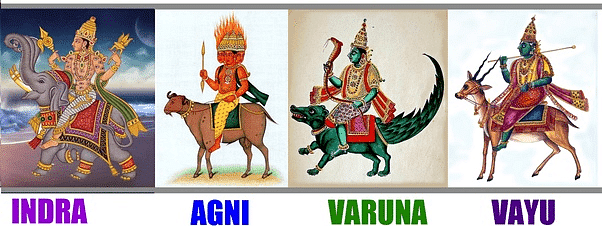
- Sacrifices, ritual offering of oblations of food, meat and drink to fire in honour of the gods, constituted the main religious practice.
- The Aranyaka and Upanisad sections of the Vedic literature envisage a progressive outlook.
- The former group of texts usually deal with the interpretative aspect of the sacrificial act, while the latter, especially some of the major Upanishads are concerned first with pantheism and then with theism centred on one eternally existing absolute entity, brahman or atman, also known by several other names.
- The final evolution of the Vedic religion or religion of the Aryans took place in these later Vedic texts and the institutional form of the Vedic religion came to be known as Brahmanism.
Historically, Bhagavatism corresponds to the development of a popular theistic movement in India, departing from the elitist sacrificial rites of Vedism or Brahmanism.
- Almost simultaneously with the appearance of religions of non-theistic nature, creeds of a definitely theistic character came to be evolved.
- The central figures around which they grew up were not primarily Vedic deities but came from unorthodox sources.
- Pre-Vedic and post-Vedic folk elements were most conspicuous in their origin. There were also some semi-historical personages at the focal points of the movements.
- The important factor that activated these movements, was Bhakti, the single-souled devotion of the worshipper to a personal God with the postulation of some moral link.
- This stimulus led to the evolution of different religious sects like Bhagavatism, Saivism and Saktism
- It had a significant impact in course of time on the popular forms of Buddhism and Jainism.
- Bhagavatism was a marked departure from Brahmanism because the abstract idea of a universal soul of the Upanishads was substituted by a personal God who was not to be worshipped by Brahmanic mode of worship but by bhakti or devotion.
- The fundamental principles which Brahmanism taught were too dogmatic, orthodox, ritualistic, formal and too rigid to be pursued.
- The people, who were always in need of an ethical and emotional cult in which it was possible to find both satisfaction of the heart and moral guidance understood nothing of it. It was in these circumstances that Bhagavatism found a favourable atmosphere.
- There was the need for a popular hero who could be made the rallying centre to counter-act the mighty influence of the heterodox or heretical sects which challenged Brahmanism in the 6th century B.C.
- There was also the need for the absorption or assimilation of new ethnic groups, tribal groups and foreigners and bringing back of those, if possible, who was then known as sramanas, sanyasin, parivrajaka or yogi into the Aryan fold.
- Bhagavatism had four different stages in its growth
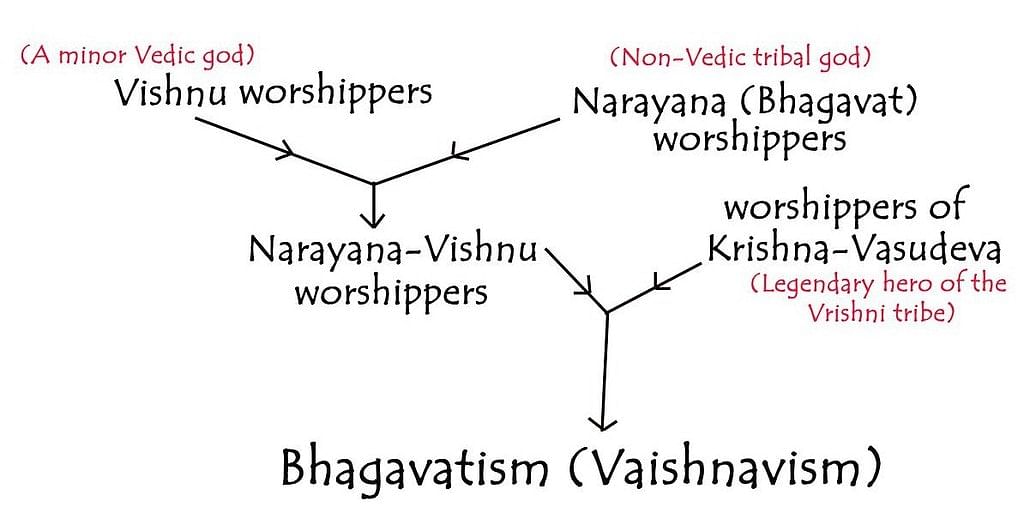 Flow Chart showing growth of Bhagavatism
Flow Chart showing growth of Bhagavatism
- The central features of this stage, which continued till 300 B.C. are the founding of a popular monotheism of Krishna-Vasudeva, its alliance with Sankhya-Yoga, the deification of the founder of the religion, and a deep religious sentiment on the basis of bhakti.
- The Brahmanising of the religion, the identification of Krishna with Vishnu, and the pre-eminence of Vishnu, as not merely a great God but as the greatest of them all, belong to the second stage.
- The third stage is the transformation of the Bhagavata religion into Vaishnavism and the incorporation of the elements of the philosophical schools of the Vedanta, the Samkhya and the Yoga. This process took place from the Christian era till A.D. 1200.
- The philosophic systematisation attempted by the great theologians Ramanuja was the last stage.
- A sutra in Panini’s Astadhyayi refers to the worshippers of Vasudeva whom epic and puranic traditions describe as a hero of the Sattvata race.
- The Chandogya Upanishad speaks of Krishna, the son of Devaki, a pupil of the sage Ghora Angirasa, who was a sun-worshipper priest.
- Vasudeva-Krishna appears to have played the most dynamic role in the great Kurukshetra war, and helped in the establishment of righteousness after the destruction of impiety.
- The large number of people who worshipped him exclusively as their personal God were at first known as Bhagavatas.
Origin of Bhagavatism
- Bhagavatism began in the times of Post – the Maurya phase
- Bhagavatism revolved around the worship of Bhagavata or Vishnu
- Through the second century BC, Vishnu was merged with a God whose name was Narayana. These Gods were known as Narayana-Vishnu
- The worshippers of Vishnu and Narayana came under the same category as Vishnu and Narayana got merged
- Vishnu was known as a Vedic God. On the other hand, Narayana was associated with Non-Vedic culture. Hence, both the Gods were brought together and merged
- Bhagavatism was considered by two terms, namely Bhakti and Ahimsa
- Bhakti is defined as the offer of devotion. Ahima is defined as the principle of non-killing
- Devotees used to worship the picture of Vishnu and offered it sesamum, etc
Quick facts on Bhagavatism
- Bhagavad Gita consists of 3 ways to attain salvation. These 3 paths are Gyan (knowledge), Karma (action), and Bhakti (devotion). Gyan refers to the realization that each soul is a section of the Universe. Karma is the good deed done by an individual. Bhakti is defined as the worship of Gods.
- Bhagavatism does not have faith in killing animals. Neither does Bhagavatism believe in the sacrifice of an animal or any other sacrifice.
- Bhagavatism has also tended to influence Buddhism and Jainism.
- Within Bhagavad Gita, Krishna taught that even vaishyas, women, and Shudras who were provided birth of sin could attain refuge in him.
- In Hinduism, the worship of idols became a common feature from the Gupta period.
The Shrimad Bhagavad Gita, often referred to as the Gita, is a 700-verse Hindu scripture that is part of the epic Mahabharata, dated to the first millennium BCE. It is considered to be one of the main holy scriptures for Hinduism
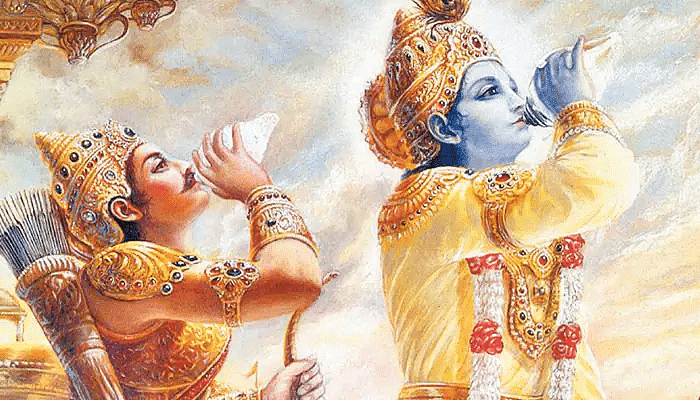
- Bhagavadgita is the most popular treatise of Bhagavatism.
- According to it, knowledge, action and devotion are the three paths that lead one to attain salvation or Nirvana.
- The knowledge or gyana is the realisation by an individual that every soul is a part of the universal soul (parmatma).
- Nobody can touch or perish a soul, soul never dies and the soul neither feels pleasure nor pain.
- Ignorance is more spiritual blindness than an intellectual weakness that can be removed by karma yoga.
- The Gita suggest karma-marga as an easier alternative to attain salvation.
- To regard oneself as the doer of actions and aspiring for their results is Maya (illusion) which is the greatest obstruction in the attainment of Salvation by an individual.
- The social aim of this doctrine is to contribute individual’s share in the improvement of society.
- According to Gita, the easiest path to attain salvation by an individual is bhakti or devotion to God.
- Gita preaches that God gives the next life to an individual according to one’s karmas or action in this life.
- God takes birth when necessary: “whenever dharma (piety) waves and adharma (unrighteousness) spreads in the world, I take birth”.
The Indian version of the ‘Trinity’ came to be known as the Trimurti. It includes the Gods Brahma, Vishnu and Shiva.
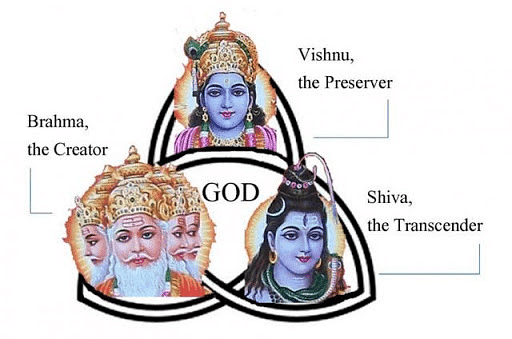
- The first of these, Brahma was incorporated from the Vedic pantheon, in the later religion, he came to be regarded as an expression of the actual of creation, rather than as a separate God in his own right. Each of the three Gods reflected as it were the world as a whole.
- The followers of Vishnu referred to him not only as of the custodian of the universe but also as its creator and destroyer.
- The main divinity, Vishnu, appears in the early texts under the name Narayana, who would appear to be the deity worshipped by the native tribes of northern India.
- In the texts of the Brahmanas, he is regarded as the mighty god and is even on occasion placed higher than the later Vedic god Prajapati, “the creator of the universe.”
- Actually, the idea of Bhakti or devotion to God which is primary to Bhagvatism started with the Upanishad’s idea of worship.
- The truly unique capacity of this branch of Hinduism to assimilate various local belief and ceremonies of worship are the causes of its enormous popularity in India.
- The concept of vyaha and avatars helped a lot in that process.
- The evidence of the notion vyuha is that the all-powerful God Narayana-Vishnu consistently reveals himself in four different forms; this led to the incorporation of several popular social gods within the concept of Vishnu.
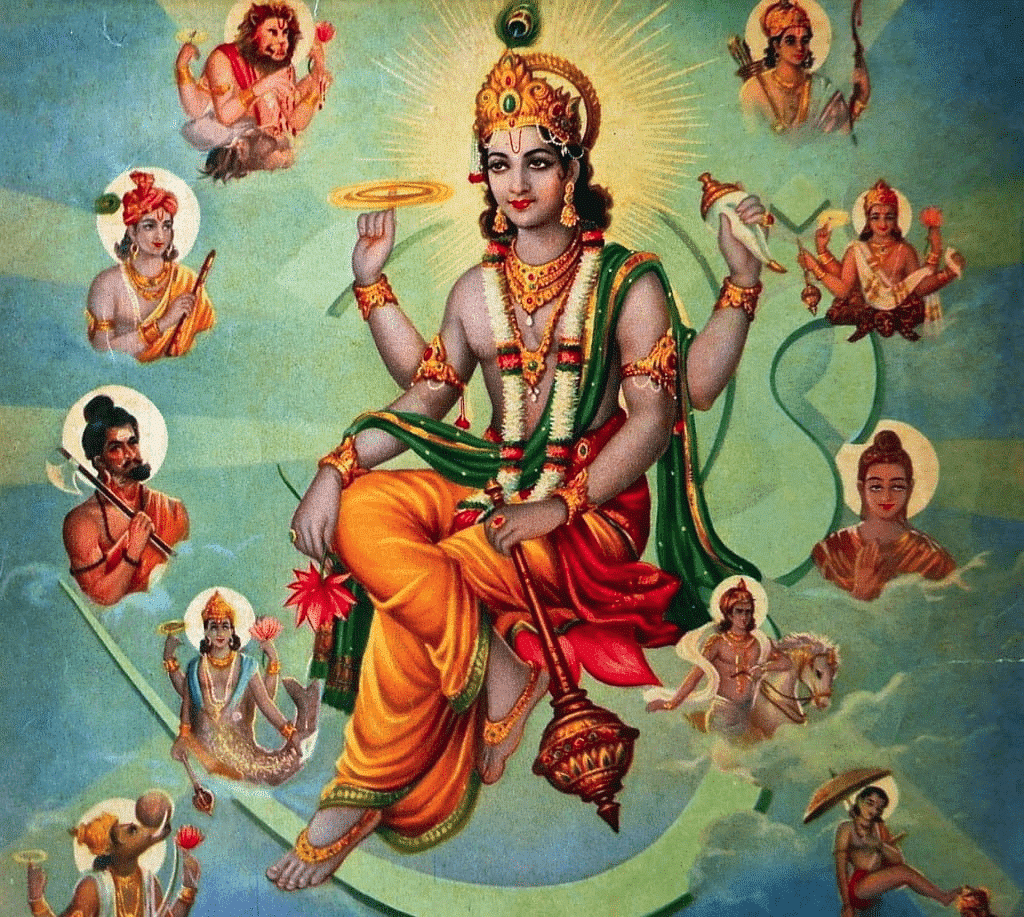 Vaishnava traditions center around Hindu god Vishnu (centre) and his avatars
Vaishnava traditions center around Hindu god Vishnu (centre) and his avatars
- Among these divinities was the figure of Vasudeva who became almost more important in later Vaishnavite literature than Narayana himself.
- The worship of Vasudeva, and later of Vishnu came to embrace veneration of Sankarshana to whom farming tribes paid homage.
- Another divinity Krishna who soon became popular was also incorporated in Vaishnavism.
- The spread of Vasudeva worship in the early Mauryan period is testified by the record of Magasthenes.
- Vasudeva is described by Magasthenes as a heroic warrior and vanquisher of demons.
- The worship of Vasudeva, according to Indian sources, was particularly popular in Mathura.
- It can be assumed that the Greek writer was depicting that period of early Vaishnavism when Vasudeva was already deified but not yet equated with the figure of Krishna.
- In the famous Helieodorous inscription of Besnagar (2nd Century B.C.) there is a mention of reverence of the ‘God of Gods’ Vasudeva and to judge by this inscription, the worship of Vasudeva was widespread not merely among Indians, but also among the Greeks inhabiting north-western India.
- On the basis of other epigraphic evidence (1st century B.C.), it can be concluded that the cults of Vishnu, Narayana and Vasudeva merged together as one at about that time.
- In the early centuries, A.D. temples were already being made to the deities (Vishnu, Krishna etc), a characteristic feature of medieval Hinduism.
- There is a reference for example to the temples built in honour of Sankarshana in the Arthashastra.
The Gupta Period:Trade, Art & Culture, Economic Development
The Gupta period in Indian history is termed as the Golden Age of India. During the Gupta dynasty, industry and trade were generally prosperous.
- The Gupta Empire was a prehistoric Indian empire from the early fourth century CE to the late sixth century CE. The Indian subcontinent was mostly covered during its height, between 319 and 467 CE.
- Founded by Sri Gupta, It extends through the reigns of Chandragupta I, Samudragupta, Chandragupta II, Vikramaditya, Kumaragupta, and Skandagupta. The Gupta dynasty continued its existence after the death of Skandagupta.
- Peace and order helped the expansion of trade and commerce both on land and overseas. Foreign trade was in balance. The decline of Roman trade was the most significant change in international trade
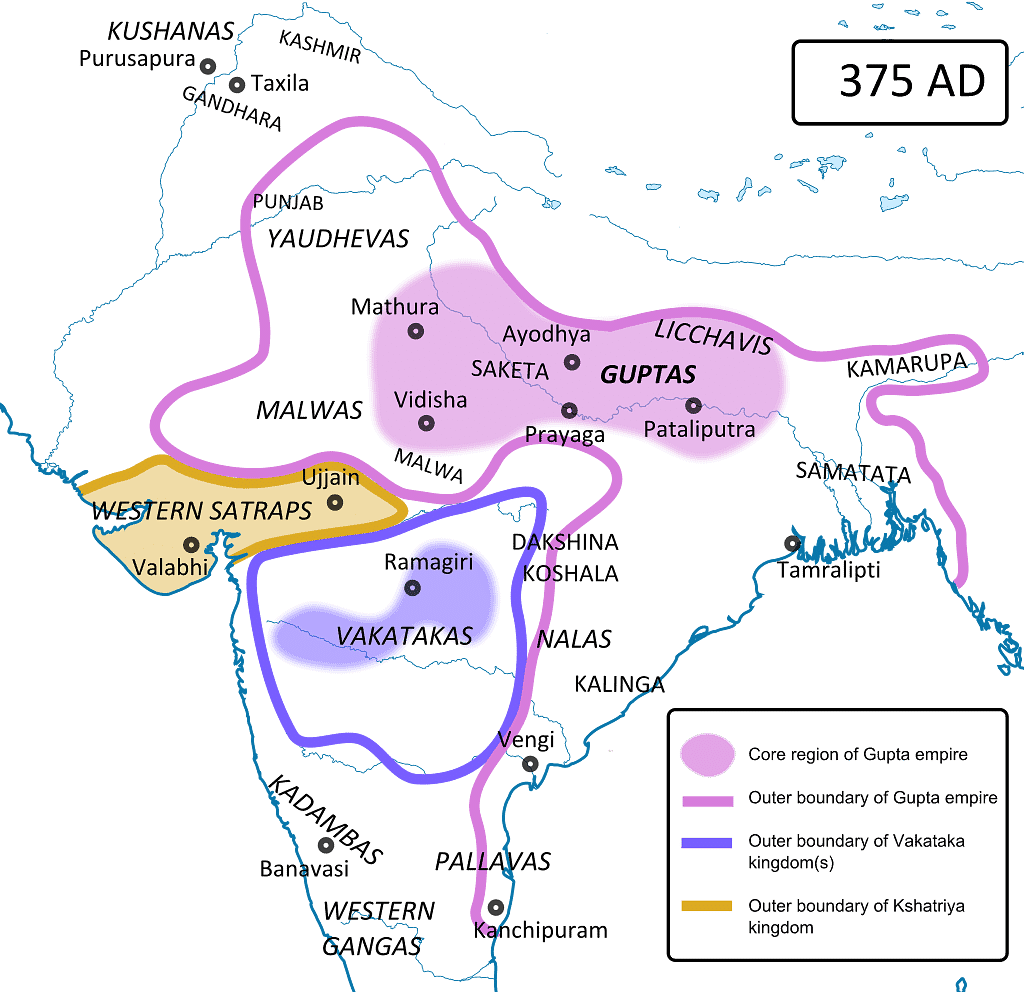 Approximate extent of the Gupta territories (pink)
Approximate extent of the Gupta territories (pink)
- An idea of the economic life of the people of Gupta times can be taken from Fa-Hien, who visited different parts of the Gupta empire. Among other things, he informs us that Magadh was full of cities and its rich people supported Buddhism and gave charities.
In ancient India. The guptas issued the largest number of gold coins which were called dinars in their inscriptions. Regular in size and weight, they appear in many types and subtypes.
- They clearly portray Gupta kings, indicating the latter's love for war and art. Although in gold content these coins are not as pure as Kushan ones.
- They not only served to pay the officers in the army and administration but also to meet the needs of the sale and purchase of land.
- After the conquest of Gujarat, the guptas issued a good number of silver coins mainly for local exchange, in which silver occupied an important position under the Western Kshatrapas.
- In contrast to those of the Kushans, the Gupta copper coins are very few. This would suggest that the use of money did not touch the common people so much as it did under the Kushans.
 Coins of Gupta Period
Coins of Gupta Period - Compared to the earlier period we notice a decline in long-distance trade. Till 550AD India carried on some trade with the eastern Roman Empire to which it exported silk.
- Around AD 550 the people of the eastern Roman Empire learned from the Chinese the art of growing silk, which adversely affected the export of India. Even before the middle of the 6th century, the demand for Indian silk abroad had slackened.
- In the middle of the 5th century, a guide of silk weavers left their original home in western India in the country of Lata in Gujarat and migrated to Mundus Mandasor, where they gave up the original occupation and took to other professions.
- The striking development of the Gupta period, especially in Madhya Pradesh, was the emergence of priestly landlords at the cost of local peasants. Land grants made to the priest certainly bought many virgin areas under cultivation.
- But these beneficiaries were imposed from above on the local tribal peasants, who were reduced to a lower status. In central and western India the peasants were also subjected to forced labor.
- On the other hand, a good deal of virgin land was brought under cultivation and better knowledge of agriculture seems to have been introduced by the brahmana beneficiaries in the tribal area of central India.
Both internal and foreign trade flourished during this period. Trade was carried on both by land and sea. The main articles of internal trade were cloth, food grains, spices, salt, bullion, and precious stones.
- The trade was carried on by road and through rivers. Important cities and ports of the Gupta period were Broach, Ujjayini, Visa, Prayag, Banaras, Gaya, Pataliputra, Vaishali, Tamralipti, Kausambhi, Mathura, Peshawar, etc which were well connected by public highways and the state arranged all facilities and security for the travelers and traders.
 Gupta Empire Trade
Gupta Empire Trade
- Rich riverine traffic was carried along the Ganges, Brahmaputra, Narmada, Godavari, Krishna, and Kaveri. Tamralipti, Kavripatnam, Kalyan, Broach, and Cambay were the principal ports of South, Deccan, and Gujarat.
- A brisk trade was carried on with countries of Southeast Asia, China, Rome in the west, India exported pearls, precious stones, cloth, perfumes, spices, indigo, drugs, coconuts, and ivory articles while its main items of import were gold, silver, tin, lead, silk, and horses.
- As trade and industry developed, there were many economic activities within the Gupta empire. The traders and merchants played a huge role in the economy of the country.
- The sources of Gupta’s period mentioned the existence of guilds. A guild is a community of traders, merchants, workers, and artisans. Each guild has its own laws, its own chief who would look after the activities of the groups of traders, merchants, workers, and artisans.
- This long-run efficient rule of the Guptas not only touched upon but also brought out many changes in the political, social as well as cultural spheres.
Agriculture thrived during the Gupta period as a result of the establishment of irrigation works.
- Aside from the state and individual cultivators, Brahmins, Buddhists, and Jain sanghas cultivated wastelands when they were given to them as religious endowments.
- Cultivators were asked to protect their crops from damage, and those who damaged the crops were punished. Crops and fields were also fenced.
- Rice, wheat, barley, peas, lentils, pulses, sugarcane, and oil seeds were among the crops grown during the Gupta era.
- According to Kalidasa, the south was famous for pepper and cardamom. Varahamihira provides detailed advice on fruit tree planting.
- According to the Paharpur copper plate inscription, the king was the sole owner of the land. Even when he granted land, he reserved his rights to it.
- The record keepers and influential men in the area marked out and measured the location and boundaries of individual plots.
- According to the Paharpur plates, an officer known as ustapala kept records of all land transactions in the district, and the village accountant kept records of land in the village.
The Pre-Gupta and Gupta period was the most flourishing period in the history of India.
- We do not come across so many kinds of artisans in the earlier texts as are mentioned in the writings of this period.
- The Digha Nikaya, which belongs to pre-Maurya times, mentioned about two dozens occupations, but the Milinda Panho, which belong to this period, enumerates as many as 75 occupations.
- Eight crafts were associated with the working of gold, silver, lead, tin, copper, brass, iron, and precious stones or jewels.
- Technological knowledge about the work of iron had made great progress. Iron artifacts have been discovered in greater numbers in Kushan and Satavahana layers at various excavated sites.
- But the Telangana region of Andhra seems to have made special progress in iron manufacture.
- Cloth making, silk weaving, and the making of arms and luxury articles also made progress. Mathura was a great center for the manufacture of a special type of cloth which was called sataka.
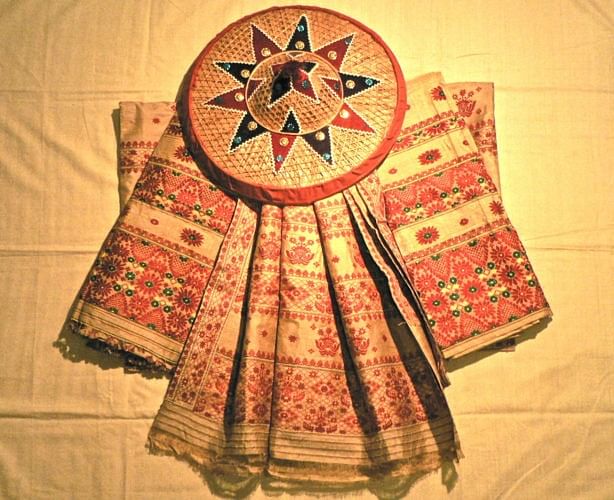 Silk in Gupta Period
Silk in Gupta Period
- The manufacture of oil increased because of the use of the oil wheel.
- The inscriptions of the period mention weavers, goldsmiths, dyers, workers in metal and ivory, jewelers, sculptors, smiths, and perfumers as constructors of caves and donors of pillars, tablets, etc. to the Buddhist monks.
- Coin-minting was an important craft, and the period is noted for numerous types of coins made of gold, silver, copper, bronze, lead, and tin.
- The craftsman also made fake Roman coins. Various coin-molds belonging to the period have been found both in north India and in Deccan.
- A coin-mold from the Satavahana level shows that through it half a dozen coins could be turned out at a time.
- These urban handicrafts were supplemented by the manufacture of beautiful pieces of terracotta, which are found in profuse qualities.
- Terracottas were meant mostly for use of the upper classes in towns. With the decline of town in Gupta, and especially in post-Gupta times, such terracottas almost went out of fashion.
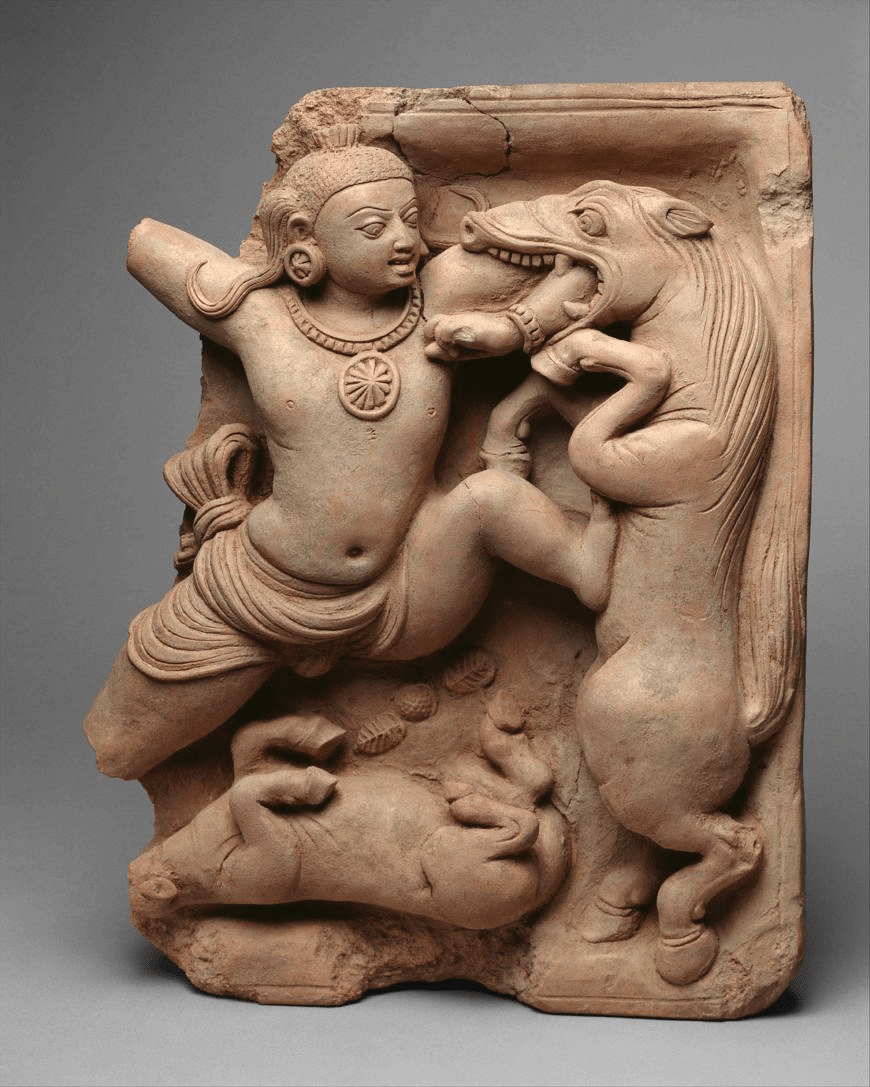 An Artifact of terracotta during the Gupta Age
An Artifact of terracotta during the Gupta Age
- The Satavahana inscriptions show that there were in western India at that time guilds that acted as banks.
- One inscription states that an oil-pressers guild (Tailikanikaya) received two amounts of money
- In the Gupta period, land survey is evident from the Poona plates of Prabhavati Gupta.
- Kshetra: Special type of land capable of producing all kinds of crops.
- Khila: Land which has not been cultivated for three years.
- Aprahata: Defined as ‘unclaimed jungle land’.
- Vasti: Habitable land
- Gapatha Sarah: Pastoral land.
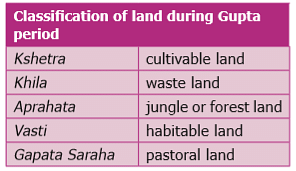
- Bhumichhidranyaya: Rights of ownerships are acquired by a man making barren land cultivable. It is free from tax.
- Aprada Dharma: Right to enjoy a property but no right to make a further gift.
- Nivi Dharma Aksayena: A perpetual endowment which a donee could not alienate but could make use of the income accruing from it eternally.
- Nivi Dharma: Land endowment in perpetuity.
- The huge sacrifical fees (dakshina) paid after the completion of various Vedic rites by Queen Naganika point to a high degree of economic prosperity which must have depended on maritime commerce.
- The type of Andhra coins with the figure of a shion the obverse and the account preserved in the Periplus of the Erythraean Sea, all testify to the maritime commerce of the day.
The most important economic development of the period was the thriving trade between India and the eastern Roman empire.
- In the beginning, a good deal of this trade was carried on by land, but the movement of the Sakas, Parthians and Kushans from the first century B.C. disrupted trade by land route.
- Although the Parthians of Iran imported iron and steel from India they presented great obstacles to India’s trade with the land further west of Iran.
- But from the first century, A.D. trade was carried on mainly by sea. It seems that around the beginning of the Christian era the monsoons were discovered. So the sailors now could sail in much less time directly from the eastern coast of the Arabian sea to its western coast.
- They could call easily at the various parts such as Broach and Sopara situated on the western coast of India, and Arikamedu and Tamralipti situated on its eastern coast.
- Of all these ports Broach seems to have been the most important and flourishing.
- The Sakas and the Kushans used two routes from the north-western frontier to the western sea coast. Both these routes converged at Taxila and were connected with the silk route passing through central Asia.
- The first route directly ran from the north to the south connecting Taxila with the lower Indus basin from where it passed on to Broach. The second route, called lthe uttarapatha, was in more frequent use.
- In the early centuries before and after the Christian era the Kushan empire touched the fringes of the Roman empire in the west and the ‘celestial empire’ in the east. Indians acted as the chief intermediaries in the silk trade, besides exporting muslin and spices.
- Their favorable balance of trade, which Pliny mentions, resulted in the creation of a gold standard in India.
- Wina Kadphises and his successors issued gold coins, which were in point of shape, size, weight, and material content exactly similar to Roman Solidus and Denarius.
- People on the Coromandel coast were engaged in trade with south-east Asia. The Jataka texts, the Niddesa, the Milinda Panho, the Kathasaritsagara and epigraphic evidence from south-east Asia, point to an increasing Indian mercantile enterprise and subsequent political domination in the region.
- The unrest caused by the extensive race movements from the 2nd century B.C. in central Asia evidently rendered the old silk route unsafe and the Chinese silk trade with the West was carried on through Indian intermediaries.
- According to the Periplus of the Erythraean Sea, Indian exports generally consisted of precious and semi-precious stones, (diamonds, pearls, sapphires, onyx sardonyx, agate, carnelian), ivory cotton cloth called Monakhe and Sagnatogene, muslin and mallow cloth, Chinese silk cloth, spices and medical products like pepper, ward, spikenard, costus, long pepper and malabathrum.
- The articles of import at the port of Barygaza included Italian and Arabian wines, copper, tin and lead, coral, topaz, flint glass, storax, antimony, gold and silver coins, singing boys, and beautiful maidens were also brought specially for the king.
Chandragupta II was the first Gupta king who minted silver coins after defeating the Saka satraps of Ujjain. The barter system also existed side by side with currency.
- Industries as before were organized under guilds. The Vaisali seals refer to the guilds (naigama, sreni) of bankers (sresthis), traders (sarthavaha) and artisans (kulika).

- Specific mention has been made of the guild of oil pressers (tailika), silk weavers (pattavaya-sreni) etc. Each guild had a president called Prathawa or Pravana.
- Something like a modern chamber of commerce or cartel also existed. There are references to Sresthi-Kaulika-Nigama. These guilds undertook banking operations and accepted donations to be held in perpetuity (ajasrikam) on certain conditions which were registered (nibaddha).
- A guild of the town of Ajapuraka thus received a permanent endowment (aksayanivi).
- Banking operation was undertaken by temple committees as well, such as the Panchamandali of the Kakanidabota-mahavihara. The importance of the industrial and mercantile communities in the body politic can be seen in the advisory council of the District Magistrate (Visayapati).
- The guild had their own property and trusts, settled disputes of their members, and issued their hundis and probably even coins.
- Some guilds even kept their own soldiers which forced the Gupta rulers to frame certain laws to limit their powers.
- Prices in the Gupta period were not always stable and they also varied from place to place. Similarly, land measures, weights, and measures were also different at different places.
- The internal trade was carried on by roads and rivers and foreign trade was carried on by sea and land.
- We have numerous references to sea trade in the period, but the sea routes were not safe for the merchants. We learn from Fa-hein that the Central Asian route from China to India was full of perils.
- Indian ports maintained regular maritime relations with Sri-Lanka, Persia, Arabia, Ethiopia, the Byzantine empire, China, and the islands of the Indian Ocean.
- India’s commercial relations with China also flourished and trade was conducted through the land and the sea routes.
- The volume of external trade of India with China greatly increased during the Gupta period. The Chinese silk, which was known as chinanshuka, had a good market in India.
- But India’s trade with the west somewhat declined due to the decline of the Roman empire. However, it revived again under the Byzantine emperors.
During the Gupta period, Indian ports maintained relations with Sri Lanka, Persia, Arabia, Ethiopia, the Byzantine Empire, China, and the Indian Ocean islands. Sri Lanka was an important port in both the island's foreign trade and inter-oceanic commerce between the East and the West. During the Gupta era, India's external trade with China increased significantly. Chinasunka, a Chinese silk, was popular in India.
Additional Topics of Ancient Indian History:
Age of Satavahanas:
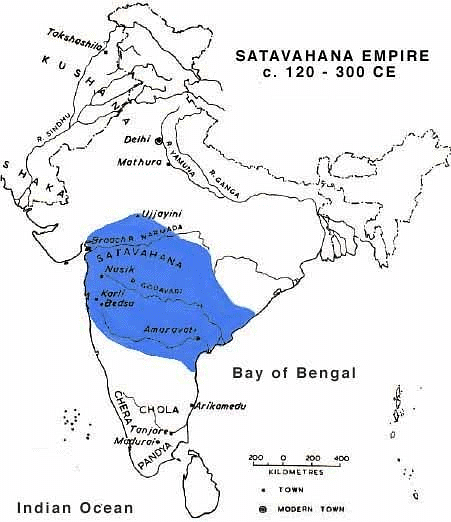
- In the Deccan, the Satavahanas established their independent rule after the decline of the Mauryas.
- Their rule lasted for about 450 years.
- They were also known as the Andhras.
- The Puranas and inscriptions remain important sources for the history of Satavahanas.
- Among the inscriptions, the Nasik and Naneghat inscriptions throw much light on the reign of Gautamiputra Satakarni.
 Naneghat Inscriptions from 2nd Century BCE
Naneghat Inscriptions from 2nd Century BCE
- The coins issued by the Satavahanas are also helpful in knowing the economic conditions of that period.
- The founder of the Satavahana dynasty was Simuka.
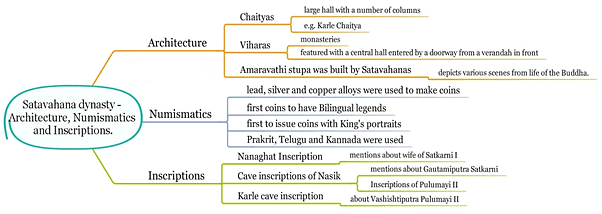
- The Pauranic genealogies refer to the kings of 'Andhra-Jati'. Some Puranas style them as Andhrabhrityas.
- The Nanaghat and Nasik cave inscriptions and coins discovered in the Deccan mention the names of several kings of 'Satavahana-Kula'.
- On the basis of certain names, and their order of succession common to various kings mentioned in the two sources, some scholars identified the Satavahanas of the epigraphical records and coins with the Andhras of the Puranas.
- However, the Puranas never use the term 'Satavahana' and the inscriptions and coins do not refer to the Satavahanas as the Andhras.
- According to R.G. Bhandarkar, The Andhrabhritya dynasty of the Puranas is the same as the Satavahana dynasty of the inscriptions'.
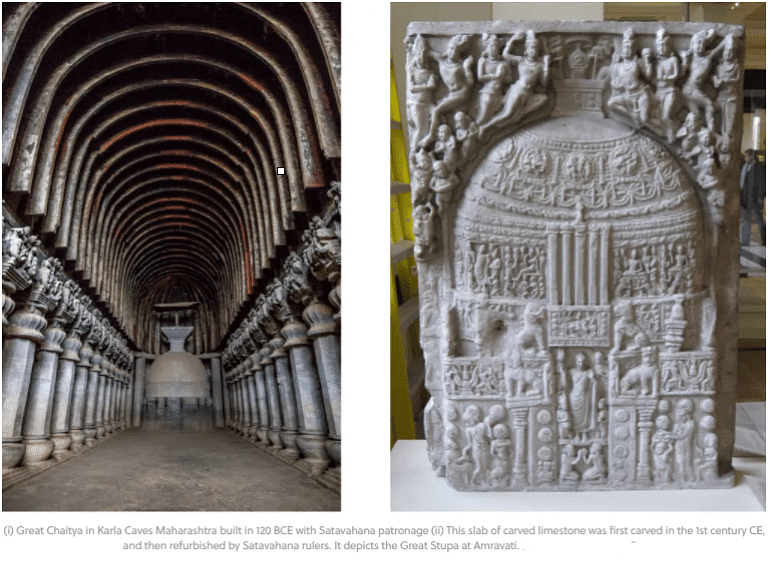
- The vague, disputed and uncorroborated doubtful evidence form the basis for the history of the Satavahanas.
- The Jain sources mention Satavahana as the first king in the family. The Kathasaritsagara also contains a story about Satavahana.
- The Kondapur coins bear the legend 'Sadvahana'. On scriptural grounds, this Satavahana is placed close to (either before or contemporaneous with) Simuka, the first ruler of the family mentioned in the Puranas.
- The latest discovery, Kotilingala coins (from Karimnagar district) included seven coins belonging to this Simuka.
- The legend on these coins strengthens the possibility that the king Satavahana of Kondapur coins is none other than Simuka himself who is called Simuka Satavahana in a Nanaghat label inscription also.
- It may be assumed that Simuka Satavahana was the founder of the dynasty and his successors called themselves Satavahanas.
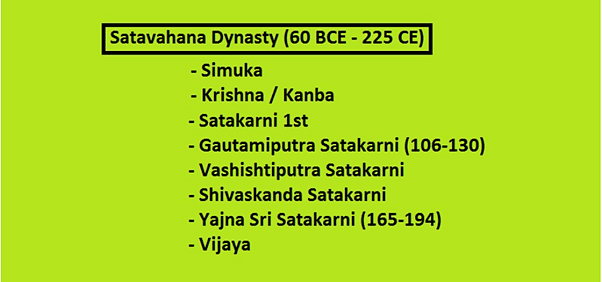
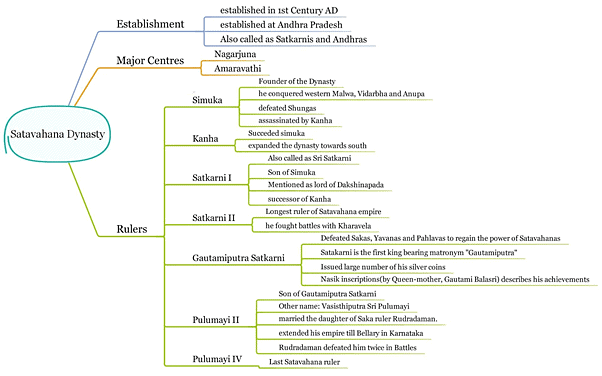
- Considered to be the founder of the Satavahana dynasty and was immediately active after Ashoka’s death.
- Built Jain and Buddhist temples.
- Satakarni I was the 3rd king of the Satavahanas.
- Satakarni I was the first Satavahana king to expand his empire by military conquests.
- He conquered Kalinga after the death of Kharavela.
- He also pushed back the Sungas in Pataliputra.
- He also ruled over Madhya Pradesh.
- After annexing the Godavari Valley, he assumed the title of ‘Lord of Dakshinapatha’.
- His queen Nayanika wrote the Naneghat inscription which describes the king as Dakshinapathapati.
- He performed Ashvamedha and revived Vedic Brahmanism in the Deccan.
- King Hala compiled the Gatha Saptashati. Called Gaha Sattasai in Prakrit, it is a collection of poems with mostly love as the theme. Around forty of the poems are attributed to Hala himself.
- Hala’s minister Gunadhya composed Brihatkatha.

- He is considered the greatest king of the Satavahana dynasty.
- It is believed that at one stage, the Satavahanas were dispossessed of their dominions in the upper Deccan and western India. The fortunes of the Satavahanas were restored by Gautamiputra Satkarni. He called himself the only Brahmana who defeated the Shakas and destroyed many Kshatriya rulers.
- He is believed to have destroyed the Kshaharata lineage to which his adversary Nahapana belonged. More than 800 silver coins of Nahapana (found near Nasik) bears marks of being restruck by the Satavahana king. Nahapana was an important king of the Western Satraps.
- His kingdom ran from Krishna in the south to Malwa and Saurashtra in the north and from Berar in the east to the Konkan in the west.
- In a Nasik inscription of his mother Gautami Balashri, he is described as the destroyer of the Shakas, Pahlavas and the Yavanas (Greeks); as the uprooter of the Kshaharatas and the restorer of the glory of the Satavahanas. He is also described as Ekabrahmana (a peerless Brahmana) and Khatiya-dapa-manamada (destroyer of the pride of Kshatriyas).
- He was given the titles Rajaraja and Maharaja.
- He donated land to the Buddhist monks. The Karle inscription mentions the grant of Karajika village, near Pune, Maharashtra.
- In the later part of his reign, he probably lost some of the conquered Kshaharata territories to the Kardamaka line of the Shaka Kshatrapas of western India, as is mentioned in the Junagadh inscription of Rudradaman Ⅰ.
- His mother was Gautami Balasri and hence his name Gautamiputra (son of Gautami).
- He was succeeded by his son Vasisthiputra Sri Pulamavi/Pulumavi or Pulamavi II. (Alternatively spelt Pulumayi.)
- He was the immediate successor of Gautamiputra. The coins and inscriptions of Vashishthiputra Pulumayi are found in Andhra.
- According to Junagadh inscriptions, he was married to the daughter of Rudradaman Ⅰ.
- The Shaka-Kshatrapas of western India recovered some of their territories due to his engagements in the east.
- One of the later kings of the Satavahana dynasty. He recovered north Kokan and Malwa from the Shaka rulers.
- He was a lover of trade and navigation, as is evident from the motif of a ship on his coins. His coins have been found in Andhra, Maharashtra, Madhya Pradesh and Gujarat.
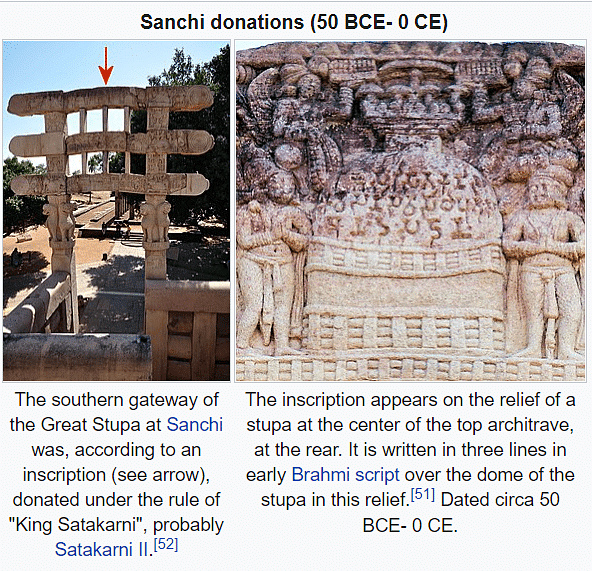
In the northern region, the Mauryas were succeeded by the Sungas and the Kanvas. However, the Satavahanas (natives) succeeded the Mauryas in Deccan and in Central India.
- It is believed that after the decline of the Mauryas and before the advent of the Satavahanas, there must have been numerous small political principalities that were ruling in different parts of the Deccan (for about 100 years).
- Probably the Rathikas and the Bhojikas that have been mentioned in the Ashokan inscriptions gradually progressed into the Maharathis and Mahabhojas of pre-Satavahana times.
- The Satavahanas are considered to be identical with the Andhras who are mentioned in the Puranas, but neither the name Andhra appears in the Satavahana inscriptions nor do the Puranas mention the Satavahanas.
- According to some Puranas, the Andhras ruled for 300 years and this period is assigned to the rule of the Satavahana dynasty, with their capital at Pratishthana (modern Paithan) on the Godavari in Aurangabad district.
- The Satavahana kingdom majorly comprised present Andhra Pradesh, Maharashtra and Telangana. At times, their rule also included parts of Gujarat, Karnataka as well as Madhya Pradesh.
- The kingdom had different capitals at different times. Two of the capitals were Amaravati and Pratishthana (Paithan).
- The earliest inscriptions of the Satavahanas belong to the first century BCE when they defeated the Kanvas and established their power in parts of Central India.
- It is important to mention that the early Satavahana kings appeared not in Andhra but in Maharashtra, where most of their early inscriptions have been found. Gradually they extended their power over Karnataka and Andhra.
- Their greatest competitors were the Shaka Kshatrapas of western India, who had established themselves in the upper Deccan and western India.
- The Satavahanas were Brahmanas and worshipped gods like Vasudeva Krishna.
- The Satavahanas kings used matronyms like Gautamiputra and Vaishishthiputra, although they were not matriarchal or matrilineal in any sense.
- They assumed the title of Dakshinapatha Pati (Lord of Dakshinapatha).
- The Satavahanas are known for starting the practice of giving royal grants of land to Brahmans and Buddhist monks.
- Simuka was the founder of the Satavahana Dynasty.
- The Satavahanas were the first native Indian kings to have issued their own coins which had the rulers’ portraits on them. Gautamiputra Satakarni started this practice which he imbibed from the Western Satraps after vanquishing them.
- The coin legends were in Prakrit. Some reverse coin legends are in Tamil, Telugu and Kannada also.
- They patronised Prakrit more than Sanskrit.
- Even though the rulers were Hindus and claimed Brahmanical status, they supported Buddhism also.
- They were successful in defending their areas from foreign invaders and had many battles with the Sakas.


The administration of the Satavahana dynasty was entirely based on the Shastras, and it had the following structure:
- Rajan or the king who was the ruler
- Princes or Rajas who had their names inscribed on coins
- Maharathis, who had the power of granting villages and also had the privilege of maintaining marital relations with the ruling family
- Mahasenapati
- Mahatalavara
The inscription of the ruler Guatamipurna Satakarni throws some light on the bureaucratic structure of administration. However, clarity on the detailed structure is still awaited by historians.
- The king was represented as the upholder of dharma and he strove for the royal ideal set forth in the Dharmashastras. The Satavahana king is represented as possessing the divine qualities of ancient gods such as Rama, Bhima, Arjuna, etc.
- The Satavahanas retained some of the administrative units of Ashokan times. The kingdom was divided into districts called ahara. Their officials were known as amatyas and mahamatras (same as in Mauryan times). But unlike Mauryan times, certain military and feudal elements are found in the administration of the Satavahanas. For instance, the senapati was appointed provincial governor. It was probably done to keep the tribal people in the Deccan who were not completely brahmanised under strong military control.
- The administration in the rural areas was placed in the hands of gaulmika (village headman) who was also the head of a military regiment consisting of 9 chariots, 9 elephants, 25 horses and 45-foot soldiers.
- The military character of the Satavahana rule is also evident from the common use of terms like kataka and skandhavara in their inscriptions. These were military camps and settlements which served as administrative centres when the king was there. Thus, coercion played an important part in the Satavahana administration.
- The Satavahanas started the practice of granting tax-free villages to Brahmanas and Buddhist monks.
- The Satavahana kingdom had three grades of feudatories – Raja (who had the right to strike coins), Mahabhoja and Senapati.
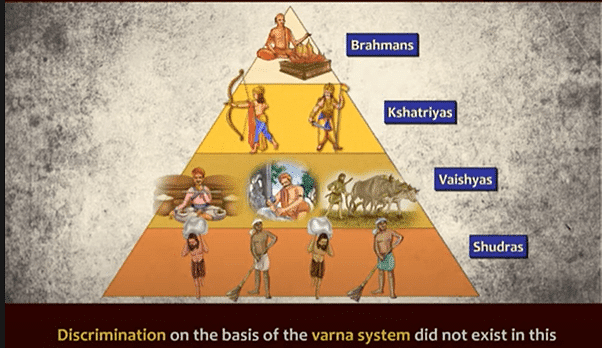
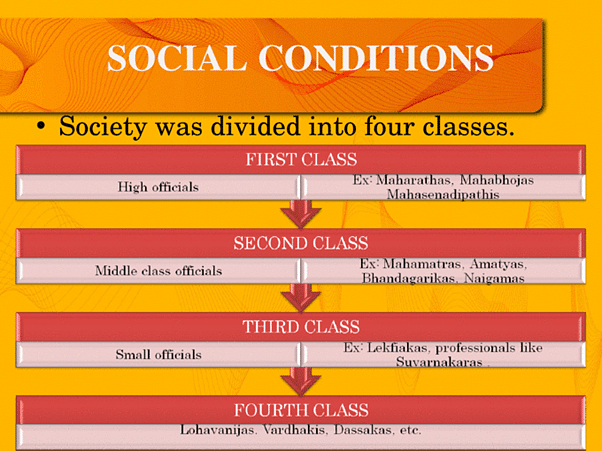
- During this period, the people were familiar with the Aryan fourfold division of society into Brahmins, Kshatriyas, Vaisyas and Sudras. Outside the Aryan influence were the indigenous tribes, indifferent to Aryan ways of life and thought.
- People were known according to their professions such as the Halika (cultivator), the Sethi (merchant), the Kolika (Weaver) and the Gadhika (druggist).
- The Buddhists and the Saka-Pahlavas shook in social structure considerably.
- The foreigners were becoming absorbed in the indigenous society by adopting the faith and customs here and through intermarriages with the caste people.
- It is true Gautamiputra Satakami attempted in restoring the balance and stopping the contamination of the castes.
- Yet caste rules were not strictly observed. Inscriptions and other records indicate the prominence of women in social life.
- Their lavish charity and assumption of the titles of their husbands like Mahatalavari signify their economic and social status.
- The sculptures of the period reveal their scanty dress and profuse ornamentation.
- The joint family system was another normal feature of society in the Aryan patriarchal mould.
- The prevalence of polygamy among the princes was revealed by the metronymic tithes (calling sons after their mothers), which some of the later Satavahanas bore along with the personal name.
Agriculture was the backbone of the economy during the rule of Satavahana kings. They also relied on the trade and production of various commodities within and outside India.
➤ Satavahana Coins
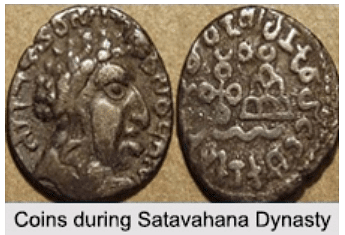
Some important points related to Satavahan coinage are mentioned below:
- The coins of the Satavahanas have been excavated from Deccan, western India, Vidarbha, Western and Eastern Ghats, etc.
- Most of the coins in the Satavahana dynasty were die-struck.
- Cast-coins too existed in the Satavahana empire and there were multiple combinations of techniques that were used to cast coins.
- There were silver, copper, lead and potin coins in the Satavahana empire.
- The portrait coins were mostly in silver and some were in lead too. Dravidian language and Brahmi script were used on portrait coins.
- There were punch-marked coins too that were circulated alongside the Satavahana dynasty.
- The importance of maritime trade was derived from the images of ships present on the Satavahana coins.
- Many Satavahana coins bore the names of ‘Satakarni’ and ‘Pulumavi.’
- Satavahana coins were of different shapes – round, square, rectangular, etc.
- Many symbols have appeared on the Satavahana coins, the major ones of which are:
(i) Chaitya symbol
(ii) Chakra symbol
(iii) Conch Shell symbol
(iv) Lotus symbol
(v) Nandipada symbol
(vi) Ship symbol
(vii) Swastik symbol - Animal motifs were found on the Satavahana coins.
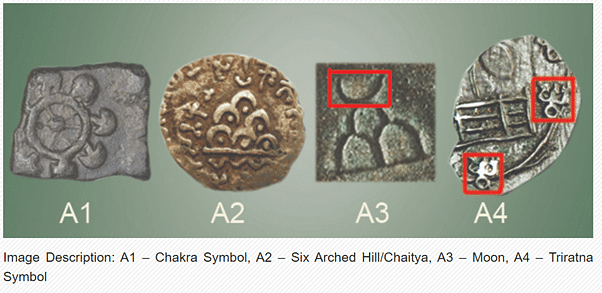
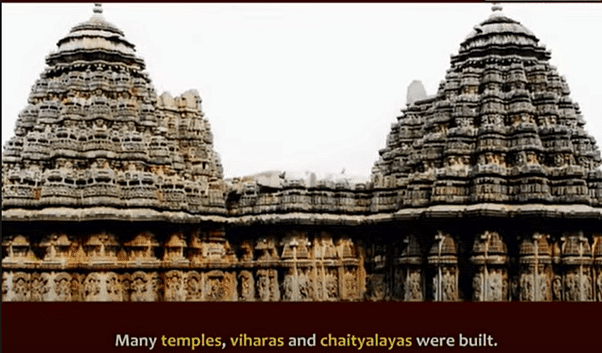
- Most of the Satavahana rulers were staunch followers of the Vedic religion with its ritual and caste system.
- Satakarni II of the Nanaghat record performed a number of Vedic sacrifices including Aswamedhas and Rajasuya. Gautamiputra restored the caste system and protected the Brahmins.
- Adherence to the Vedic creed is also indicated by the name of King Yajna Sri.
- The invocations to various gods like Indra, Sankarshana, Vasudeva, Surya, Varuna etc. show the transition from the Vedic to Puranic pantheon.
- This feature is prominently reflected in Hala's Gatha Saptasati wherein there are references to Pasupali and Gauri, Rudra and Parvati, Lakshmi and Narayana.
- The Aryanized foreigners and mixed castes had solace in the Puranas.
- As PT. Srinivasa lyyangar observed, the two cultsVedic and Agamic had coalesced completely during this period and modern Hinduism was born.
- The Satavahana kings were renowned for their spirit of tolerance They even extended their patronage to the Buddhist ascetics.
- Buddhism commanded greater influence with the womenfolk (especially with the royal ladies) and with the masses.
- It was in fact the heyday of Buddhism in the Deccan.
- The Buddhist monuments at Nasik, Karie, Bhaja, Bedsa, Ajanta, Amaravati.
- Jaggayyapeta and Nagarjunakonda show the Chaitya cult predomment in the South.
- Mehasanghika sects flourished. Acharya Nagarjuna received patronage from the ruler Yajna Sri and from his time Andhra became the stronghold of Mahayanism.
- Due to the patronage and great services of Kharavela of Kalinga, Jainism made considerable progress in the coastal region to the north of river Krishna.

- As regards the contemporary system of education and literary development, it is but natural that the Aryan, teachers and missionaries brought with them, into the Deccan their own literature and methods of instruction.
- The elaborate sacrifices performed by Satakarni II show how the priests were well-versed in the Vedic literature.
- The Asokan Edicts in the Deccan prove the familiarity of the people with the Brahmi script and the Prakrit language.
- Almost all the records of the Satavahana period are in Prakrit. Instruction in secular and sacred learning was imparted in the asramas of the Brahmins or the Viharas of the Buddhists and the Jains, which received liberal grants from the rulers.
- The craft and trade guilds too might have served the cause of education.
- Among the literary works of outstanding merit produced during this period under the patronage of the Satavahana rulers, mention may be made of the Katantra, the Brihatkatha and the Gatha Sattasai.
- Sarvavarman, probably a minister of Hala composed the Katantra on Sanskrit grammar for the use of the King.
- Gunadhya made over his Brihatkatha in Paisachi Prakrit to the same king Hala.
- Hala himself compiled the Gatha Sattasai, an authology of 700 Prakrit verses of various poets and poetesses. This Sattasai contains many Desi terms.
- An unknown author composed another poem in Prakrit, called Lilavati Parinayam on the marriage of Hala.
- In the later part of the Satavahana period, with the revival of Brahmanical Hinduism, Sanskrit became predominant. The Mahayana Buddhists including Nagarjuna wrote all their works in Sanskrit.
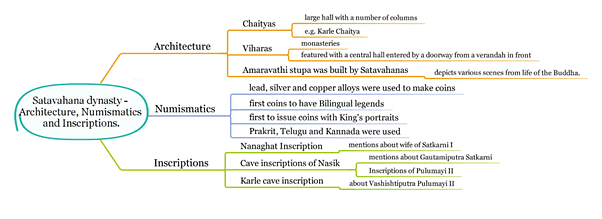
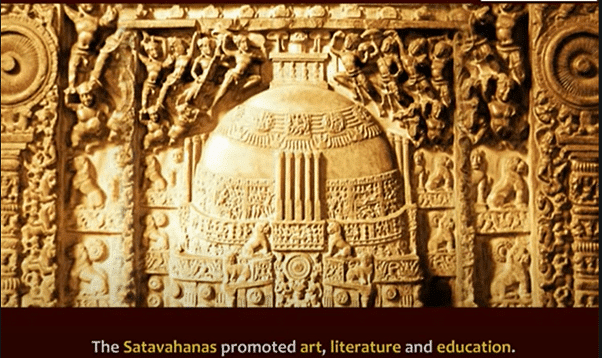
- With religion and that too Buddhism as the source of inspiration, the Satavahana period witnessed great building activity.
- The ancient monuments that have been brought to light south of the Vindhyas are almost all post-Asokan and Buddhist in inspiration'.
- They included Stupas, Chaityas, Viharas and Sangharamas discovered both in the Western and in the eastern dominions of the Satavahanas.
- The Bhattiprolu and Amaravati Stupas were the oldest brick-built Stupas in the south.
- The brick-built Chaityagrihas were located at Chejerla and Nagarjunakonda in the east, whereas the rock-cut grihas were in the west at Karle, Nasik, Bhaja and other places.
- The sculptural representations on most of the stupas, of the Jataka tales or the incidents in the life of Buddha and scenes from normal social life, are noteworthy.
- At Amaravati, the well known South Indian centre of Buddhism, a thoroughly indigenous school of sculpture grew up.
- For the conception of the delicate beauty of human form and the technical skill and efficiency to realise that conception and for the wonderful imagination and sense of symmetry in depicting the most subtle human feelings, the Amaravati artist won universal praise.
- With regard to the minor arts, the articles like beads, terracotta figurines, pottery, shell ornaments, precious stones and jewels and coins excavated at Paithan, Maski, Kondapur and other places, indicate their progress during this period. with the extirpation of the Kshaharata family.
- It is solid that he humbled the power and pride of the Kshatriyas and destroyed the Yavanas, Sakas and Pahlavans.
- Gautamiputra Satakarni's dominions included the countries of Asika. Asaka, Mulaka, Surashtra, Kakura, Aparanta, Anupa, Vidarbha, Akara and Avanti, the mountainous regions of Virtdhya, Achavata, Pariyatra. Sahya, Kanhagiri, Siritana, Malaya. Mahendra, Seta and Chokora and extended as far as the seas on either side.
- These details indicate the extent of his empire over the country between Rajasthan and Cuddalore and between the Rishikulya and Vaijayanti.
- Gautamiputra made his horses drink the waters of the three oceans.
- He was uniquely skilled as an archer, absolute as a sovereign and a figure of the heroic mould.
- Though an absolute monarch, Gautamiputra was kind to his subjects and a father to his people.
- He tried to fulfil the duties of the Trivarga-Dharma, Artha and Kama. He shared the sorrows and pleasures of his people. He is described as 'the abode of the Vedas'.
- A pious and orthodox Brahmin, he was meticulous in maintaining caste purity.
- Gautamiputra's son and successor Vasisthiputra Pulomavi (86-11 4 A.D.) could not maintain for long his hold over his vast inheritance. During the last years of his rule, he lost the north-western provinces of the Andhra empire to Chashtana, the founder of the Western Kshatrapa Kardamaka line.
- His successors, Siva Sri and Sivaskanda each ruled for seven years during which period the house of Chashtana expanded its authority upto Cutch in the west by 130 A.D. Chashtana's grandson Rudradaman made his substantial contribution in the growth of the Kardamaka power.
The material culture of the Deccan under the Satavahanas was a fusion of local elements (Deccan) and northern ingredients.
- The people of the Deccan were fairly acquainted with the use of iron and agriculture. The Satavahanas probably exploited the rich mineral resources of the Deccan such as iron ores from Karimnagar and Warangal and gold from Kolar fields. They mostly issued coins of lead, which is found on the Deccan and also coins of copper and bronze.
- The paddy transplantation was an art well known to the Satavahanas and the area between the Krishna and Godavari, especially at the mouth of the two rivers, formed a great rice bowl. The people of the Deccan also produced cotton. Thus a good portion of the Deccan developed a very advanced rural economy.
- The people of the Deccan learnt the use of coins, burnt bricks, ring wells, etc. through its contacts with the north. There was regular use of fire-baked bricks and use of flat, perforated roof tiles which must have added to the life of the structures. The drains were covered and underground to lead wastewater into soakage pits. The Andhra in the east Deccan included 30 walled towns, besides numerous villages.
- The Satavahanas originally seem to have been a tribe of the Deccan. They, however, were so brahmanized that they claimed to be Brahmanas. The most famous Satavahana king Gautamiputra claimed to be a Brahman and thought it his duty to uphold the four-fold varna system.
- The Satavahanas were the first rulers to make land grants to the Brahmans and there are also instances of grants made to Buddhist monks, especially to Mahayana Buddhists.
(i) Nagarjunakonda and Amravati in Andhra Pradesh and Nasik and Junar in Maharashtra became important Buddhist sites under the Satavahanas and their successors, the Ikshvakus. - The artisans and merchants formed an important class of society due to flourishing trade and commerce.
(i) Merchants took pride in naming themselves after the towns to which they belonged.
(ii) Among the artisans, the Gandhikas (perfumers) are mentioned as donors and later the term came to be used for all kinds of shopkeepers. The title ‘Gandhi’ is derived from this ancient term Gandhika. - It was customary for their king to be named after his mother, (Gautamiputra and Vashishthiputra) which indicates that the women occupied an important position in the society.

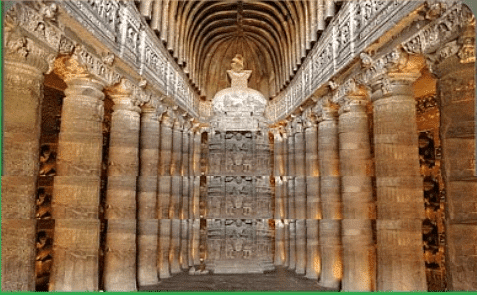 In the Satavahana phase, many temples called chaityas and monasteries called viharas were cut out of the solid rock in the northwestern Deccan or Maharashtra with great precision and patience.
In the Satavahana phase, many temples called chaityas and monasteries called viharas were cut out of the solid rock in the northwestern Deccan or Maharashtra with great precision and patience.
- The Karle chaitya is the most famous in western Deccan.
- The three viharas at Nasik carry inscriptions of Nahapana and Gautamiputra.
- The most important stupas of this period are Amravati and Nagarjunakonda. The Amaravati stupa is full of sculptures that depict the various scenes from the life of the Buddha. The Nagarjunakonda stupa contains Buddhist monuments and also the earliest Brahmanical brick temples.
- Pulamavi IV is considered the last king of the main Satavahana line.
- He ruled until 225 AD. After his death, the empire fragmented into five smaller kingdoms.
- The period AD 300–750 marks the second historical phase in the regions south of the Vindhyas. It continued some of the processes that had begun in the first historical phase (c. 200 BC-AD 300) of the peninsula.
- The first phase shows the ascendancy of the Satavahanas over the Deccan and that of the Tamil kingdoms over the southern districts of Tamil Nadu.
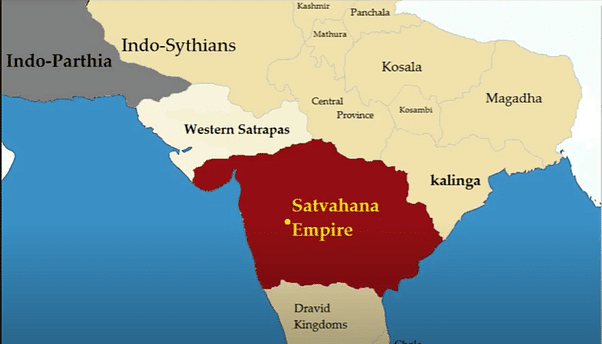
- In that period, northern Tamil Nadu, southern Karnataka, a part of southern Maharashtra, and the land between the Godavari and the Mahanadi broadly owed allegiance to the seats of political authority established outside their areas.
- Eventually, by the beginning of the seventh century, the Pallavas of Kanchi, the Chalukyas of Badami, and the Pandyas of Madurai emerged as the rulers of the three major states. The first historical phase is marked by numerous crafts, internal and external trade, widespread use of coins, and a large number of towns.

- Trade, towns, and coinage seem to have been in a state of decline in the second phase, but in that phase, numerous land grants free of taxes were made to the temples and Brahmanas.
- Cave inscriptions probably indicate the influence of Jainism and also of Buddhism in the southern districts of Tamil Nadu. This phase also marked the beginning of the construction of stone temples for Shiva and Vishnu in Tamil Nadu under the Pallavas, and in Karnataka under the Chalukyas of Badami.
- By the beginning of the second phase, south India had ceased to be the land of megaliths, and towards its end began the process that made it a land of temples.
- Culturally, the Dravidian element seems to have dominated the scene in the first phase, but during the second phase, Aryanization and brahmanization came to the fore. This happened because of land grants made by the rulers who were either Brahmanas or firm supporters of them.
- The Ashokan inscriptions found in Andhra and Karnataka show that the people knew Prakrit in the third century BC. Also, epigraphs between the second century BC and the third century AD were largely written in Prakrit.
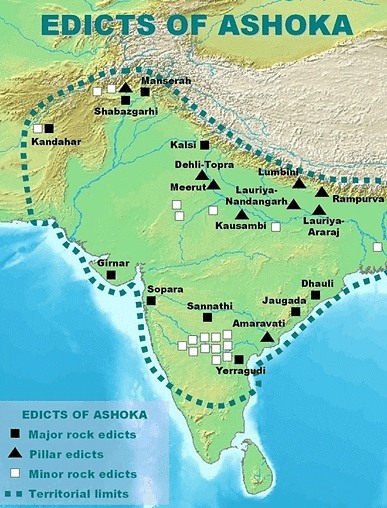
- The Brahmi inscriptions that have been found in Tamil Nadu also contain Prakrit words, but from about AD 400 onwards Sanskrit became the official language in the peninsula and most charters were composed in it.
- In northern Maharashtra and Vidarbha (Berar), the Satavahanas were succeeded by the Vakatakas, a local power. The Vakatakas, who were brahmanas themselves, are known for a large number of copperplate land grants issued by them. They were great champions of the brahmanical religion and performed numerous Vedic sacrifices.
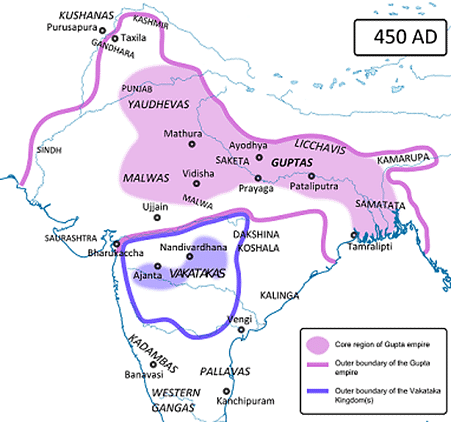
- Culturally however the Vakataka kingdom served as a channel for the transmission of Brahmanical ideas and social institutions to the south.
- The Vakataka power was followed by that of the Chalukyas of Badami who played an important role in the history of the Deccan and south India for about two centuries until AD 757, when they were overthrown by their feudatories, the Rashtrakutas.
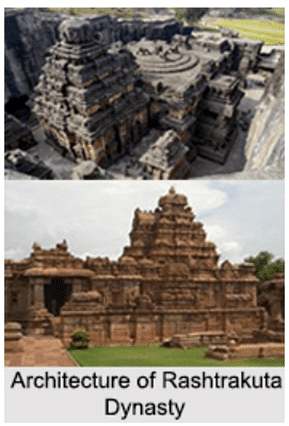
- The Chalukyas claimed their descent from Brahma or Manu or the Moon.
- The Chalukyas set up their kingdom towards the beginning of the sixth century in the western Deccan. They established their capital at Vatapi, modern Badami, in the district of Bijapur, which forms a part of Karnataka.
- On the ruins of the Satavahana power in the eastern part of the peninsula, there arose the Ikshvakus in the Krishna–Guntur region.
- They seem to have been a local tribe who adopted the exalted name of the Ikshvakus in order to demonstrate the antiquity of their lineage, and also claimed to be brahmanas.
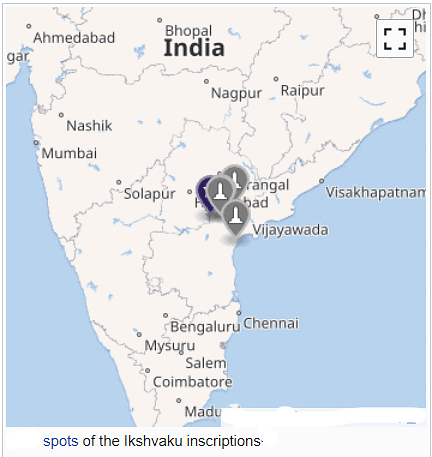
- They have left behind many monuments at Nagarjunakonda and Dharanikota.
- They began the practise of land grants in the Krishna–Guntur region, where several of their copperplate inscriptions have been discovered.
- The Ikshvakus were supplanted by the Pallavas. The term pallava means creeper, and is a Sanskrit version of the Tamil word tondai, which also carries the same meaning.
- The Pallavas were possibly a local tribe who established their authority in the Tondainadu or the land of creepers. The authority of the Pallavas extended over both southern Andhra and northern Tamil Nadu. They set up their capital at Kanchi, identical with modern Kanchipuram, which under them became a town of temples and Vedic learning.
- The early Pallavas came into conflict with the Kadambas, who had established their control over northern Karnataka and Konkan in the fourth century. The Kadamba kingdom was founded by Mayurasharman. It is said that he came to receive education at Kanchi but was unceremoniously driven out.
- Smarting under this insult, the Kadamba chief set up his camp in a forest, and defeated the Pallavas, possibly with the help of the forest tribes. Eventually, the Pallavas avenged the defeat but recognized the Kadamba authority by formally investing Mayurasharman with the royal insignia. Mayurasharman is said to have performed eighteen ashvamedhas or horse sacrifices and granted numerous villages to brahmanas.
- The Kadambas established their capital at Vaijayanti or Banavasi in north Kanara district of Karnataka.

- The Gangas were another important contemporary dynasty of the Pallavas. They established their kingdom in southern Karnataka around the fourth century. The kingdom was situated between that of the Pallavas in the east and of the Kadambas in the west. They are called the Western Gangas or Gangas of Mysore in order to differentiate them from the Eastern Gangas who ruled in Kalinga from the fifth century onwards.
- The Pallavas, the Kadambas, the Chalukyas of Badami, and their other contemporaries were great champions of Vedic sacrifices.
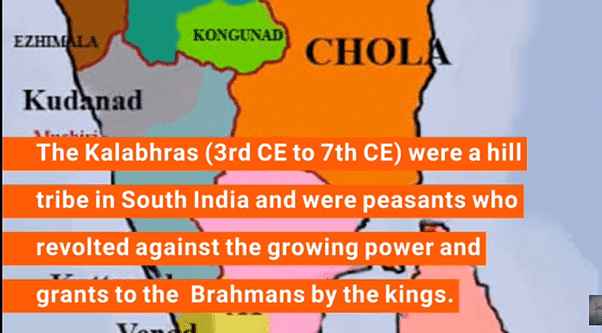
- Although the period between AD 300 and 750 was extremely important for state formation and agrarian expansion in the peninsula. The only important event is a revolt led by the Kalabhras in the sixth century.
- The Kalabhras seem to have been a tribal people who captured power, particularly at the cost of the Cholas, and ruled for seventy-five years.
- Their rule also affected the Pallavas as well as their neighbouring contemporaries.
- The Kalabhras are called evil rulers, who overthrew innumerable kings and established their hold on the Tamil land. The Kalabhra revolt was a powerful peasant protest directed against the landed brahmanas.
- They put an end to the brahmadeya rights granted to the brahmanas in numerous villages.
- It appears that the Kalabhras were of Buddhist persuasion as they patronized Buddhist monasteries. The Kalabhras’ revolt was so widespread that it could be quelled only through the joint efforts of the Pandyas, the Pallavas, and the Chalukyas of Badami.
- By the last quarter of the sixth century, according to a tradition, the Kalabhras had imprisoned the Chola, the Pandya, and the Chera kings, which underlines how formidable their revolt was.
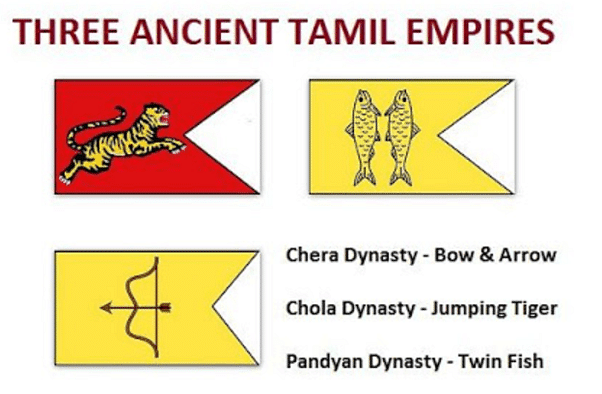
- The Sangam texts tell us that villages were granted to the warriors by the chief for their acts of bravery.
- Land grants seem to have stimulated agrarian expansion under the Pallavas in south Andhra and north Tamil Nadu from the end of the third century onwards, but they seem to have adversely affected the peasants.

- The principal interest in the political history of peninsular India from the sixth to the eighth-century centres around the long struggle for supremacy between the Pallavas of Kanchi and the Chalukyas of Badami. The Pandyas, who were in control of Madurai and Tirunelveli districts of Tamil Nadu, joined this conflict as a poor third.
The main reason for the conflict between the Pallavas and Chalukyas of Badami was supremacy over throne, prestige and territorial resources. This struggle continued from 6th century to 8th century. Later the Pandyas under control of Madurai and Tinnevelly also joined this conflict.
- Although both the Pallavas and the Chalukyas championed Brahmanism, performed Vedic sacrifices, and made grants to the brahmanas, the two quarrelled with each other over plunder, prestige, and territorial resources. Both tried to establish supremacy over the land lying between the Krishna and the Tungabhadra.
- This doab was again the bone of contention in late medieval times between the Vijayanagar and the Bahmani kingdoms. Time and again, the Pallava princes tried to cross the Tungabhadra, which formed the natural historic boundary between many a kingdom of the Deccan and the deep south.
- The first important event in this long conflict took place during the reign of Pulakeshin II (AD 609–42), the most famous Chalukya king. He is known to us from the eulogy written on him by the court poet Ravikirti in the Aihole inscription. This inscription is an example of the poetic excellence achieved in Sanskrit, and despite its exaggeration is a valuable source for the life of Pulakeshin.
- He subjugated the Kadamba capital at Banavasi and compelled the Gangas of Mysore to acknowledge his suzerainty. He also defeated Harsha’s army on the Narmada and checked his advance towards the Deccan. In his conflict with the Pallavas, he almost reached the Pallava capital, but the Pallavas purchased peace by ceding their northern provinces to Pulakeshin II.
- Around AD 610 Pulakeshin II also conquered the entire area between the Krishna and the Godavari, which came to be known as the province of Vengi. Here, a branch of the main dynasty was set up and is known as the eastern Chalukyas of Vengi. However, Pulakeshin’s second invasion of Pallava territory ended in failure.
- The Pallava king Narasimhavarman (AD 630–68) occupied the Chalukya capital at Vatapi in about AD 642, when Pulakesin II was probably killed in a battle against the Pallavas. Narasimhavarman assumed the title of Vatapikonda or the conqueror of Vatapi. He is also said to have defeated the Cholas, the Cheras, the Pandyas, and the Kalabhras.
- Towards the end of the seventh century, there was a lull in this conflict, which was again resumed in the first half of the eighth century. The Chalukya king Vikramaditya II (AD 733–45) is said to have overrun Kanchi three times. In AD 740 he completely routed the Pallavas. His victory ended the Pallava supremacy in the far south although the ruling house continued for over a century thereafter.
- However, the Chalukyas were unable for long to enjoy the fruits of their victory over the Pallavas because their own hegemony was brought to an end in AD 757 by the Rashtrakutas.
- The Nayanars rendered a similar service to the cult of Shiva. From the seventh century onwards, the cult of bhakti began to dominate the religious life of south Indians, and the Alvars and Nayanars played a great part in propagating it.
- The Pallava kings constructed a number of stone temples in the seventh and eighth centuries for housing these gods. The most famous of them are the seven ratha temples at Mahabalipuram, at a distance of 65 km from Chennai. These were built in the seventh century by Narasimhavarman, who founded the port city of Mahabalipuram or Mamallapuram.
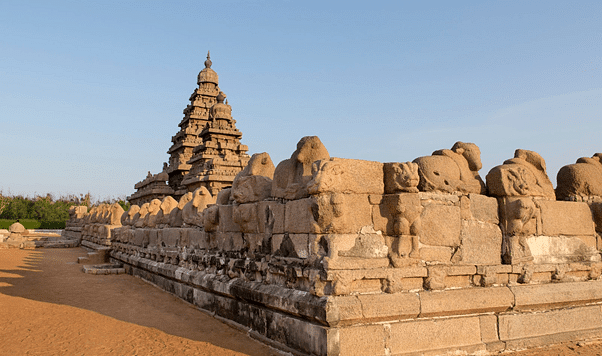 The Shore Temple by Pallavas
The Shore Temple by Pallavas
- This city is also famous for the Shore Temple, which was a structural construction erected independently and not hewn out of rock.
- In addition, the Pallavas constructed several such structural temples at their capital Kanchi. A very good example was the Kailashnath temple built in the eighth century.
 Kailashnath Temple
Kailashnath Temple
- The Chalukyas of Badami erected numerous temples at Aihole, which has as many as seventy, from about AD 610. The work was continued in the adjacent towns of Badami and Pattadakal. Pattadakal has ten temples built in the seventh and eighth centuries, the most celebrated of which are the Papanatha temple (c. AD 680) and the Virupaksha temple (c. AD 740).
 Aihole, Pattadakal, Badami
Aihole, Pattadakal, Badami
- The first of these, although 30 m long, has a low and stunted tower in the northern style; the second was constructed in purely southern style. The latter is about 40 m in length and has a very high square and storeyed tower (shikhara).
- To conduct wars, to cultivate art and literature, to promote religion, and to maintain the administrative staff, enormous resources were needed. These were apparently provided by the peasantry.
- The nature of burdens imposed on the agrarian communities was more or less the same in the Vakataka and the Pallava kingdoms although the former was in Vidarbha and Maharashtra, and the latter in southern Andhra and northern Tamil Nadu.
- The state made heavy demands on the labour and produce of the peasantry.
- Most of these are covered by the eighteen types of immunities granted to the brahmanas from the fourth century AD onwards. Later, more and more demands were made on the peasantry.
- These numerous demands made by the king on the agrarian population presuppose a capacity to pay on the part of the peasantry. The states could not multiply without the proliferation of rural communities or an increase in the agricultural production of the existing villages. This period saw three types of villages in south India: ur, sabha, and nagaram.

- The ur was the usual type of village inhabited by peasant castes, who perhaps held their land in common; it was the responsibility of the village headman to collect and pay taxes on their behalf. These villages were mainly found in southern Tamil Nadu.
- The sabha type of village consisted of brahmadeya villages or those granted to the brahmanas, and of agrahara The brahmana owners enjoyed individual rights in the land but carried on their activities collectively.
- The nagaram type of village consisted of a village settled and dominated by combinations of traders and merchants. This possibly happened because trade declined and merchants moved to villages.
- In the Chalukya areas, rural affairs were managed by village elders called mahajana. On the whole, the period AD 300–750 provides good evidence of agricultural expansion, rural organization, and more productive use of land.

- The princes claimed the status of brahmanas or kshatriyas, though many of them were local clan chiefs promoted to the second varna through benefactions made to the priests.
- The priests invented respectable family trees for these chiefs and traced their descent from age-old solar and lunar dynasties.
- This process enabled the new rulers to acquire acceptability in the eyes of the people.
- The title dharma-maharaja was, therefore, adopted by the Vakataka, Pallava, Kadamba, and Western Ganga kings.
- The real founder of the Pallava power, Simhavarman, is credited with coming to the rescue of dharma when it was beset with the evils typical of the Kaliyuga. This apparently refers to his suppression of the Kalabhra, peasants who upset the existing social order.
The period around 200 BCE did not witness an empire as large as Mauryas but is regarded as an important period in terms of the intimate and widespread contacts between Central Asia and India.
- In Eastern India, Central India, and the Deccan, the Mauryas were succeeded by a number of native rulers such as the Sungas, the Kanvas, and the Satavahanas.
- In north-western India, the Mauryas were succeeded by a number of ruling dynasties from Central Asia.
At the beginning of the 2nd century BCE, the Indo-Greeks/Bactrian Greeks were the first to invade India. The Indo-Greeks occupied a large part of north-western India, much larger than that conquered by Alexander.
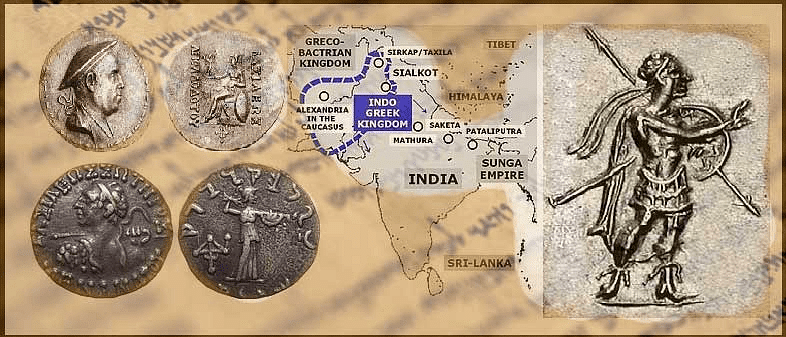 Glimpses: The Indo-Greek Kingdom
Glimpses: The Indo-Greek Kingdom
- A series of invasions took place from about 200 BCE. The first to cross the Hindukush were the Greeks, who ruled Bactria, lying south of the Oxus river in the area covered by north Afghanistan.
- One of the important causes of invasion was the weakness of the Seleucid empire, which had been established in Bactria and the adjoining areas of Iran called Parthia.
- Due to the growing pressure from the Scythian tribes, the later Greek rulers were unable to hold their power in this area.
- The construction of the Chinese wall prevented the Scythians from entering China.
- So, their attention turned towards Greeks and Parthians. Pushed by the Scythian tribes, the Bactrian Greeks were forced to invade India.
- The successors of Ashoka were too weak to thwart the attack.
- At the beginning of the 2nd century BCE, the Indo-Greeks/Bactrian Greeks were the first to invade India. The Indo-Greeks occupied a large part of north-western India, much larger than that conquered by Alexander.
- It is believed that they pushed forward to as far as Ayodhya and Pataliputra.
- However, the Greeks failed to establish a united rule in India. Two Greek dynasties ruled north-western India on parallel lines at the same time.
- The Indo-Bactrian rule is important in the history of India because of the large number of coins issued by the Greek kings.
- The Indo-Greeks were the first rulers in India to issue coins which can be definitely attributed to the kings.
- It is rather interesting to note that out of the forty-two Indo-Greek kings, as many as 34 are known only through their coins.
- Invaded India around 190 BCE and probably also came into conflict with Pushyamitra Sunga, founder of the Sunga dynasty.
- Conquered a large part of north-western India and also extended the Bactrian rule to the south of the Hindukush.
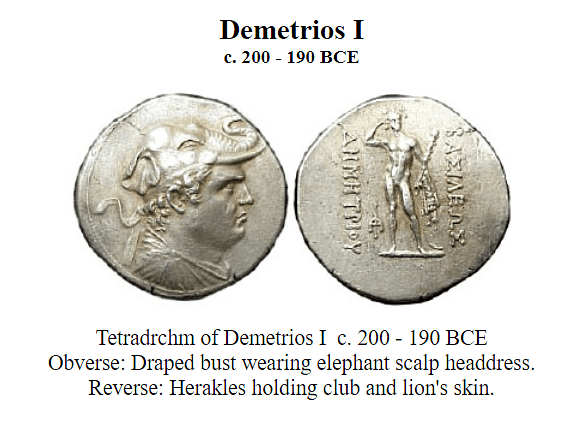
- The most celebrated Indo-Greek ruler who stabilized Indo-Greek power and also extended his empire’s frontiers in India.

- Also included southern Afghanistan and Gandhara, the region west of the Indus river.
- Had his capital at Sakala (modern Sialkot, Punjab, Pakistan).
- It is believed that he invaded Ganga-Yamuna doab but had failed to retain it for long.
- He was converted to Buddhism by Nagasena, (also known as Nagarjuna). Menander has been identified with king Milinda mentioned in the famous Buddhist text Milindapanho (Question of Milinda), which contains philosophical questions that Milinda asked Nagasena. The text claims that impressed by the answers, the king accepted Buddhism as his religion.
- He is also identified with king Minedra mentioned in a fragmented Kharosthi inscription found on a casket at Bajaur (presently in Pakistan) which refers to the enshrining of relics of the Buddha, probably in a stupa, during his reign.
- He was the last ruler of this dynasty and was defeated by the Parthians around the last quarter of the 2nd century BCE, which led to the end of Greek rule in Bactria and the area to the south of the Hindukush.
- However, the Indo-Greek rule continued in north-western India for some more time.
- This north-western Gandhara region was also lost to Parthians and Shakas in due course of time.
- Later, in the late 1st century BCE or the early 1st century CE, the remaining part of the territory, i.e, the area to the east of the Jhelum also ceded to the Kshatrapa ruler Rajuvula.
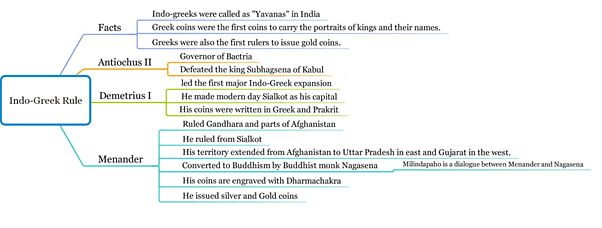
- The Indo-Greeks were the first rulers in India to issue coins (gold, silver, copper, and nickel).
- The coins of the Shakas, Parthians, and the Kshatrapas followed the basic features of the Indo-Greek coinage, including the bilingual and bi-script legends.
- These coins provide important information about the religious sects and cults of that era (especially Shaiva and Bhagavata sects).
- The Indo-Greeks introduced Gandhara art in the northwest frontier of India, which was the outcome of the intermingling and influence of both Indian and central Asian contacts.

- The Indo-Greeks also introduced the practice of military governorship and the Governors were called strategos/satraps.
- The Hellenistic Greeks are well known for their monumental buildings and finely crafted objects. Excavation of the cities reveals a great talent in urban planning.
Shakas is the Indian term for the people called the Scythians, who originally belonged to Central Asia.
- The Greeks were followed by the Shakas, who controlled a much larger part of India than the Greeks.
- There were five branches of the Shakas with their seats of power in different parts of India and Afghanistan.
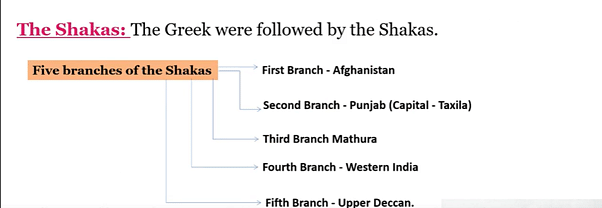
- One branch of the Shakas settled in Afghanistan. Prominent rulers of this branch were Vonones and Spalirises.
- The second branch settled in Punjab with Taxila as their capital. Maues was a prominent ruler.
- The third branch settled in Mathura, where they ruled for about two centuries. Azilises was a prominent ruler.
- The fourth branch established its hold over western India, where they continued to rule till the 4th century CE.
(i) They ruled for the maximum period owing to a flourishing economy based on the sea-borne trade in Gujarat and also issued a large number of silver coins.
(ii) One of the famous Shaka rulers was Rudradaman 1 (CE 130-150).
(a) He ruled over Sindh, Kutch and Gujarat and also recovered from the Satavahanas, Kokan, the Narmada valley, Malwa and Kathiawar.
(b) He is famous in history because of the repairs he undertook to improve the Sudarsana lake in the semi-arid zone of Kathiawar.
(c) He was a great lover of Sanskrit and issued the first-ever long inscription in chaste Sanskrit.
(d) All the earlier longer inscriptions were composed in Prakrit. - The fifth branch of the Shakas established its power in the upper Deccan.
- The Shakas did not meet effective resistance from the rulers and the masses of India. The king of Ujjain (around 58 BCE), effectively fought and succeeded in throwing the Shakas out.
- He called himself Vikramaditya and an era called Vikram-Samvat is reckoned from the event of his victory over the Shakas in 58 BCE.
- From this time onwards, Vikramaditya became a coveted title, and whoever achieved anything great adopted this title, as the Roman emperors adopted the title Caesar in order to emphasize their great power.
In the mid 1st century CE, the Shakas’ domination in northwest India was followed by that of the Parthians.
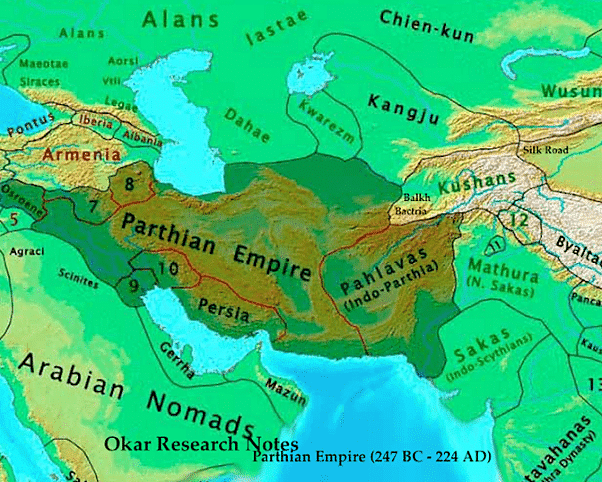
- In many ancient Sanskrit texts, they are mentioned together as the Shaka-Pahlava.
- In fact, they ruled on parallel lines for some time.
- Originally the Parthians lived in Iran, from where they moved to India and in comparison with the Greeks and the Shakas they occupied a small portion of north-western India in the 1st century.
- The most famous Parthian king was Gondophernes (mentioned in an inscription dated 45 CE found at Takht-i-Bahi, recovered from Mardan near Peshawar) in whose reign Saint Thomas came to India to propagate Christianity.
- In due course of time, the Parthians, like the Shakas, became assimilated into Indian society and became an integral part of it. The Kushanas ultimately ousted the successors of Gondophernes from north-west India.

The Parthians were followed by the Kushanas who were also called Yue-Chis (moon tribe) or Tocharians.
- The Kushanas were one of the five clans into which the Yue-Chis tribe was divided.
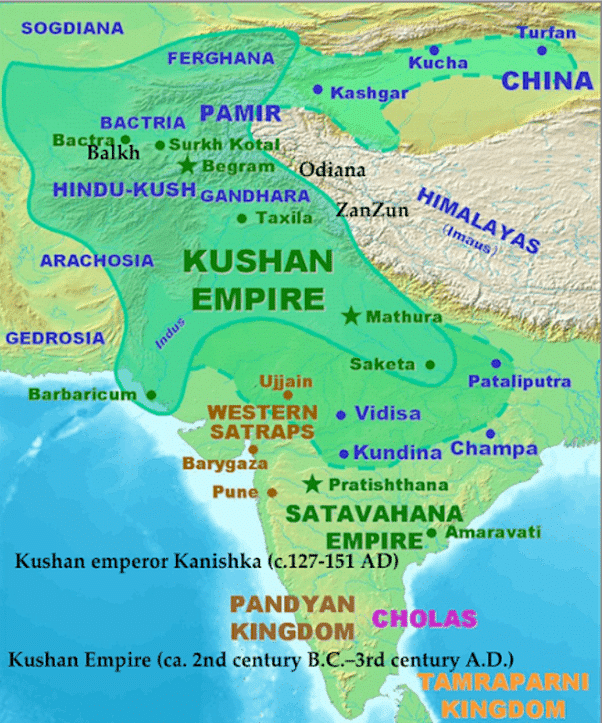
- They were nomadic tribal people who were originally from the steppes of North Central Asia, in the neighbourhood of China.
- They first occupied Bactria or north Afghanistan where they displaced the Shakas, and gradually moved to the Kabul valley and seized Gandhara by crossing the Hindu Kush, replacing the rule of the Greeks and the Parthians in these areas.
- Finally, they set up their authority over the lower Indus basin and the greater part of the Gangetic basin.
- Their empire extended from the Oxus to the Ganga, from Khorasan in Central Asia to Varanasi in Uttar Pradesh.
- A good part of Central Asia, a portion of Iran, a portion of Afghanistan, the whole of Pakistan and almost the whole of northern India were brought under one rule by the Kushanas.
The Kushana dynasty was founded by a house of chiefs called Kadphises.
Kujula Kadphises 1 (15 CE – 64 CE)
- He laid the foundation of a unified Kushana empire by amalgamating the five clans of the Yue-Chi tribe.
- He minted the coins in copper and is believed to have imitated the Roman ‘aurei’ type coins to facilitate trade.
- His coins have been found south of the Hindukush.
- His coins give an idea about his association with Buddhism.
- He adopted the epithet ‘Dharmathida’ and ‘Sachadharmathida’.
Vima Kadphises 2 (64 CE – 78 CE)
- He was the son of Kadphises 1.
- He conquered Gandhara from the Parthians and extended the kingdom to the east of the Indus till Mathura region.
- He issued a large number of gold coins.
- He was a firm devotee of Lord Shiva and proclaimed himself as ‘Mahishvara’ on his coins.
Kanishka (78 CE – 105 CE)
- The most famous Kushan ruler was Kanishka.
- During his reign, the kingdom expanded from Central Asia to Afghanistan and from northwestern India to further east into the Ganga valley and also southwards into the Malwa region. The empire also included Varanasi, Kaushambi, and Shravasti in Uttar Pradesh and Sanchi in Madhya Pradesh. The center of this huge empire was Bactria, as is evident in the use of the Bactrian language in Kanishka’s coins and inscriptions.
- The valuable information about Kanishka is provided by the famous Rabatak inscription (Afghanistan).
- Adopted the title of ‘Devputra’ and on some coins has been shown wearing a peaked helmet.
- His empire had two capitals – the first one was at Purushapura (Peshawar) where Kanishka erected a monastery and a huge stupa to house the Buddha’s relics. The second one was at Mathura in India.
- Kanishka is famous for two reasons:
(i) First, he started an era in 78 CE which is now known as the Shaka era and is used by the government of India for its calendar.
(ii) Secondly, Kanishka extended his whole-hearted patronage to Buddhism. He also convened the fourth Buddhist council to discuss matters relating to Buddhist theology and doctrine. It was held at the Kundalavana monastery near Srinagar (Kashmir) under the presidency of Vasumitra. It was in this council that Buddhism was split into two schools – the Hinayana and the Mahayana. - Kanishka patronized Buddhist scholars of that era like Vasumitra (authored Mahavibhasa), Ashvagosha (wrote the hagiographic Buddhacharita), Charaka (The father of Ayurveda), Nagarjuna (a great advocate of the Mahayana doctrine, and propounded the Madhyamaka which focuses on emptiness or Sunyata).
- Kanishka embraced Buddhism in the early part of his reign. However, his coins exhibit the images of not only Buddha but also of Greek and Hindu Gods. It reflects
- Kanishka’s tolerance towards other religions. Kanishka also patronized the Gandhara and the Mathura schools of sculpture. At Mathura, a headless statue of Kanishka depicting him as a warrior has been found.
Vasudeva (the last Kushana emperor)
- The successors of Kanishka were Vasishka, Huvishka, Kanishka Ⅱ (who adopted the title of ‘Kaiser’) and Vasudeva – the last important Kushana ruler. The Kushana empire was very much reduced in his rule. Around the mid 2nd century he took the title ‘Shaono Shao Vasudevo Koshano’, which reflects that by this time the Kushanas were totally Indianised.
Kushana power gradually declined from the early third century CE. The Kushana empire in Afghanistan and in the area west of the Indus was supplanted by the Sassanian power (of Iran) in the mid-third century CE. But Kushan principalities continued to exist in India for about a century. Some remnants of the Kushanas lingered on in the Kabul valley, Kapisa, Bactria, Khorezm, and Sogdian (identical with Bukhara and Samarkand) in the third-fourth century CE.
The Central Asian influence was felt in almost all spheres and aspects of social life. The Shaka-Kushana phase introduced new elements to trade and agriculture, art and literature, pottery, science and technology, etc.
The detailed impact of Central Asian Contacts on Trade, Architecture, Society are as follows:
- The typical pottery of this age (Shaka-Kushana) was red ware, both in plain and polished form with medium to fine fabric.
- The distinctive pots being sprinklers and spouted channels.
- The age was marked by the construction of brick walls. The use of burnt bricks for flooring and tiles for both roofing and flooring was evident.
- The Shaka-Kushana phase saw the establishment of direct contact between India and Central Asia which helped to develop trade between the two.
- India imported a good deal of gold from the Altai mountains of Central Asia. Gold also may have been received in India through trade with the Roman empire.
- The silk route which started from China and crossed through the empire in Central Asia and Afghanistan to Iran and Western Asia was controlled by the Kushanas.
- This route was a source of great income to the Kushanas and they built a large prosperous empire because of the tolls levied from the traders.
- Although the Indo-Greeks introduced gold coins in India, the Kushans were the first rulers in India to issue gold coins on a large scale.
- The Kushans also promoted agriculture. The archaeological traces of irrigation facilities have been discovered in parts of Afghanistan, Pakistan and Western Central Asia.
- The Shakas and the Kushanas introduced better cavalry and popularised the use of riding horses on a large scale.
- The use of reins, saddles and toe-stirrup made of rope was common in this phase.
- They also introduced tunic, turban, trousers, heavy long coats and long boots which facilitated victories in war.
- The Shakas-Kushanas propagated the idea of the divine origin of kinship.
- The Kushan kings were called sons of god.
- The Kushanas introduced the “satrap system” of government wherein the empire was divided into numerous satrapies and each satrapy was placed under the rule of a Satrap.
- The Indo-Greeks introduced the practice of military governorship wherein they appointed their governors called strategos. Military governors were necessary to maintain the power of foreign rulers over the conquered people.
- The Shakas and the Kushanas added new elements to Indian culture and enriched it immensely.
- They settled in India for good and completely identified themselves with its culture.
- Since they did not have their own script, language or religion, they adopted these elements of culture from India.
- They became completely Indianised in course of time.
- As most of them came as conquerors they were absorbed in Indian society as a warrior class, Kshatriyas.
- The lawgiver Manu stated that the Shakas and the Parthians were the Kshatriyas who had fallen from their status and were thus considered as second-class Kshatriyas.
- In no other period of ancient history were foreigners assimilated into Indian society on such a large scale as they were in the post-Maurya period.
- Some of the foreign rulers converted to Vaishnavism (worshipped Vishnu – the god of protection and preservation).
- The Greek ambassador Hellodorus set up a pillar in honour of Vishnu near Vidisha in Madhya Pradesh.
- A few others adopted Buddhism, as in the case of the Greek ruler Menander who became a Buddhist.
- The Kushana rulers worshipped both Shiva and the Buddha as is evident from the images of these two gods on the Kushana coins.
- The origin of Mahayana Buddhism: The Central Asian contacts also influenced the Indian religions especially Buddhism.
- Buddhism in its original form was too puritanical and abstract for foreigners.
- They did not appreciate the philosophical doctrines of Buddhism, emphasized by the existing Buddhist schools.
- So, there developed a new form of Buddhism called the Mahayana or the Great Wheel, in which the image of the Buddha began to be worshipped.
- This sect opened its doors for all sections of people.
- Those who did not follow this sect (newly found) came to be known as the followers of the Hinayana sect or the Small Wheel.
- Kanishka was a great patron of the Mahayana form of Buddhism who not only organised the fourth Buddhist council at Srinagar but also set up many stupas to perpetuate the memory of the Buddha.
The construction of stupas and the development of regional schools of sculpture are the two main features concerning the art and architecture of this period.
- Stupas: A stupa is a large hemispherical dome having a central chamber in which relics of the Buddha or some Buddhist monk are kept in a small casket. The base is surrounded by a path for clockwise circumambulation (pradakshina), enclosed by wooden railings which were later made in stone. The three main stupas of this period are at Bharhut (dates to the middle of the second century, its railings are made of red stone), Sanchi (three big stupas were constructed at Sanchi, the biggest one was originally made by Ashoka, which was enlarged to twice its size in the second century), and Amravati and Nagarjunkonda (Andhra Pradesh).
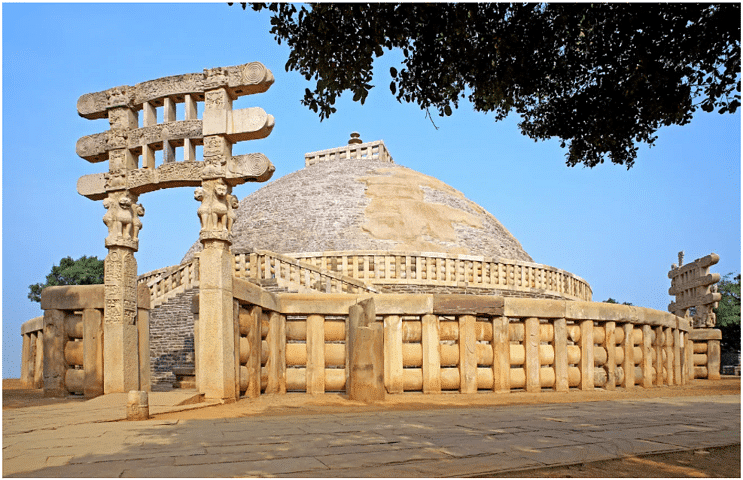
- Schools of Sculpture: The Central Asian rulers became enthusiastic patrons of Indian art and culture and showed great zeal in establishing new schools of art. The Kushana empire brought together masons and other artisans trained in different schools and countries. Indian craftsmen came into contact with the Greeks and the Romans, especially in the north-western frontier of India in Gandhara. The three main schools of sculptural art which developed in this period were – Gandhara school of Art, Mathura school of Art and Amravati school of Art.
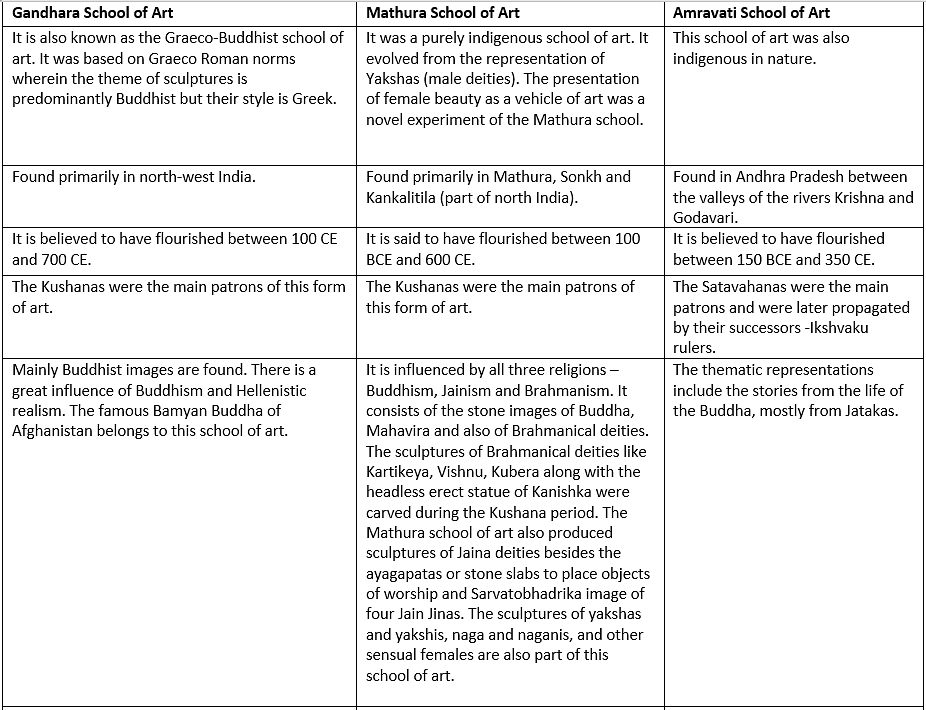

- The Central Asian rulers patronized and cultivated the Sanskrit language.
- The earliest specimen of the Kavya style is found in the inscription of Rudradaman in Kathiawar.
- Some of the great creative writers such as Asvaghosha enjoyed the patronage of the Kushanas.
(i) Asvaghosha wrote the Buddhacharita, which is a biography of the Buddha.
(ii) He also composed Saundarananda, which is an example of Sanskrit Kavya. - The progress of Mahayana Buddhism led to the composition of numerous avadanas and these texts were written in Buddhist hybrid Sanskrit and the main objective of these texts was to preach the teachings of Mahayana Buddhism.
(i) Some of the important books of this genre were the Mahavastu and the Divyavadana.
(ii) The Greeks also contributed to the development of the Indian theatre, by introducing the use of the curtain, which was called Yavanika.
(iii) The Kamasutra (earliest erotic work on sex and lovemaking) was composed during this time by Vatsyayana and is considered the best example of secular literature of this period.
- Indian astrology and astronomy profited from the contacts with the Greeks.
- The term ‘horasastra’ used for astrology in Sanskrit was derived from the Greek term ‘horoscope’.
- For cure of ailments, the ancient Indian physicians relied mainly on plants which are ‘oshadi’ in Sanskrit and as a result medicine was named ‘aushadhi’.
- The Greeks contributed much to the development of medicine, botany and chemistry.
- It seems that the process of making leather objects (boots) began during this period.
- The copper, gold coins were an imitation of Roman coins.
- Working in glassmaking during this period was especially influenced by foreign practices and in no other period in India did glass making make such progress as it did during this time.
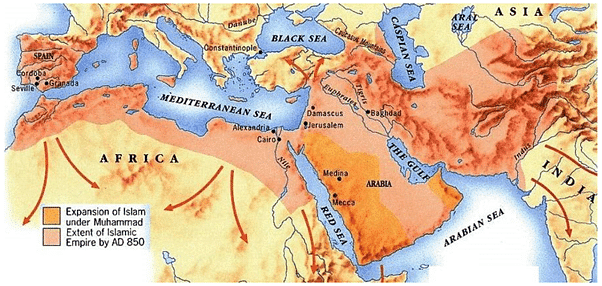
- The first incursion by the new Muslim successor states of the Persian Empire occurred around 664 CE during the Umayyad Caliphate, led by Mohalib towards Multan in Southern Punjab, in modern-day Pakistan.
- Mohalib’s expeditions were not aimed at conquest, though they penetrated only as far as the capital of the Maili, he returned with wealth and prisoners of war.
- This was an Arab incursion and part of the early Umayyad push onwards from the Islamic conquest of Persia into Central Asia, and within the limits of the eastern borders of previous Persian Empires.
- During the Khaliphate of Omar, Arab forces made fertile attempts to get Bombay.
- Arabs captured Sindh in 712 AD.
- The Arab conquest of Sindh was led by Muhammed Bin Kassim.
- Muhammed Bin Khasim was the nephew of Al- Hajaj, the governor of the Arab province of Basra.
- Dahir, a Brahmin was the ruler of Punjab at that time. He was killed by Kassim.
- The Arabs lost control over Sindh in 779 AD.
- Arab conquest of Sindh resulted in the spread of Islam to North India.
- But Islam was first introduced in India by Malik Ibn Dinar in Kerala in 644 AD.
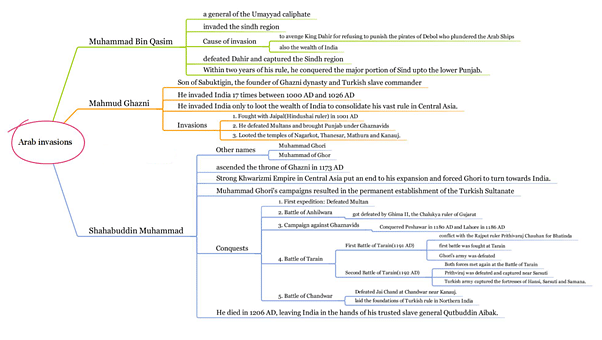
- Ghazni in Afghanistan was ruled by a Turkish family called Gamini of the Ghaznavid dynasty.
- Muhammed Ghazni was the first Turkish conqueror of North India.
- Muhammad Ghazni’s father was Subu ktigin.
- He attacked India only for want of wealth.
- He attacked India seventeen times between 1000 and 1027 AD. He made all the raids in the guise of Jihad.
- First Invasion was in 1001 AD.
- He defeated Jaipal and Anandpal of the Shahi dynasty in 1001 and 1009 respectively.
- The most important raid of Muhammed was the Somanath expedition. It was in 1025. He completely destroyed the temple. Somanath Temple was on the sea coast of Gujarat.
- Muhammed Ghazni died on 30th April 1030.
- Later his son Masud attacked India and captured Kashmir.
- The famous Persian poet Firdausi who wrote ‘Shahnama’ (The Book of Kings) lived in his court.
- Alberuni, an Arab Historian, who wrote Tarikhul- Hind (Reality of Hindustan), accompanied Muhammed Ghazni to India.
- Al-Firdausi is known as ‘Indian Homer’, ‘Persian Homer’, or ‘The Immortal Homer of the East’.
- Muhammed of Ghore attacked India between 1175 and 1206 AD.
- Muhammed Ghori made his first expedition to India and captured Multan in 1175 AD.
- In the First Battle Tarain in 1191 (near Taneswar) Muhammed Ghori was defeated by the Rajput forces under Prithviraj Chauhan III.
- In the Second Battle of Tarain (1192 AD) Muhammed Ghori assisted by Qutub-ud-din Aibek a slave, defeated Prithviraj Chauhan III and killed him.
- In 1193 Muhamed Ghori attacked Jaichand, father in law of Prithviraj. III at Kanauj, Jaichand was defeated.
- Muhammed Ghori returned from India by intrusting his territories in India in the hands of Qutub- Uddin Aibak.
- After the death of Ghori in 1206 Aibek founded the Slave Dynasty.
- Muhammed Ghori's Indian invasion resulted in the foundation of Islamic rule in India.
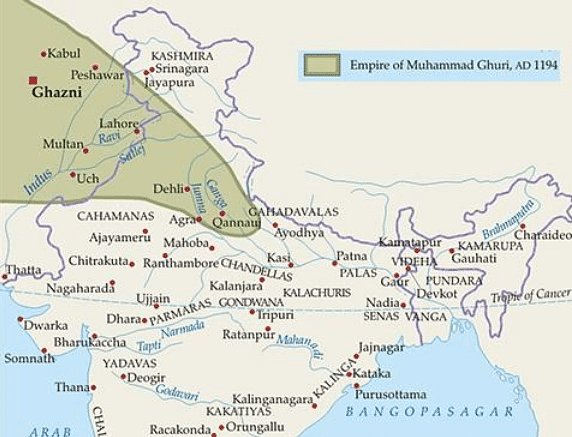
- The first attack of Arabs under Ubaidullah failed. He was defeated and killed, After this, a series of expeditions were sent to conquer an outpost of Sindh, which all ended in failure.
- Then Hajjaj made elaborate preparation for the attack on Sindh and sent a powerful army under the command of his nephew and son-in-law Muhammad bin Qasim in 711 AD with 6000 horses, 6000 camels, 3000 animals loaded with equipment and a large infantry.
- Muhammad bin Qasim proceeded towards Sindh through Makarana and first conquered Debel where he received fresh reinforcement sent by Hjjaj through the sea.
- Sind, a principality on the shores of the Arabian Sea and the lower reaches of the Indus, was invaded from the sea by the Muslims in 711.
- The seaport of Daibul fell first, then several towns on the banks of the Indus, including Arur, the capital. Finally, in 713, the Arabs took Multan and the conquest was complete. The fall of Sindh opened the way to the markets of Central Asia.

- The Ghaznavid Dynasty was founded after the Turk slaves reached higher posts, such as commanders-in-chief, in the Samanid court; they then took over the state of Khorasan.
- The real founder of the Ghaznavid Dynasty is, in fact, Sabuktigin. It was in his time that the Ghaznavid sovereignty expanded.
- Mahmud Ghazni was Son of Sabuktigin, the founder of Ghazni dynasty & Turkish slave commander.
- In all Mahmud Ghazni invaded India 17 times during AD 1000–1026.
- Mahmud Ghazni first encountered the Hindushai ruler, Jaipal in AD 1001.
- In the years AD 1004–06 Mahmud Ghazni attacked the rulers of Multan.
- Soon Punjab also passed into the hands of the Ghaznavids. Between AD 1014–1019, Mahmud enriched his treasury by looting the temples of Nagarkot, Thanesar, Mathura and Kanauj.
- The attack against Nagarkot in AD 1008 has been described as his first great triumph.
- In AD 1025, Mahmud embarked on the most ambitious Indian campaign, the attack on the Somnath temple in Saurashtra.
- Mahmud captured the city after a grim struggle in which more than 50,000 defenders lost their lives.
- Mahmud left Somnath after a fortnight when he came to know that the Gujarat king Bhima-I had completed preparations to confront him.
- His attacks on India were an attempt to fulfil his ambition to make Ghazni the formidable power in the politics of Central Asia.
- Mahmud’s raids into India were only to acquire the famous wealth of India.
- This wealth would help him to consolidate his vast rule in Central Asia.
- He did not wish to establish an empire in India.
- The Ghaznavids had their control on parts of Punjab and Sind which continued till AD 1135.
- However, his invasions exposed the weak defence of Indian kingdoms. They also opened the possibility of attacks in future by the Turks.
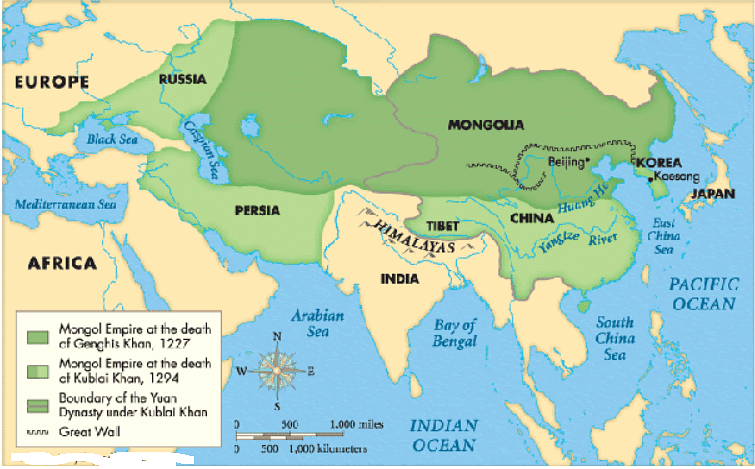
- During Sultan Qutb-ud-din Aibak’s time, the Mongols, appeared in the East of India and emerged as a great power under the leadership of Genghiz Khan (1165-1227).
- He was born in 1165 to Yesugei and Hoelun.
- He was brought up by his ablest mother Hoelun after his father was poisoned to death by Tatars.
- In his incessant wars, he exhibited such remarkable traits of heroism and diplomacy that led him to transform the entire social and military structure of Mongolia.
- The Mongol troops had a strict code of discipline and harsh penalties for infringements of regulations.
- The Mongol hordes were divided in units of 10, 100, 1,000, and 10,000 soldiers (known as an arban, jagun, minghan and tümen respectively; the latter corresponds to a modern regiment).
- Under this system fighters from different tribes were united in unified military formations, whose chief strategy was to “march divided, attack united,” and the strategies used were based on large-scale skirmish manoeuvres that helped the Mongols defeat numerically superior but fragmented forces from the Oxus to the Volga.
- While chasing Jalal-ud-Din Khwarzam Shah (Ruler of Khwarazmian dynasty), Genghiz Khan stormed Afghanistan and the territories nowadays parts of Pakistan.
- Initially, Jalal-ud-Din defeated an advanced Mongol army with the help of the Afghan fighters.
- However, after the coming of Genghiz Khan, Jalal-ud-Din left Ghazni and entered the areas of the Delhi Sultanate and encamped at the west bank of river Indus.
- In December 1221 AD, Genghiz Khan followed him and crushed his army while he fled crossing the Indus waters.
- He was given refuge by the Delhi Sultan. Genghiz Khan marched back due to the hot summer.
- But on his way back he devastated present-day Punjab, Afghan borderland, Ghazni and Herat.
- In 1235 Mongol force invaded Kashmir, stationing a darughachi (administrative governor) there for several years, and Kashmir became a Mongolian dependency.
- In 1285 AD, the Mongols invaded Multan and killed Prince Muhammad Khan.
- During the reign of Ala-ud-din Khilji, Mongols invaded the country several times but were successfully repulsed.
- From these invasion Alla-ud-din Khilji learnt the lessons of keeping himself prepared, by fortifying and organizing his armed forces.
- The invasion of Mongol ruler Timur in 1398 A.D. sealed the fate of the Tughluq dynasty.
- Muhammad fled and Timur captured the city and destroyed many temples in north India.
- Thousands of people were killed and Delhi was plundered for fifteen days, Timur returned to Samarkhand carrying away a large amount of wealth with him.
A few important points about the Persian Invasion of India:
- Cyrus, the founder of the Achaemenid Empire in ancient Iran invaded the North-Western front of India in 550 BCE.

- At that time, there were many small provinces like Gandhara, Kamboja, and Madra who were constantly fighting one another.
- At that time, Bimbisara of the Haryanka dynasty was ruling over Magadha.
- Cyrus succeeded in bringing under Persian control all the Indian tribes west of the Indus like Gandhara.
- Punjab and Sindh were annexed by Darius I, Cyrus’s grandson.
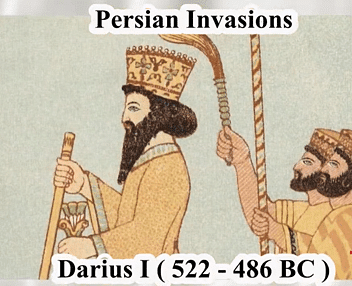
- Son of Darius, Xerxes, could not move ahead with the further conquest of India because of war with the Greeks. He had employed Indian cavalry and infantry.
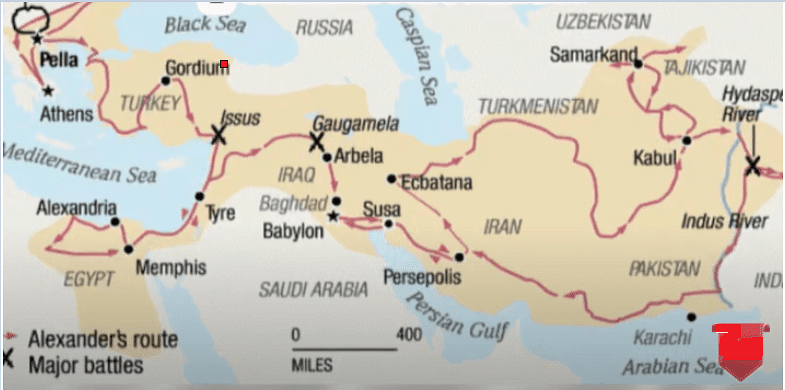
- The Indo-Iranian contact lasted for about 200 years. It gave an impetus to the Indo-Iranian trade and commerce.
- Iranian coins are also found in the northwestern frontier which points to the existence of trade with Iran.
- The Kharoshti script was brought to northwest India by the Persians.
- Some inscriptions of Ashoka were written in the Kharoshti script in these parts.
- Kharoshti script is derived from the Aramaic script and is written from right to left.
- Probably, the rock inscriptions used by Ashoka in the 3rd century BCE were inspired by the Persian king Darius. The monuments of Ashoka’s time, especially the bell-shaped capitals and the preamble of Ashoka’s edicts, have a lot of Iranian influence.
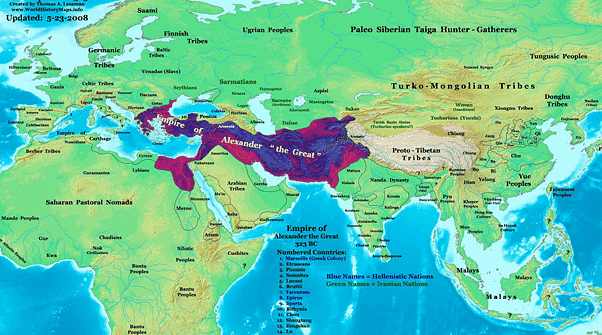
- Alexander (356 BCE – 323 BCE) was the son of Philip of Macedonia.
- He became king in 336 BCE.
- At that time, i.e., in the fourth century BCE, the Greeks and the Iranians were fighting for the supremacy of the world.
- Alexander had conquered Asia Minor along with Iran and Iraq. He then marched into northwest India from Iran.
- He had annexed the whole of Persia (Babylon) by defeating Persian King Darius III in the Battle of Arbela (330 BC).
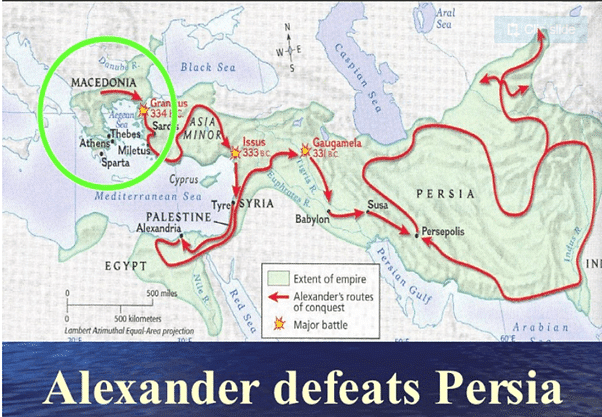
- Alexander was attracted to India’s wealth. Apart from that, he was also believed to have a strong passion for geographical inquiry and natural history.
- In northwest India, just before Alexander’s invasion, there were many small rulers like Ambhi of Taxila and Porus of the region of Jhelum (Hydaspes).

- Ambhi accepted Alexander’s sovereignty but Porus put up a valiant but unsuccessful fight.
- Alexander was so impressed with Porus’s fight that he granted him his territory back. Porus might have accepted lordship. The battle between him and Porus is called the Battle of Hydaspes.
- After that, Alexander’s army crossed the river Chenab and annexed the tribes between Ravi and Chenab.
- But his army refused to cross the river Beas and revolted. They were exhausted after years of battles, were homesick and diseased.
- Alexander was forced to retreat in 326 BCE. On his way back, he died at Babylon in 323 BCE aged 32.
- His dream of an eastern empire remained unfulfilled. To mark the farthest point of his advance, he erected twelve huge stone altars on the northern banks of Beas. He remained in India for 19 months.
- After his death, the Greek Empire split in 321 BCE.
- In northwest India, Alexander left four of his generals in charge of four regions, one of them being Seleucus I Nicator, who would later trade his territories in the Indus Valley with Chandragupta Maurya.
- Eudamas was the last General of Alexander in India.
- Alexander’s invasion augmented political unification in northern India under the Mauryas. The destruction of the small states in north-west India by Alexander aided the Mauryan empire’s easy expansion and also encouraged the Mauryas to capture the northwestern frontier of India.
- The most important result of this invasion was the establishment of direct contact between India and Greece in different fields. Alexander’s invasion opened up four distinct routes – three by land and one by sea and these routes paved the way for Greek merchants and craftsmen to establish trade between India and Greece.
- Alexander’s historians have left clearly dated records of Alexander’s campaign, which have enabled to build of the Indian chronology for subsequent events on a definite basis. They have given important information about the social and economic conditions of that period. There is the mention of the sati system, the sale of girls at marketplaces by poor parents and the fine breed of oxen in northwest India. Alexander sent 200,000 oxen to Macedonia for use in Greece. The historical records tell us about the most flourishing craft of that time – carpentry. Chariots, boats and ships were built by carpenters.

- Post the invasion there were Indo-Greek rulers in the northwest part of India.
- Some of the Greek settlements continued to live in northwest India, under both Chandragupta Maurya and Ashoka. The most important of them was the city of Alexandria in the Kabul region, Bonkephala on the Jhelum and Alexandria in Sindh.
- Grecian impact on Indian art can be seen in the Gandhara school of art.
Spread of Civilization in Eastern India:
A region is considered civilized if its people know the art of writing, have a system of collecting taxes and maintaining law and order, and possess social classes and specialists for performing priestly, administrative and producing functions.
- Above all, a civilized society is able to produce enough to sustain not only the actual producers comprising artisans and peasants but also consumers who are not engaged in production. A combination of these elements makes for civilization.
- The period from the fourth to the seventh century is remarkable for the diffusion of an advanced rural economy, formation of state systems, and delineation of social classes in eastern MP, Orissa, eastern Bengal, southeast Bengal, and Assam.
- Kalinga, or coastal Orissa south of the Mahanadi, rose to importance under Ashoka, though a strong state had been founded in that area in the first century BC. Its ruler, Kharavela had advanced as far as Magadha.
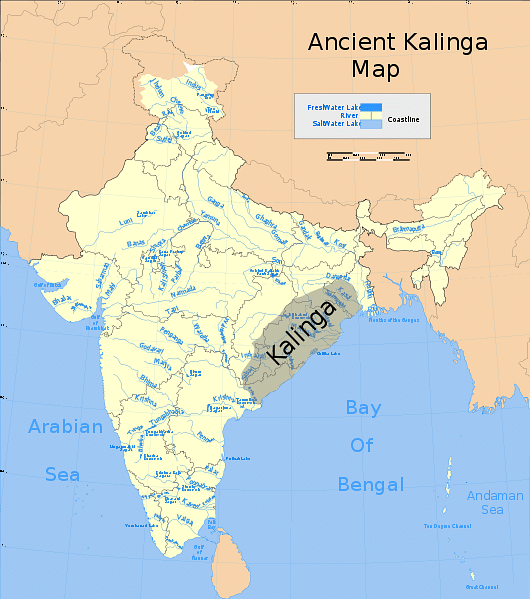
- In the first and second centuries AD, the ports of Orissa conducted a brisk trade in pearls, ivory, and muslin. Excavations at Shishupalgarh, the site of Kalinganagari, of Kharavela’s capital at a distance of 60 km from Bhubaneswar, yielded several Roman objects indicating trade contacts with the Roman empire.
- However, the greater part of Orissa, particularly north Orissa, neither experienced state formation nor much commercial activity. In the fourth century, Kosala and Mahakantara figured in the list of the regions conquered by Samudragupta and covered parts of northern and western Orissa.
- The most important was the state of the Matharas, also known as Pitribhaktas, who at the peak of their power dominated the area between the Mahanadi and the Krishna. Their contemporaries and neighbors were the Vasishthas, the Nalas, and the Manas.
- The Vasishthas ruled on the borders of Andhra in south Kalinga, the Nalas in the forest area of Mahakantara, and the Manas in the coastal area in the north beyond the Mahanadi. Each state developed its system of taxation, administration, and military organization.
- The Nalas, and probably the Manas, also evolved their system of coinage. The find of Nala gold coins in the tribal Bastar area in MP is significant. It presupposes an economic system in which gold money was used in large transactions, and served as a medium of payment to high functionaries.
- The Matharas created a district called Mahendrabhoga in the area of the Mahendra mountains, and also ruled over a district called Dantayavagubhoga, which apparently supplied ivory and rice-gruel to its administrators though it had been created in a backward area.
- The Matharas made endowments called agraharas, which consisted of land and income from villages and were meant to support the religious and educational activities of the brahmanas. Some agraharas had to pay taxes although elsewhere in the country they were tax-free.
- In coastal Orissa, writing had certainly been known since the third century BC, and inscriptions up to the mid-fourth century AD were written in Prakrit, but from about AD 350 onwards Sanskrit began to be used.
- As regards Bengal, parts of north Bengal, now in Bogra district, provide evidence of the prevalence of writing during Ashoka’s reign. An inscription indicates several settlements maintaining a storehouse filled with coins and food grains for the upkeep of Buddhist monks.
- Also, people of this area knew Prakrit and professed Buddhism. Similarly, an inscription found in the coastal district of Noakhali in south-east Bengal indicates that the people of the area knew Prakrit and the Brahmi script in the second century BC.
- In about the middle of the fourth century, a king with the title ‘maharaja’ ruled in Pokharna on the Damodara in Bankura district. He knew Sanskrit and was a devotee of Vishnu, for whose worship he possibly granted a village.
- The area situated between the Ganges and the Brahmaputra now covering Bangladesh emerged as a settled and fairly Sanskrit-educated region in the fifth and sixth centuries. The Gupta governors, who seem to have become independent after about AD 550, occupied North Bengal; some part of it may also have been seized by the rulers of Kamarupa.
- Local vassal princes called Samanta maharajas had created their own administrative apparatus and built their military organization. By AD 600 the area came to be known as Gauda and functioned as an independent state ruled by Shashanka, Harsha’s adversary.
- For a century from AD 432–3 a series of land sale documents recorded on copperplates in Pundravardhanabhukti, which covered almost the whole of North Bengal, now mostly in Bangladesh. Most of the land transactions indicate that land was purchased with gold coins called Dinara.
- The deltaic portion of Bengal formed by the Brahmaputra and called Samatata, which was made to acknowledge the authority of Samudragupta in the fourth century, covered south-east Bengal. From about AD 525 onwards, the area developed a fairly organized state covering Samatata and a portion of Vanga which lay on the western boundary of Samatata. It is called the kingdom of Samatata or Vanga whose rulers, including Sama Haradeva, issued a substantial number of gold coins in the second half of the sixth century.
- In addition to this state, in the seventh century, there existed the state of the Khadgas, literally swordsmen, in the Dhaka area. There was also the kingdom of a brahmana feudatory called Lokanatha and that of the Ratas, both in the Comilla area. All these princes of south-east and central Bengal issued land grants in the sixth and seventh centuries.
- A fiscal and administrative unit called Dandabhukti was formed in the border areas between Bengal and Orissa. Danda means punishment, and bhukti The unit was apparently to pacify and suppress the tribal inhabitants of that region and may have promoted Sanskrit and other elements of culture in the tribal areas. This was also true of Vardhamanabhukti (Burdwan).
- In south-east Bengal in the Faridpur area, five plots of land granted to a Buddhist monastery were declared waste and water-logged and they paid no tax to the state. Similarly, 200 Brahmanas were given a large area in Comilla district within a forest region full of deer, boars, buffaloes, tigers, serpents, and the like. All such instances are sufficient proof of the progress of colonization and civilization in new areas.
- The fifth to seventh centuries also saw the formation of about half a dozen states, some large and others small; some independent and others feudatory. However, each had its victory or military camp where it maintained its infantry, cavalry, elephants, and boats. Each had its fiscal and administrative districts with its machinery for tax collection and maintenance of order.
- The number of endowments had increased to such a degree that eventually an officer called agraharika had to be appointed to look after them.
- Kamarupa, coterminous with the Brahmaputra basin running from east to west, shot into prominence in the seventh century. Excavations, however, show settlements in Ambari near Guwahati from the fourth century of the Christian era.
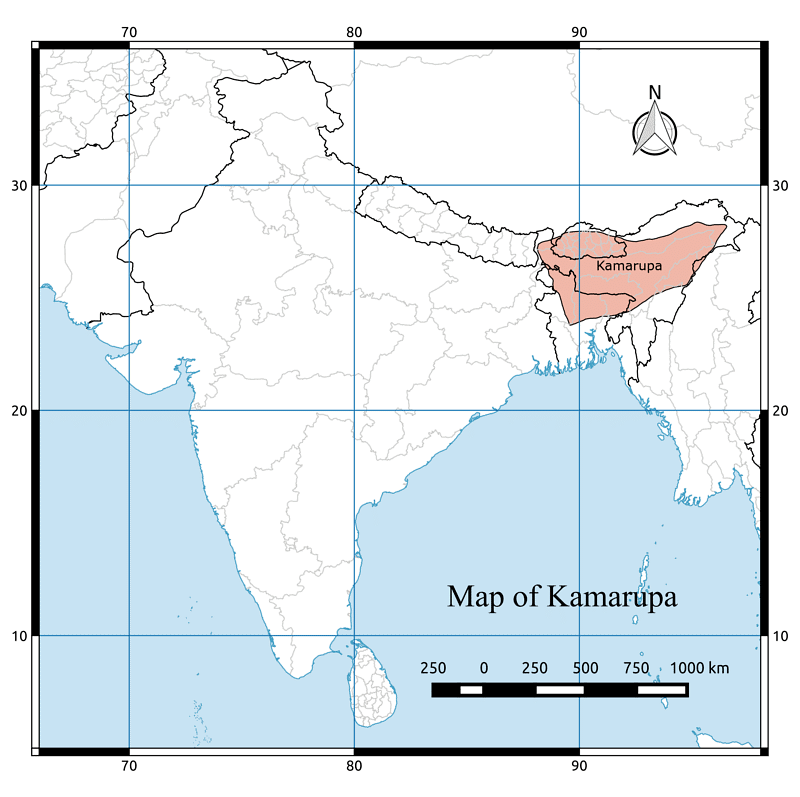 Map of Kamarupa Kingdom
Map of Kamarupa Kingdom
- In the same century, Samudragupta received tributes from Davaka and Kamarupa. Davaka possibly accounted for a portion of the Nowgong district, and Kamarupa covered the Brahmaputra basin.
- The Ambari excavations near Guwahati show that settlements were fairly developed in the sixth and seventh centuries, and this is supported by inscriptions. By the beginning of the sixth century, the use of Sanskrit and the art of writing are clearly in evidence.
- The Kamarupa kings adopted the title varman, which obtained not only in northern, central, and western India but also in Bengal, Orissa, Andhra, Karnataka, and Tamil Nadu. This title, which means armor and symbolizes a warrior, was given to the Kshatriyas by Manu.
- Buddhism also acquired a foothold, and the Chinese traveler Hsuan Tsang (Hieun Tsang) visited this state.
- Cultural contacts with the Gupta empire stimulated the spread of civilization in the eastern zone. North Bengal and northwest Orissa came under Gupta rule; in other areas of these regions, the Gupta influence can be inferred from the use of the Gupta era dates in inscriptions.
- In Bengal new states were formed by feudatories, who maintained a substantial number of elephants, horses, boats, etc., in their military camps. For the first time, the fifth and sixth centuries clearly show large-scale writing, the use of Sanskrit, the formation of a varna society, and the growth of Buddhism and Brahmanism in the form of Shaivism and Vaishnavism in this area.
- The decline and fall of the Gupta empire, therefore, coincided with considerable progress in the outlying regions. Many obscure areas, which were possibly ruled by tribal chiefs and were thinly settled, came into the limelight.
- This applied to the red soil areas of West Bengal, north Orissa, and the adjoining areas of MP, which formed part of Jharkhand and were difficult to cultivate and settle. It applied even more to the jungle areas with alluvial soil and heavy rainfall in Bangladesh and to the Brahmaputra basin.
- A region is considered to be civilized if its people know writing, set up a system for collecting taxes, and maintaining order, form social classes and produce specialists for performing priestly, administrative, and production functions.
- Above all, a civilized society is able to produce enough to sustain not only the actual producers comprising artisans and peasants but also consumers who are not engaged in production.
- A combination of these elements makes for civilization.
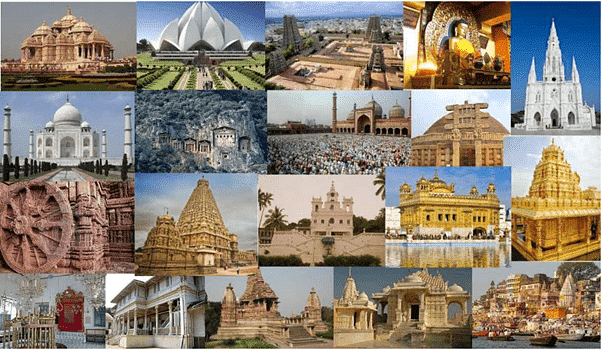
- They were apparent in a recognizable form very late in a large part of eastern India.
- Virtually no written records have been found in the greater portions of eastern MP and the adjoining areas of Orissa, West Bengal, Bangladesh, and Assam that relate to a period prior to the mid-fourth century AD.
- The period from the fourth to the seventh century is remarkable for the diffusion of an advanced rural economy, formation of state systems, and delineation of social classes in eastern MP, Orissa, eastern Bengal, southeast Bengal, and Assam.
- This is indicated by the distribution of a substantial number of Sanskrit inscriptions in these areas in Gupta times.
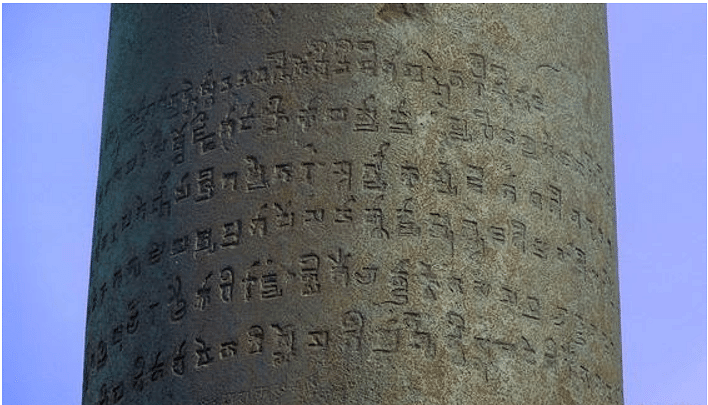 Gupta: Brahmi Sanskrit Inscription
Gupta: Brahmi Sanskrit Inscription
- Many inscriptions are dated to the Gupta era and appear in the form of land grants made by feudatory princes and others for religious purposes to Brahmanas, Vaishnavite temples, and Buddhist monasteries.
- These beneficiaries played an important role in spreading and strengthening the elements of an advanced culture. The process can be understood by attempting a survey by region.
- Kalinga, or coastal Orissa south of the Mahanadi, rose to importance under Ashoka, though a strong state had been founded in that area in the first century BC. Its ruler, Kharavela had advanced as far as Magadha.
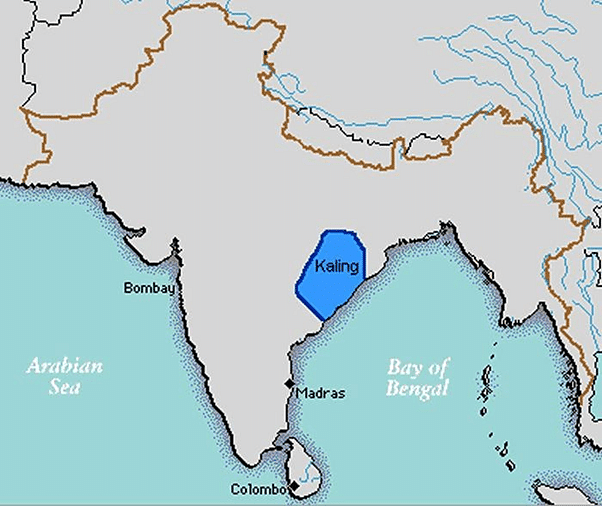
- In the first and second centuries AD, the ports of Orissa conducted a brisk trade in pearls, ivory, and muslin.
- Excavations at Shishupalgarh, the site of Kalinganagari, of Kharavela’s capital at a distance of 60 km from Bhubaneswar, yielded several Roman objects indicating trade contacts with the Roman empire.
- However, the greater part of Orissa, particularly north Orissa, neither experienced state formation nor much commercial activity. In the fourth century, Kosala and Mahakantara figured in the list of the regions conquered by Samudragupta and covered parts of northern and western Orissa.
- From the second half of the fourth century to the sixth century, several states were formed in Orissa, and at least five of them can be clearly identified.
- The most important of those was the state of the Matharas, also known as Pitribhaktas, who at the peak of their power dominated the area between the Mahanadi and the Krishna.
- Their contemporaries and neighbours were the Vasishthas, the Nalas, and the Manas.
- The Vasishthas ruled on the borders of Andhra in south Kalinga, the Nalas in the forest area of Mahakantara, and the Manas in the coastal area in the north beyond the Mahanadi.
- Each state developed its system of taxation, administration, and military organization.
- The Nalas, and probably the Manas, also evolved their system of coinage.
- Each kingdom favoured the brahmanas with land grants and even invited them from outside, and most kings performed Vedic sacrifices not only for spiritual merit but also for power, prestige, and legitimacy.
- During this period elements of advanced culture were not confined to the coastal belt known as Kalinga, but were also apparent in the other parts of Orissa.
- The find of Nala gold coins in the tribal Bastar area in MP is significant. It presupposes an economic system in which gold money was used in large transactions, and served as a medium of payment to high functionaries. Similarly, the Manas seem to have issued copper coins, which implies the use of metal money even by artisans and peasants.
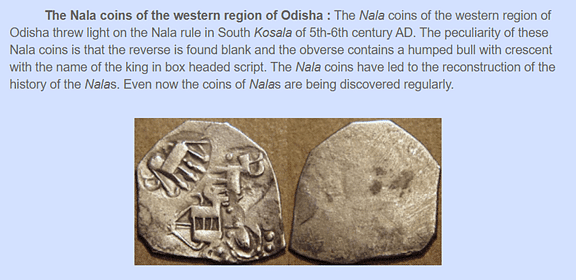
- The various states added to their income by forming new fiscal units in rural areas.
- The Matharas created a district called Mahendrabhoga in the area of the Mahendra mountains, and also ruled over a district called Dantayavagubhoga, which apparently supplied ivory and rice-gruel to its administrators though it had been created in a backward area.
- The Matharas made endowments called agraharas, which consisted of land and income from villages and were meant to support the religious and educational activities of the brahmanas.
- Some agraharas had to pay taxes although elsewhere in the country they were tax-free.
- The induction of the brahmanas through land grants in tribal, forest, and red soil areas brought new lands under cultivation and introduced better methods of agriculture, based on a better understanding of weather conditions.
- Formerly the year was divided into three units, each of four months, and time was reckoned on the basis of three seasons.
- Under the Matharas, in the mid-fifth century, people began the practise of dividing the year into twelve lunar months.
- This implied a sound idea of weather conditions which was useful for agricultural operations.
- In coastal Orissa, writing had certainly been known since the third century BC, and inscriptions up to the mid-fourth century ad were written in Prakrit, but from about ad 350 onwards Sanskrit began to be used.
- What is more significant, charters in this language appear outside the coastal belt beyond the Mahanadi in the north.
- Thus, the art of writing and the use of the Sanskrit language spread over a substantial part of Orissa, and some of the finest Sanskrit verses have been found in the epigraphs of the period.
- Sanskrit served as the vehicle not only of brahmanical religion and culture but also of property laws and social regulations in the new area.
- Verses from the Puranas and Dharmashastras are quoted in Sanskrit charters, and kings claim to be the preservers of the varna system. The affiliation of the people to the culture of the Gangetic basin is emphasized.
- A dip in the Ganges at Prayag at the confluence of the Ganges and the Yamuna was considered holy, and victorious kings visited it.
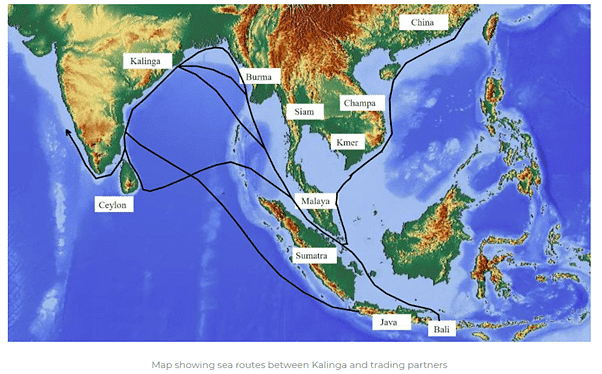
- As regards Bengal, parts of north Bengal, now in Bogra district, provide evidence of the prevalence of writing during Ashoka’s reign.
- An inscription indicates several settlements maintaining a storehouse filled with coins and food grains for the upkeep of Buddhist monks.
- Clearly, the local peasants could spare a part of their produce to pay taxes and make gifts.
- Also, people of this area knew Prakrit and professed Buddhism.
- Similarly, an inscription found in the coastal district of Noakhali in south-east Bengal indicates that the people of the area knew Prakrit and the Brahmi script in the second century BC.
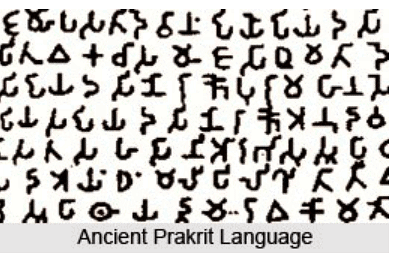
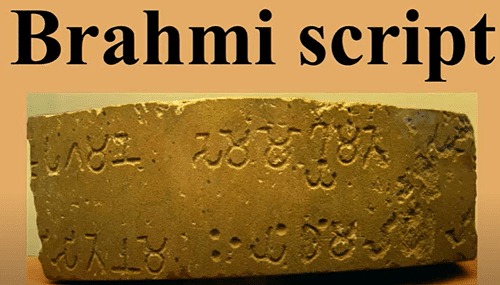
- However, for the greater part of Bengal, we do not hear anything until up to the fourth-century ad.
- In about the middle of the fourth century, a king with the title ‘maharaja’ ruled in Pokharna on the Damodara in Bankura district. He knew Sanskrit and was a devotee of Vishnu, for whose worship he possibly granted a village.
- The area situated between the Ganges and the Brahmaputra now covering Bangladesh emerged as a settled and fairly Sanskrit-educated region in the fifth and sixth centuries.
- The Gupta governors, who seem to have become independent after about AD 550, occupied north Bengal; some part of it may also have been seized by the rulers of Kamarupa.
- Local vassal princes called samanta maharajas had created their own administrative apparatus and built their military organization consisting of horses, elephants, foot soldiers, and boats to fight the local peasantry.
- By AD 600 the area came to be known as Gauda and functioned as an independent state ruled by Shashanka, Harsha’s adversary.
- For a century from AD 432—3 we notice a series of land sale documents recorded on copperplates in Pundravardhanabhukti, which covered almost the whole of north Bengal, now mostly in Bangladesh.
- Most of the land transactions indicate that land was purchased with gold coins called Dinara. However, once land was given for religious purposes, the donees did not have to pay any tax.
- The land transactions show the involvement of leading scribes, merchants, artisans, landed classes, and the like in local administration, which was manned by governors appointed by the Gupta emperors.
- The land sale documents not only indicate the existence of different social groups and local functionaries but also shed valuable light on the expansion of agriculture.
- Generally, land purchased for religious endowments is described as fallow, uncultivated and, therefore, untaxed.
- Without a doubt, the effect of the grants was to bring such plots of land within the purview of cultivation and settlement.
- The deltaic portion of Bengal formed by the Brahmaputra and called Samatata, which was made to acknowledge the authority of Samudragupta in the fourth century, covered south-east Bengal.
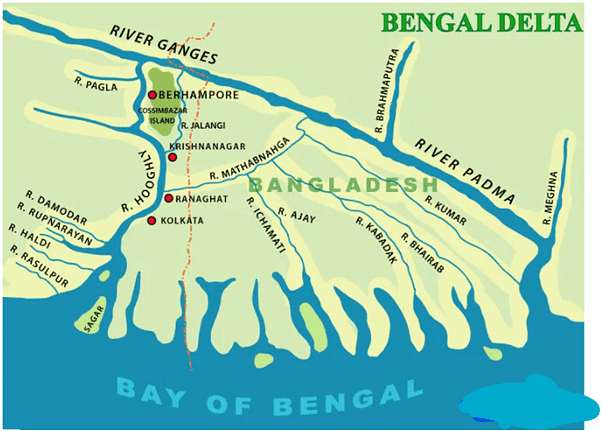
- A part of this territory may have been populated and important enough to attract the attention of the Gupta conqueror. However, possibly it was not ruled by brahmanized princes, and consequently it neither used Sanskrit nor adopted the varna system as was the case in north Bengal.
- From about AD 525 onwards, the area developed a fairly organized state covering Samatata and a portion of Vanga which lay on the western boundary of Samatata.

- It is called the kingdom of Samatata or Vanga whose rulers, including Sama Haradeva, issued a substantial number of gold coins in the second half of the sixth century.
- In addition to this state, in the seventh century, there existed the state of the Khadgas, literally swordsmen, in the Dhaka area.
- There was also the kingdom of a brahmana feudatory called Lokanatha and that of the Ratas, both in the Comilla area. All these princes of southeast and central Bengal issued land grants in the sixth and seventh centuries.
- Like the Orissa kings, they too created agraharas.
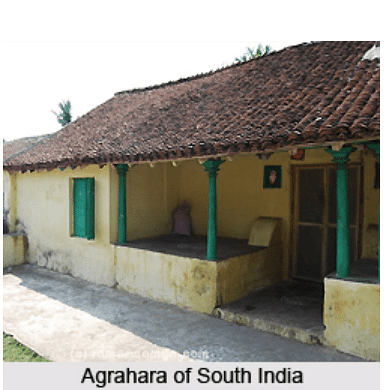
- The land charters show the cultivation of Sanskrit, in which some sophisticated metres were used in the second half of the seventh century.
- At the same time, they attest to the expansion of cultivation and rural settlements.
- A fiscal and administrative unit called Dandabhukti was formed in the border areas between Bengal and Orissa.
- Danda means punishment and bhukti enjoyment.
- The unit was apparently to pacify and suppress the tribal inhabitants of that region and may have promoted Sanskrit and other elements of culture in the tribal areas.
- This was also true of Vardhamanabhukti (Burdwan) of which we hear in the sixth century.
- In south-east Bengal in the Faridpur area, five plots of land granted to a Buddhist monastery were declared waste and water-logged and they paid no tax to the state.
- Similarly, 200 Brahmanas were given a large area in the Comilla district within a forest region full of deer, boars, buffaloes, tigers, serpents, and the like.
- All such instances are sufficient proof of the progress of colonization and civilization in new areas.
- The two centuries from about the middle of the fifth appear to have been very momentous in the history of Bengal.
- They saw the progress of Brahmanism and the coming of Buddhism. The statues of the Buddha are virtually non-existent in the early centuries, after which they are found in Bodh- Gaya, Sanchi, Mathura, and Gandhara.
- In the fifth century, however, statues were set up at several places in Bengal.
- In early medieval times, monasteries were established not only in Bihar but also in north Bengal.
- The fifth to seventh centuries also saw the formation of about half a dozen states, some large and others small; some independent and others feudatory.
- However, each had its victory or military camp where it maintained its infantry, cavalry, elephants, and boats. Each had its fiscal and administrative districts with its machinery for tax collection and maintenance of order.
- Each practised expansion through war and through land grants to Buddhists and brahmanas.
- The number of endowments had increased to such a degree that eventually an officer called agraharika had to be appointed to look after them.
- Land gifts led to rural expansion and created new rights in land. Generally, land was owned by individual families, but its sale and purchase were subject to the overall control of the local communities dominated by leading artisans, merchants, landowners, and scribes, who assisted the local agents of the king.
- However, ordinary cultivators were also consulted about the sale of land in the village.
- It seems that originally land could not be alienated without the consent of the tribe or the community.
- Therefore, even when individuals owned their land and made gifts for religious purposes, the community exercised its say in the matter.
- Probably, at an earlier stage, the community donated land to the priests for religious services and paid taxes to the princes for military and political services.
- Later the king received from the community a substantial part of the land and arrogated to himself much more, which enabled him to make land grants.
- The king was entitled to taxes and also enjoyed rights over waste and fallow land.
- The administrative functionaries of each state knew Sanskrit, the official language.
- They were also familiar with the teachings of the Puranas and the Dharmashastras.
- The period is therefore very significant because it witnessed the development of civilization in this area.
- Kamarupa, coterminous with the Brahmaputra basin running from east to west, shot into prominence in the seventh century. Excavations, however, show settlements in Ambari near Guwahati from the fourth century of the Christian era.
- In the same century, Samudragupta received tributes from Davaka and Kamarupa.
- Davaka possibly accounted for a portion of the Nowgong district, and Kamarupa covered the Brahmaputra basin.

- The rulers who submitted to Samudragupta may have been chiefs living on the tributes collected from the tribal peasantry.
- The Ambari excavations near Guwahati show that settlements were fairly developed in the sixth and seventh centuries, and this is supported by inscriptions.
- By the beginning of the sixth century, the use of Sanskrit and the art of writing are clearly in evidence.
- The Kamarupa kings adopted the title varman, which obtained not only in northern, central, and western India but also in Bengal, Orissa, Andhra, Karnataka, and Tamil Nadu.

- This title, which means armour and symbolizes a warrior, was given to the kshatriyas by Manu.
- The kshatriyas strengthened their position through land grants to the brahmanas.
- In the seventh century, Bhaskaravarman emerged as the head of a state which controlled a substantial part of the Brahmaputra basin and some areas beyond it.
- Buddhism also acquired a foothold, and the Chinese traveller Hsuan Tsang (Hieun Tsang) visited this state.
- Although different parts of eastern India acquired prominence at different times, the formative phase ranged from the fourth to the seventh century.
- During this period, writing, Sanskrit learning, Vedic rituals, Brahmanical social classes, and state systems spread and developed in eastern MP, north Orissa, West Bengal, parts of Bangladesh, and Assam.
- Cultural contacts with the Gupta empire stimulated the spread of civilization in the eastern zone.
- North Bengal and north-west Orissa came under Gupta rule; in other areas of these regions, the Gupta influence can be inferred from the use of the Gupta era dates in inscriptions.
- In Bengal new states were formed by feudatories, who maintained a substantial number of elephants, horses, boats, etc., in their military camps.
- They obviously collected regular taxes from the rural communities to maintain these professional armies.
- For the first time, the fifth and sixth centuries clearly show large-scale writing, use of Sanskrit, formation of a varna society, and the growth of Buddhism and Brahmanism in the form of Shaivism and Vaishnavism in this area.
- Though, the remnants of communal authority over land continued, there is evidence of private property inland, and the use of gold coins with which it could be purchased.
- All this presupposes an advanced food-producing economy. It was apparently based on iron ploughshare agriculture, wet paddy cultivation, and knowledge of a variety of crafts.
- Kalidasa refers to the transplantation of paddy seedling in Vanga, but we do not know whether the practice was indigenous or came from Magadha. North Bengal produced high-quality sugarcane.
- All this made for sufficient agricultural production to sustain both people and government and fostered widespread rural settlements in such areas as were either sparsely inhabited or unoccupied.
- A connected narrative of the princes and dynasties and their feudatories, all revolving around a central power cannot be written, but there is no doubt about cultural evolution and the development of civilization in the outlying provinces in the eastern zone.
- The decline and fall of the Gupta empire, therefore, coincided with considerable progress in the outlying regions. Many obscure areas, which were possibly ruled by tribal chiefs and were thinly settled, came into the limelight.
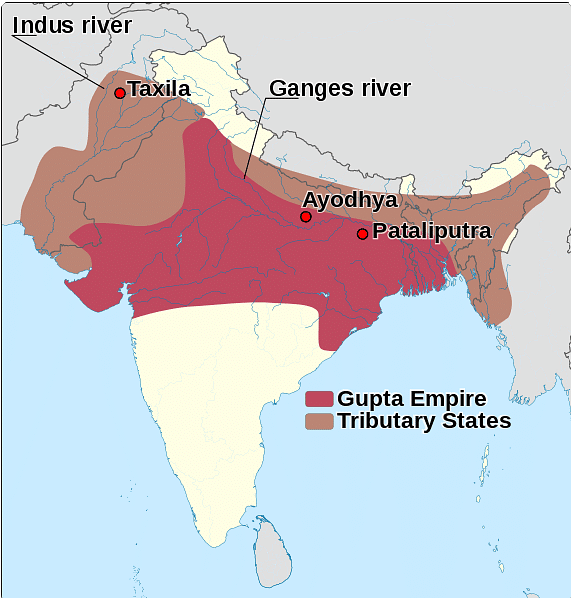
- This applied to the red soil areas of West Bengal, north Orissa, and the adjoining areas of MP, which formed part of Jharkhand and were difficult to cultivate and settle.
- It applied even more to the jungle areas with alluvial soil and heavy rainfall in Bangladesh and to the Brahmaputra basin.


Please comment and suggest whether is it helpful in your preparation series or not ?
ReplyDelete